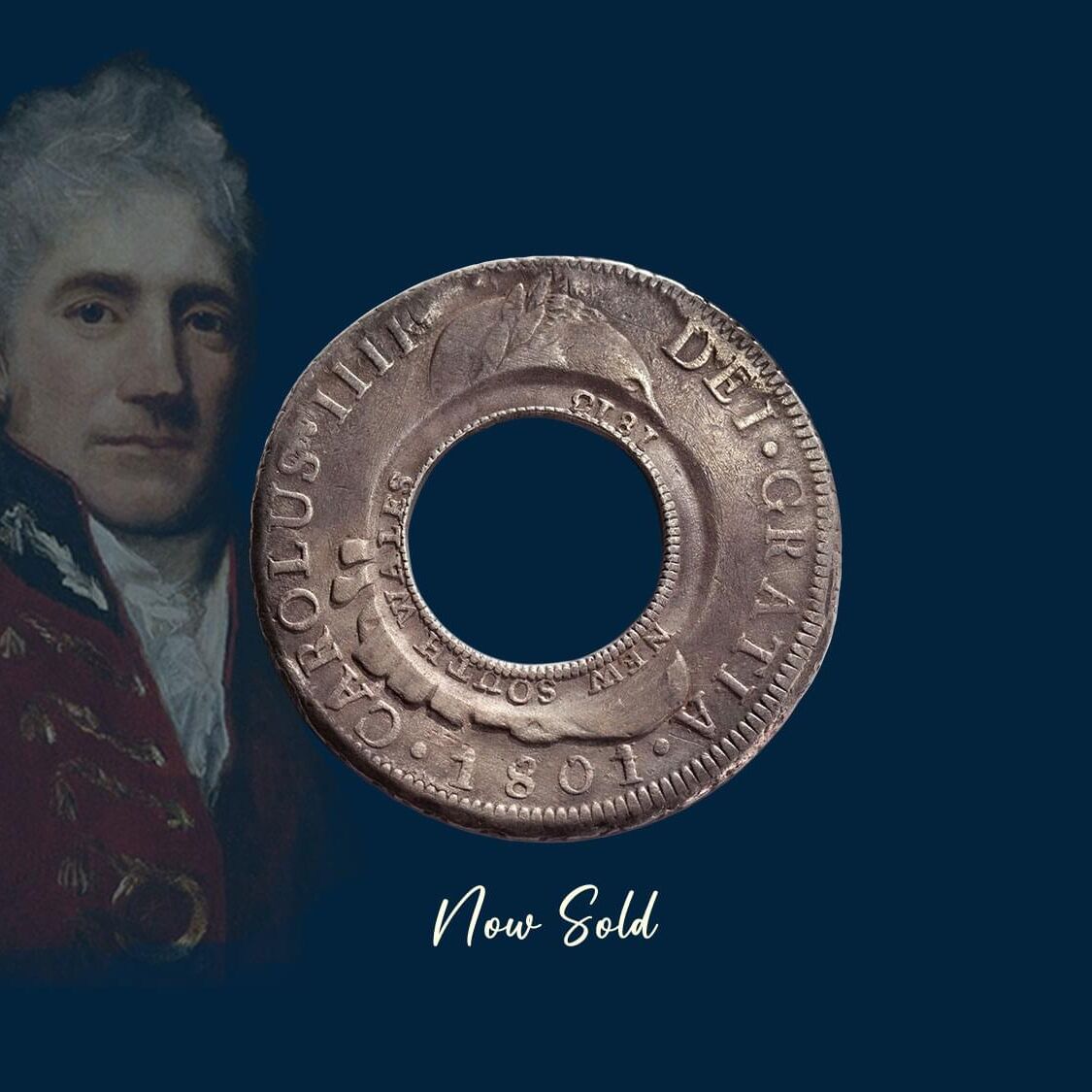
Click here for more details on this Product
A Holey Dollar that is extremely rare quality-wise.
Macquarie's order for Spanish Silver Dollars was fulfilled by the East India Company in Madras, and was not date specific or quality specific. Macquarie simply wanted coins.
An analysis of surviving examples confirms that the majority of Holey Dollars are well worn. The analysis also confirms that a Holey Dollar at Very Fine is a well above average example (refer chart).
We like the price point at which this Holey Dollar is offered. In our view, the range of $100,000 to $200,000 offers excellent value for your investment dollars.
At this price level, a Holey Dollar will look good to the naked eye, relatively untouched. And the major design detail will still be relatively sharp.
We particularly notice with this coin, there are no harsh knocks, gouges or weaknesses in the metal (which so often occurred when Henshall hammered out the hole).
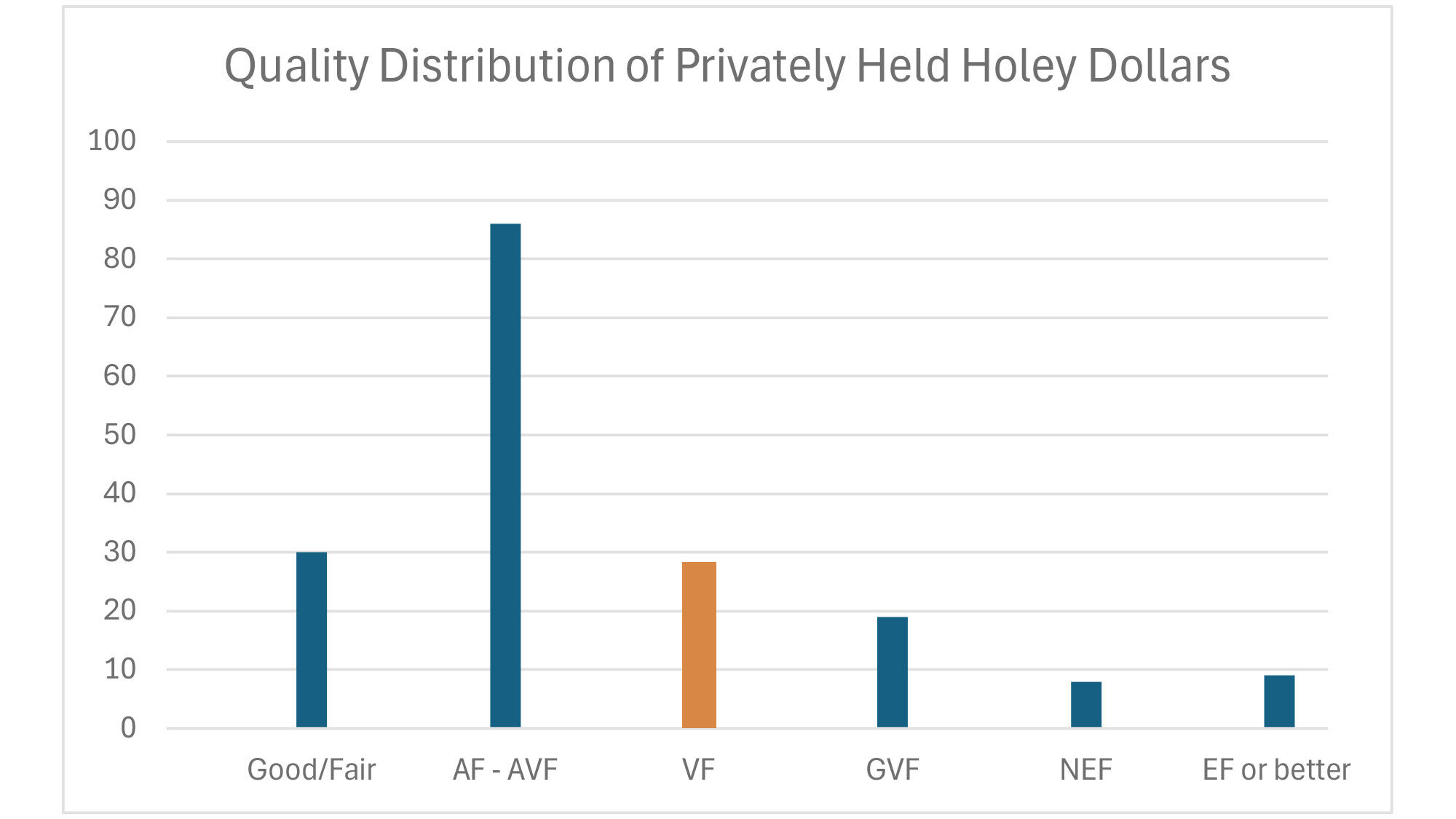
Good/Fair • Akin to a washer
AF - AVF • About Fine to About Very Fine
VF • Very Fine
GVF • Good Very Fine
NEF • Nearly Extremely Fine
EF or better • Extremely Fine to Uncirculated
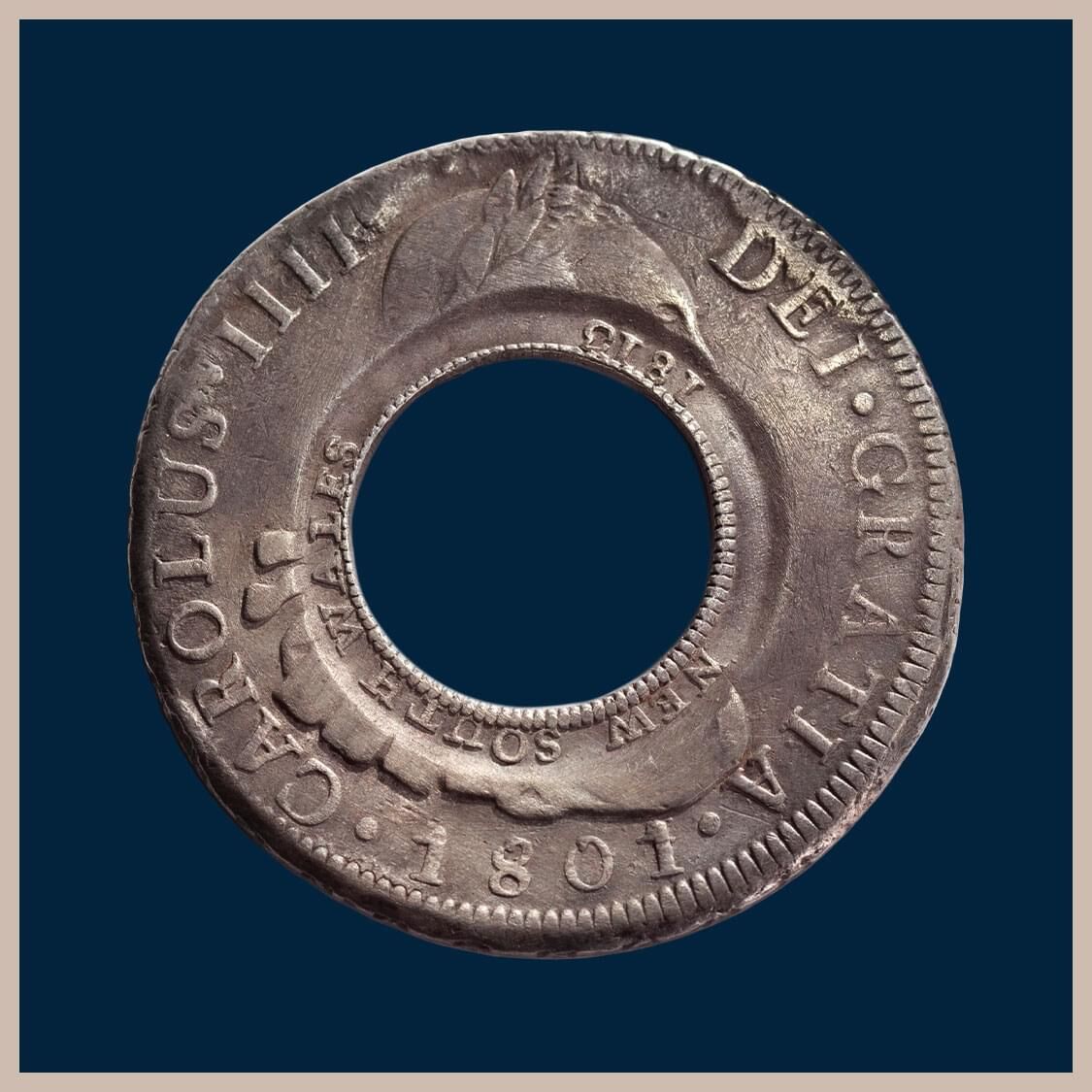
Quality of silver dollar: Very Fine
Quality counter stamps: Good Very Fine
Counter stamp dies: II/4: B/4
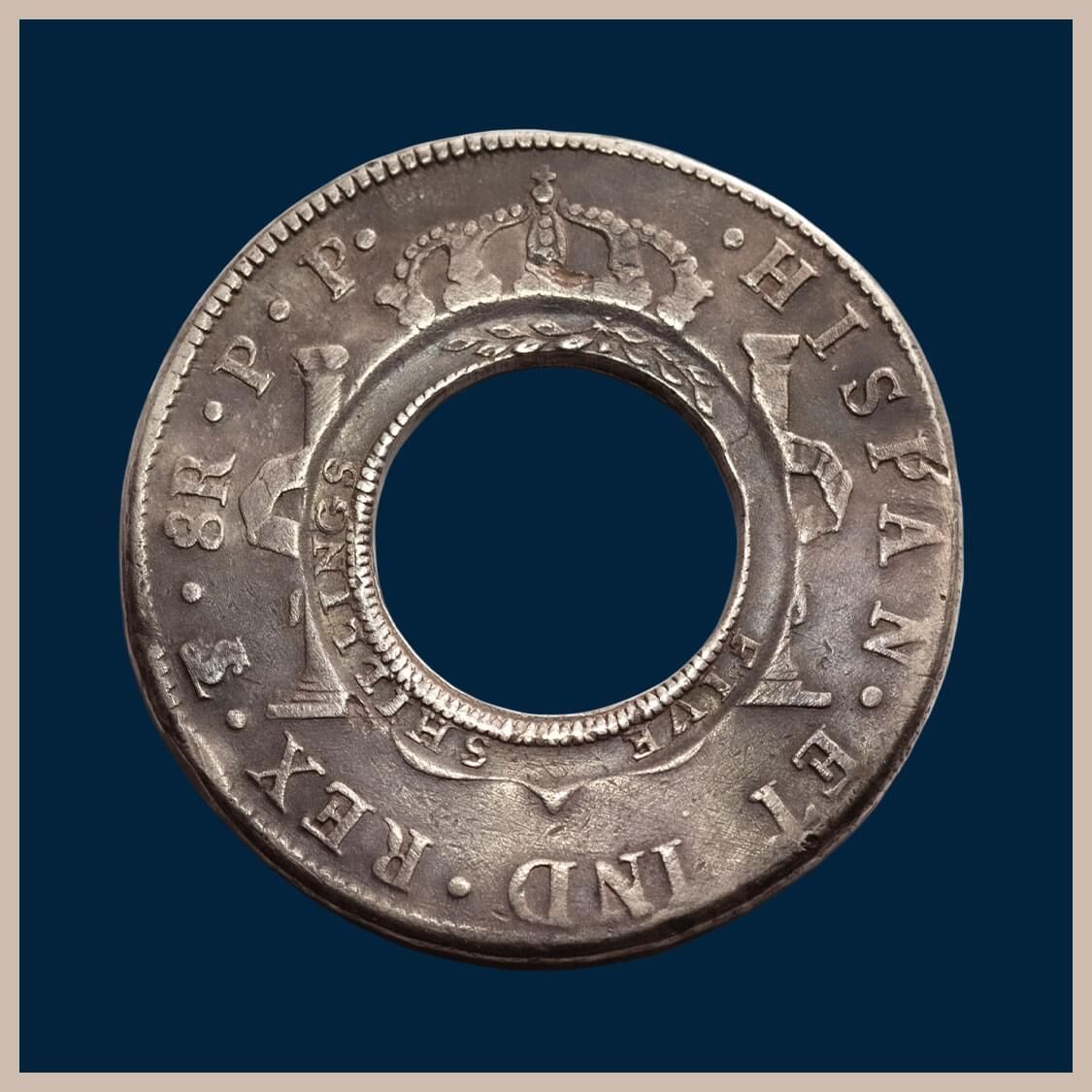
Potosi Mint, identified by the PTS monogram in the legend on the reverse said to be the inspiration of the '$' sign
The defining quality of this Holey Dollar is that it was created from a Spanish Silver Dollar that was struck at the Potosi Mint. The Potosi Mint being the key here.
Macquarie's order for Spanish Silver Dollars was fulfilled by the East India Company in Madras, and was not date or quality specific. No did he care which mint they came from. The dollars were sourced from various mints around the world, each with a different identifying mark. The percentage of Holey Dollars converted from the mints in Mexico, Lima, Potosi and Madrid are noted here.
• Holey Dollars converted from Mexico Mint dollars - 81 per cent
• Holey Dollars converted from Lima Mint dollars - 10 per cent
• Holey Dollars converted from Potosi Mint dollars - 8 per cent.
• Holey Dollars converted from Madrid Mint dollars - 1 per cent
1813 Holey Dollar created from a Spanish Silver Dollar that had been struck at the Potosi Mint, Bolivia, in 1801 (Mira/Noble 1801/5, Spalding 99).
Price: $165,000
Design type: 5 (Charles IV legend and portrait)
Date of the silver dollar: 1801
Reigning monarch: Charles IV (1788 - 1808)
Portrait: Charles IV
Legend: Carolus (Charles) IIII
Mint and mint mark: Potosi Mint, identified by the PTS monogram in the legend on the reverse said to be the inspiration of the '$' sign.
Quality of silver dollar: Very Fine
Quality counter stamps: Good Very Fine
Counter stamp dies: II/4: B/4
More information on the 1813 Holey Dollar
The Holey Dollar is the nation’s first coin, minted in 1813 by order of Governor Lachlan Macquarie. As Macquarie had no access to metal blanks to create his currency, he improvised and acquired 40,000 Spanish Silver Dollars as a substitute.
To make his new coinage unique to the colony, he employed emancipated convict William Henshall to cut a hole in each Spanish dollar. Each holed dollar was then over-stamped on both sides around the edge of the hole. On one side, the date 1813 and the issuing authority of New South Wales. And the other, the value of Five Shillings.
If you look at the entire process, the application of the counter stamps - the issuing authority of New South Wales, the date 1813 and the value of five shillings - is the point at which the 1813 Holey Dollar is created. Prior to that, it was just a Spanish dollar with a hole in it!
The 40,000 Spanish Silver Dollars came with different dates and different design details that reflected the reigning Spanish monarch. And they were sourced from various mints around the world, each mint with a different identifying mark. As the Spanish Dollar was an internationally traded coin, most of them came to Macquarie well used. (We know that because the majority of Holey Dollars are well worn.)
As the Holey Dollar was crafted from a Spanish Silver Dollar (and not a metal blank), assessing its value gives consideration to the original dollar. Its quality. And its rarity, for some are indeed rarer than others.
Consideration must also be given to the extent of circulation once the dollar was converted to an 1813 Holey Dollar by looking at the wear to the counterstamps.
Valuing a Holey Dollar is therefore a multi-faceted process that takes into account seven elements. The date, the monarch and the legend of the original silver dollar. The mint at which the dollar was issued. The quality of that dollar. Now we turn to the counter stamps applied by Henshall. Are they random or precise? And are they worn?
The brief summary above is intended to explain how and why vast price differences can occur with Holey Dollars.
Owning a Holey Dollar is about indulging in an experience, a fusion of history and prestige. And its about savouring the moment.
It has been the inspiration and aspiration of many. Think Macquarie Bank and its logo! Museums, the world over. Historians, collectors, investors, both local and international.
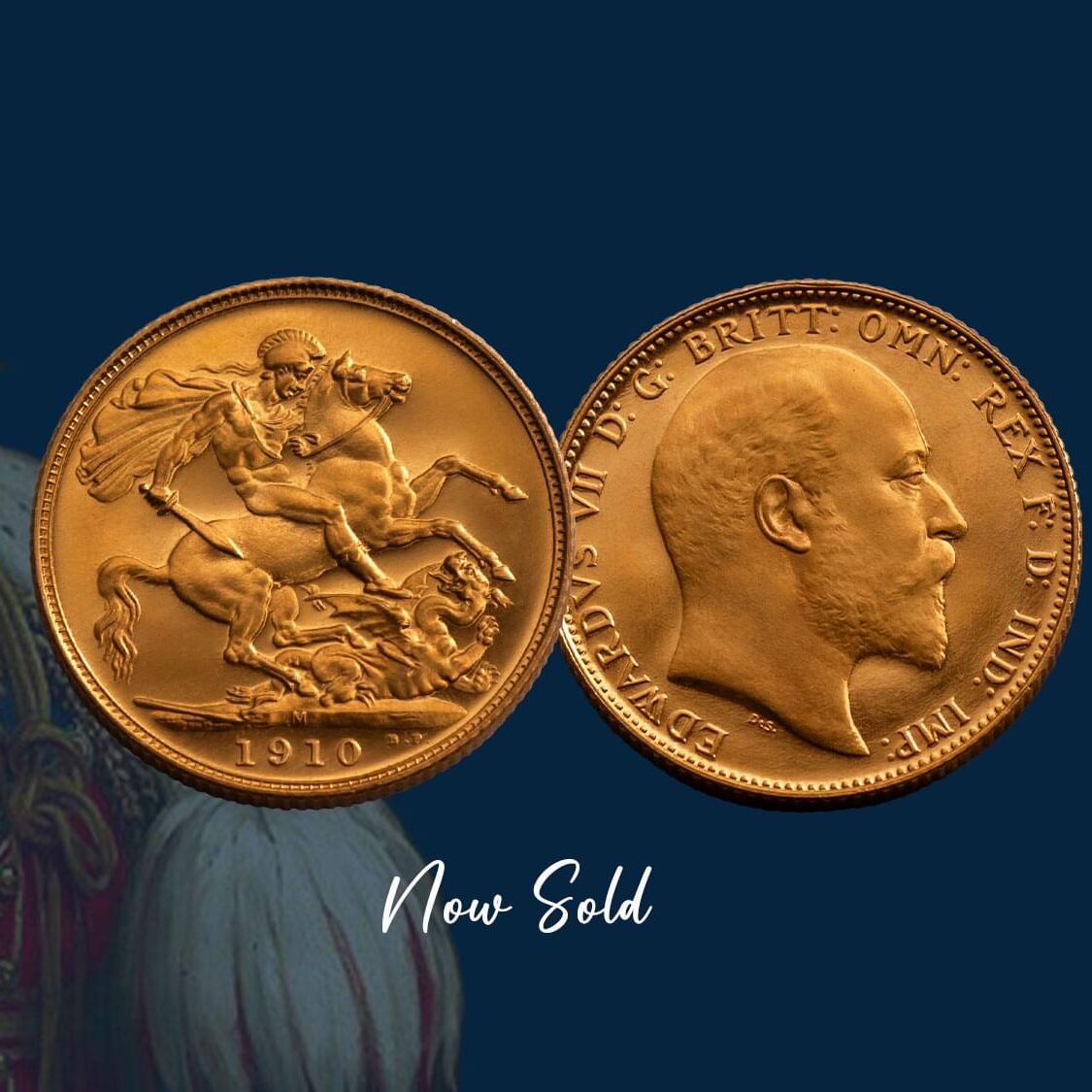
This Edward VII 1910 Proof Sovereign has a level of excellence and exclusivity that inspires widespread admiration. The coin is a celebration of the Melbourne Mint’s achievements in crafting perfection in gold. And it is unique. It represents the very best in its class.
We estimate that one thousand collectors can own a 1930 Penny. Perhaps nineteen collectors can own a veiled head proof sovereign. But only two collectors can ever own an Edward VII proof sovereign, this coin one of the two. The importance of this offer cannot be overstated.
Excerpts from our report on the Melbourne Mint proofs (in the view more section) confirm its unique status and the extreme rarity of Edward VII proofs.
Click here for more details on this Product
When the Royal Mint London or the British Museum requested a sovereign or half sovereign from an Australian Mint, they were never sent a circulation strike. They were sent a specially crafted presentation piece.
Nor would a circulation strike be presented to the monarch, gifted to a dignitary or sent to an influential collector. And a circulation strike would not be displayed at a Colonial Exhibition. Again, an individually crafted presentation piece would be specially created for the occasion.
The technical term for such a piece is 'Coin of Record'.
A Coin of Record is an artistic interpretation of coinage, a strikingly beautiful coin beyond ordinary currency. Individually crafted to standards far exceeding that required of a circulating coin, minted with a proof or specimen finish and created using special coining techniques. Whereas production of circulating coinage was dictated by Government, Coins of Record were struck at the discretion of the mint master.
Coins of Record were not produced every year and, as they were individually crafted, the process was time consuming and the mintages minuscule. For gold proofs, generally ten pieces or less. There were several occasions when only a single coin was struck.
Coins of Record of Australia's sovereigns and half sovereigns are visually stunning, distinguished by brilliant golden-mirror surfaces. And it is their beauty and their ultra-exclusivity that drives demand.
The market for Australia's gold Coins of Record was effectively established in London, in 1903, and continues to this very day right across the globe.
Recent international auction results confirm their status as a globally traded commodity, the frosted proofs of the Melbourne MInt in particular, keenly sought after by American collectors.
The Coins of Record of Australia's proof sovereigns and proof half sovereigns are the crown jewels of coinage, adding glamour and exceptionality to any collection!
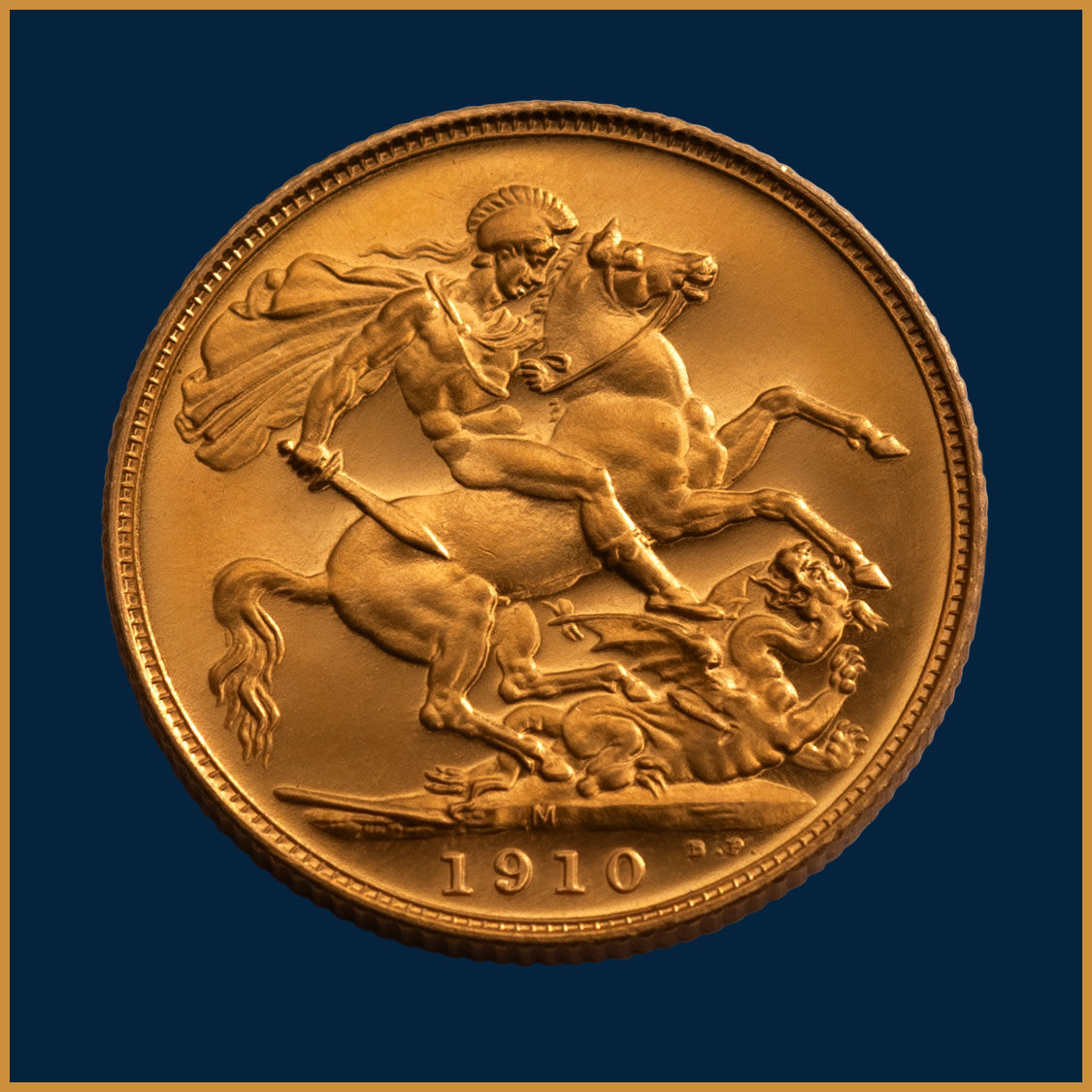
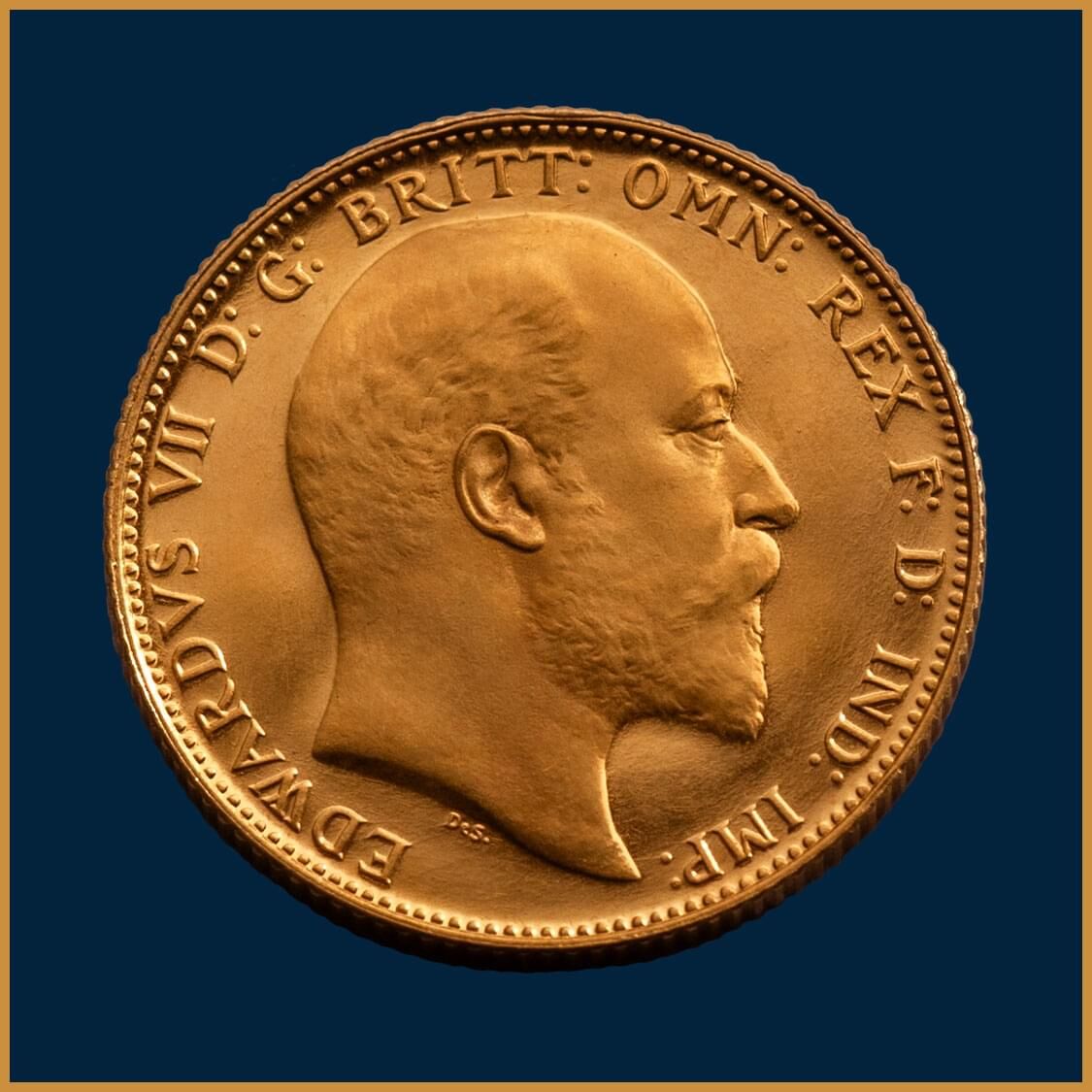
The Melbourne Mint opened in 1872 as a branch of the Royal Mint London, its main function to produce gold sovereigns and half sovereigns. Its gold coin production ceased in 1931.
Three monarchs reigned between 1872 and 1931, Queen Victoria, King Edward VII and George V.
The Melbourne Mint struck Coins of Record sporadically. Of the record pieces that were produced, those of Edward VII are the least available for collectors. (Confirmed in our chart below.)
John G. Murdoch was an influential British collector. He developed a strong business relationship with the Melbourne Mint and was one of the few collectors that was regularly supplied Coins of Record from 1884 until 1901, through the Young Head, Jubilee and Veiled era of Queen Victoria.
The market for Australia’s proof gold coins is international and it is dynamic. Without the involvement of John G. Murdoch, Australia's gold Coins of Record may never have seen the light of day, permanently stored in Government archives and out of reach of collectors.
Murdoch single-handedly created a market by taking Australian gold proofs into the buy/sell environment of collectors. And he struck a perfect balance with the market (then and today) with the quantities he held.
The coins moved onto the international stage when Murdoch's collection was liquidated via Sotheby, Wilkinson & Hodge in London in 1903 following his passing in 1902.
Murdoch's death in 1902 had a dramatic impact on production of Coins of Record at the Melbourne Mint.
Technically, it fell off a cliff.
Only one Melbourne Mint 1902 Proof Sovereign is known. Formerly held by the South Africa Mint (a temporary branch of the Royal Mint, 1923 - 1941) it is now held by a private collector.
No 1902 Proof Half Sovereigns are known.
And one example of the 1910 Proof Sovereign is privately held, formerly owned by Ross Pratley and Barrie Winsor, both leading gold coin specialists. (This coin)
The proofs of Edward VII are characterised by extreme scarcity. Proofs were only struck in two years and of each, only one example is known.
The proofs of Edward VII are further characterised by extreme beauty.
The Melbourne Mint reached its zenith in proof gold coining during the era of Edward VII, the depth of design of both the 1902 and 1910 Proof Sovereigns is magnificent, sculpted, three dimensional. The fields are like golden mirrors.
Unique 1910 Edward VII Proof Sovereign struck as a Coin of Record at the Melbourne Mint.
Superb FDC
Price: $135,000
This Edward VII 1910 Proof Sovereign has a level of excellence and exclusivity that inspires widespread admiration.
The coin is a celebration of the Melbourne Mint’s achievements in crafting perfection in gold. And it is unique. It represents the very best in its class.
The proofs of Edward VII are characterised by extreme scarcity. Proofs were only struck in two years and of each, only one example is known.
The proofs of Edward VII are further characterised by extreme beauty. The Melbourne Mint reached its zenith in proof gold coining during the era of Edward VII, the depth of design of both the 1902 and 1910 Proof Sovereigns is magnificent, sculpted, three dimensional. The fields are like golden mirrors.
We estimate that one thousand collectors can own a 1930 Penny. Perhaps nineteen collectors can own a veiled head proof sovereign. But only two collectors can ever own an Edward VII proof sovereign, this coin one of the two.
The importance of this offer cannot be overstated.
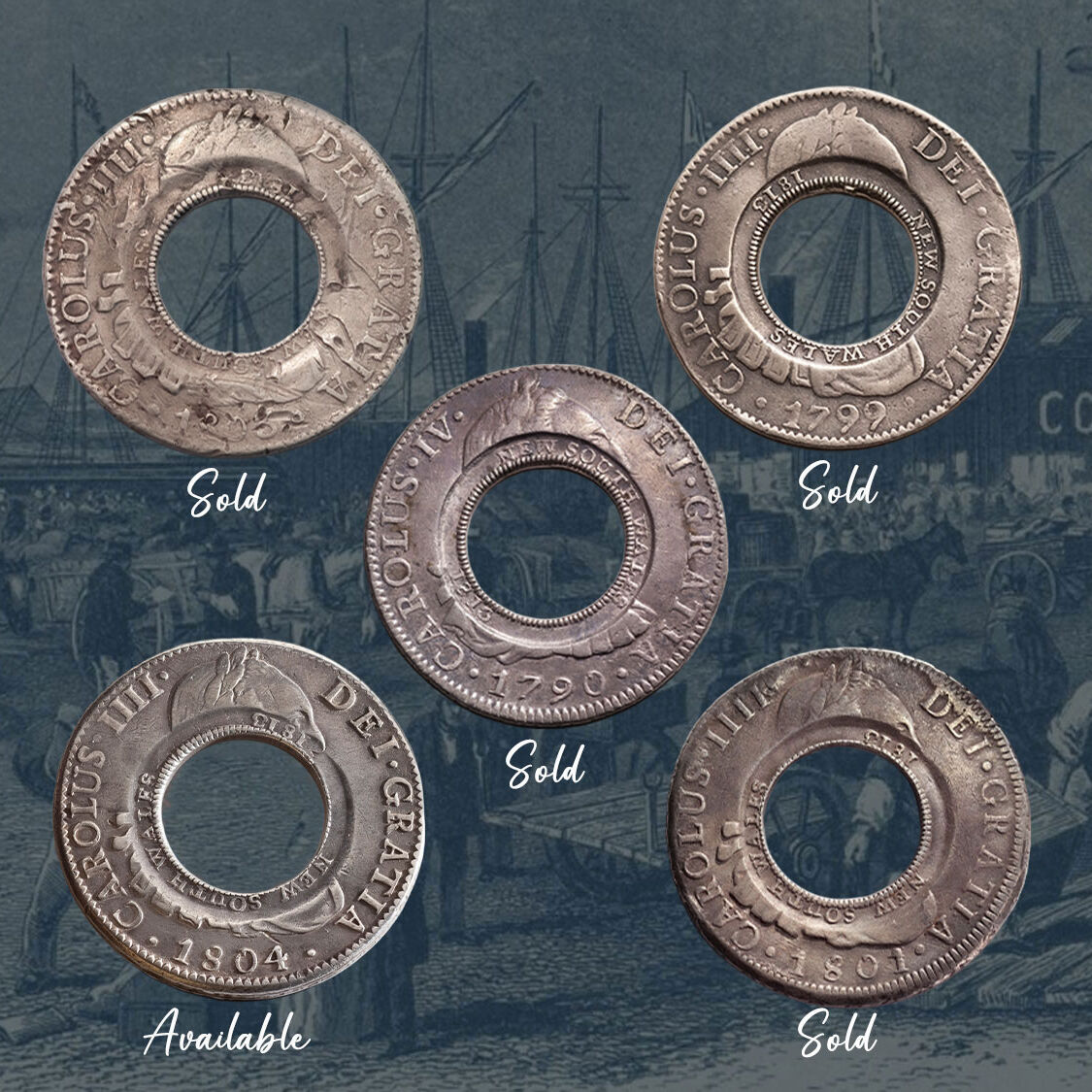
Owning a Holey Dollar is about indulging in an experience, a fusion of history and prestige. And its about savouring the moment. It has been the inspiration and aspiration of many. Think Macquarie Bank and its logo! Museums, the world over. Historians, collectors, investors, both local and international.
This offer is all about seizing the opportunity and matching a Holey Dollar to suit your budget.
In a presentation befitting the coin, each Holey Dollar will be presented in a bespoke case made from Australian timbers, designed and crafted by Anton Gerner. And an individual catalogue will be prepared for each coin, with photographs and detailed information.
The five Holey Dollars have now sold. Contact us if you would like to receive advice of upcoming Holey Dollar inventory.
Click here for more details on this Product
This offer is unprecedented. Five Holey Dollars offered for sale, across a broad range of prices.
• The Holey Dollar is priced below $50,000.
• The second and third Holey Dollars are priced at $105,000 and $165,000, the latter a rare Potosi Mint Holey Dollar.
• The fourth coin is a high quality Good Very Fine with fabulous eye appeal and is priced at $225,000.
• And the fifth and final Holey Dollar is an elite piece. The best in its class, it has been exhibited twice in Australia. A rare type of Holey Dollar, with only a few known and this, the finest, priced at $450,000.
The 1813 Holey Dollar is a cultural and financial icon. Its appeal extends far beyond numismatics, driven by its immense historical significance and tangible connection to a foundational moment in Australian history ... when our first coinage was created.
And with less than two hundred available to collectors, the Holey Dollar has prestige value and investment value.
We have tapped into an extensive network to put this offer together, our aim to cater to the widest possible collector audience by offering five Holey Dollars at vastly different price points.
To this end we have worked closely with now retired numismatist, Barrie Winsor. Its no secret in the industry that Barrie Winsor has been a guiding light to many coin professionals. And a mentor to prominent collectors such as Philip Spalding and Tom Hadley of Quartermaster fame, both relying on Winsor to source material.
It has been a pleasure rekindling our numismatic relationship with Barrie, working together to present this extraordinary offer.
Both of us share a passion for Holey Dollars and an even stronger passion for the industry.
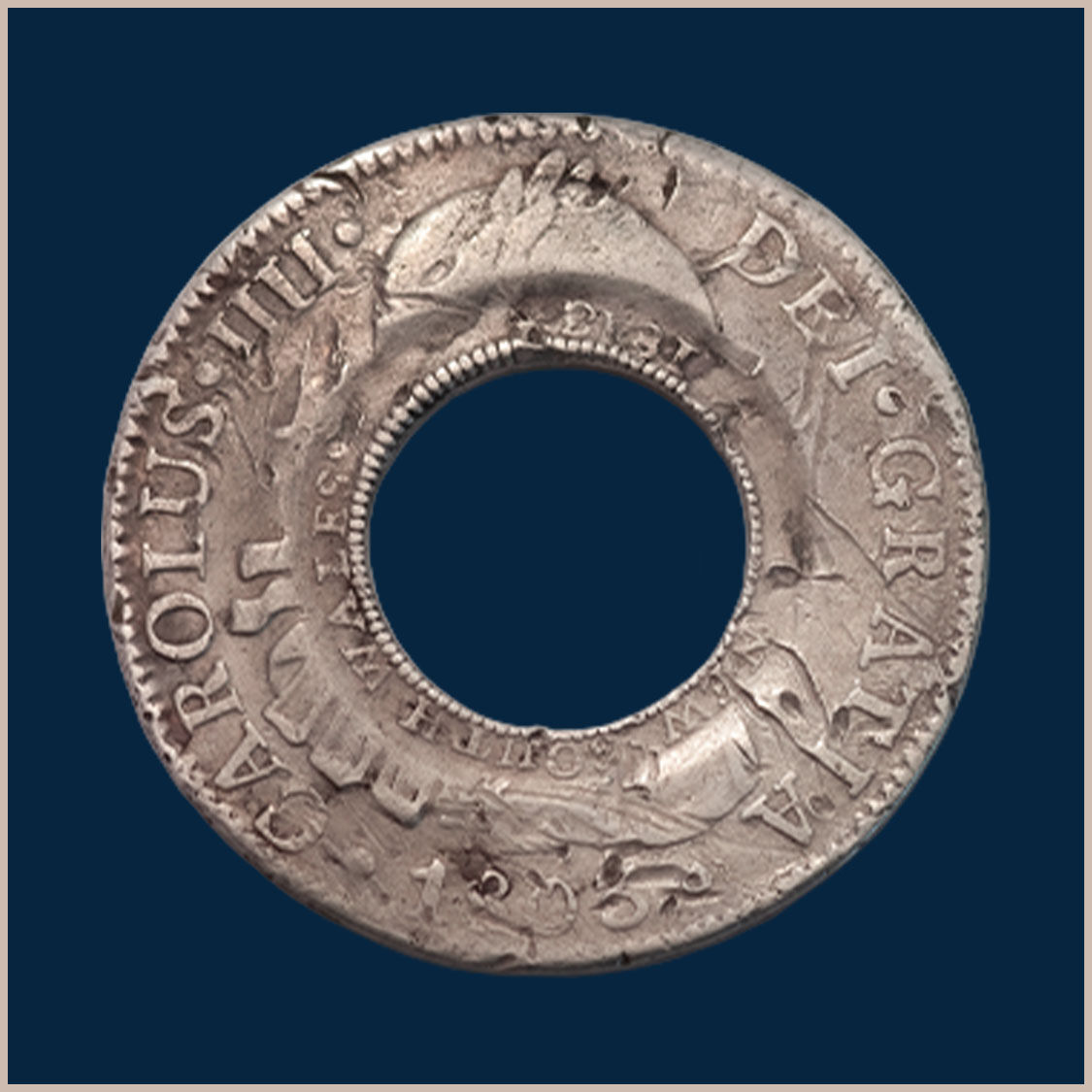
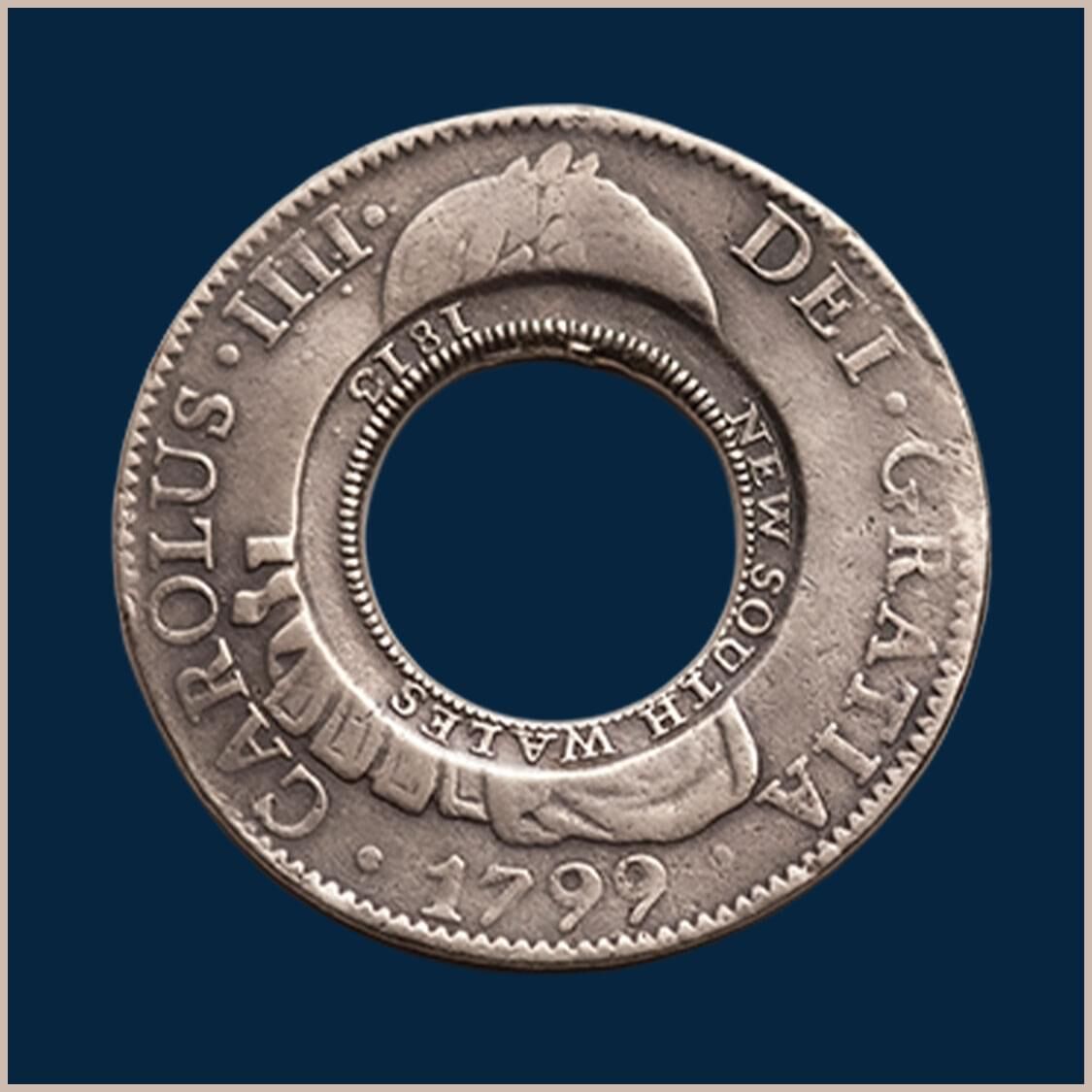
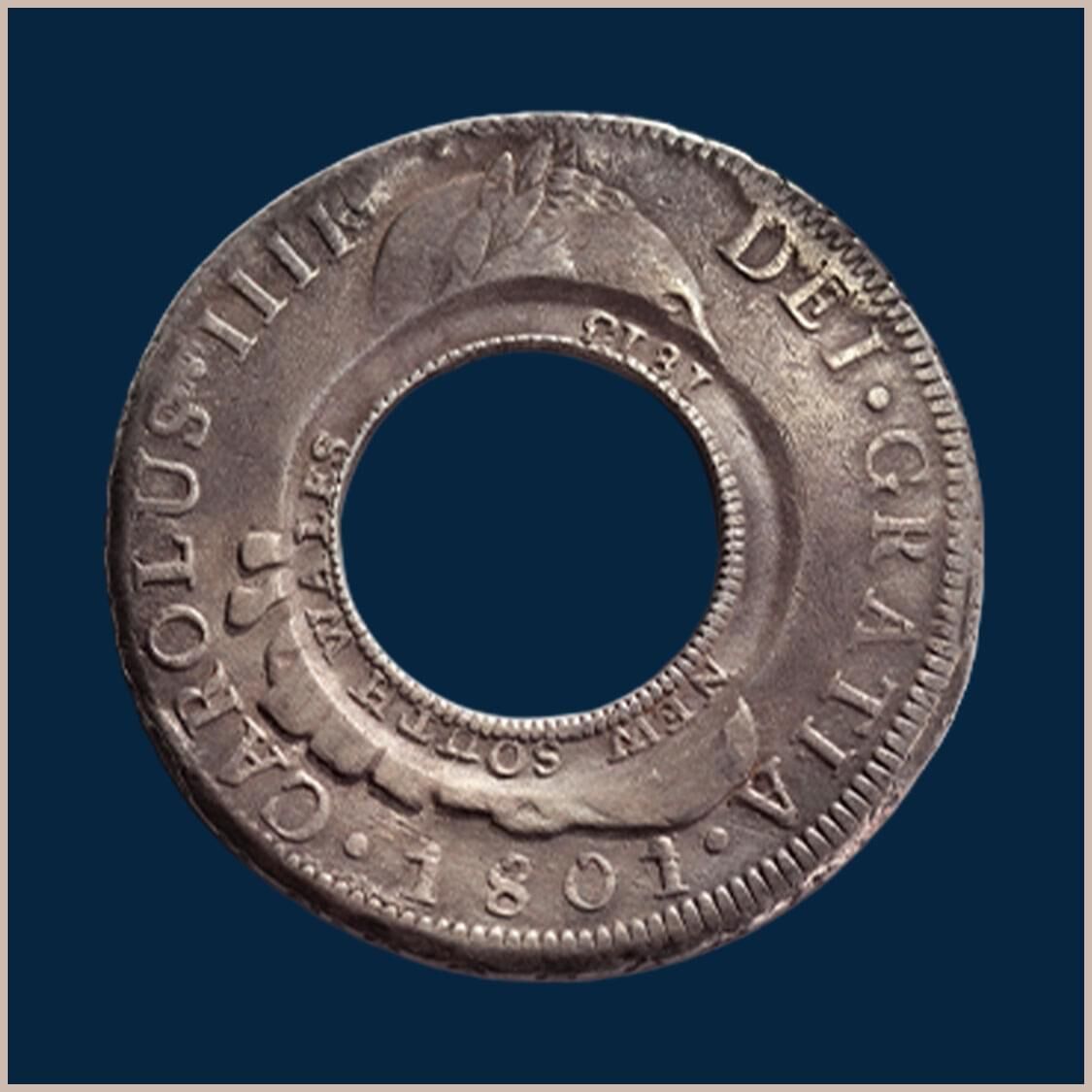
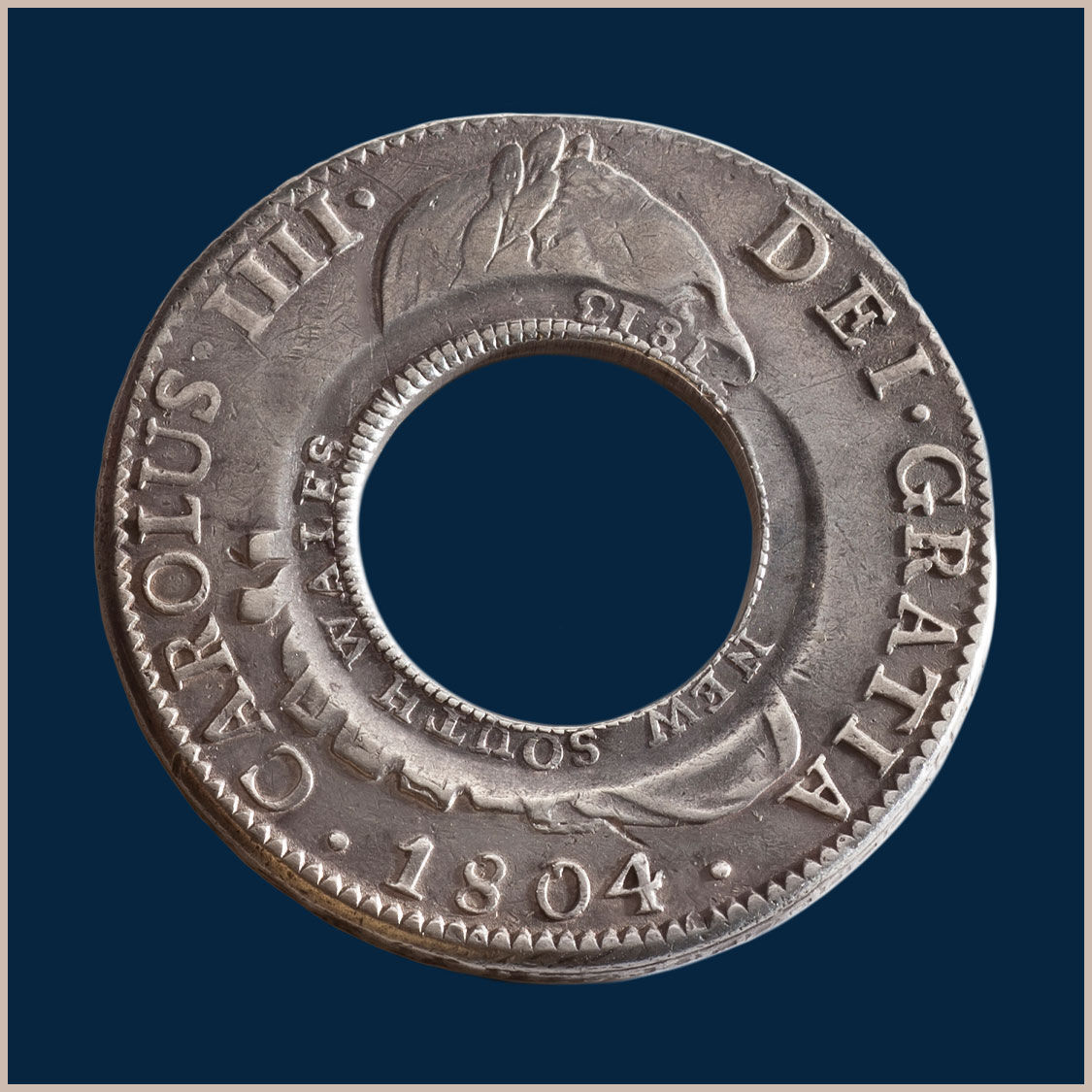
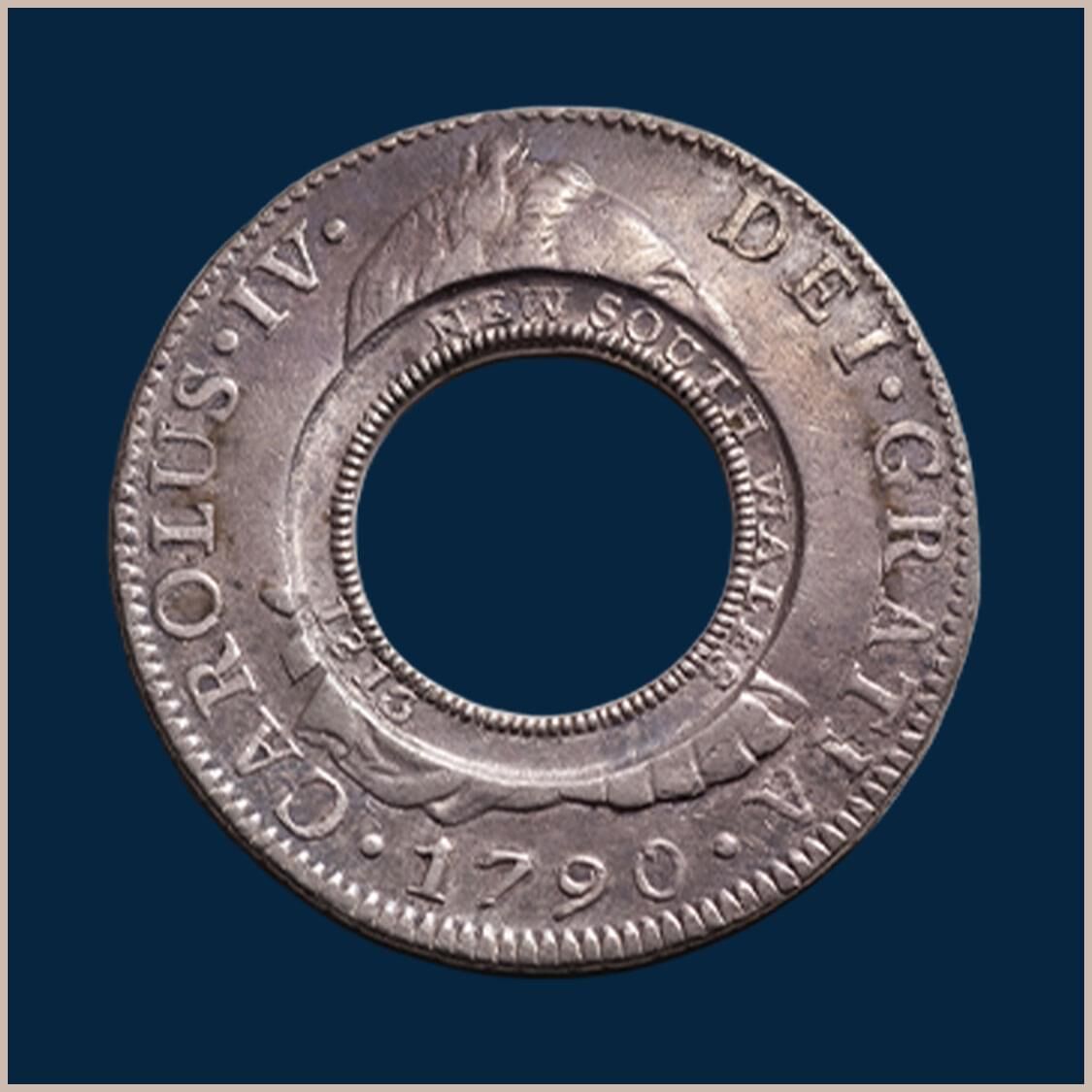
Well priced.
Price: $35,000
SOLD
Great eye appeal.
Price: $105,000
SOLD
Rare Potosi Mint.
Price: $165,000
SOLD
Impressive.
Price: $225,000
SOLD
Best in its class!
Price: $450,000
SOLD
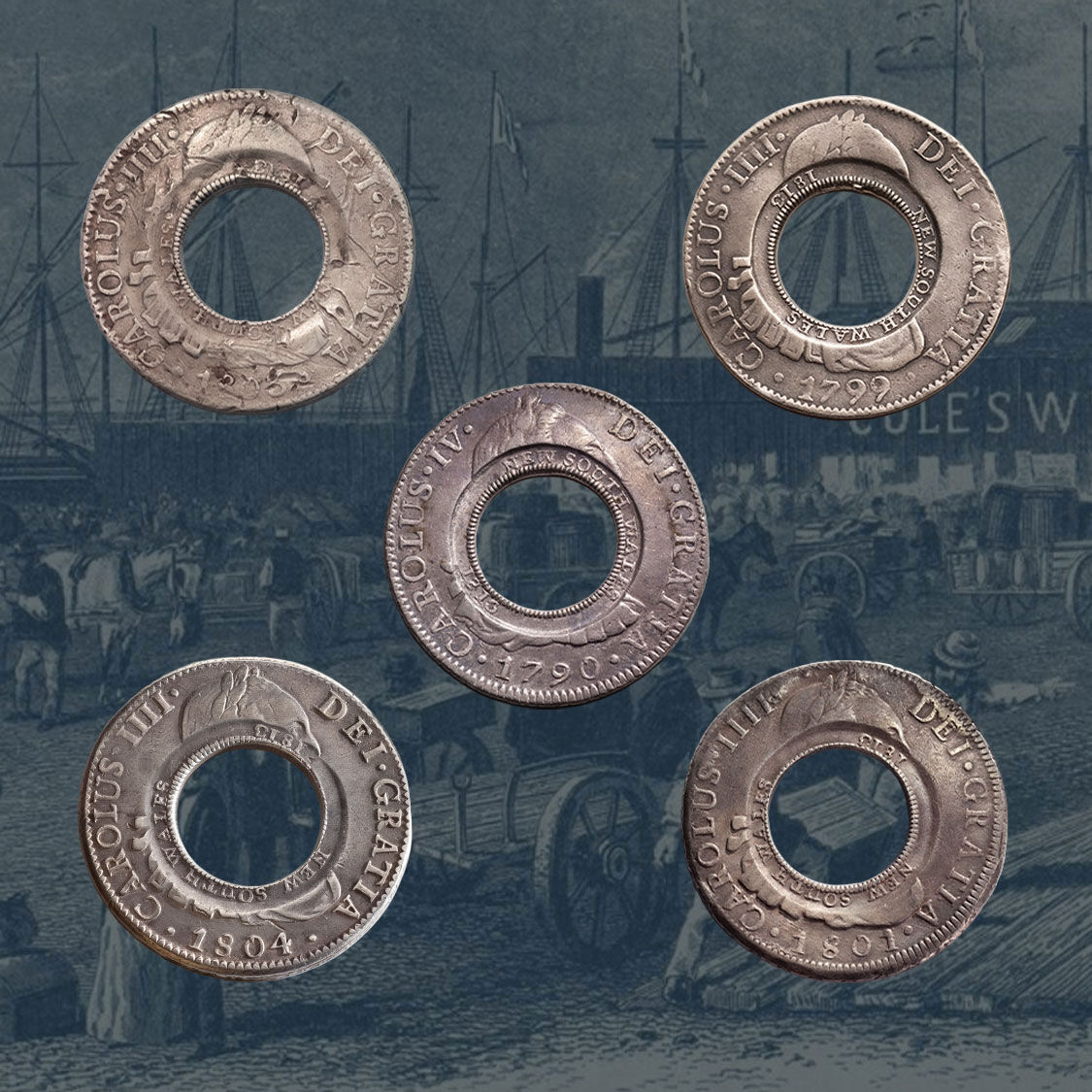
The Holey Dollar is the nation’s first coin, minted in 1813 by order of Governor Lachlan Macquarie. As Macquarie had no access to metal blanks to create his currency, he improvised and acquired 40,000 Spanish Silver Dollars as a substitute.
To make his new coinage unique to the colony, he employed emancipated convict William Henshall to cut a hole in each Spanish dollar. Each holed dollar was then over-stamped on both sides around the edge of the hole. On one side, the date 1813 and the issuing authority of New South Wales. And the other, the value of Five Shillings.
If you look at the entire process, it is the application of the counter stamps that is the point at which the 1813 Holey Dollar is created. Prior to that, it was just a Spanish dollar with a hole in it!
The 40,000 Spanish Silver Dollars came with different dates and different design details that reflected the reigning Spanish monarch. And they were sourced from various mints around the world, each mint with a different identifying mark. As the Spanish Dollar was an internationally traded coin, most of them came to Macquarie well used. (We know that because the majority of Holey Dollars are well worn.)
As the Holey Dollar was crafted from a Spanish Silver Dollar (and not a metal blank), assessing its value has to give consideration to the original dollar. Its quality. And its rarity. Consideration must also be given to the extent of circulation once the dollar was converted to an 1813 Holey Dollar.
Valuing a Holey Dollar is therefore a multi-faceted process that takes into account seven elements. The date, the monarch and the legend of the original silver dollar. The mint at which the dollar was issued. The quality of that dollar. Now we turn to the counter stamps applied by Henshall. Are they random or precise? And are they worn?
The brief summary above is intended to explain how and why vast price differences can occur with Holey Dollars. Why one can be priced at $35,000 and the other at $425,000.
Owning a Holey Dollar is about indulging in an experience, a fusion of history and prestige. And its about savouring the moment. It has been the inspiration and aspiration of many. Think Macquarie Bank and its logo! Museums, the world over. Historians, collectors, investors, both local and international.
This offer is all about seizing the opportunity and matching a Holey Dollar to suit your budget.
1813 Holey Dollar created from a Spanish Silver Dollar that had been struck at the Mexico Mint in 1803 (Mira/Noble 1803/7).
Price: $35,000
SOLD
A Holey Dollar that has seen harsh treatment but still retains the important design details of the date, legend, mint mark. The counter stamps are also clear, the 'H' for Henshall distinct. Ex Max Stern & Co (1971), then to Philip Spalding.
Design type: 5 (Charles IV legend and portrait)
Date of the silver dollar: 1805
Reigning monarch: Charles IV (1788 - 1808)
Portrait: Charles IV
Legend: Carolus (Charles) IIII
Mint and mint mark: Mexico Mint identified by the 'M' with a small circle above it in the legend on the reverse
Quality of silver dollar : Fine
Quality counter stamps: About Very Fine
Counter stamp dies: II/4: B/4
1813 Holey Dollar created from a Spanish Silver Dollar that had been struck at the Mexico Mint in 1799 (Mira/Noble 1799/4).
Price: $105,000
SOLD
Formerly owned by Ron Stewart and Philip Spalding with strong design detail. Outstanding counter stamps the fleur de lis and 'H' for Henshall distinct.
Design type: 5 (Charles IV legend and portrait)
Date of the silver dollar: 1799
Reigning monarch: Charles IV (1788 - 1808)
Portrait: Charles IV
Legend: Carolus (Charles) IIII
Mint and mint mark: Mexico Mint identified by the 'M' with a small circle above it in the legend on the reverse
Quality of silver dollar: About Very Fine
Quality counter stamps: About Extremely Fine
Counter stamp dies: I/2: A/5
1813 Holey Dollar created from a Spanish Silver Dollar that had been struck at the Potosi Mint, Bolivia, in 1801 (Mira/Noble 1801/5).
Price: $165,000
SOLD
This Holey Dollar is defined by the rare Potosi Mint. Of the two hundred Holey Dollars held by collectors, sixteen only were created from silver dollars issued at the Potosi Mint. The Schulman name is an extra bonus for this coin, ex Jacques Schulman Sale, Amsterdam, 23 May 1910 (lot 2117).
Design type: 5 (Charles IV legend and portrait)
Date of the silver dollar: 1801
Reigning monarch: Charles IV (1788 - 1808)
Portrait: Charles IV
Legend: Carolus (Charles) IIII
Mint and mint mark: Potosi Mint, idwentified by the PTS monogram in the legend on the reverse said to be the inspiration of the '$' sign.
Quality of silver dollar: Very Fine
Quality counter stamps: Good Very Fine
Counter stamp dies: II/4: B/4
1813 Holey Dollar created from a Spanish Silver Dollar that had been struck at the Mexico Mint in 1804 (Reference Mira/Noble: 1804/8).
Price: $225,000
SOLD
A high quality Holey Dollar with exceptional eye appeal. As great force had to be exerted on the Spanish Silver Dollar to punch out the central hole. many Holey Dollars are found slightly dished and distorted. With this Holey Dollar, the silver dollar flan is flat and has not been distorted by the cutting process. This is simply a fabulous Holey Dollar, the even shape allowing the design details to be displayed to the max.
Design type: 5 (Charles IV legend and portrait)
Date of the silver dollar: 1804
Reigning monarch: Charles IV (1788 - 1808)
Portrait: Charles IV
Legend: Carolus (Charles) IIII
Mint and mint mark: Mexico Mint identified by the 'M' with a small circle above it in the legend on the reverse
Quality of silver dollar: Good Very Fine
Quality counter stamps: About Extremely Fine
Counter stamp dies: II/4: B/3
The extremely rare Charles III on Charles IV Holey Dollar created from a Spanish Silver Dollar that had been struck at the Mexico Mint in 1790 featuring the portrait of the deceased Charles III and the legend of his son, Carolus IV
Price: $450,000
SOLD
This Holey Dollar is a piece of significance and has been exhibited twice, at the Macquarie Bank in 2013 and the Royal Australian Mint in 2019. Ex Spink London privately from Andre de Clermont in 1989 and now held in a private collection in Perth.
To ensure that the colonial mints could continue their coinage production uninterrupted following the death of King Charles III, a Royal decree granted the mints the right to amend the legend to Carolus IV to acknowledge the new monarch but continue striking coins with the portrait of the deceased king.
This coin is the finest of eight privately held examples depicting the portrait of Charles III and the legend Carolus IV.
Design type: 4 (Charles III on Charles IV Holey Dollar)
Date of the silver dollar: 1790
Reigning monarch: Charles IV (1788 - 1808)
Portrait: Charles III
Legend: Carolus (Charles) IV
Quality of silver dollar : Nearly Extremely Fine
Quality counter stamps: Extremely Fine
Counter stamp dies: I/11: B/7
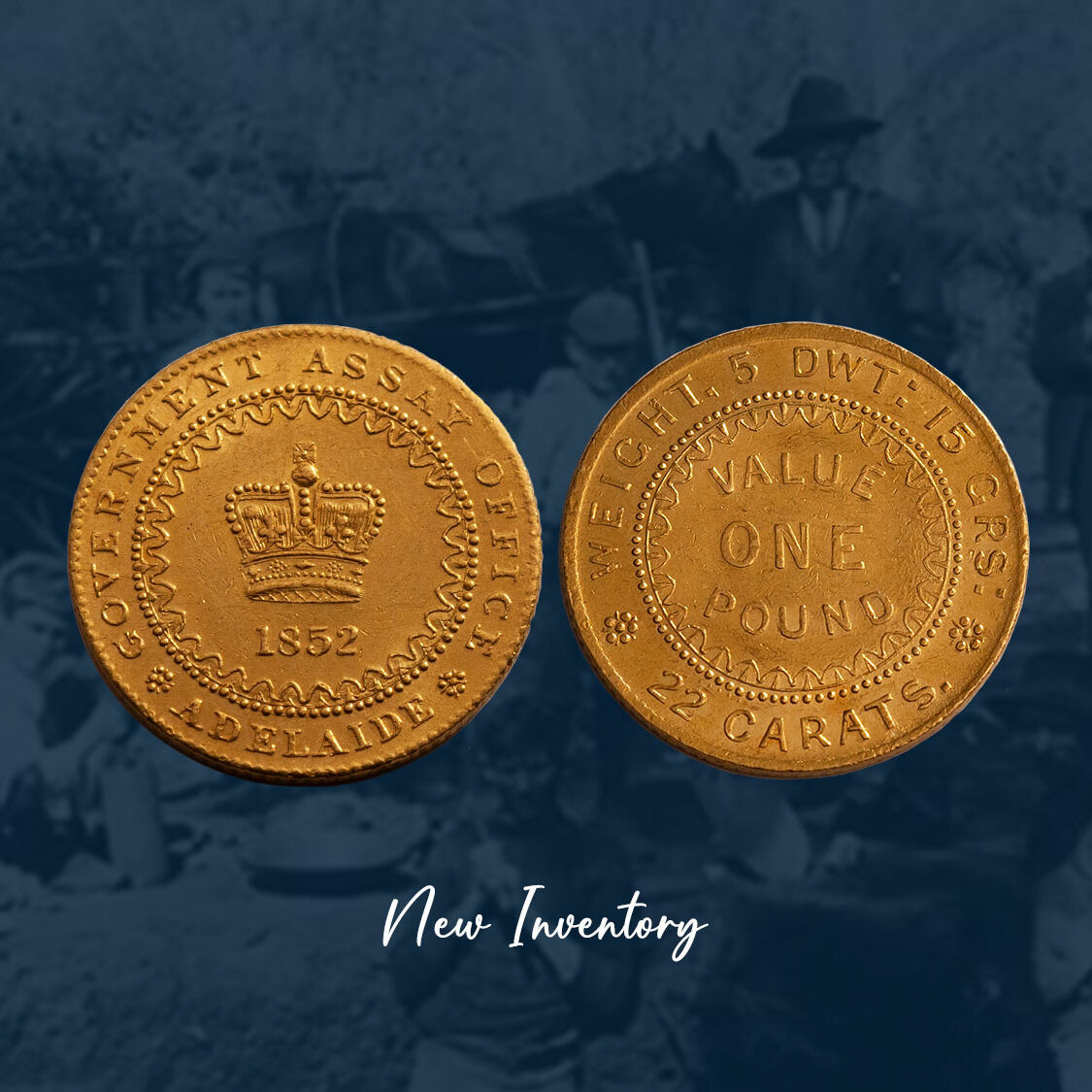
There is everything to like, and nothing to dislike, about this 1852 Adelaide Pound. Including the price. The coin is highly lustrous on both obverse and reverse and the prime design details of the crown and the legend, Government Assay Office Adelaide, are well defined. So too is the date '1852'. We also note that the fields and the edges are not marred by heavy knocks or gouges. A miracle given the factory environment in which it was struck. This Adelaide Pound is graded Good Extremely Fine, with just whisper touches to the high points. And is priced accordingly. Held in the one collection for the last twenty-six years, this 1852 Adelaide Pound is available now.
Click here for more details on this Product
The Adelaide One Pound is the nation’s first gold coin, struck in 1852 at the South Australian Government Assay Office, Adelaide.
Local jeweler and engraver Joshua Payne created the dies for the nation's first gold coins. The obverse declared the issuing authority, Government Assay Office Adelaide, encircling a crown and the date, 1852, the design used continuously throughout production. The reverse declared the fineness and weight encircling it's value.
With its fine design detail, the Adelaide Pound is compelling and a piece of significance, its status as the nation's first gold coin ensuring that it will never be forgotten.
And it is extremely rare with less than forty examples surviving from the first production run and perhaps two hundred and fifty from the second. Either first or second run, the Adelaide Pound is a prized possession, an iconic gold coin revered by local and international buyers.
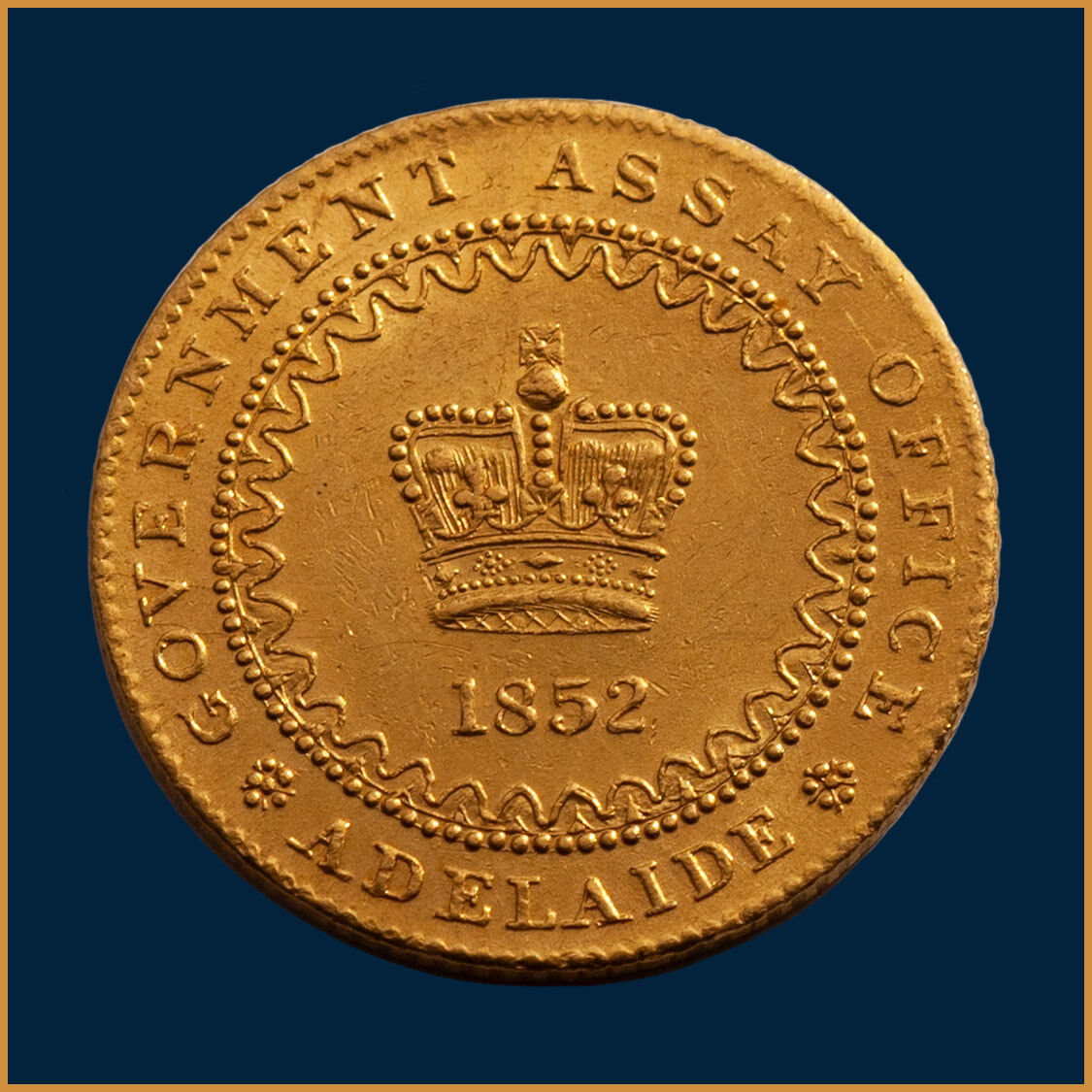
1852 Adelaide Pound Type II
Obverse
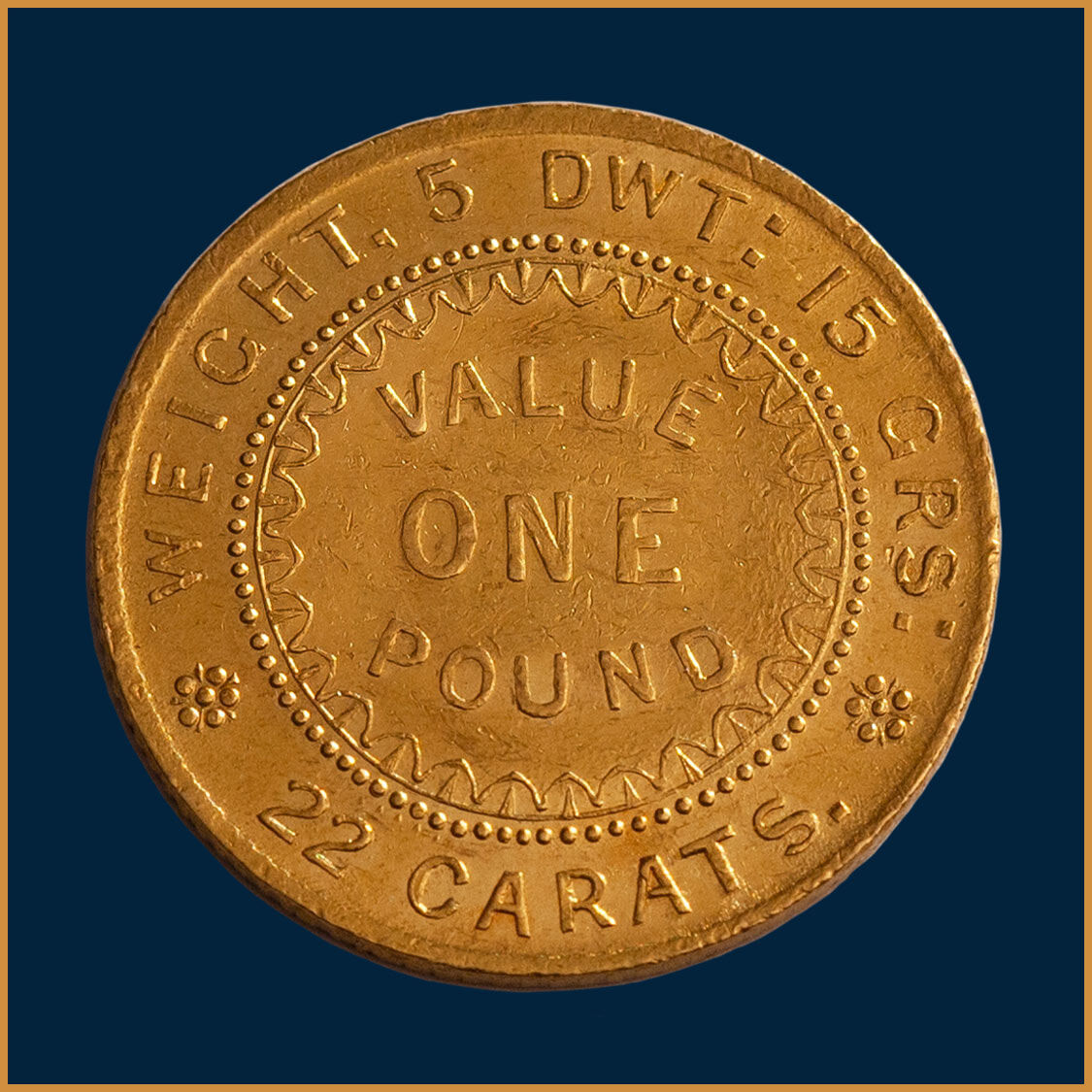
1852 Adelaide Pound Type II
Reverse
The first production run of Adelaide Pounds was short and eventful. A cracking of the reverse die during the striking of the first fifty coins halted production.
The impaired die, featuring a beaded inner circle, was replaced and production resumed, staff electing to use a die with a different design to that used in the first run. The second die featured a scalloped inner border. The move to use differently designed dies was profound for it clearly differentiates those coins struck in the first and second run.
In the second production run, pressure was relaxed on the edges to lengthen the die usage and re-focused on the central area of the design. The reduction in pressure on the edges meant that the edge perfection achieved in the first run of coins was simply not achievable. Most Adelaide Pounds from the second run therefore show some form of weakness in the edges, particularly in the Government Assay Office area. Occasionally the weakness is exhibited all the way round. Due to the re-focus of pressure away from the edges and to the centre of the coin, the crown design is almost always well executed with flattened areas simply due to wear.
The official recorded mintage of the nation’s first gold coin is 24,648, a relatively small number given the amount of gold deposited at the Assay Office. Very few out of the mintage actually circulated, with many of them ending up in the melting pot. Assaying of the one pound samples sent to London determined that the intrinsic value of the gold contained in each piece exceeded its nominal value. The coin therefore became the target of profiteers and were exported to London and melted down.
The Adelaide Gold One Pound, struck in the first production run, is known as the Type I Adelaide Pound and fewer than forty examples survive from the first production run in varying degrees of quality.
The Adelaide Gold One Pound, struck in the second production run, is known as the Type II Adelaide Pound. It is an iconic gold coin with perhaps two hundred and fifty available to collectors.
The clear advantage of the Type II over the Type I is its affordability.
The 1852 Government Assay Office Adelaide Gold One Pound Type II, struck with the scalloped inner circle reverse die, edge with wide milling
Good Extremely Fine with lustrous surfaces on both obverse and reverse
Price: $30,000
There is everything to like, and nothing to dislike, about this 1852 Adelaide Pound. Including the price.
The coin is highly lustrous on both obverse and reverse and the prime design details of the crown and the legend are well defined. We also note that the fields and the edges are not marred by heavy knocks or gouges. A miracle given the factory environment in which it was struck.
This Adelaide Pound is graded Good Extremely Fine, with just whisper touches to the high points. And is priced accordingly.
Held in the one collection for the last twenty-six years, this Adelaide Pound is available now.
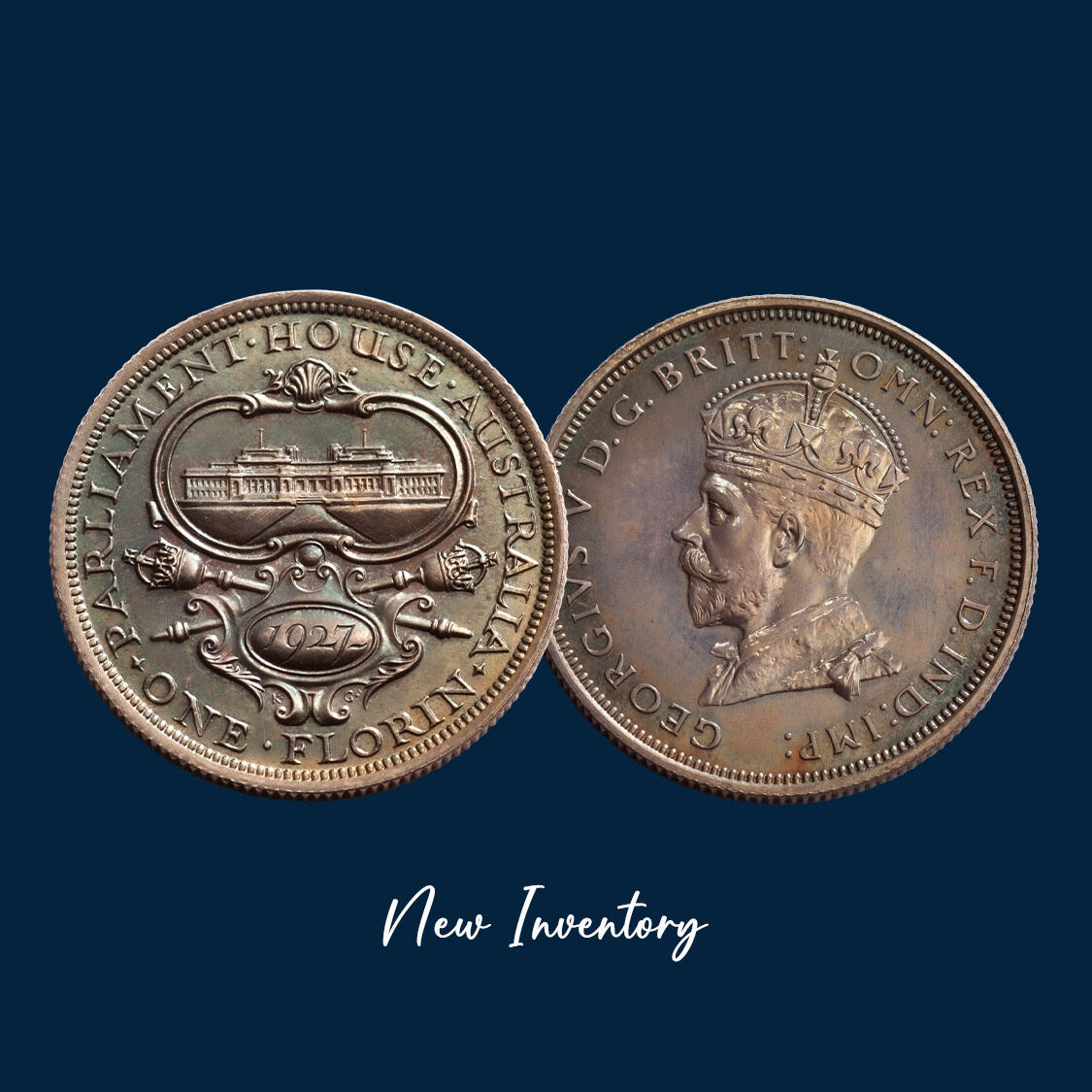
This 1927 Proof Canberra Florin is distinguished by a strong strike, brilliant mirror fields and magnificent emerald-green toning. Ex Barrie Winsor, February 2000, when it was sold to Marcus Plunkett to form part of the Treasures Collection. The coin is exceptional and is one of the few proof Canberra florins available today that is offered with a detailed provenance. And if you think the reverse looks great, wait until you see the obverse. The portrait of King George V almost leaps out of the coin!
Click here for more details on this Product
If we asked collectors to name the top five most popular and recognised Australian rare coins, without doubt the 1930 Penny would be at the top of the list.
But, the 1927 Proof Canberra Florin would, in all likelihood, be at position number two.
It is a coin that resonates with all Australians and for many collectors it's not a matter of 'if' I will buy a Proof Canberra Florin, it's 'when' I will buy one.
1. The coin has genuine rarity
While Melbourne Mint records show a mintage of 400, it is generally accepted that the issue did not sell-out, the proposed mintage too optimistic for the size of the collector market at the time. And non-collectors baulking at having to pay a premium over face value to acquire the 'proof'! The unsold coins were melted down, the mintage believed to be as small as 150.
The proofs were gifted to politicians and sold to the public without a case thereby introducing the possibility of mishandling.
So for the buyer that makes quality a priority, the waiting time for a really nice 1927 Proof Canberra Florin can be a minimum of two years. Perhaps even longer.
2. The coin is historically important
The Proof Canberra is Australia's first commemorative coin, minted for one of the most significant events in Australia’s journey to nationhood. The opening of the nation’s first Parliamentary buildings in the national capital in 1927. The coin is distinguished by a unique obverse featuring an enlarged bust of King George V, designed by Sir Edgar Mackennal.
3. The coin has a design that resonates with all Australians
In an article published in the CAB Magazine, February 2007, author and respected numismatist Vince Verheyen declared the 1927 Proof Canberra Florin "arguably Australia's most attractive predecimal silver coin". We can only agree. The reverse of 'Old Parliament House' was designed by George Kruger-Gray.
4. The coin has value and, over the long term, appreciating value
An analysis of auction realisations over the past forty years, confirms the 1927 Proof Canberra Florin is extremely scarce. On average one pristine example is offered every few years. We also note the coin has enjoyed solid price growth. In the 1980s, a Proof 1927 Canberra Florin was selling for approximately $1000 - $1500 at auction. In the 1990s the coin was fetching betwen $4000 - $6000. Two decades later, top quality Proof Canberra Florins are commanding prices in excess of $20,000.
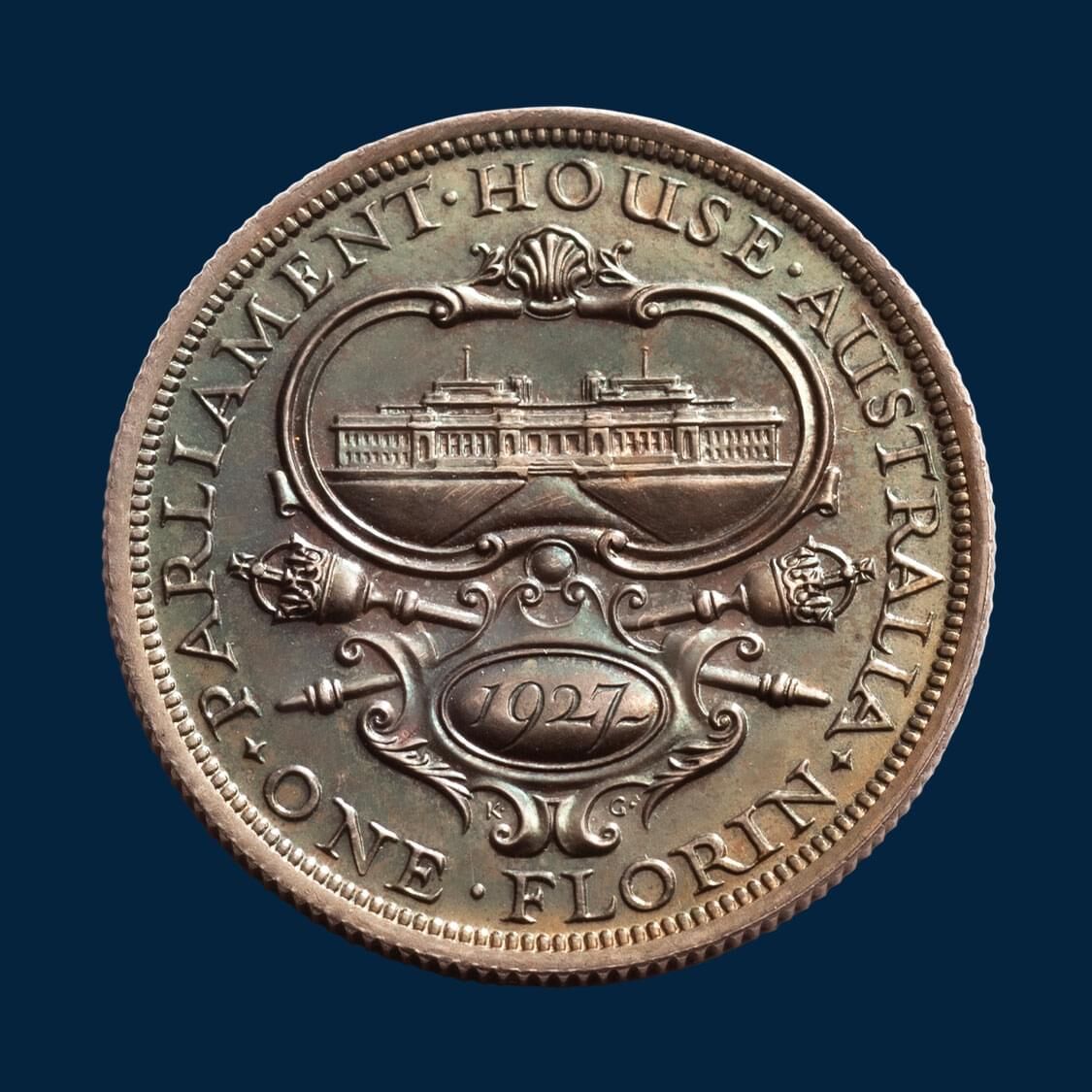
1927 Proof Canberra Florin
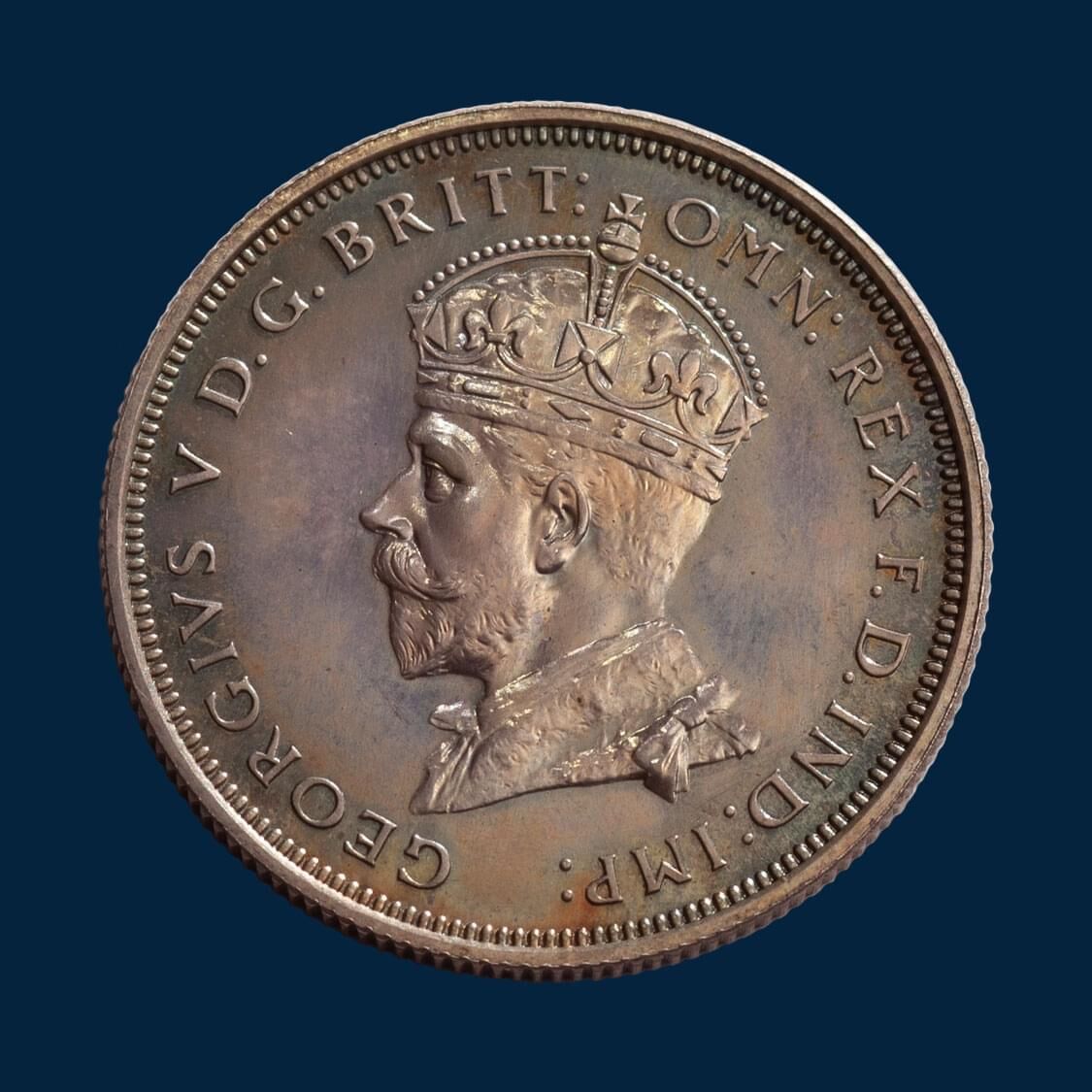
1927 Proof Canberra Florin
This Proof Canberra Florin is worth owning!
Using the naked eye, move the coin through the light, allowing it to reflect off the fields. Both obverse and reverse fields are brilliant, highly reflective. It is as though you are looking at a mirror.
• The emerald-green toning is magnificent!
• The edges are intact and solid.
• Under a magnifying glass we note, the striations, between the 'ONE' in the legend and the oval containing the date 1927. They are strong.
• Vertical striations on the obverse are similarly distinct and strong.
• Heavy striations equates to well brushed dies. Well brushed dies equates to a razor sharp, three dimensional coin design. And the three parliamentary steps are present!
• The fields are impressive. Amazing for a coin struck nearly a century ago. Our comment here is that the coin's former owners have always respected and cherished its quality for its state of preservation is remarkable.
1927 Proof Canberra Florin minted for one of the most significant events in Australia’s journey to nationhood, the opening of the first Parliamentary buildings in the national capital, Canberra.
Price: $25,000
This 1927 Proof Canberra Florin is distinguished by a strong strike, brilliant mirror fields and magnificent emerald-green toning. Ex Barrie Winsor February 2000 when it was sold to Marcus Plunkett to form part of the Treasures Collection.
The coin is extraordinary and is one of the few Canberra florins available today that is offered with a detailed provenance.
Exhibited at the Melbourne Mint, Williams Street Melbourne, 29 November 2011 in the launch of the Treasures Collection.
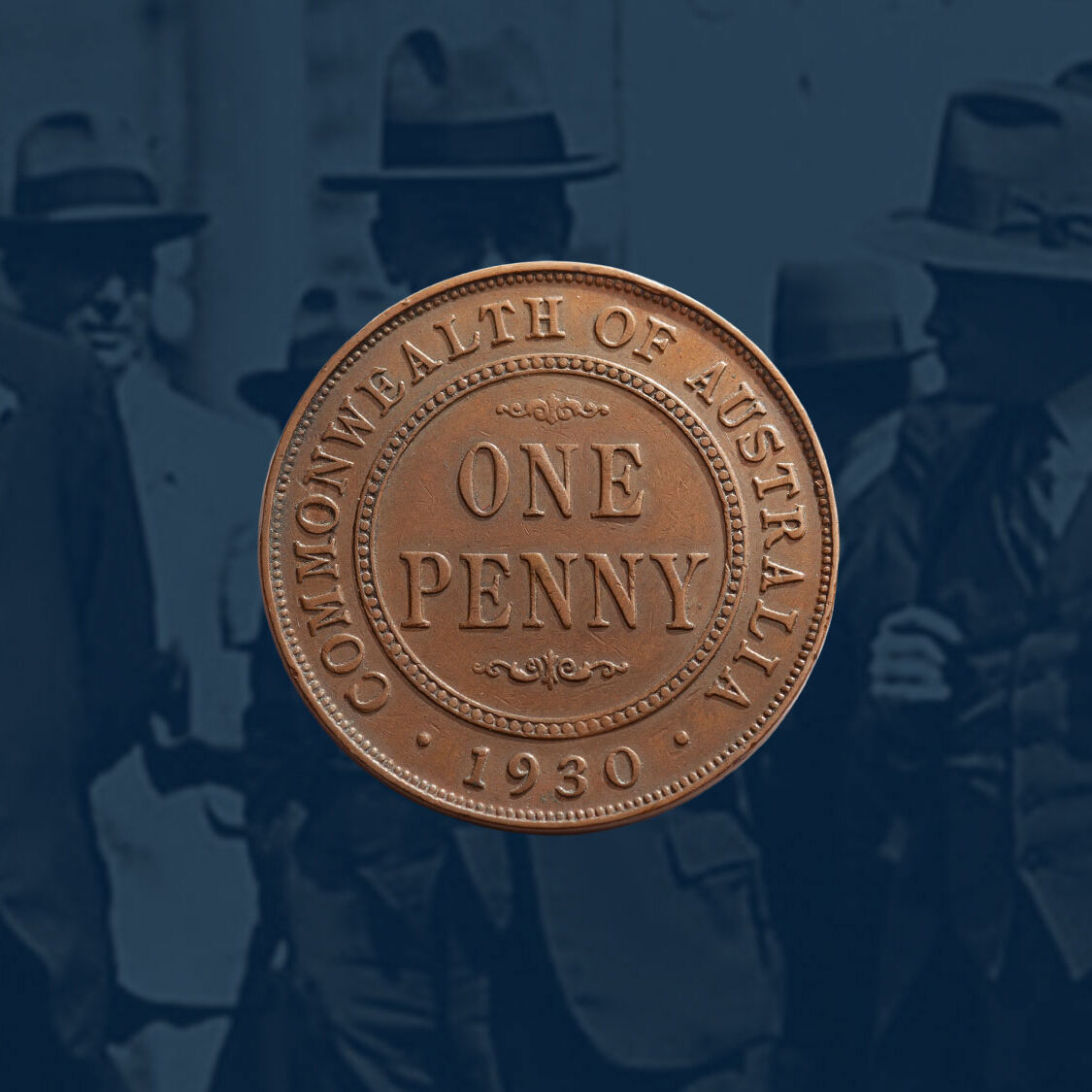
This is an impressive 1930 Penny. We note it’s been almost a year since we last offered one of this calibre. And at this price. The coin is elegant. The coin has finesse and is for the collector that has been sitting back waiting for the ‘right’ 1930 Penny to come along. It is an exciting 1930 Penny, for the exceptional quality traits it possesses. The reverse is graded Very Fine, the coin having crisp upper and lower scrolls, well-defined inner beading, strong legend and strong date. The obverse is graded Nearly Very Fine with an almost full central diamond and six plump pearls. We also note the years of usage have treated it very, very kindly. It is an original, intact, well struck 1930 Penny with glossy fields and minimal signs of usage. The past fifty-plus years in the business have taught us that you do not see 1930 Pennies like this every day. Or every month. Or every year for that matter!
Click here for more details on this Product
There are three basic steps involved when examining a 1930 Penny.
The first step is to look at the coin in the flesh using just the naked eye. A truly great coin will always look good to the unaided eye. And this coin is very impressive!
On the reverse, the upper and lower scrolls are strong and well defined. The inner beading which is invariably weakly struck between the 4 o'clock and 6 o'clock area is also well defined. The legend 'COMMONWEALTH OF AUSTRALIA' and date '1930' are powerful. Moving the obverse through the light you see the complete lower band of the crown. You also observe the strong design details of the monarch's robes. We also comment the handsome chocolate brown toning on both obverse and reverse and the edges which are solid.
The second step is to take up a magnifying glass and examine the coin in detail. The eye glass re-confirms what we have seen to the naked eye and much, much more. We have graded this coin Nearly Very Fine on the obverse which indicates that there are nearly four sides of the central diamond and six crisp pearls. The oval to the left of the central diamond is almost intact. The reverse is graded Very Fine. The coin has minimal marks in the fields and no unsightly gouges.
The final step is to re-visit the coin with the naked eye. Just to make sure that you have taken everything in. Start with the edges and work your way in, the inner beading, upper and lower scrolls, fields. And on the obverse, start with the edges, then the portrait and the fields.
The final assessment of this 1930 Penny confirms that it is a great coin and passes our three-point assessment with flying colours.
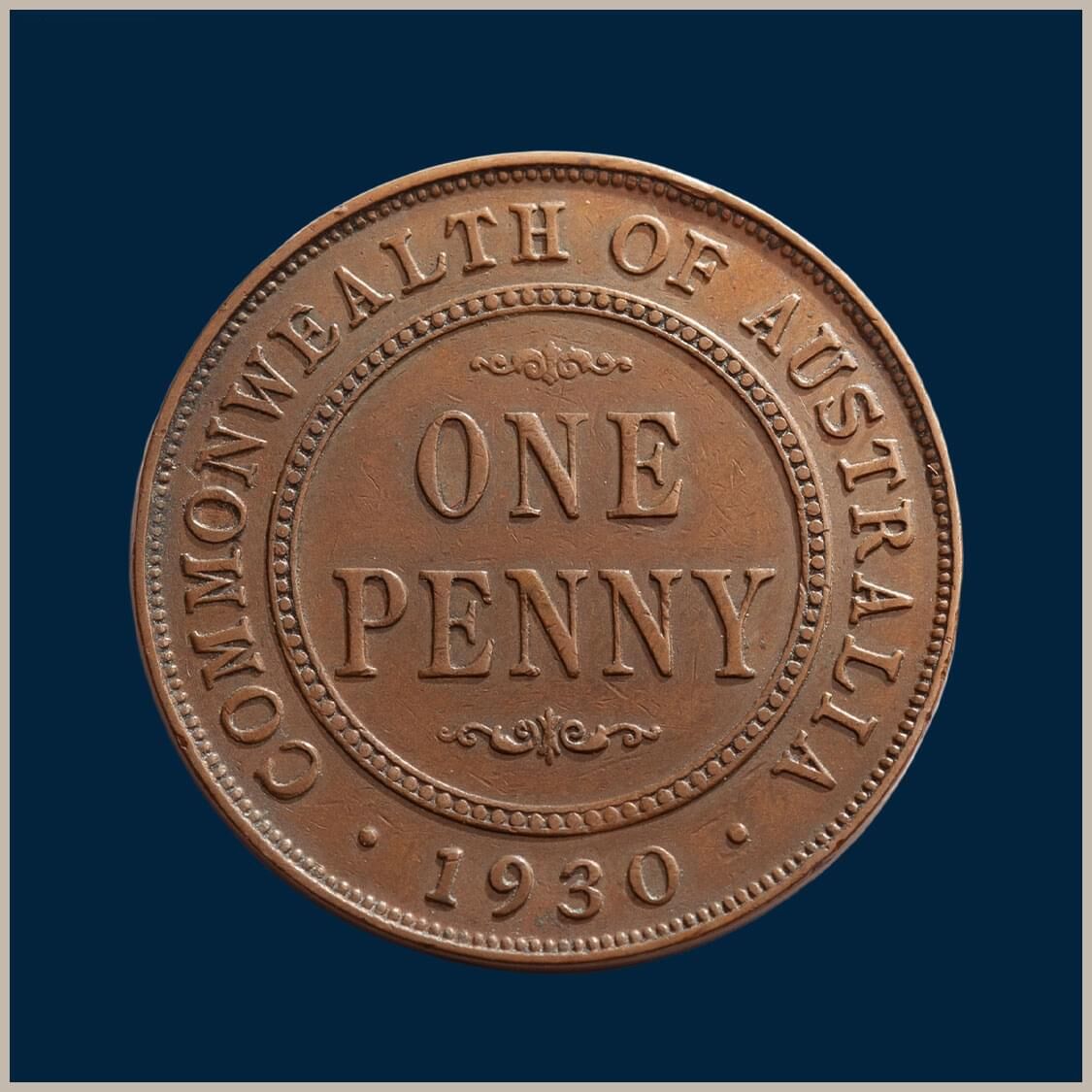
A simply fabulous 1930 Penny, with a very impressive reverse
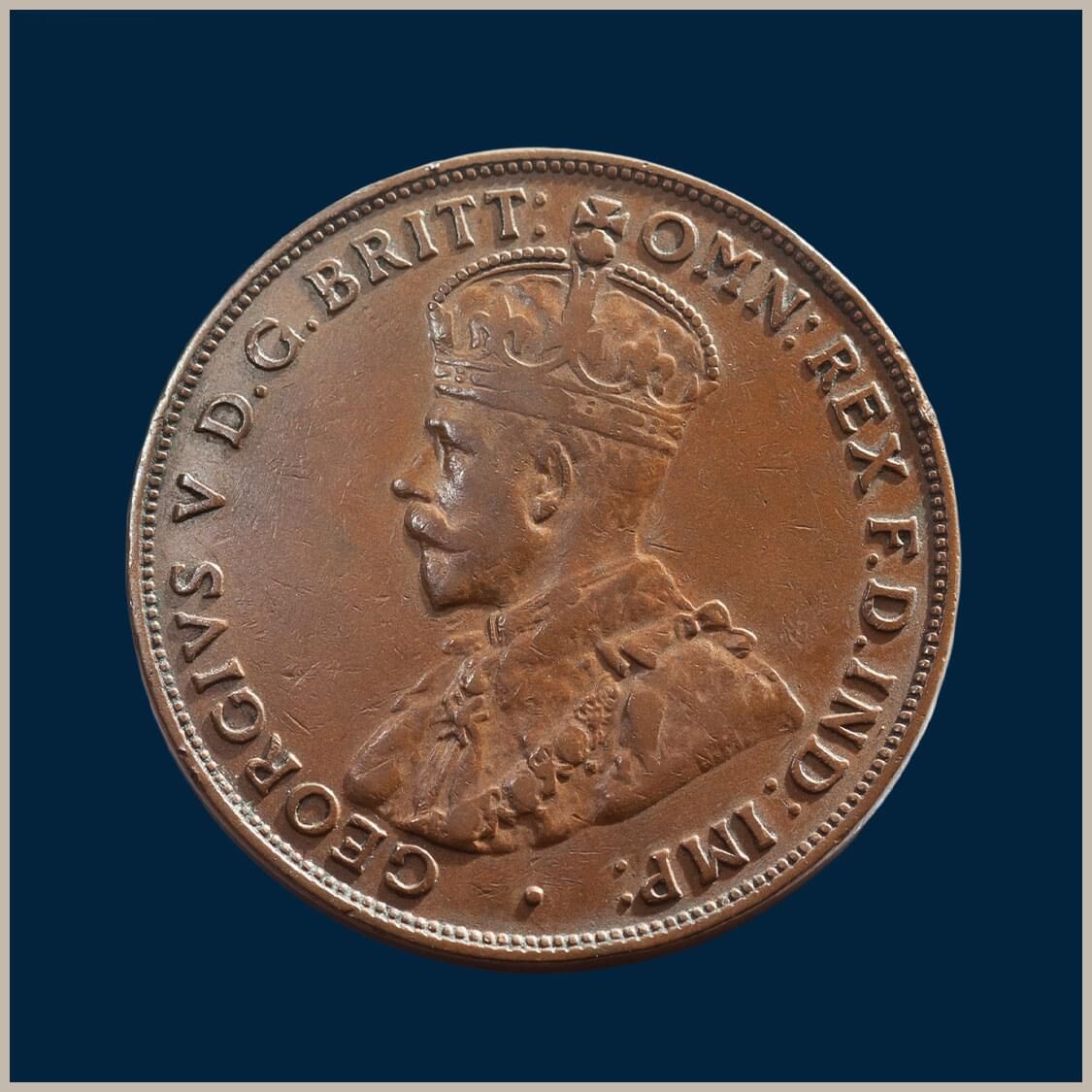
A simply fabulous 1930 Penny with an equally impressive obverse
There are many reasons why collectors love the 1930 Penny and one of the prime reasons is its financial reliability.
It is a solid coin. And this genuinely counts. In fact, we would go one step further and say that over the long term the 1930 Penny has probably been one of our most consistent and trustworthy numismatic performers.
The second reason is that the 1930 Penny is as Australian as you can get. Struck during the Great Depression, the 1930 Penny is the nation’s glamour coin and is unrivalled for popularity, enjoying a constant stream of demand unmatched by any other numismatic rarity.
The third reason is that the 1930 Penny is sought after at all quality levels and all dollar levels. It is in many respects an industry phenomenon, for in a market that is quality focused the 1930 Penny is keenly sought irrespective of its quality ranking. And growth over the mid to long term has been significant across all quality levels. Well circulated (Fine) 1930 Pennies were selling for £50 in the 1950s. A decade later, by decimal changeover, the coins were fetching £255 ($510). By 1988, Australia's Bicentenary, a Fine 1930 Penny had reached $6000. The turn of the century saw 1930 Penny prices move to a minimum of $13,000. Twenty years later prices have more than doubled. And with a 100th anniversary just five years away, the push to acquire Australia’s favourite Penny is really on.
Commonwealth of Australia 1930 Penny, a superb example of Australia's most sought after copper rarity with an almost full central diamond and six plump pearls.
Nearly Very Fine / Very Fine
$40,000
Strong upper and lower scrolls, prominent '1930' date, even chestnut toning, inner beading between 4 and 6 o'çlock strong. The coin stands up to scrutiny under the glass revealing an almost full central diamond and six clear and plump pearls.
The past fifty-plus years in the business has taught us that you do not see 1930 Pennies like this every day. Or every month. Or every year for that matter!
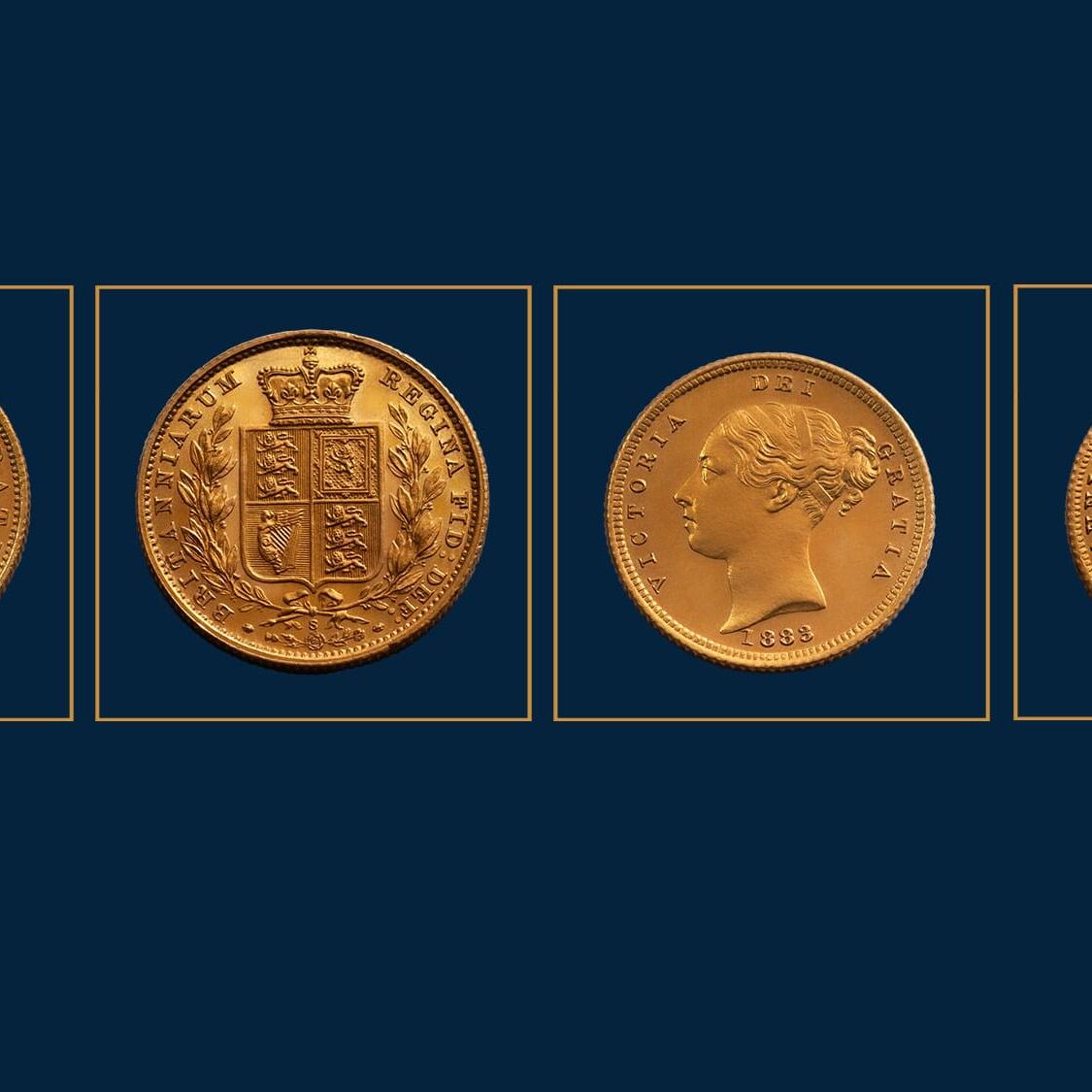
We are just putting the finishing touches to a report on the Sydney Mint proofs. Our study highlights their extreme scarcity. With pairs the ultimate in rarity. This unique Sydney Mint 1883 Proof Sovereign and 1883 Proof Half Sovereign pair will be available in December. Reservations and/or early enquiries are welcome.
Click here for more details on this Product
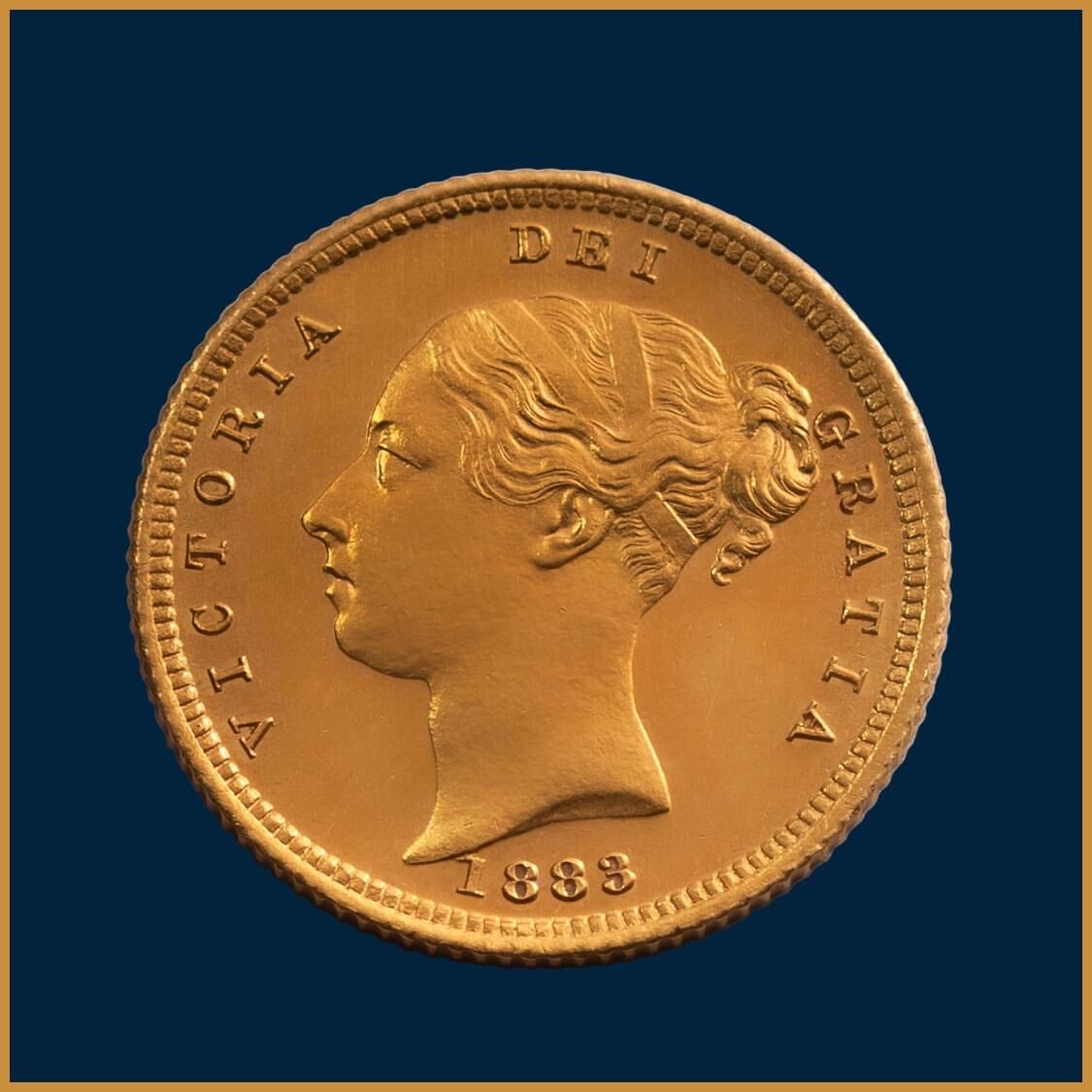
1883 Proof
Half Sovereign
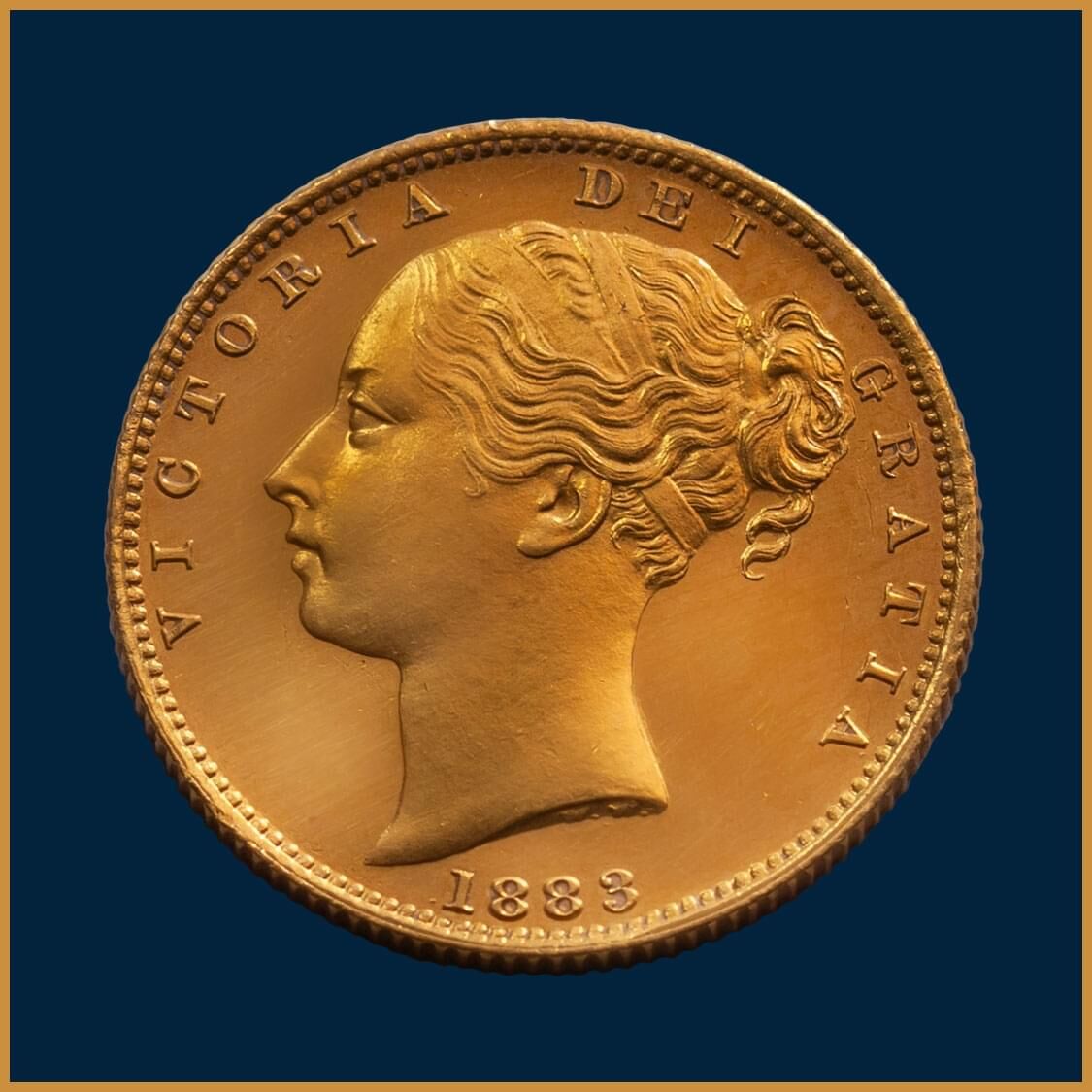
1883 Proof
Sovereign
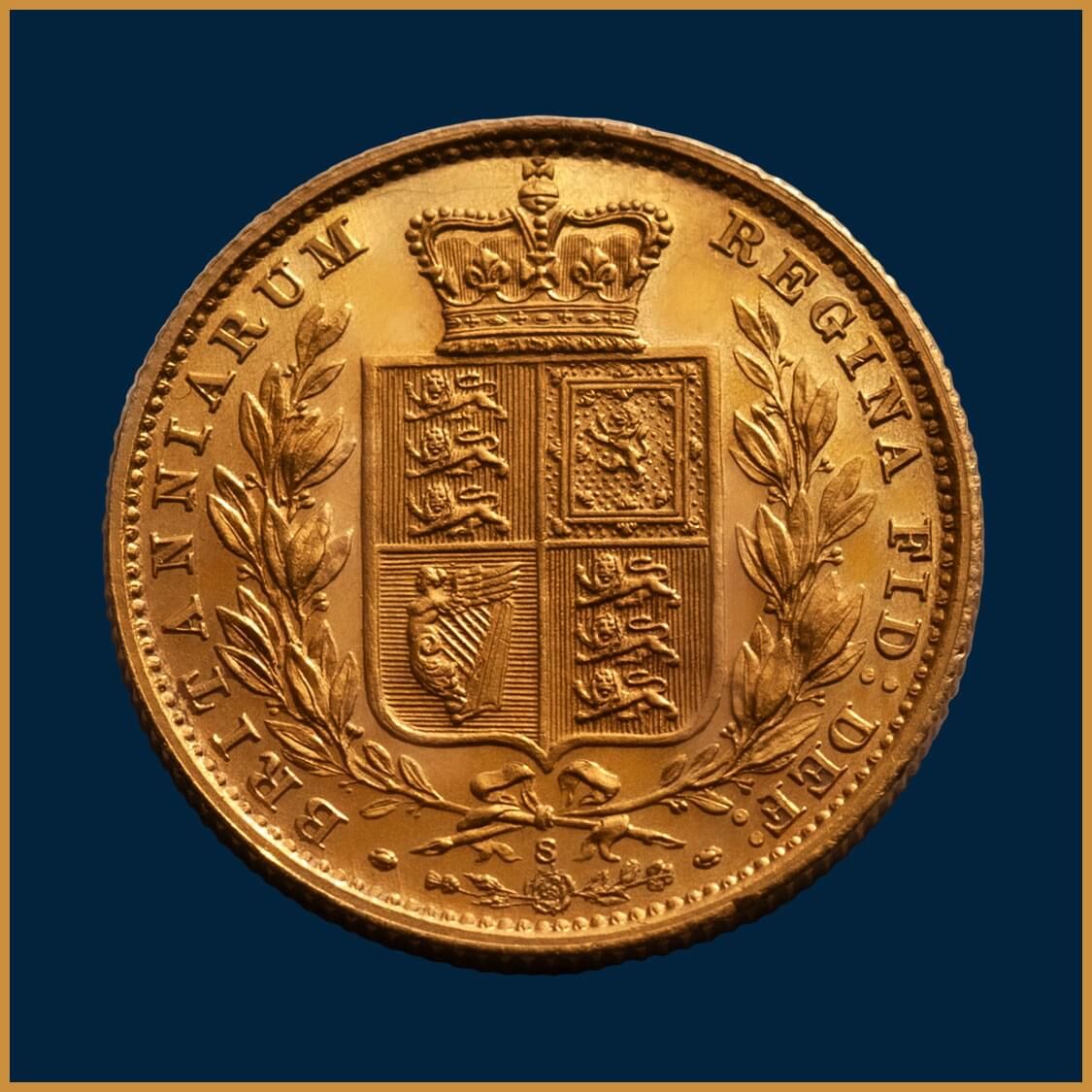
1883 Proof
Sovereign
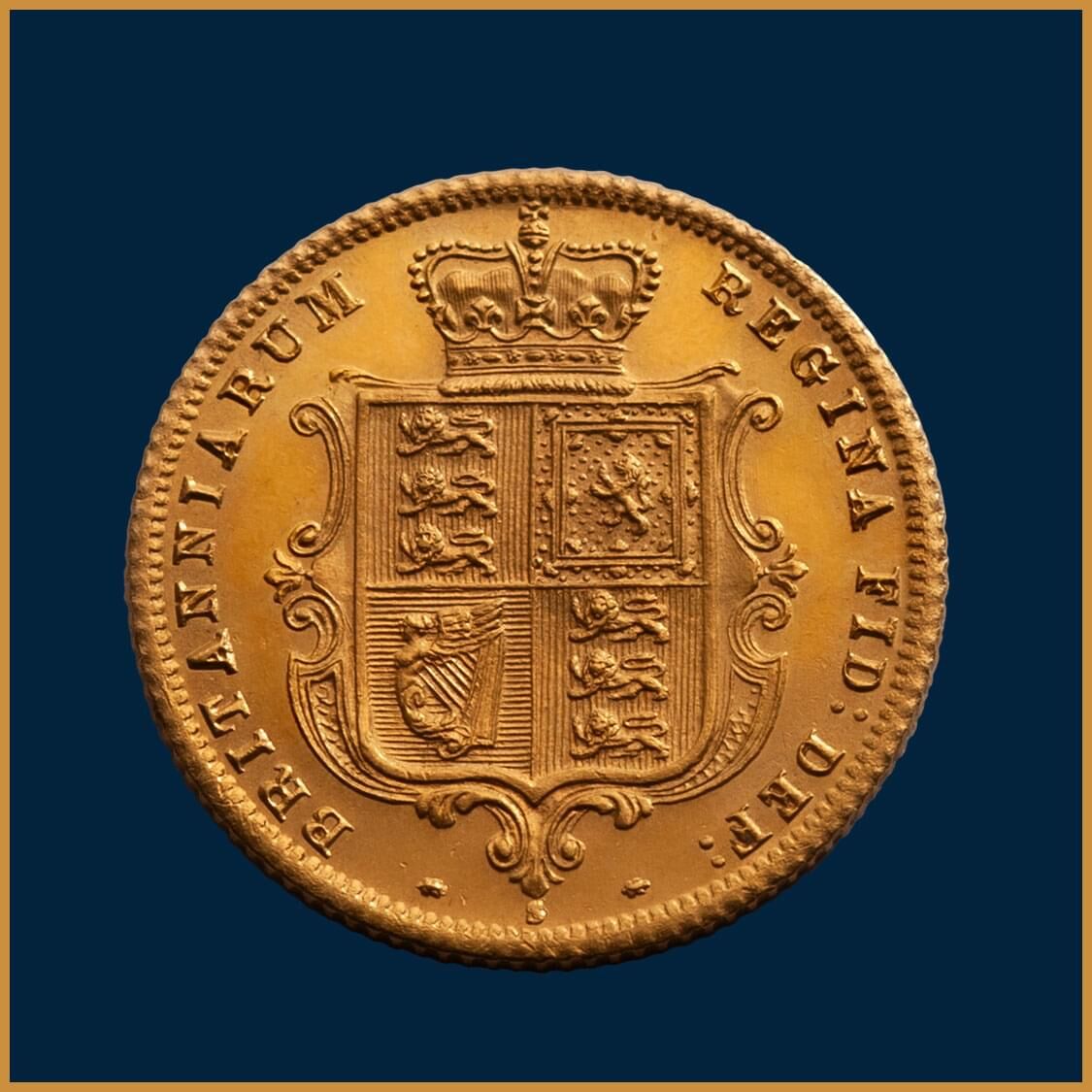
1883 Proof
Half Sovereign
1883 Proof Sovereign and 1883 Proof Half Sovereign struck as Coins of Record at the Sydney Mint
Sydney Mint proofs are inordinately rare and this pair unique.
Available in November.
Reservations and/or enquiries welcome.
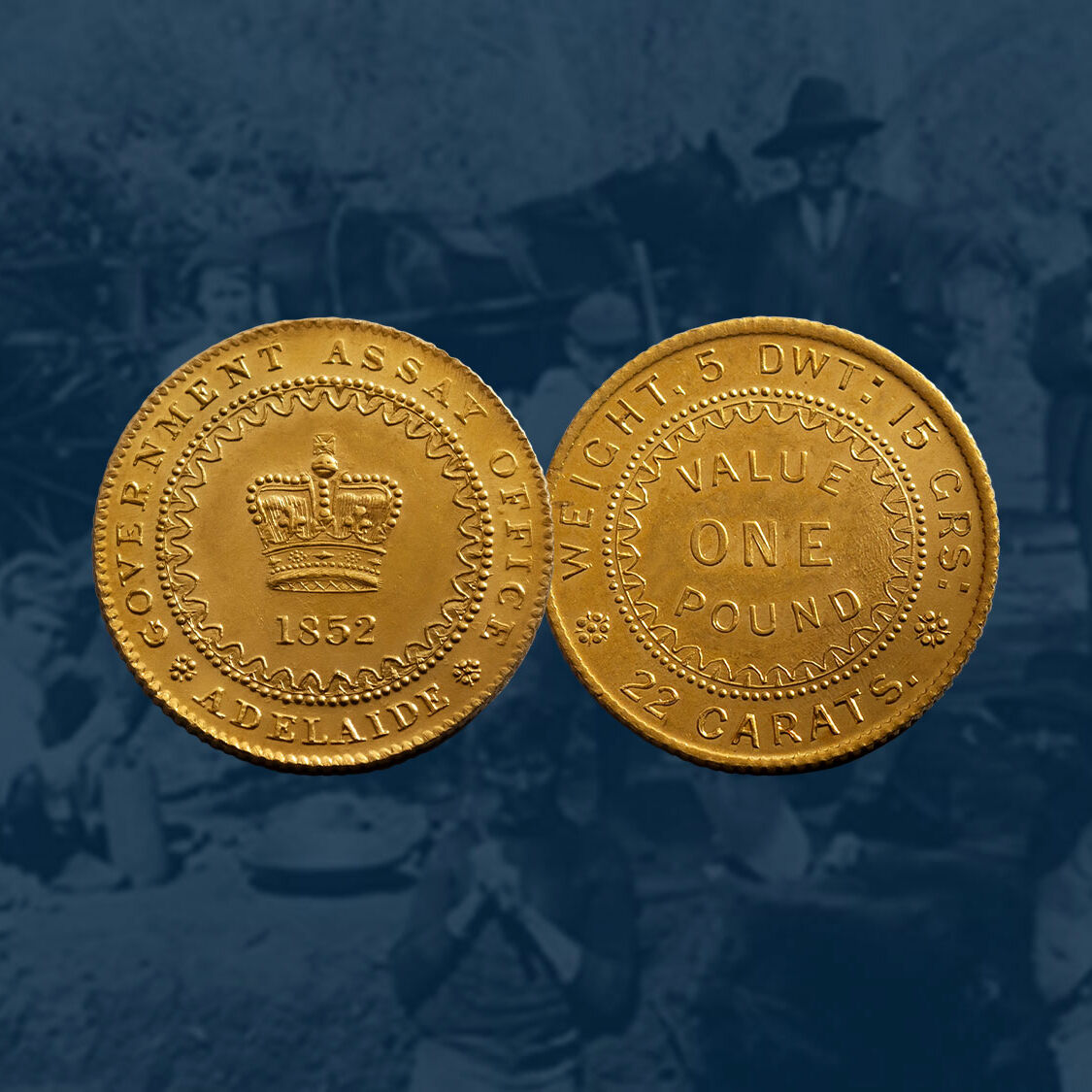
It is a natural consequence that owners of the 1852 Type I Adelaide Pound also seek out the Type II Adelaide Pound. Two pieces that are the ultimate pair, representing examples from the first and second production run of the nation's first coin. Finding a suitable Type II presented challenges for the owner of the famed Nobleman One Pound. He embraced the luxury and finesse of his Type I and wanted the same in his Type II. He found what he was looking for in this Choice Uncirculated Adelaide Pound Type II. Pristine strike as evidenced in the edges, the legend and the fine detail of the crown. And superb ultra-lustrous fields. Available in November. A reservation and/or preliminary enquiries are welcome.
Click here for more details on this Product
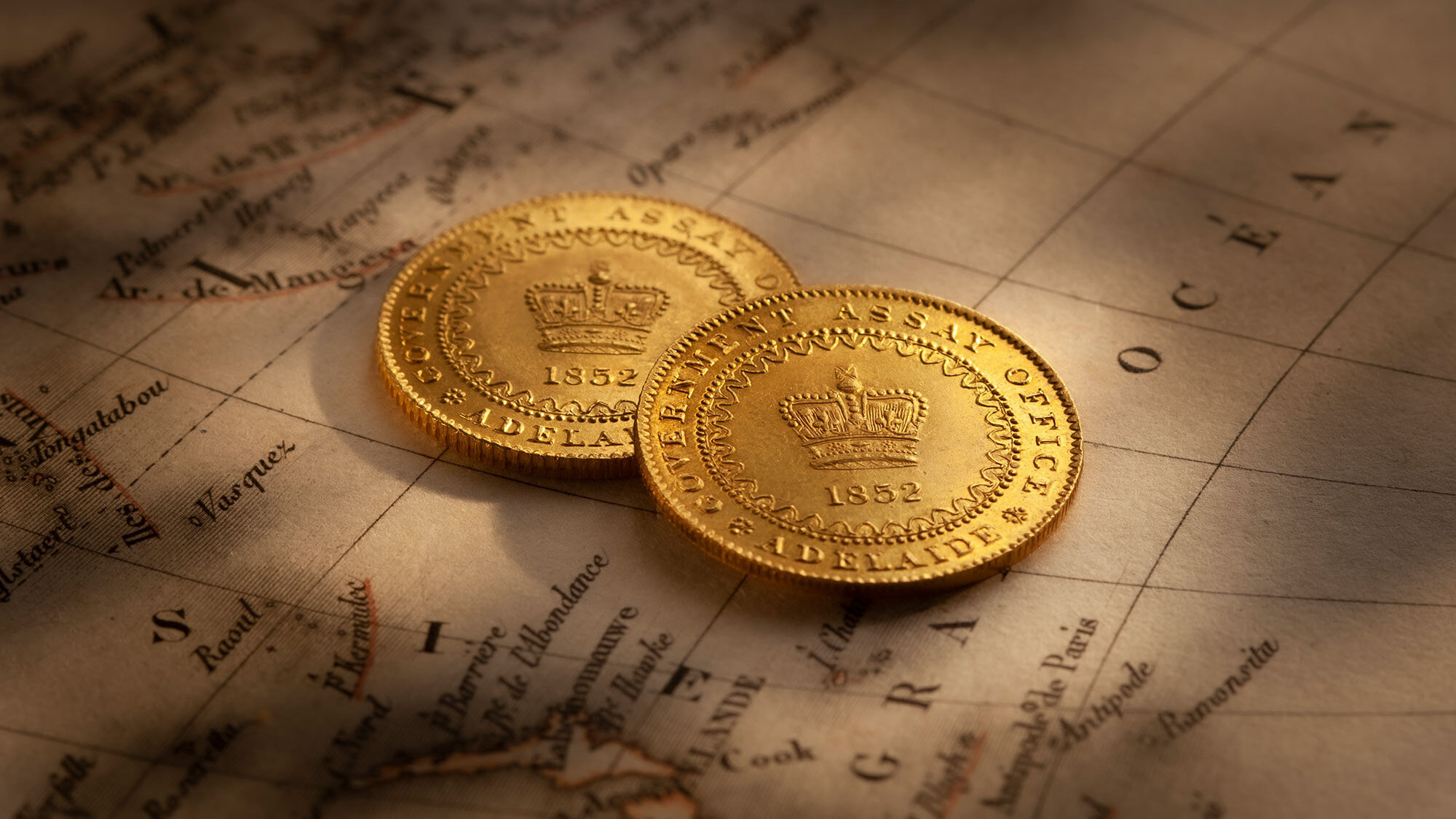
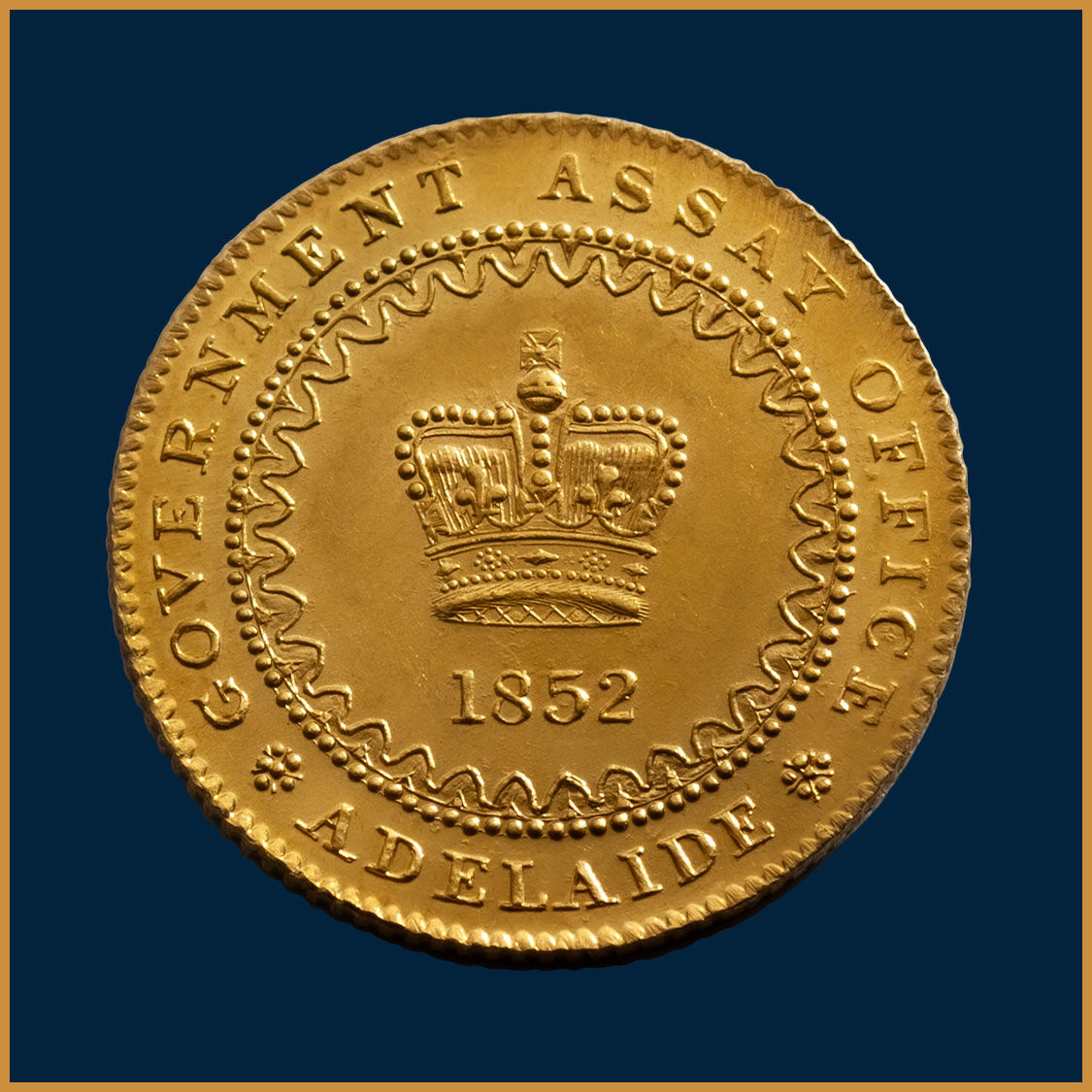
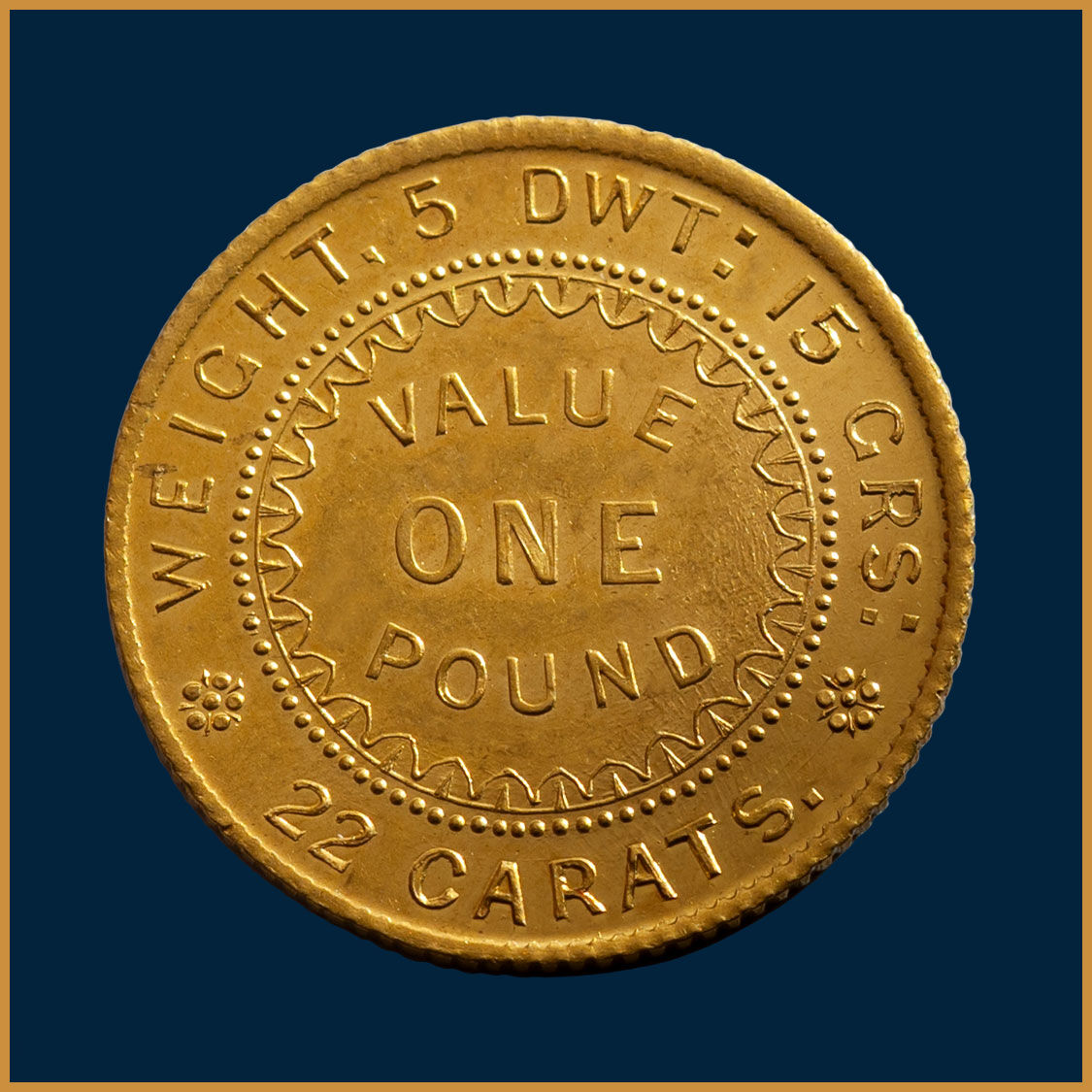
1852 Adelaide Pound struck using the second reverse die featuring a scalloped inner border (Type II)
Choice Uncirculated
It is a natural consequence that owners of the 1852 Type I Adelaide Pound also seek out the Type II Adelaide Pound. Two pieces that are the ultimate pair, representing examples from the first and second production run of the nation's first coin.
Finding a suitable Type II presented challenges for the owner of the famed Nobleman One Pound.
He embraced the luxury and finesse of his Type I and wanted the same in his Type II. He found what he was looking for in this Choice Uncirculated Adelaide Pound Type II.
Pristine strike as evidenced in the edges, the legend and the fine detail of the crown. And superb ultra-lustrous fields.
Available in November. A reservation and/or preliminary enquiries are welcome.
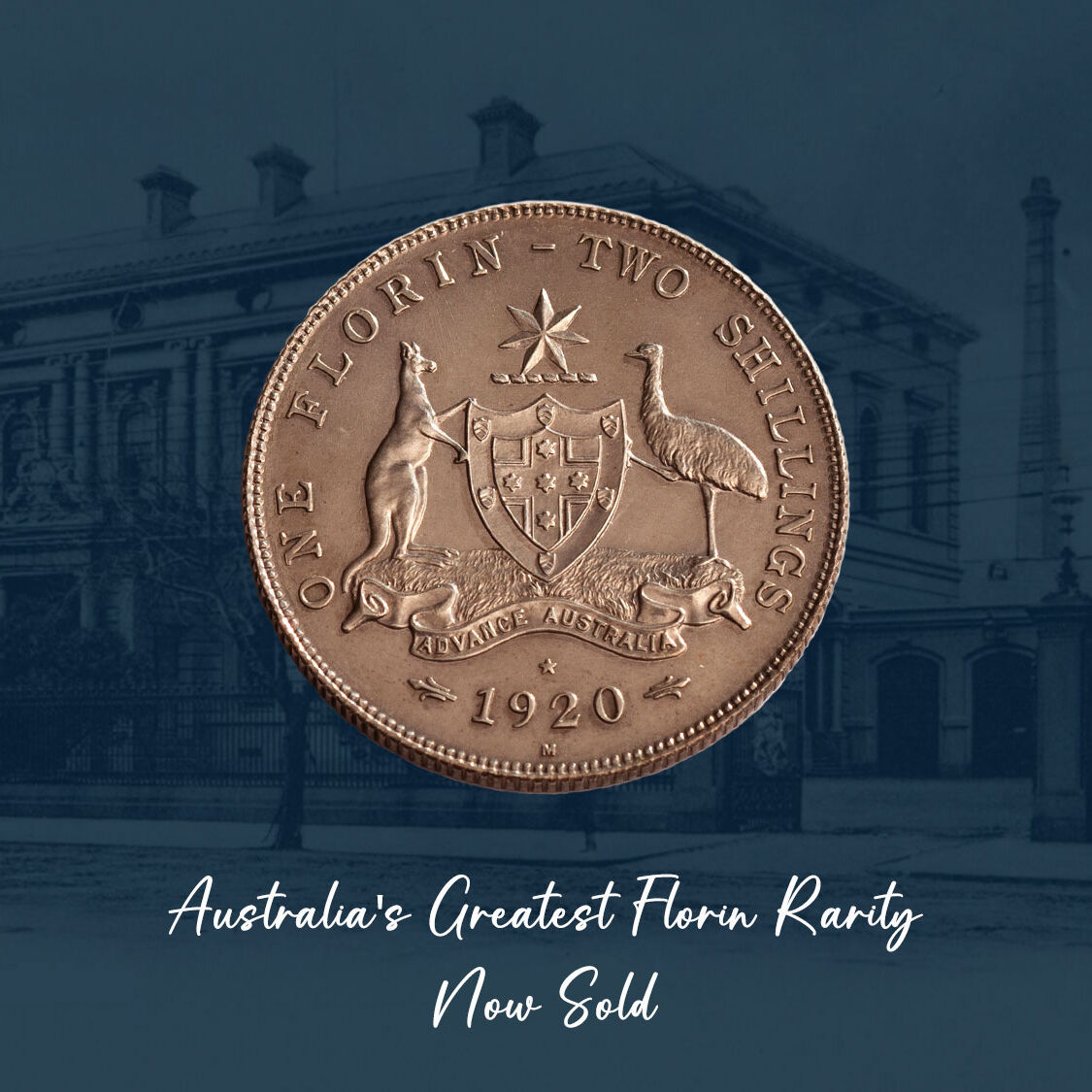
Sale number 24, conducted by Spink Auctions (Australia) in March 1988 was one of the company's most important auctions; a bicentennial celebration of all that was great in the Australian rare coin industry. The breadth and depth of excessively rare, high quality coins was compelling and overwhelming and was an event that is unlikely to be repeated. The auction made history! Out of the glittering array of esteemed rarities, a 1920 Star Florin was chosen to appear on the front cover of the catalogue. This is perhaps the simplest and easiest way of conveying the importance of the 1920 Star Florin to the industry. The coin is Australia's greatest florin rarity - the rarest florin struck for circulation. One of only seven produced at the Melbourne Mint as part of a specially controlled circulation strike, three of which are held by private collectors. And this example, one of the three ex Morton & Eden London, with superb detail and impressive satin surfaces.
Click here for more details on this Product
Rarity and circumstance have made the 1920 Star Florin one of Australia's greatest coin rarities.
In 1920, no florins were struck for general circulation. Seven florins were however produced at the Melbourne Mint as part of a specially controlled circulation strike and each coin featured a star above the date.
Distribution of these prized pieces was heavily restricted. Influential collector Albert Le Souef, (a Deputy Master of the Melbourne Mint between 1921 and 1926), obtained one of the seven. Three examples were retained by the mint with three heading to London, the Royal Mint the main recipient.
Aside from the Le Souef's coin, a further two have since emerged in the private sector. This coin acquired out of London and the other, sold on behalf of the Melbourne Mint museum through an Australian auction house as part of a fundraising exercise, late in 1988.
As to why no circulation florins were struck in 1920. Wildly fluctuating silver prices posed a serious issue for Governments, such as Australia, that were striking their coins in sterling silver.
The possibility that the intrinsic value of a coin would exceed its face value was a real one. The Government pondered a debasement of its coinage to lower the costs.
As to why the star appeared above the date. The dies were re-worked just in case the Government changed its mind and decided to strike a mintage of circulating florins with a reduced silver content, the star to signify the debasement.
History records that only seven circulating florins were struck in 1920, this coin one of the seven.
It is Australia's greatest florin rarity - the rarest florin struck for circulation.
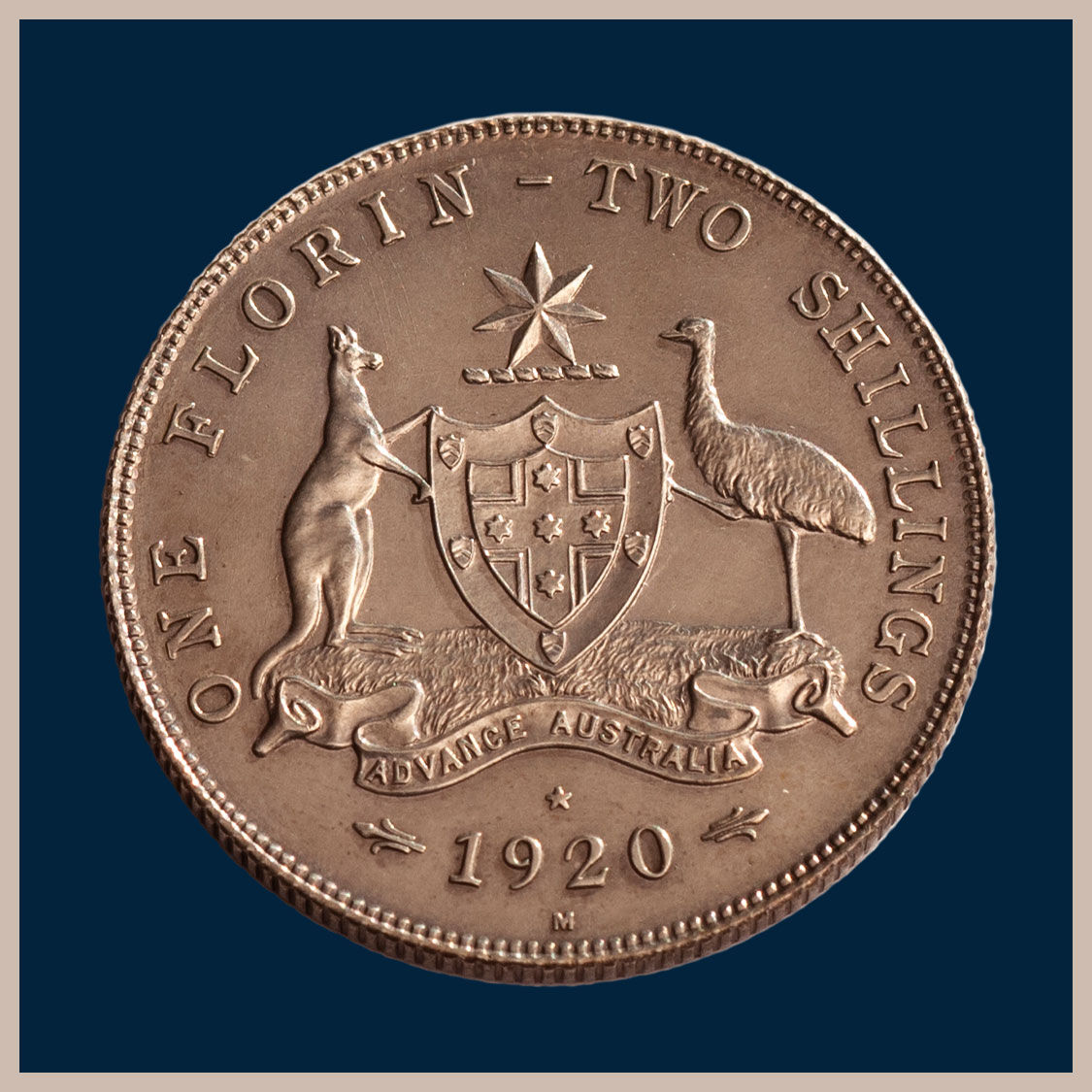
Melbourne Mint
1920 Star Florin
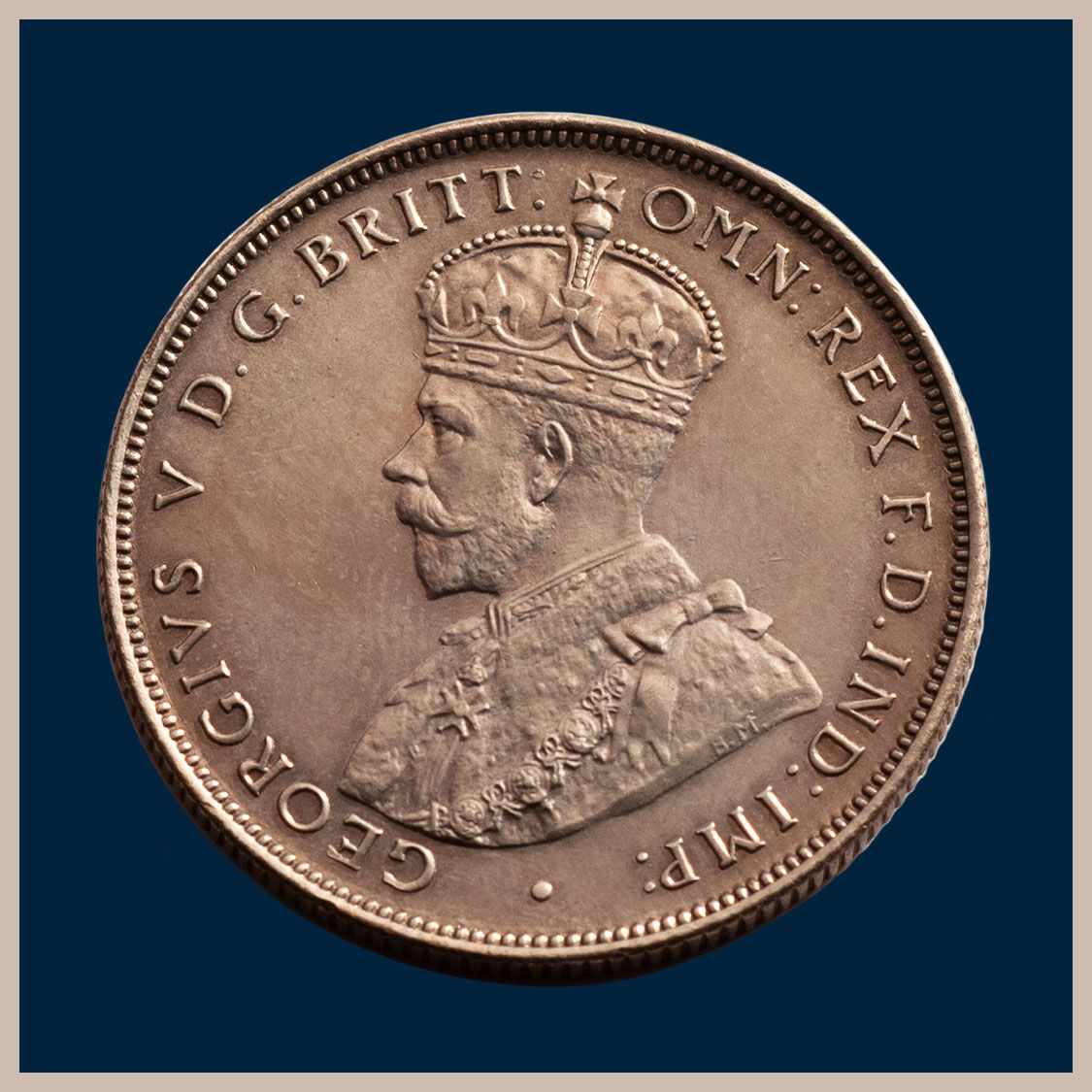
Melbourne Mint
1920 Star Florin
The 1920 florins, showing the star above the date, were prepared as a result of a sudden rise in the price of silver that caused Great Britain and many other countries to reassess the silver content of their respective currencies.
Britain abandoned around 800 years of tradition when it reduced the finesse of its Sterling silver (92.5% pure) coins to an alloy of 50%. Canada also moved from the 92.5% standard down to 80% while British West Africa dropped silver issues completely in 1920 in favour of nickel and nickel brass coins.
Australia considered a similar move but in a gesture which cynical taxpayers of today would find very refreshing, the government wanted the public to be completely aware that the new coins would contain less silver.
According to the former numismatic curator of the Museum of Victoria, John Sharples, the normal order for 1920 dies for the silver coins had been placed in July 1919. At that time the intrinsic worth of the silver was less than the face value of the respective denominations and so no special instructions were issued in respect to the dies being prepared by the Royal Mint in London.
However by March 1920 the situation had changed drastically. According to John it was decided to prepare new dies which featured smaller date figures to differentiate the debased coins from the earlier issues.
Judging from correspondence that came back from London, it would appear that the mint had already started work on the dies or was too busy with other projects. A suggestion came back that a star above the date would not only be more noticeable but could be produced more easily and quickly than reworking the date.
This change was accepted by Melbourne and working dies for 1920 and punches for 1921 were ordered with the star. By August 1920, the Melbourne Mint had received thirty pairs of working dies for the florin and shilling denomination.
By the time everything was in place the silver crisis had passed. The silver price dropped, and neither the reduction or a circulation version of the 1920 florin eventuated.
No 1920 dated florins were issued for circulation. Three other denominations were struck for circulation in 1920, the shilling, sixpence and threepence. None carried the star. On some of the 1920 shillings (and even the sixpences) a small indentation above the date can be seen in high-grade coins, where the star has been removed on the die.
Strangely enough, the 1921 shilling still carried the star, although the silver crisis had long passed.
The excessively rare Melbourne Mint 1920 Star Florin, FDC
Ex Morton & Eden London 2007
Price: $95,000
Sale number 24, conducted by Spink Auctions (Australia) in March 1988 was one of the company's most important auctions; a bicentennial celebration of all that was great in the Australian rare coin industry.
The breadth and depth of excessively rare, high quality coins was compelling and overwhelming and was an event that is unlikely ever to be repeated. The auction made history!
Out of the glittering array of esteemed rarities, a 1920 Star Florin was chosen to appear on the front cover of the catalogue.
This is perhaps the simplest and easiest way of conveying the importance of the 1920 Star Florin to the industry.
The coin is Australia's greatest florin rarity - the rarest florin struck for circulation. One of only seven struck at the Melbourne Mint, three of which are held by private collectors, and this example with superb detail and fabulous satin surfaces.
If further accolades are required. The Numismatic Association of Australia (NAA) issued their inaugural journal in July 1985, a publication that continues to this very day. The first edition featured the 1920 Star Florin on the front cover!
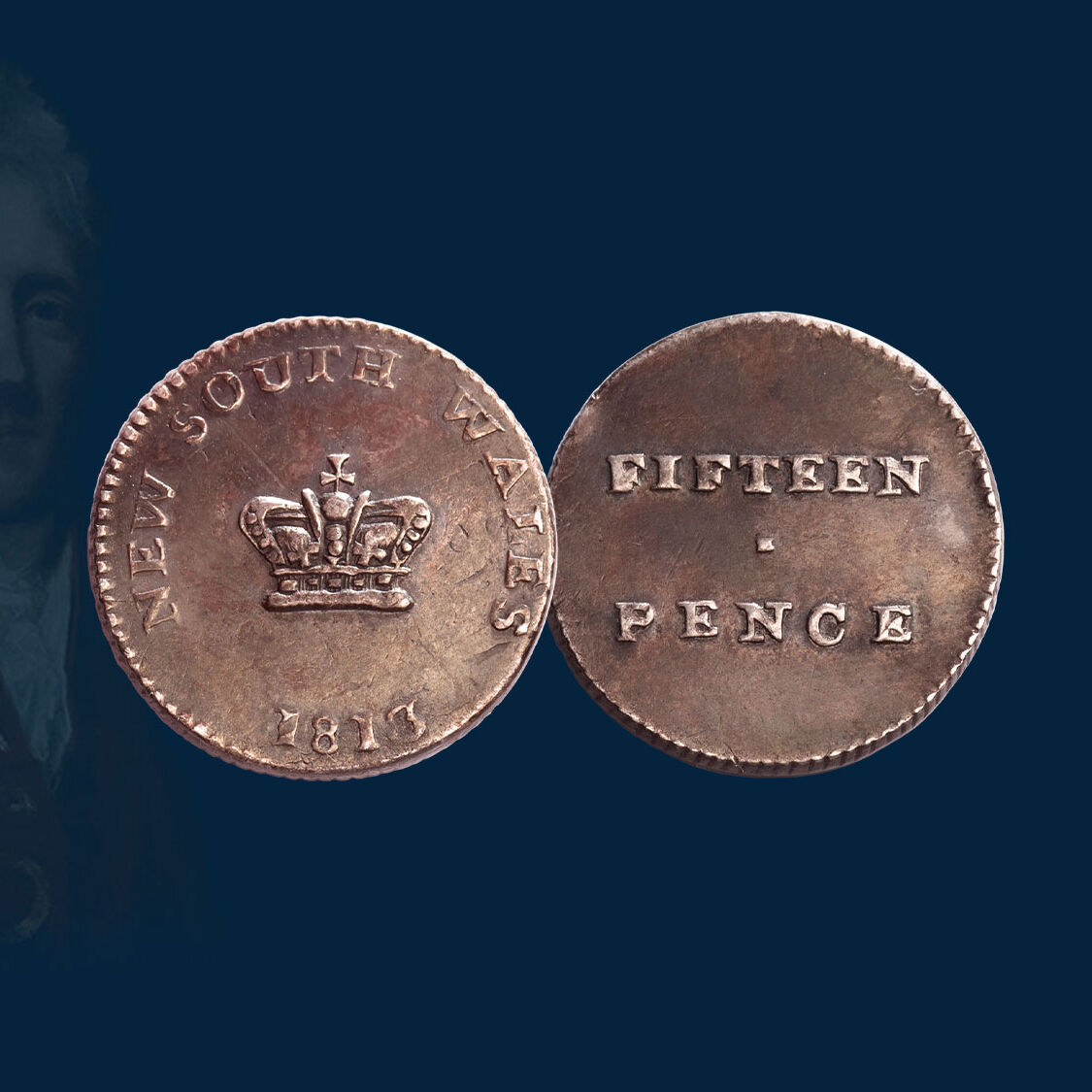
When you look at this 1813 Dump in your hand, the fields are like glass and very reflective. The design details are super-fine and clearly visible to the naked eye. And that’s a sign of a high-quality coin. This is a superior quality example of the nation’s first coin, technically ranked in the top five per cent. Over and above its quality ranking this coin has attributes that are highly prized, traits that you simply don't see in every Dump. For a start there is the 'H’ for Henshall on the reverse, the mark left by the nation’s first mint master that guaranteed his fame. On the obverse, there also is evidence of the original Spanish Dollar design from which it was created. Intact edge milling, the minting authority's ploy to prevent clipping of slivers of silver from the edges. And the elusive dot above the ‘3’ in the date 1813. A Dump that offers the lot.
Click here for more details on this Product
The buyer that pursues a top quality Dump will find the task extremely challenging. It can be years before a premium quality example comes onto the market and decades before the very best becomes available. And that statement is said in the knowledge that there are perhaps 800 Dumps, across all quality levels, available to private collectors.
The Dump with a value of fifteen pence circulated widely in the colony, the extreme wear on most Dumps evidence that they saw considerable use. The Holey Dollar being a higher valued piece, at five shillings, had a narrower band of circulation.
So, while the Dump may seem the diminutive partner of the Holey Dollar, the reality is top quality Dumps have authority. They are extremely rare, in fact far rarer than their holed counterpart in the same quality level. Official Bank of New South Wales records show that in 1820 the bank held 16,680 Holey Dollars and only 5900 Dumps. Considering that 39,910 of each were released into circulation, the figures reflect the greater circulation of the smaller denomination Dump.
Top quality Dumps are extremely rare and highly valued.
Documentation as to the method of manufacture of the Holey Dollar and Dump has never been found. It is however safe to assume that whatever machinery was employed, it was hand operated as the first steam engine did not become operational in the colony until 1815.
Likely production options were the screw press, drop hammer or hand-held punch with the drop hammer method onto a pre-heated plug generally regarded as the most likely.
There is no doubt that heat was involved in the creation of the Dump. When the disc fell out of the centre of the Spanish Dollar, it still bore the original dollar design of a four quadrant shield, housing a lion and castle in each quadrant. And the shield's cross-bars. High temperatures obliterated the original Spanish Dollar design from most examples.
Those Dumps that retain the original dollar design elements are highly prized.
The high temperatures also caused an expansion of the metal disc that fell out of the dollar. The very reason why the Dump is always larger than the hole in the Holey Dollar.
The haphazard, obliquely grooved edge milling found on the dumps indicates that a 'fiddle method' was the final step in the production process whereby a roll of Dumps was rotated under pressure against a grooved cylinder.
While no one knows the method of manufacture, history records that convicted forger and emancipist, William Henshall, was hired to create the nation's first currency, effectively our first Mint Master. He declared his involvement in the creation of the Dump - and the Holey Dollar - by inserting his initial, an 'H' for Henshall, on some - but not all - of the reverse dies of the Dump. And some - but not all - of the Holey Dollar counter stamp dies.
Amazing to think that a convicted forger created the first 'mint mark' on Australia's first coinage!
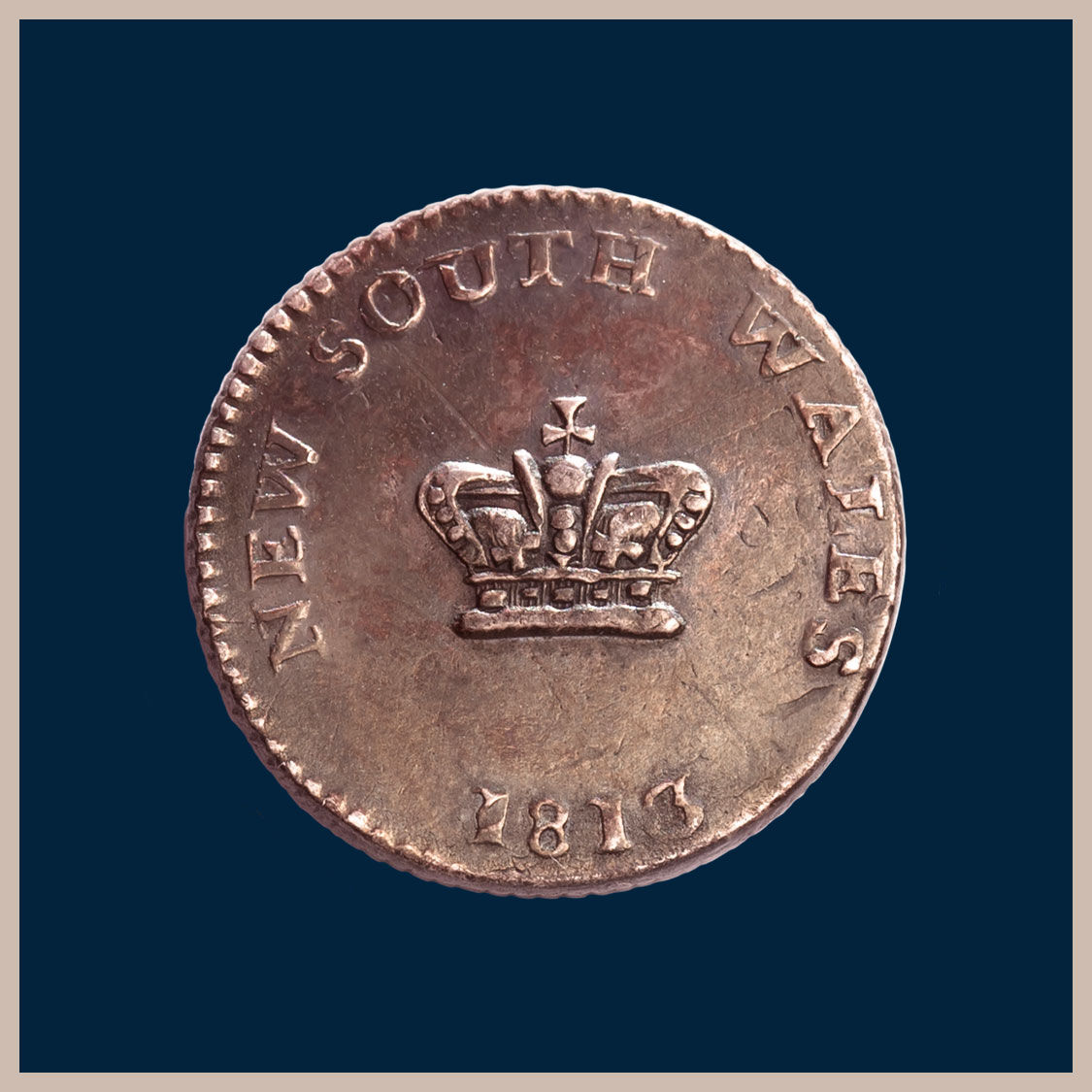
1813 Dump
struck using the A/1 dies
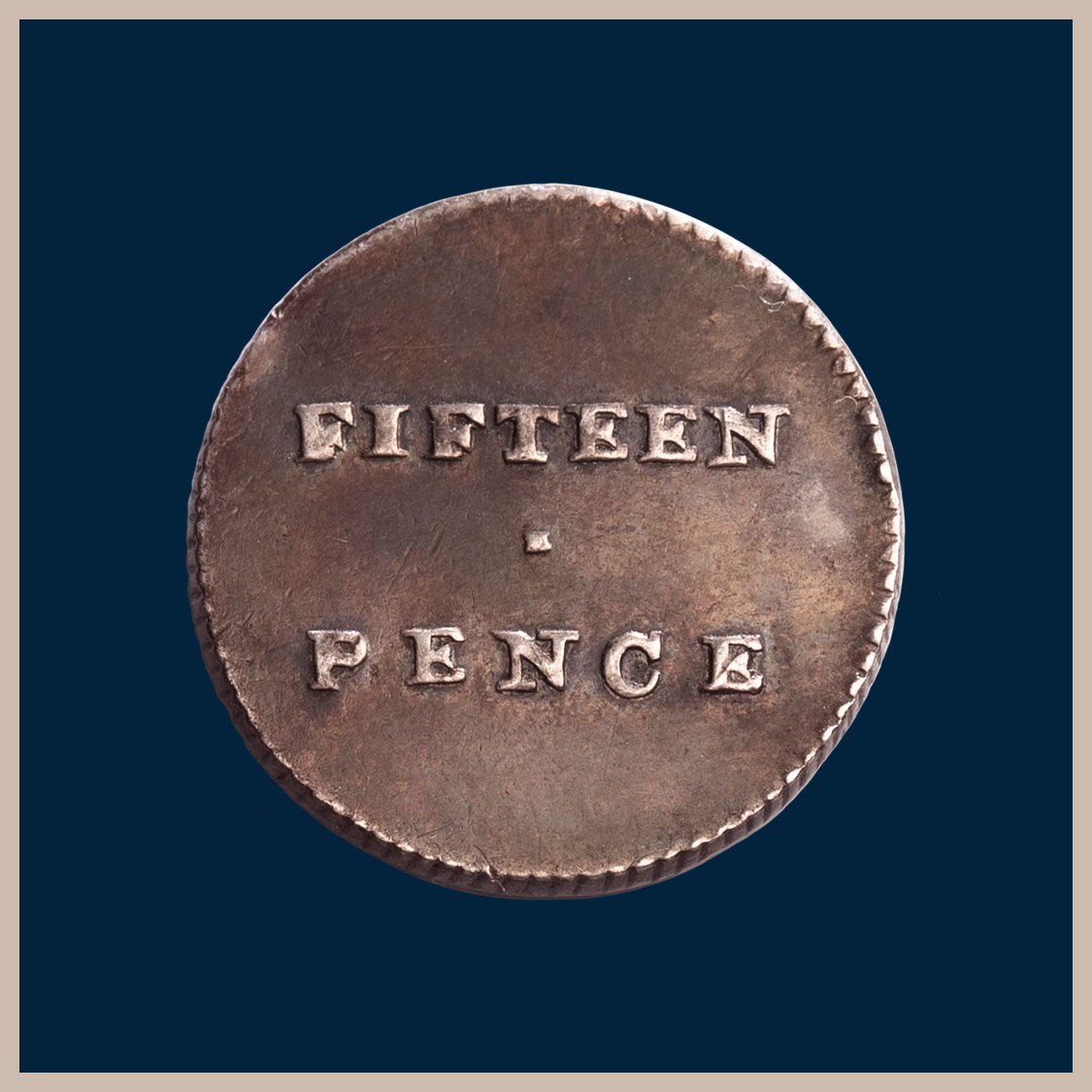
1813 Dump
struck using the A/1 dies
This is a classic example of the 1813 Dump.
1. The 1813 Dump circulated widely in the colony, the extreme wear on most Dumps evidence of its extensive use. The average quality Dump is graded at Fine to Good Fine, with this coin at least four grades higher at Nearly Extremely Fine / Extremely Fine. (See chart below)
2. Struck with the A/1 dies, the crown is classically well-centred and well struck, the design definition strong.
3. William Henshall inserted an 'H' into some (but not all) of the dies used during its striking. The 'H' is strong and three dimensional.
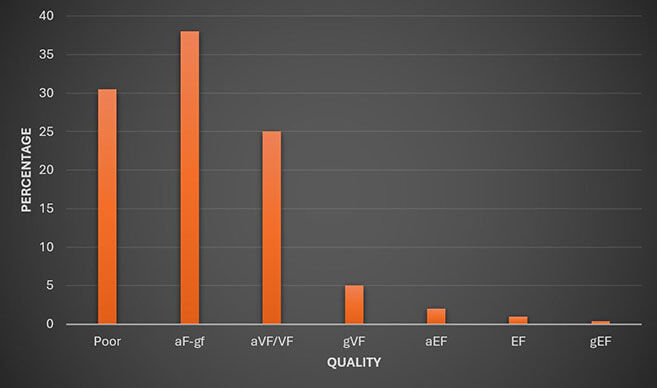
4. The denticles around the edge of the coin are evident, almost half way around. Complete denticles, all the way round, is a phenomenon that is rarely seen on the 1813 Dump.
5. The oblique milling around the edge is fully evident. (The edge milling was used as deterrent against clipping whereby the unscrupulous shaved off slivers of silver, reducing the silver content of the Dump. And making a small profit on the side.)
6. While the Holey Dollar clearly shows that it is one coin struck from another, in a less obvious way so too can the Dump. The design detail of the original Spanish Dollar from which this Dump was created is evident on the obverse. We refer to it as the under-type and it is not always present. Its existence re-affirms the origins of the Dump and is highly prized.
7. This Dump shows a 'dot' above the '3' in the date '1813'. This is almost certainly due to a pit in the die and only occurs in those coins struck with the type A/1 dies. And even then it is identified in very few type A/1 examples.
1813 Dump struck from A/1 dies, Nearly Extremely Fine / Extremely Fine and rare in this quality
When you look at this 1813 Dump in your hand, the fields are like glass and very reflective. The design details are crisp and clearly visible to the naked eye.
And that’s a sign of a high-quality coin.
This is a superior quality example of the nation’s first coin, technically ranked in the top five per cent.
Over and above its quality ranking this coin has attributes that are highly prized, traits that you simply don't see in every Dump.
For a start there is the 'H’ for Henshall on the reverse, the mark left by the nation’s first mint master that guaranteed his fame. There also is evidence of the original Spanish Dollar design from which it was created on the obverse. Intact edge milling, the minting authority's ploy to prevent clipping of slivers of silver from the edges. And there is evidence of the elusive dot above the ‘3’ in the date 1813.
Highlights of our Inventory
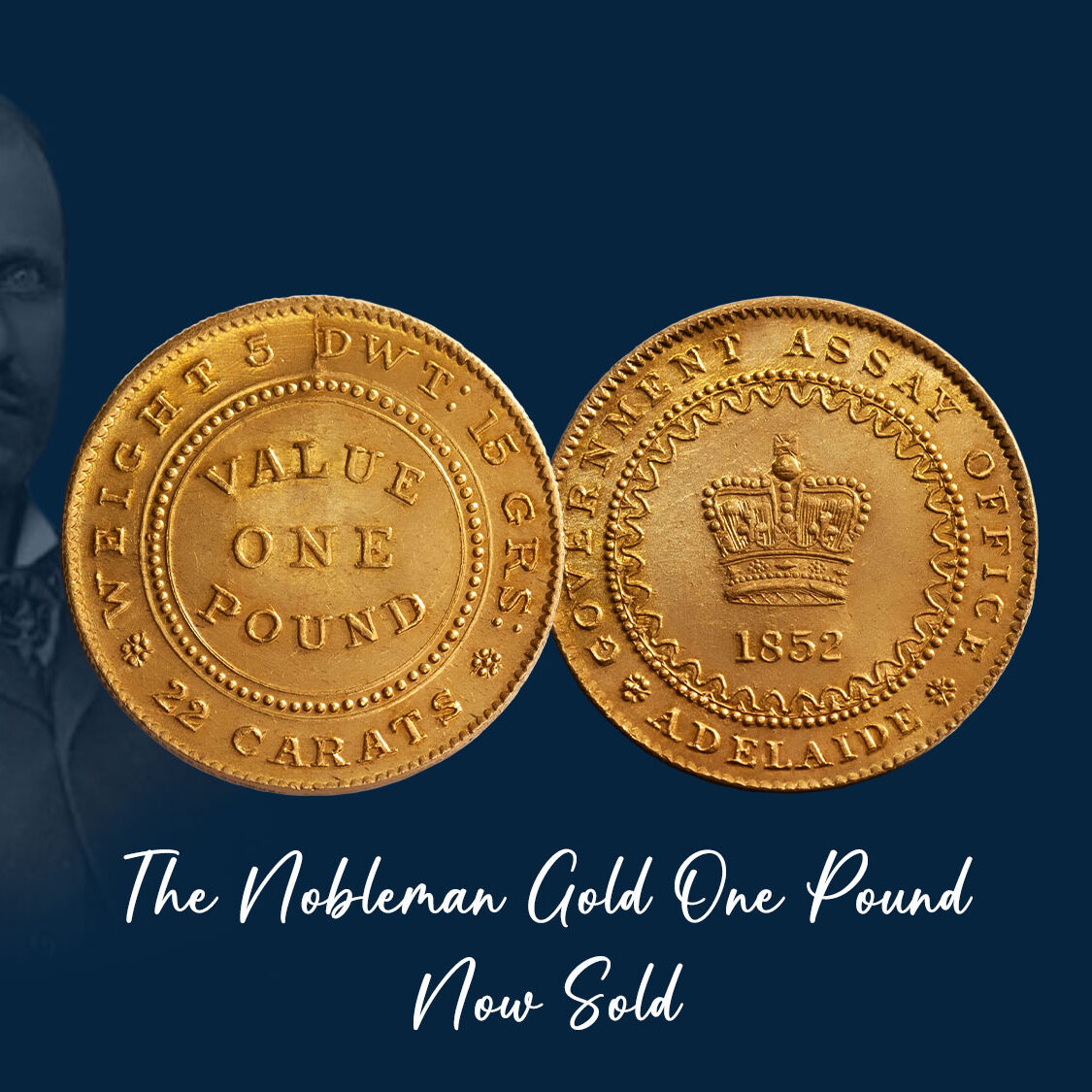
Australia’s Gold Rush of the 1850s had a major impact on Britain, stimulating trade and investment and changing the perception of Australia as a remote penal colony to a land of opportunity. The finest examples of the colony’s gold coins were pursued by Britain’s leading collectors, Montagu Hyman and John G. Murdoch. And Europe's Baron Philippe Ferrari La Renotiere whose collection was sold under the pseudonym, Nobleman. This 1852 Adelaide One Pound coin was struck in the first production run and is from the esteemed Nobleman Collection. On both counts, quality and strike, the Nobleman One Pound is genuinely exceptional and the very reason why it is universally ranked as number one. The coin has never circulated and is presented in a virtually mint state with much original bloom.
Click here for more details on this Product
When you look at a truly great circulation strike, such as the Nobleman One Pound, you can’t fail to be engaged by its state. The coin has presence and is imposing. The edges are strong. As a picture frame does to a canvass, a coin's edges enhance the visual impact by drawing the viewer's eye to the overall design. The edges also provide a sense of completion. A truly great circulation strike will also have super-fine detail and a three-dimensional design. Original mint bloom and proof-like fields.
On both counts, quality and strike, the Nobleman One Pound is genuinely exceptional and the very reason why it is universally ranked as number one. The Nobleman One Pound has never circulated and retains its mint-state condition with much original bloom.
The Nobleman One Pound is the finest example of the nation's first gold coin and was struck in the very first production run of Adelaide Pounds. And the strike, for a coin that was minted in the first run that history records was challenged with interruptions, is quite extraordinary.
The Nobleman One Pound features fine milling, the reverse crack .1mm wide. This tells us that the coin was produced not just in the first production run but it must have been struck in the first handful, for as the process continued, the crack became broader, up to .2mm in width.
The Nobleman One Pound is the coin for the buyer aspiring to the best. It will be a buyer that respects quality and recognises the importance of a documented provenance, today and into the future. A buyer that will enjoy the history of a coin that has been making headlines, both in Australia and in Britain since 1922.
No other Adelaide Pound can match this coin for its quality, its fame. And its level of public recognition.
How do you attempt to explain the brilliant state of the Nobleman One Pound? You simply can't. And that is the miracle of numismatics.
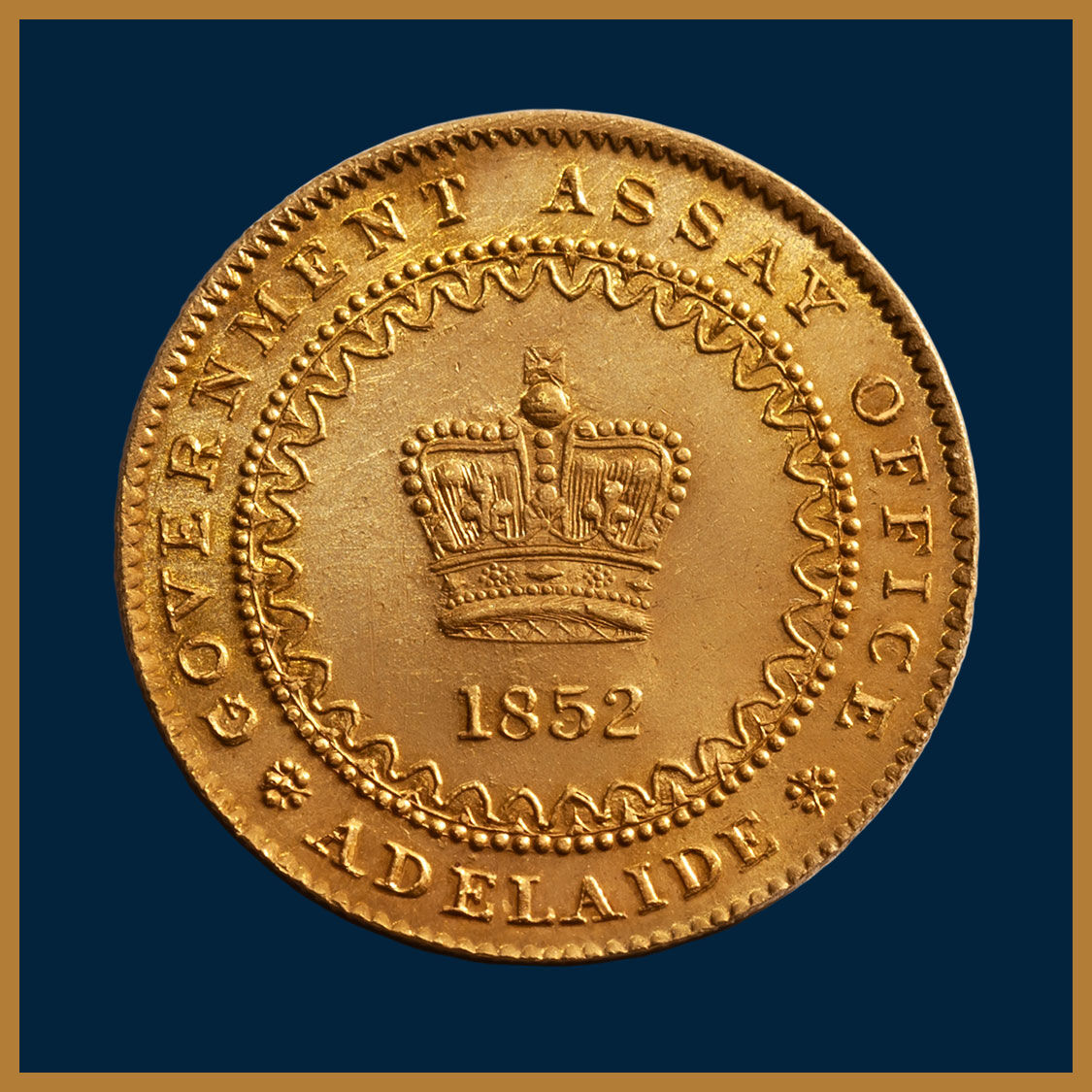
The Nobleman
Gold One Pound Type 1a
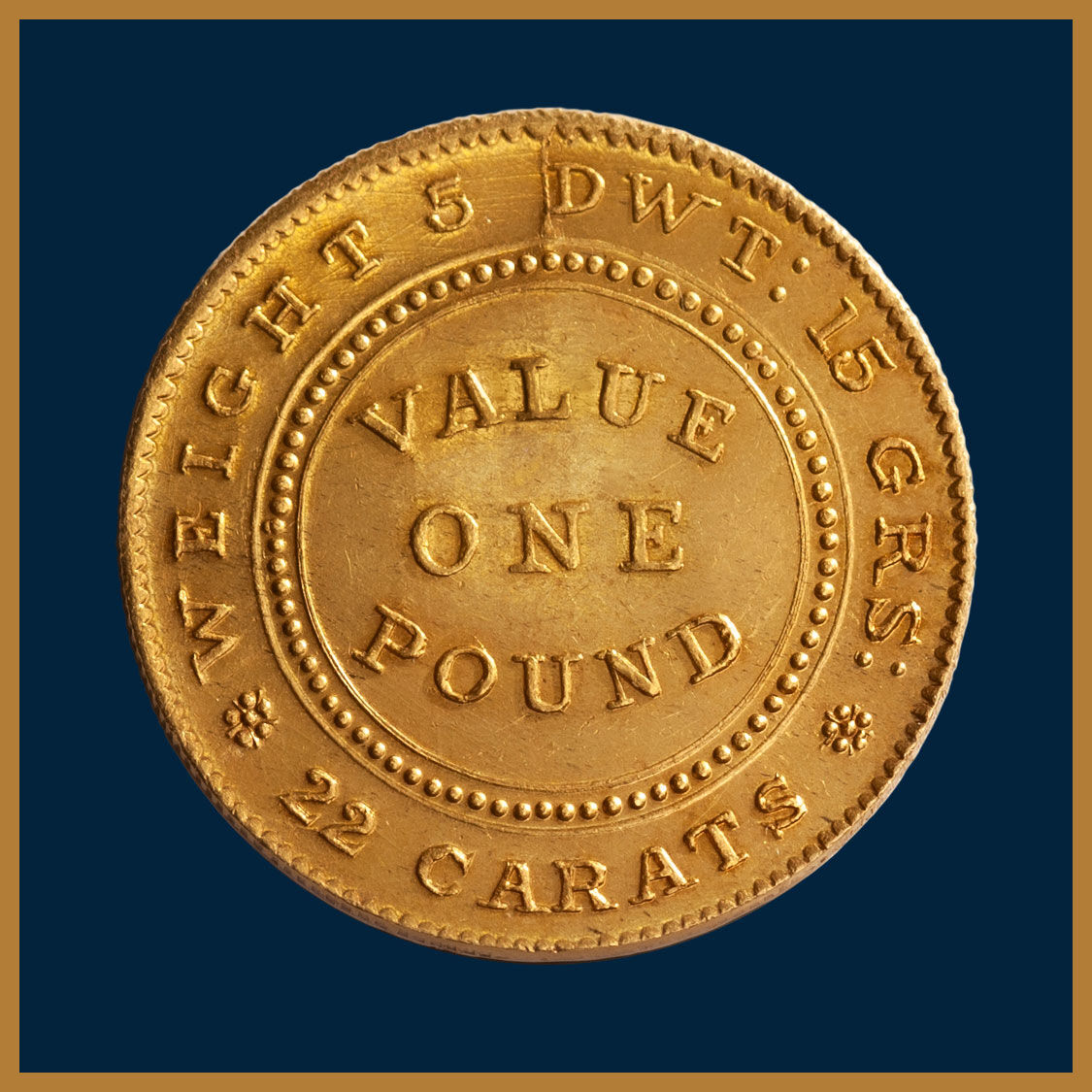
The Nobleman
Gold One Pound Type 1a
The colony of South Australia passed the Bullion Act in January 1852. The Act authorised the opening of a Government Assay Office in Adelaide to produce gold ingots that could be exchanged for banknotes at the rate of £3 11/- per ounce. Production of ingots began in February 1852.
Fielding numerous complaints about the ingots and their efficacy in solving the colony's financial crisis, the Act was amended in November of the same year to allow production of a gold coin, the Government Assay Office Adelaide One Pound. It was Australia's first gold coin.
The transition to producing a coin presented challenges for assaying staff that, while skilled in metal work, had minimal coining skills.
Finding the correct pressure balance on the dies to ensure that the design details and inscriptions were transferred accurately to both sides of the coin while at the same time producing strong edges was a major challenge that staff struggled to achieve. The milling also became an issue and was varied during the process, the belief that the fine milling may have contributed to some of their problems.
Excess pressure applied to the edges cracked the reverse die resulting in an interruption to production of the Adelaide Pound very early on in the process.
Less than fifty coins were believed struck before the crack was discovered, this coin one of them.
As the pressure was initially exerted on the edges, most Adelaide Pounds from the first run have strong edges. The downside of this pressure focus is that Adelaide Pounds from the first run show weakness in the crown.
The Nobleman One Pound has strength in the edges and a strength in the crown unseen in other examples.
Both fleur de lis are complete and three-dimensional, the pleats in the cloth are well formed. The horizontal line in the cross on the orb at the top of the crown is almost intact just tapering off on the right hand side. We also detect ermine flecks in the trim at the base of the crown. Flip the coin over and the lettering declaring its value in the central area of the design is consistently strong.
Exhibited National Museum of Australia 11 March to 24 June 2001.
Canberra's National Museum of Australia opened in 2001 as the centrepiece of the Centenary of Federation celebrations. The museum's first Exhibition, 'Gold and Civilisation', featured eight pieces from the Quartermaster Collection. The Nobleman One Pound was one of the eight and was photographed in the souvenir book.
Exhibited Museum of Victoria 19 July to 21 October 2001.
As part of the Centenary of Federation celebrations, the eight coins from the National Museum of Australia were displayed at the Museum of Victoria, Melbourne.
Exhibited Royal Australian Mint Canberra 22 February to 31 August 2005.
To celebrate the 150th anniversary of the Sydney Mint, the entire Quartermaster Collection was exhibited at the Royal Australian Mint Canberra, the Nobleman One Pound one of the highlights.
The above video of the Nobleman One Pound re-affirms its glorious, original mint state.
Collectors develop a deep connection with a coin by knowing the story behind it, when, how and why it was struck. And becoming familiar with its former owners, particularly if they are noted collectors.
When the coin is photographed in a major historical reference such as the Nobleman Catalogue the connection goes deeper. It is one thing to read about it. But seeing your coin, as featured in 1922, brings a multitude of feelings that only the true collector understands.
The Nobleman Collection was one of the ‘great’ coin holdings of its time and contained the two types of ingots, cast planchet and rolled planchet, the former eventually making its way to the Quartermaster collection via King Farouk of Egypt and USA's John J Pitman. The rolled planchet ingot was bought by the British Museum in 1922, where it still resides. The collection also included an 1852 Type Ia Adelaide Pound (this coin) and a Type II Adelaide Pound. And four Kangaroo Office Gold pieces, an 1853 One Ounce, believed to be the coin coming up in Zurich as part of the Traveller Collection, an 1853 One Quarter Ounce, a circa 1855 Gold Shilling (sold recently by Coinworks) and circa 1855 Gold Sixpence.
The historical significance of these eight pieces is reflected in their current market value of $4.25 million.
Ironically, the discovery of gold in the eastern states almost sent the colony of South Australia broke as the mass movement of population from the cities to the Victorian gold fields drained the banks of coins and brought business almost to a standstill.
As the two main pillars of national activity, labour and capital, literally walked out, prices plummeted, property plunged, mining scrip nosedived. Adelaide took on the air of a ghost town, with row after row of houses untenanted. Public works ceased, Government labourers retrenched to make them available to the private sector. So much coin was withdrawn from the banks by citizens heading for the fields that the colony's financial institutions faced closure, having insufficient coinage to meet their legally binding gold reserves that backed their banknote issues.
And whilst it may be perceived that the economy would bounce back when the diggers returned to their home state with their findings, it only exacerbated the problem. The gold boom created an excess of wealth, one that could not be put into circulation. The problem, which had plagued each colony since the early days of settlement still existed: a lack of hard currency to stimulate and underpin commerce.
The Governor of South Australia devised a two-part solution to the crisis. The first part was to ensure a ready supply of gold. Whereas the diggers were receiving 60/- per ounce in Melbourne, the South Australian Government guaranteed to pay an over-the-top price of 71/- per ounce. And went a step further by providing armed escorts to bring back the gold from the Victorian diggings.
The second part of the solution was the establishment of an Assay Office to convert gold into a useful form, the Legislative Council seeking to deflect Royal disapproval by striking gold ingots rather than sovereigns.
The ingots were not declared legal tender but were intended to form a 'currency' that would back the banknote issues of the banks as if they were gold coin at the rate of £3 11s per ounce. And be used by the banks to increase their note circulation based on the amount of assayed gold deposited.
It was a daring and contentious move. Under the Currency Act the colonies were prevented from being involved in anything affecting their currency "unless urgent necessity exists". The South Australia Government used the 'urgency' loophole in the Currency Act and passed legislation, 'The Bullion Act of 1852', that legitimised the striking of ingots and their backing of banknote issues.
It drew condemnation from the eastern states. Melbourne’s Argus condemned the Act as dangerous, radically unsound and interfering with the natural laws of commerce. But these protests were motivated by self-interest, as South Australia posed a real threat to the Victorian economy by re-directing capital and labour away from the Victorian gold fields.
The Bullion Act No 1 of 1852 has a record unique in Australian history. A special session of Parliament was convened to consider it. Parliament met at noon on the 28 January 1852. The Bill was read and promptly passed three readings and was then forwarded to the Lieutenant Governor and immediately received his assent. It was one of the quickest pieces of legislation on record, with the whole proceedings taking less than two hours.
Thirteen days after the passing of the Act, on 10 February 1852, the Government Assay office was opened. The first ingots appeared on 4 March 1852 and by the end of August 1852, over £1 million worth of gold had been received at the assay office.
The Act had its critics.
Read more
The ingots were said to be easily counterfeited. And their was no uniformity or consistency in their shape and size. The Act also compelled the banks to increase their note circulation to meet all assayed gold deposited, effectively depriving them of control over their currency issues. Three banks operated in Adelaide at the time, the South Australia Banking Company, the Union Bank of Australia and the Bank of Australasia, the latter refusing to issue notes in exchange for ingots placing a huge burden on the other two banks.
In July 1852, the business community began pressing the Government for an issue of gold coins of uniform standard and of a size and character that could be readily used as a circulating medium.
By November of the same year the Bullion Act was amended and the striking of ingots repealed. Instead the Government Assayer was instructed to strike gold pieces of 10/-, £1, £2 and £5 values.
The legislation was assented on the 23 November 1852.
Local jeweler and engraver Joshua Payne created the dies for the £1 coins, the obverse with the issuing authority, Government Assay Office Adelaide encircling a crown and the date. The reverse declared the fineness and weight encircling it's pound value.
Joshua Payne confirmed in an interview that he had created two different styles for the reverse, one with a beaded inner circle with a stylish font. The other using a scalloped inner border and a plain font. As it turns out, both dies were called upon.
The transition to producing a coin presented challenges for assaying staff that, while skilled in metal work and making ingots, had minimal coining skills.
Finding the correct pressure balance on the dies to ensure that the design details and inscriptions were transferred accurately to both sides of the coin while at the same time producing strong edges was a major challenge that staff struggled to achieve.
Excess pressure applied to the edges cracked the reverse die resulting in an interruption to production of the Adelaide Pound very early on in the process. Less than fifty coins were believed struck.
The impaired die was replaced with the second reverse die that had a different design, a scalloped inner border. A total of 24,648 coins were produced from both runs.
Only a small number of Adelaide Pounds were ever struck and very few actually circulated, the official and recorded mintage of the nation’s first gold coin, 24,648. Assaying of the one pound samples sent to London determined that the intrinsic value of the gold contained in each piece exceeded its nominal value, the vast majority were promptly exported to London and melted down.
By producing two different dies Joshua Payne clearly distinguished between those coins struck in the modest first run (referred to as Type I Adelaide Pounds). And those from the more substantial second run (referred to as Type II Adelaide Pounds).
What we know today is that less than forty Gold One Pounds from the first run are in collector’s hands. And perhaps six times that figure of the examples from the second production run. Both rare. But the first run One Pound excruciatingly rare.
The Bullion Act was intended only as a short-term solution, its operation limited to twelve months, expiring in January 1853. No attempt was made to extend it or continue the coinage after the period originally fixed.
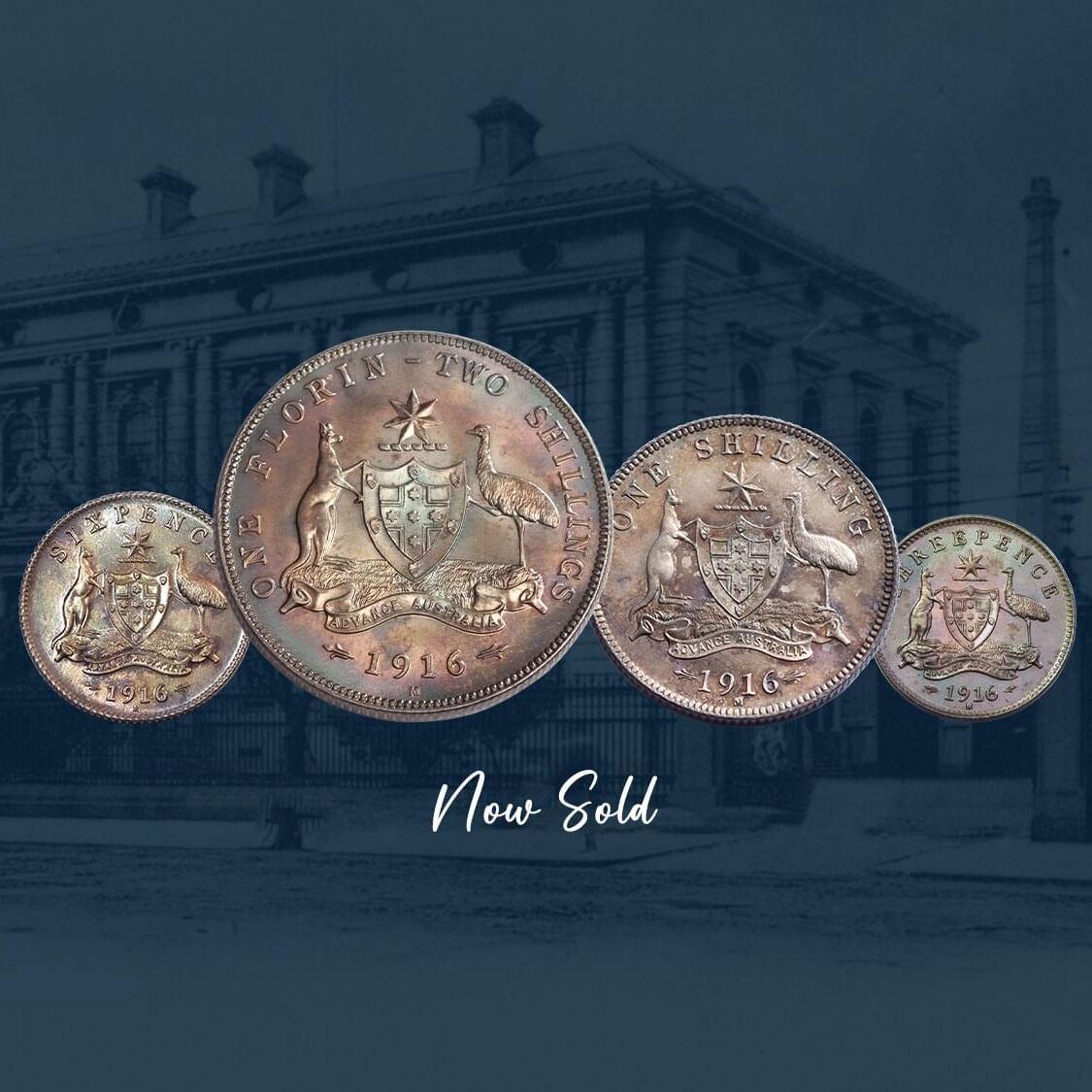

The Melbourne Mint's 1916 Presentation Set is a cultural treasure, respected as the very first issue of Australian coins made especially for collectors. Four coins make up the set, the florin, shilling, sixpence and threepence struck to specimen quality, housed in an especially crafted velvet-lined blue case. It was a big deal at the time, a celebration of the Melbourne Mint’s inaugural striking of Australia’s Commonwealth silver coinage. And it’s a big deal today with only seven original cased sets sighted at auction over the last half century. The set’s importance has been the subject of many articles, one of which penned by Dr Vince Verheyen, is provided below. Testimony to the calibre of this particular set, it was selected as the front-cover item of Monetarium Singapore's inaugural auction in 2008. An inaugural set for an inaugural auction, a masterstroke touch! And this history-making 1916 cased Specimen Set is available now.
Click here for more details on this Product
Two dates are integral to the Melbourne Mint's history and the nation’s numismatic heritage. The first is its year of opening, '1872'.
The second is '1916', when the Melbourne Mint expanded its gold coining repertoire and commenced striking silver coins for the newly formed Commonwealth of Australia.
The mint did not produce any presentation pieces to celebrate its opening in 1872, a missed opportunity for today's collectors.
That numismatic shortcoming was addressed in 1916 when the Deputy Master of the Melbourne Mint authorised the production of sixty cased Presentation Sets, a portion earmarked to sell to collectors with a 2/-3d premium over face value. Others were gifted to dignitaries.
Natural attrition has taken its toll on the original mintage and only seven cased presentation sets have been observed at auction over the last half-century.
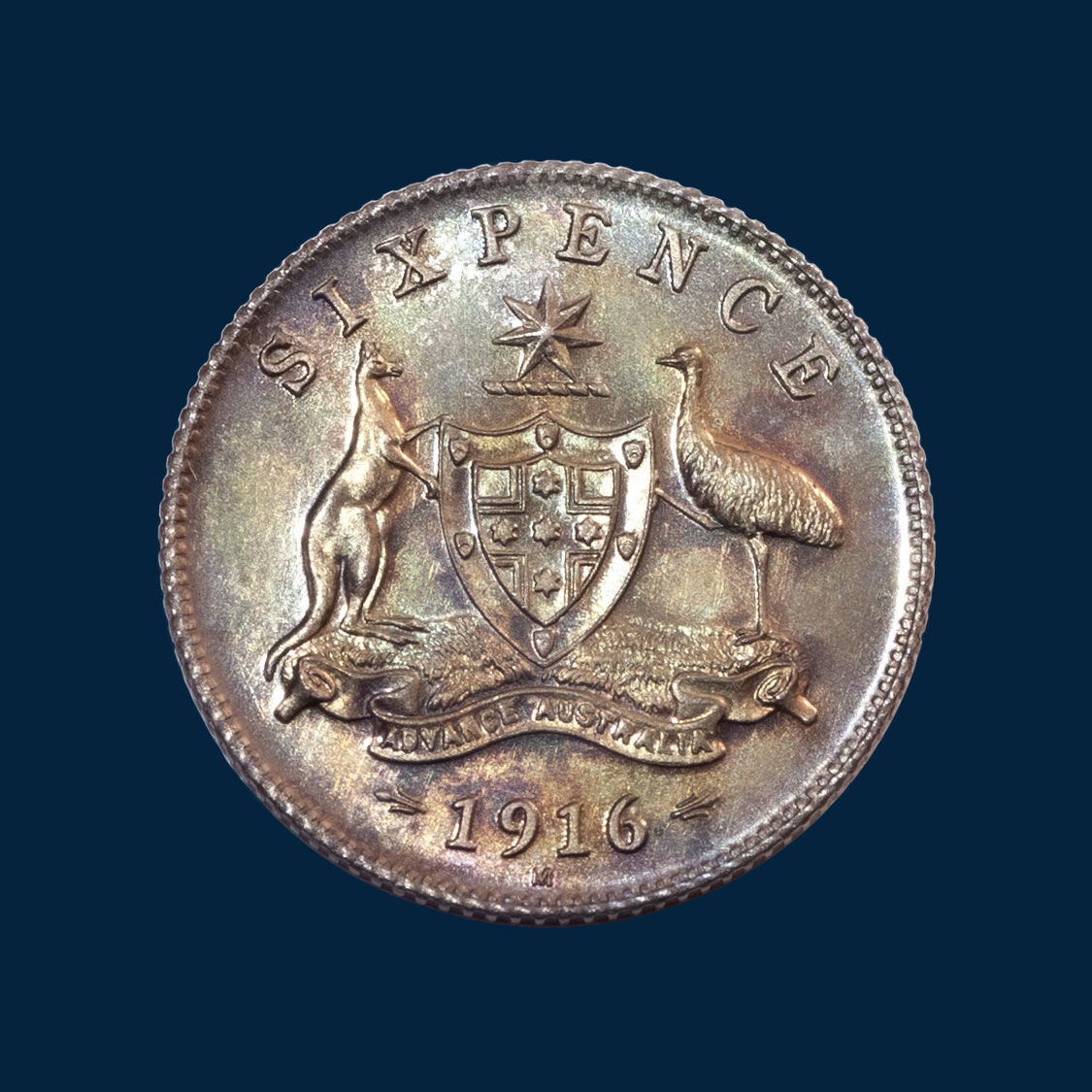
1916 Specimen Sixpence
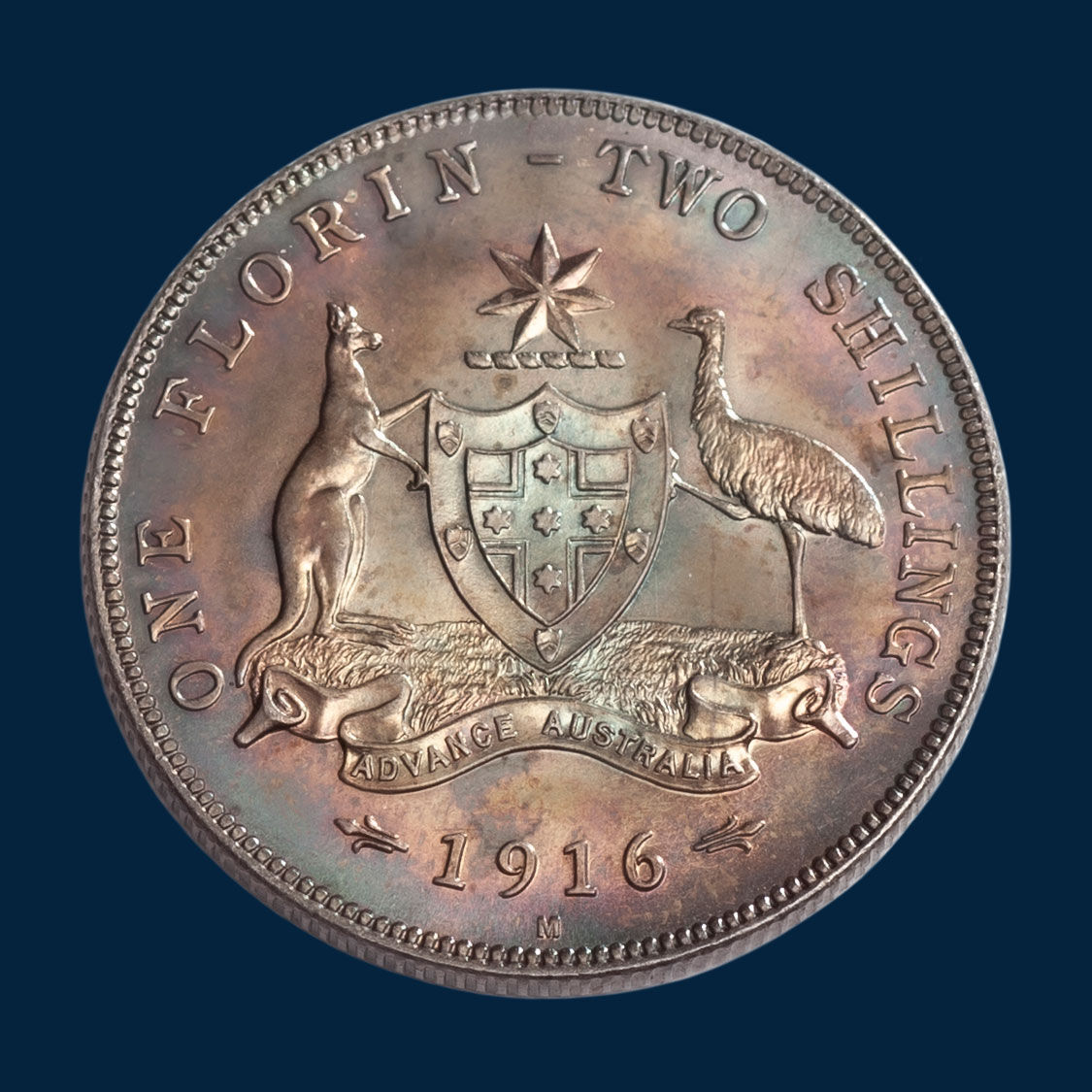
1916 Specimen Florin

1916 Specimen Shilling
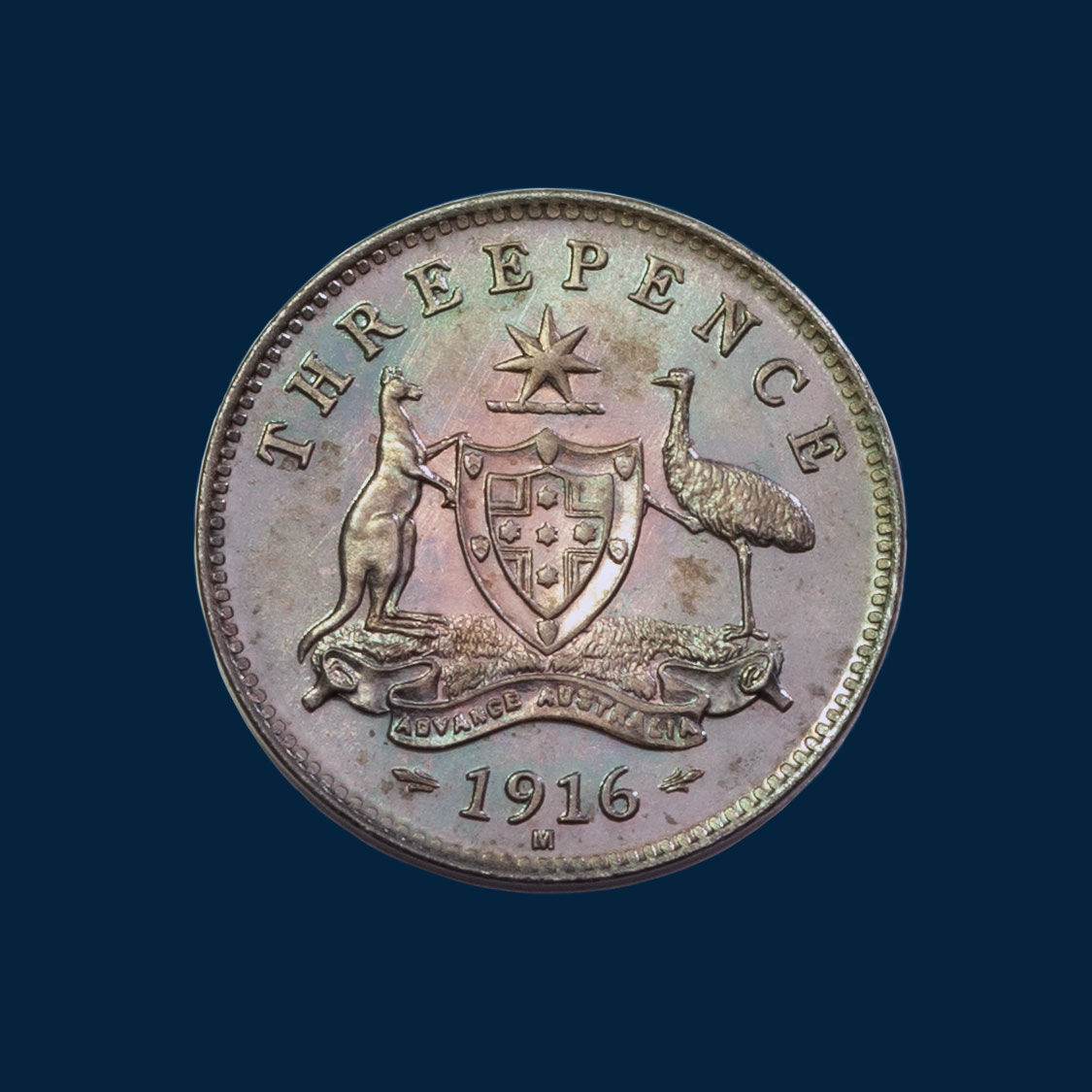
1916 Specimen Threepence
The Melbourne Mint’s iconic 1916 cased specimen set stands out as the first Australian made presentation for collectors of the Commonwealth's coinage. There are a few things to note about the 1916 cased specimen set.
First up the royal-blue case. The case is a stamp of authority indicating that the coins are presented today as they were originally intended more than a century ago. The integrity of the set is maintained by the case. Respected numismatist and author, Dr Vince Verheyen's take on the royal-blue case supports our view that it is an integral element of the presentation. “It cannot be over-emphasised that the set must be supplied with its original case.”
The second is that the coins tone. The toning to all the coins, again gives authenticity to the set. And given the different mirror and matte finishes of the four coins, collectors should not expect the toning to be identical, a point again emphasised by Verheyen. He also added ... "I would be suspicious of any bright white specimens given their age.”
The third point to note is storage for over the years we have been asked if the coins should be stored in the case? The coins will be housed in archival quality (museum quality) coin holders and presented in a quality velvet lined tray, thereby preserving their investment value. The royal blue velvet case will be separate to the tray.
Each coin in this 1916 Presentation Set was assessed by Coinworks, and Dr Vince Verheyen as part of his research into the article on the 1916 cased Specimen Set. (See below)
We note the similarities in toning between this set and that held in the Melbourne Mint Museum.
Coin Descriptions
1916 Specimen Florin -
A stunning coin with superb colours. The obverse a gold / green. The reverse with blue on the periphery and purple on the interior. The florin is superbly struck and has fabulous detail in all the design elements with a lovely smooth matte surface on both obverse and reverse. A highly reflective coin in the light. Striations are noted on the reverse.
1916 Specimen Shilling
That so much can be written on a one shilling coin reflects the meticulous nature of the strike and the beautiful aging process that it has enjoyed. This coin is intriguing in the light. It is superbly struck with mirror surfaces between 4 o'clock and 8 o'clock in the shield area and below 'Advance Australia'. (This phenomenen was noted by Vince Verheyen in his study of the 1916 Specimen Sets.) The reverse reveals multiple striations (raised parallel lines) across the fields; with those between the scroll and date and behind the emu strongly evident. Precise edge denticles, a high rim and beautiful antique toning on both obverse and reverse characterises this shilling.
1916 Specimen Sixpence
While the florin in a 1916 Set receives most of the accolades (because of its size), the sixpence in this set almost steals the show. It is glorious. Proof-like with beautifully mirrored fields. Very well struck, the denticles on the reverse rim are unusually strong. And magnificent colours. Heavy striations on both obverse and reverse are noted. Beautifully mirrored fields on the obverse with microscopic striations confirming careful preparation of the dies.
1916 Specimen Threepence
A full brilliant mirror finish with handsome blue and pink toning. The coin is extremely well struck, noticeable in the strength of strike in the star, shield and scroll. Strong striations confirm careful preparation of the dies at the Melbourne Mint.
Early in November 1915 the Melbourne Mint was formally instructed to commence preparations for the striking of the Commonwealth's silver coinage. The silver was sourced locally from the Broken Hill mines.
It is noted that prior to 1915, the nation's silver coinage had been minted overseas at the Royal Mint London and the Heaton Mint in Birmingham.
Towards the end of November 1915, dies for the set of four denominations were sent from London.
Six weeks after the dies were shipped, the Governor of Victoria Sir Arthur Stanley K.C.M.G, struck the first circulating 1916 shilling. It was logical that the Melbourne Mint would begin striking silver coinage with the shilling denomination given its similar physical size to their familiar sovereign.
The florin was struck almost immediately after, sixpences by the middle of 1916 with the threepences finally later in the year. More than 11.5 million silver coins were released into circulation that year.
The Melbourne Mint's inaugural striking of Australia's Commonwealth coins was a momentous occasion in minting circles. The Deputy Master of the Melbourne Mint therefore decided to create a Presentation Set to record the occasion.
Each presentation set was comprised of the four silver coins of florin, shilling, sixpence and threepence, each featuring the Melbourne mint mark ‘M’ below the date 1916 and minted to specimen quality.
The set of four was housed in a handsome, velvet-lined royal blue case that had been locally sourced.
The availability of the four-coin specimen presentation set was confirmed in November 1916 when Le Souëf recorded an entry of sixty specimen sets in the Mint Museums’ cash accounts with a face value of £11 5/-.
While records show that 60 sets were produced, sixteen were sold, collectors charged 6/- for a cased set.
A further 25 sets out of the original mintage were presented to dignitaries and politicians with the precise fate of the remaining sets unknown.
What we do know is that many of the cases have been lost and many of the sets have been broken up and sold as individual coins.
We also know that others were accidentally used as circulating coins, their value irreparably reduced through wear.
Over the past 50 years we have sighted only seven sets housed in their original case of issue.
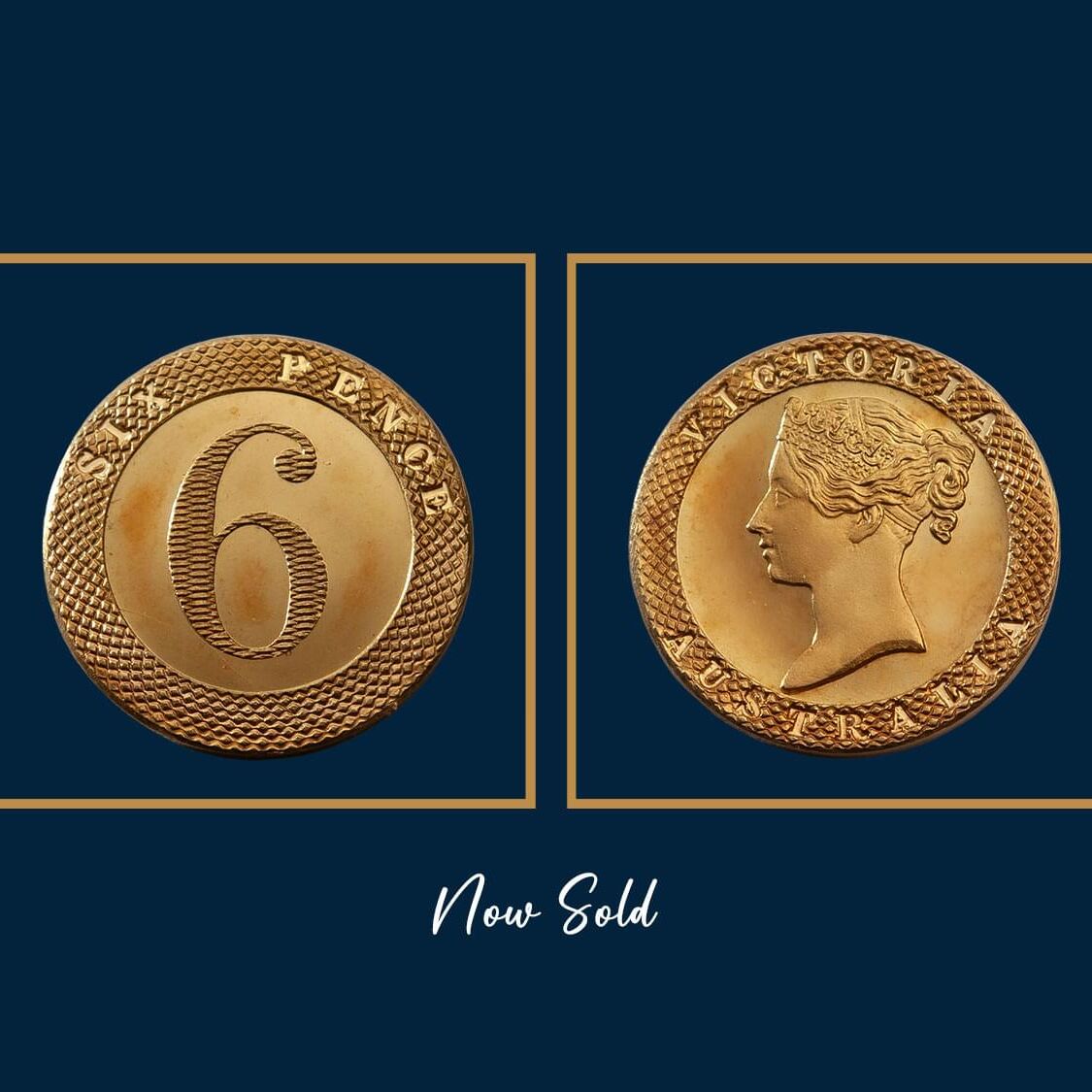
Leafing through the early John G. Murdoch Sotheby's catalogue of 1904 and those of Spink Auctions 1978, 1981 and 1989 and more recently the Quartermaster catalogue of 2009, you are in no doubt of the enormous historical and numismatic significance that the Kangaroo Office gold pieces carry. The coins are today as influential and as charismatic as they were more than a century ago. The five gold Kangaroo Office pieces offered at the Quartermaster Auction (of which this coin was one) came with an estimated low value totalling $1.125 million. And an estimated high value of $1.32 million. Only two of the five pieces sold above their 'high' estimate, the gold shilling (sold by Coinworks last week). And this coin, the gold sixpence, ex Murdoch Collection 1904. This is a pivotal moment for just one buyer. It’s a weighty decision to knock back a gold Kangaroo Office piece. Chances are you won’t be offered another one for at least a decade, maybe even two.
Click here for more details on this Product
Technical details Kangaroo Office Gold Sixpence
Reverse: A broad engine-turned rim encircles a large figure ‘6’ in the centre decoratively engraved and the words SIX PENCE incused in the rim.
Obverse: A broad raised engine-turned rim encircles a superb portrait of Queen Victoria wearing a jewelled crown, thought to be executed by William Taylor in 1860, and the words VICTORIA and AUSTRALIA incused in the rim.
(An engine-turned rim refers to a decorative pattern created by a machine-operated process whereby fine, closely spaced, criss-crossing lines are engraved into a surface. The result is a visually appealing, textured surface that adds a touch of elegance and sophistication.)
Diameter: 18.57 mm
Weight: 4.00 grams
Planchet: Thin
Edges: Plain
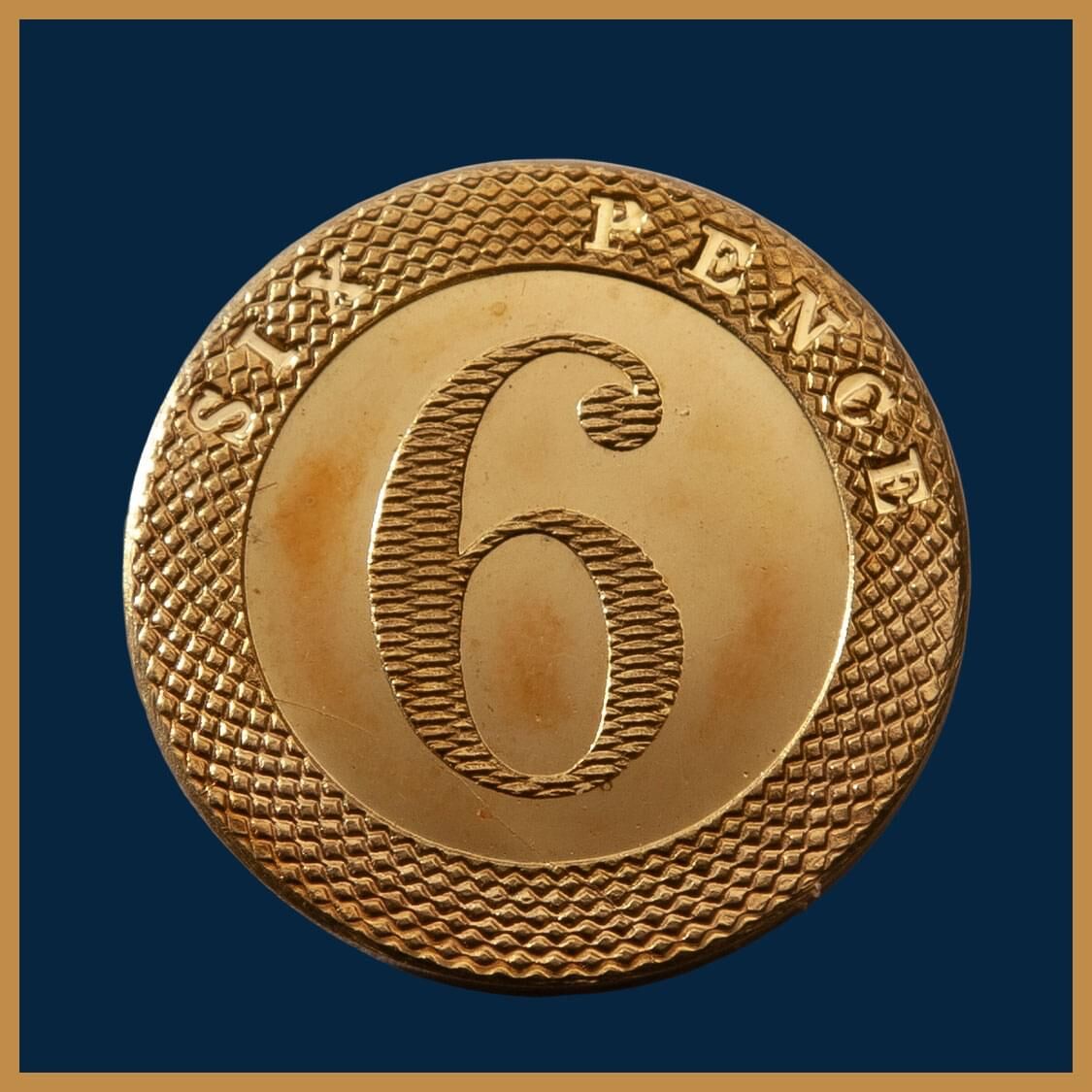
Circa 1860 Kangaroo Office Gold Sixpence
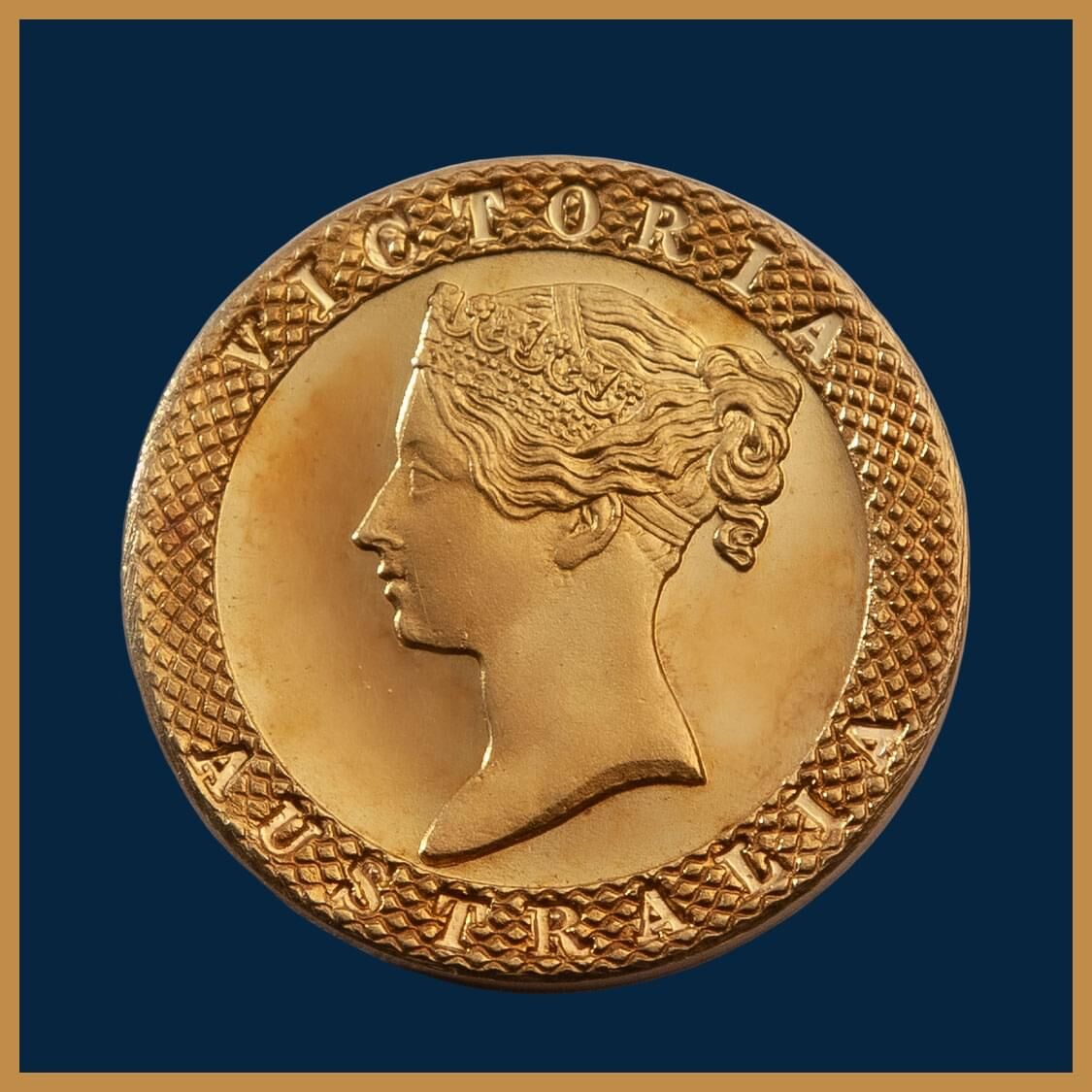
Circa 1860 Kangaroo Office Gold Sixpence
The offering in Zurich of an 1853 Gold Kangaroo Office 1oz piece from the famous 'Traveller Collection' is receiving global attention. And the attention is as much about the coin as it is about the pre-sale estimate of $475,000 AUD. (We believe it is the only known example held in private hands.)
Our offering of the Gold Kangaroo Office Shilling early in July also received local and international enquiries and is now sold, to a Victorian collector.
The Gold Kangaroo Office coins are iconic and attract strong buyer interest across the globe.
And it has been that way for more than a century. We also note the coins have always been associated with great collectors.
The Gold Kangaroo Office coins were first recorded at auction in 1892 in the sale of the Hyman Montagu Collection held by Sothebys London. And sighted again in 1904 in the sale of the John G Murdoch Collection.
More recently in Australia in 1989 at Spink Auctions and in 2009 at the now famous Quartermaster Auction. (The sporadic offerings confirm their overwhelming scarcity.)

Circa 1860 Kangaroo Office Gold Sixpence

Circa 1860 Kangaroo Office Gold Sixpence
Soon after the opening of the Adelaide Assay Office in 1852, and the striking of the Adelaide Pound - the nation's first gold coin - there was an attempt to establish a private mint in Melbourne. The mint was called the Kangaroo Office. Its prime goal was to buy gold at cheap prices direct from the fields and convert the precious metal into 'coins' of a fixed weight that would be released at their full value in London.
The plan was devised by English entrepreneur, William Joseph Taylor. By trade Taylor was an engraver and die sinker, active in the numismatic industry producing both coins and medals. He formed a syndicate to finance the operations with two colleagues, Hodgkin and Tyndall. The total investment was £13,000.
Taylor's mint was only one component of a broader-reaching enterprise that was based in London. The overall plan was to profit from all aspects of the Gold Rush and included a clipper ship - called the Kangaroo - that would bring migrants and goods from England to Melbourne and return with gold in its specially outfitted strongroom.
The Kangaroo sailed from London on 26 June 1853. On board, the pre-fabricated structure to house the mint and the shop. And the coining press, dies and two employees, Reginald Scaife, the Manager, and William Morgan Brown, his assistant. The ship arrived at Hobsons Bay, Melbourne on 26 October 1853.
The Kangaroo Office got off to a bad start as there were no facilities at the wharf for off-loading heavy equipment, such as the coining press. With no other option available, the press was dismantled, moved and reassembled, a process that took six months.
The Kangaroo Office eventually commenced operations in May 1854, striking gold coins. To thwart currency laws, the designs were made to look more like weights than coins. Taylor himself cut the dies for a 2oz, 1oz, 1/2oz and ¼oz gold piece, each dated 1853.
The coins were exhibited at the Melbourne Exhibition of 1854 (17 October - 12 December) and were written up in the Argus Newspaper as "several tokens of pure Australian gold were exhibited by Mr. Khull, bullion broker. They were manufactured by Mr. Scaiffe and are to be exhibited at our Palace of Industry."(Sadly a price was never quoted.)
Apart from the logistical difficulties of setting up business, the financial viability of the Kangaroo Office came under an immediate cloud. By mid-1854 when the mint became operational the price of gold had moved up to £4/4/- an ounce, vastly different to the £2/15/- per ounce when the plan was hatched. And there was a glut of English sovereigns in circulation.
By the middle of 1854, Reginald Scaiffe, the Kangaroo Office Manager, had an overwhelming sense of failure for the shop had taken less than £1 in trading, he had a ten-year lease, could not find cheap labour. Nor cheap gold. And basically had no customers.
Despite the financial challenges of the operation Taylor was unconvinced that his days as a coin designer and manufacturer were at an end. In 1855 he produced dies for the striking of a sixpence and shilling in gold, silver and copper. This was his first attempt at producing a piece depicting a value rather than a weight.
The coins were struck with a milled and plain edge, the former believed minted circa 1855, the latter circa 1860.
The sixpence and shilling featured the same broad engine-turned rim as the earlier minted gold coins. The obverse however featured a superb portrait of Queen Victoria with VICTORIA and AUSTRALIA embedded in the rim. The reverse featured the denomination in figures at the centre and in letters embedded in the rim above.
Taylor operated his Kangaroo Office for three years during which time he sustained substantial losses. With all hope of a profit gone, the dispirited promoters in London issued instructions for the Kangaroo Office to be closed.
Now while it is true that Taylor never achieved his ambitions, the Kangaroo Office coins are revered by collectors right across the globe.
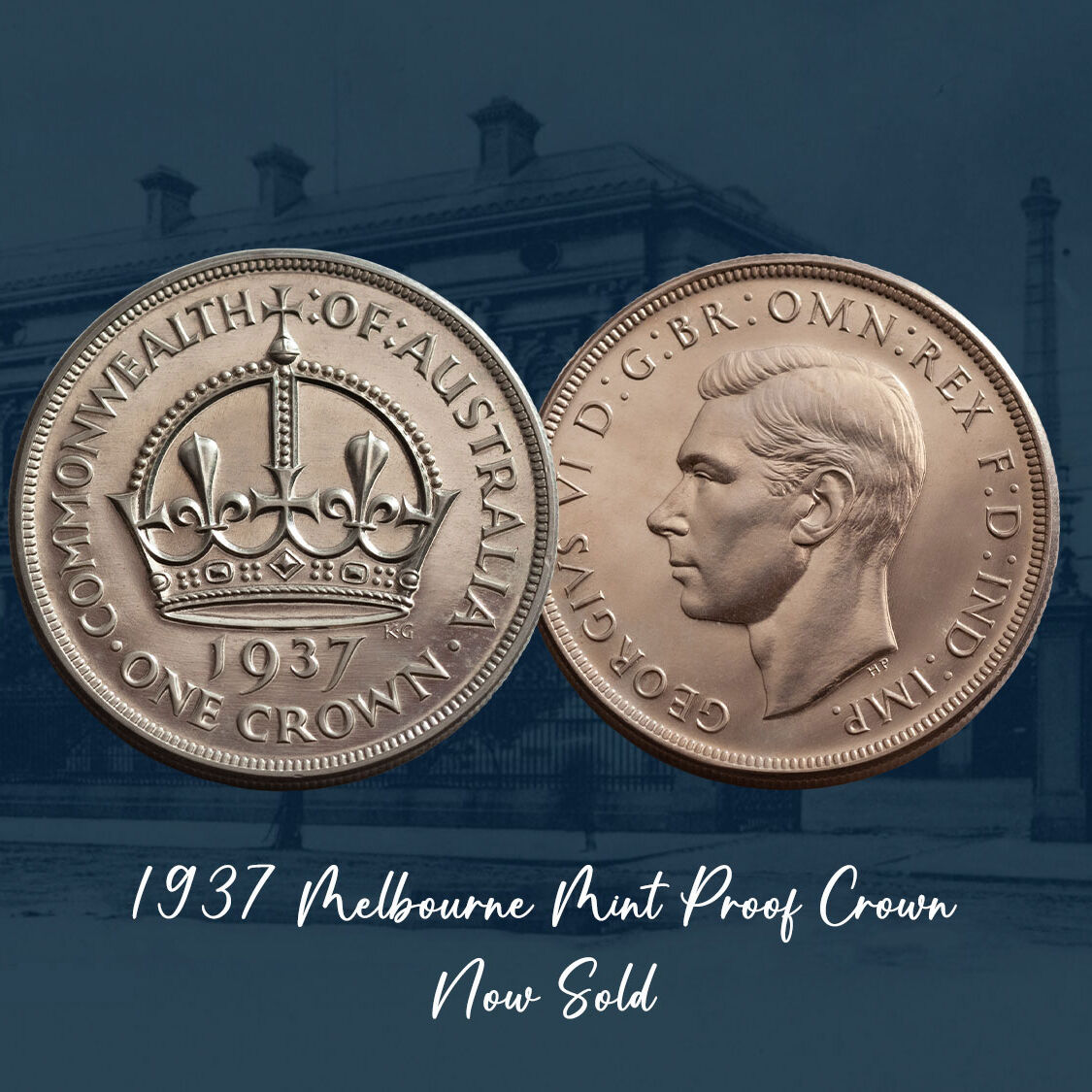
Australians were eager to welcome in a new currency when Edward VIII became king in 1936. The threepence, shilling and florin were up for major design revisions, as was the penny. The changes were put on the back burner when Edward VIII abdicated the British throne. In 1937, to create a distraction from the Royal scandal, the Australian Government authorised the striking of its first crowned sized coin. The five shillings was struck in sterling silver and weighed 28.27 grams with a diameter of 38.5 mm. A trickle over 1 million crowns were released into circulation. One hundred 1937 Proof Crowns were especially struck to sell to the public. While the circulating crown is readily available, the 1937 Proof Crown, with its tight mintage, is extremely difficult to acquire, confirmed by the frequency of our offerings. Its been more than twelve months since we last offered a proof crown.
Click here for more details on this Product
The Melbourne Mint was Australia’s second coining facility and opened in 1872 to strike gold sovereigns. The mint did not produce any presentation pieces to celebrate its opening in 1872, a missed opportunity for today's collectors.
In 1916 the Melbourne Mint welcomed in a new era and commenced striking silver coins for the newly formed Commonwealth of Australia. The numismatic shortcoming of not issuing specially struck celebratory issues in the year of its opening was addressed in 1916.
The Deputy Master of the Melbourne Mint authorised the production of sixty cased Presentation Sets, each set comprised of four 1916 dated silver coins, the florin, shilling, sixpence and threepence struck to a specimen finish.
The 1916 Sets were the very first 'commercial' issue to come out of an Australian Mint. A portion was earmarked to sell to collectors with a 2/-3d premium over face value. Others were gifted to dignitaries.
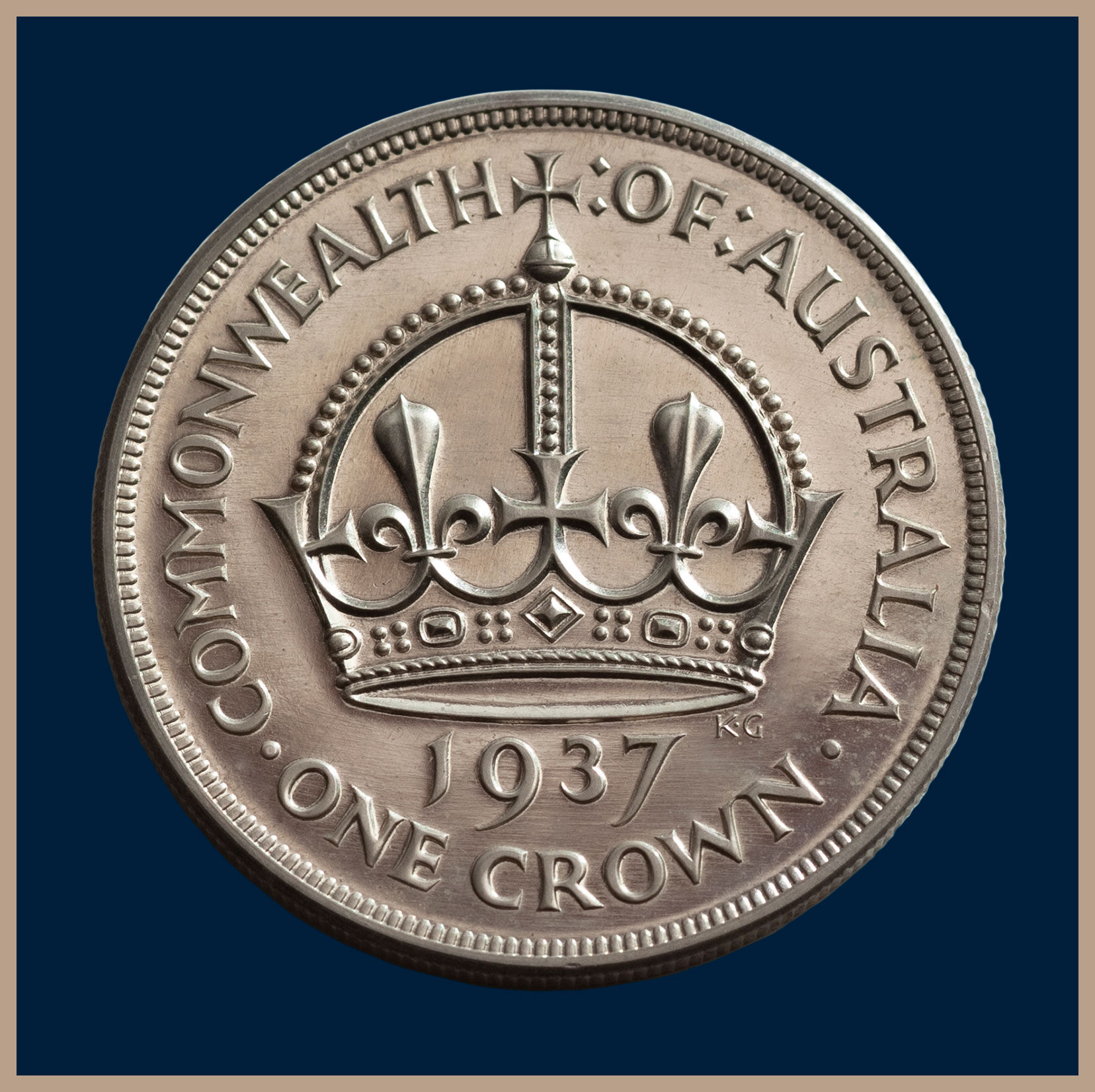
1937 Proof Crown
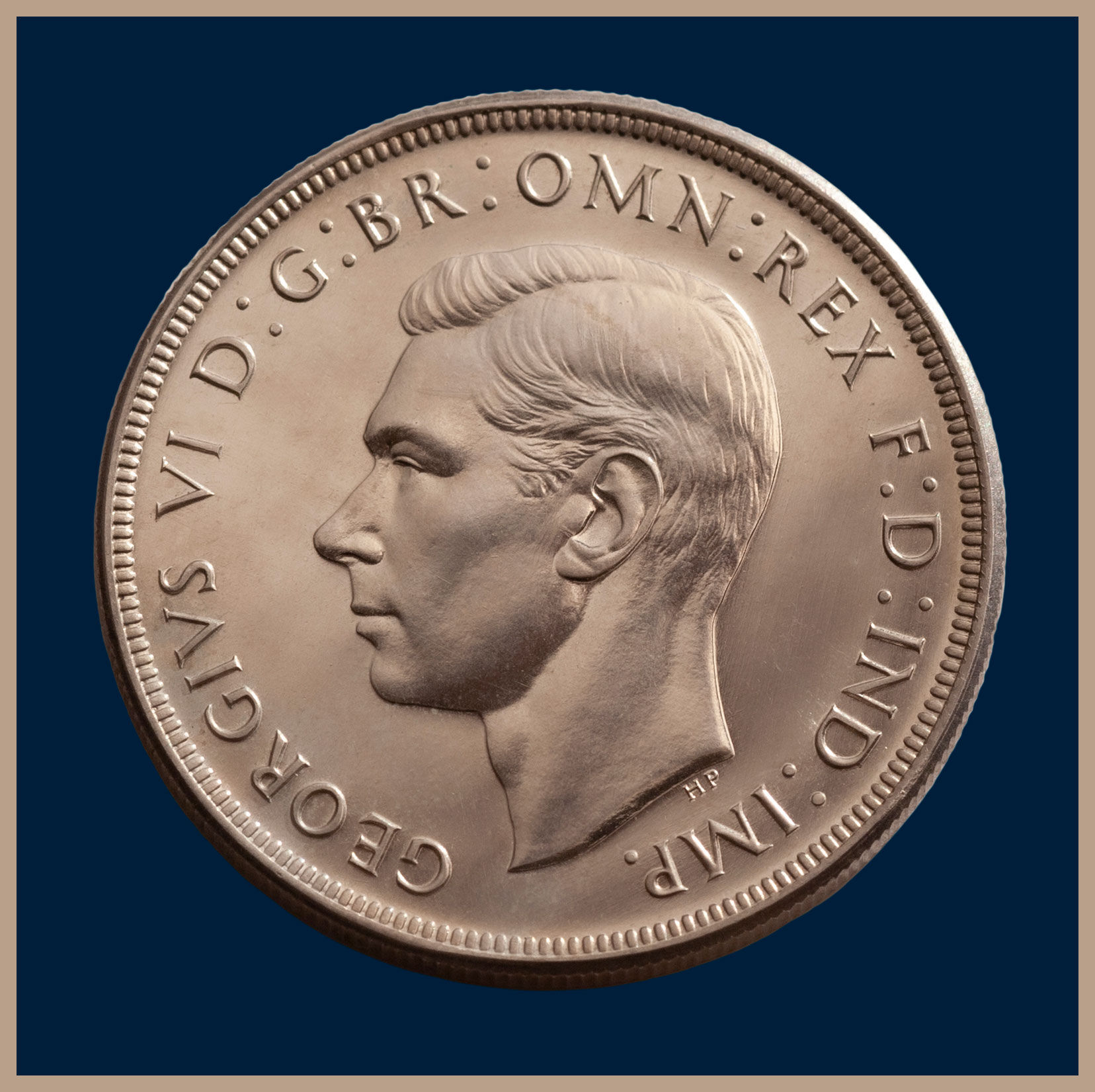
1937 Proof Crown
The Melbourne Mint continued to strike proof issues until it ceased minting operations in 1964. But the issues were struck sporadically, in only the years 1927, 1934, 1935, 1937, 1938, 1939 and 1953.
Two of the issues (1934 and 1935) were the result of a collaboration between the Melbourne Mint and the private sector: the mint tentative at striking proofs on a commercial basis.
The Melbourne Mint's issues, especially struck for collectors, are extremely scarce and they are celebrated as critical points in Australia's numismatic history.
The chart below indicates the collector issues that were struck between 1916 and 1953 and the mintage. The mintage figures have been determined from the mint's historical records including letters and sales ledgers and are shown in brackets.
• 1916 Specimen Set ( 60 )
• 1927 Proof Canberra Florin ( 400 )
• 1934 Proof Set ( 50 )
• 1935 Proof Pair ( 125 )
• 1937 Proof Crown ( 100 )
• 1938 Proof Set ( 68 )
• 1938 Proof Crown ( 52 )
• 1939 Proof Halfpenny ( 40 )
• 1953 Specimen Set ( 12 )
Richard Gavin Gardiner Casey was elected to federal parliament for the United Australia Party in 1931 and served as treasurer from 1935 to 1939. The notion of a crown sized coin was pushed by Casey and was - and still is - referred to as ‘Casey’s Cartwheel’.
As a collectible, the Proof 1937 Crown was an instant success, the mintage of one hundred a complete sell-out. Whereas the coin's bulk was a hindrance when it was used as currency, the size worked to the mint's advantage in the creation of a proof coin, the majestic design offset by an expanse of brilliant silver mirror fields.
The crown design on the reverse, designed by George Kruger Gray, is imposing offset by brilliant fields. The obverse has a beautiful expanse of fields to offset the portrait of George VI.
Natural attrition has taken it toll on the original mintage of Proof 1937 Crowns with coins being mishandled or pieces simply lost into circulation. We would be lucky to sight one quality example on the market annually.
This coin is a superb example from the original mintage of one hundred. We note heavy striations in the fields, reflecting careful die preparation.
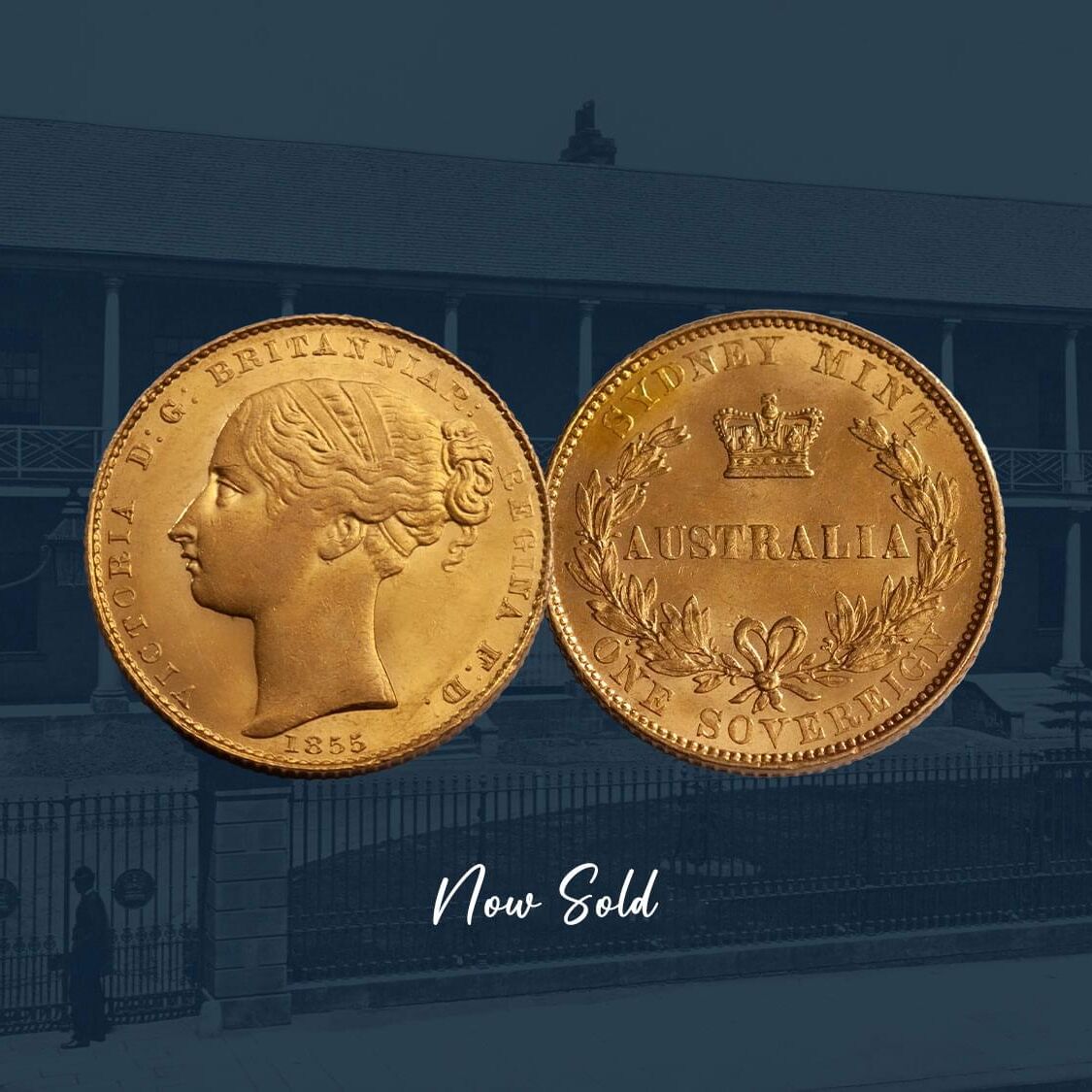
Australia issued sovereigns between 1855 and 1931 and while the appeal of the sovereign is enhanced by different versions featuring the effigies of various monarchs, no coin is as popular as the first Australian sovereign, the 1855 Sydney Mint Sovereign. And this example is a prize. A superior quality coin offered in Nearly Uncirculated / Uncirculated. Two things stand out when you look at the coin in your hand. The fields are smooth and lustrous. The reflective nature of the obverse is spectacular. And the detail on both obverse and reverse is super fine. Under the eye glass the coin continues to shine for the reverse is sharp, the cross on the orb at the top of the crown is complete, the fleur de lis on left and right are precise as are the pleats in the cloth. And so is ‘AUSTRALIA’ below the crown. And there is just a whisper touch to the hairline at the top of Victoria’s forehead.
Click here for more details on this Product
When it comes to collecting vintage gold coins, collectors have two distinct options.
Collectors can acquire coins that were struck for circulation. Circulating coins were mass produced, hurled down a shute and into a barrel to be delivered to the banks, the mintages determined by Government and generally in the hundreds of thousands, if not millions.
Collectors can also collect coins that were struck as Coins of Record. Using standards and techniques far beyond that required for circulating currency, Coins of Record were minted to a proof or specimen finish and because the process was time-intensive, mintages were generally less than ten.
Each option, circulating currency or Coins of Record, presents the buyer with a vastly different sized pool of examples from which to choose. And very different challenges for procurement.
Average circulating gold sovereigns struck in years that have no special importance are generally readily available.
Once a buyer sets parameters on the quality and the dates being sought, the pool of specimens narrows and it is true that acquiring a key date gold coin that was struck for circulation, particularly one in premium quality, can be a journey in time that involves years.
The 1855 Sovereign is a key-date coin, the first year of operation of the nation's first mint and the mintage a minuscule 502,000 coins. And the quality of this sovereign is superb.
Would you sight one 1855 Sydney Mint Sovereign at this quality level on the market annually? Perhaps. More than one? We very much doubt it.
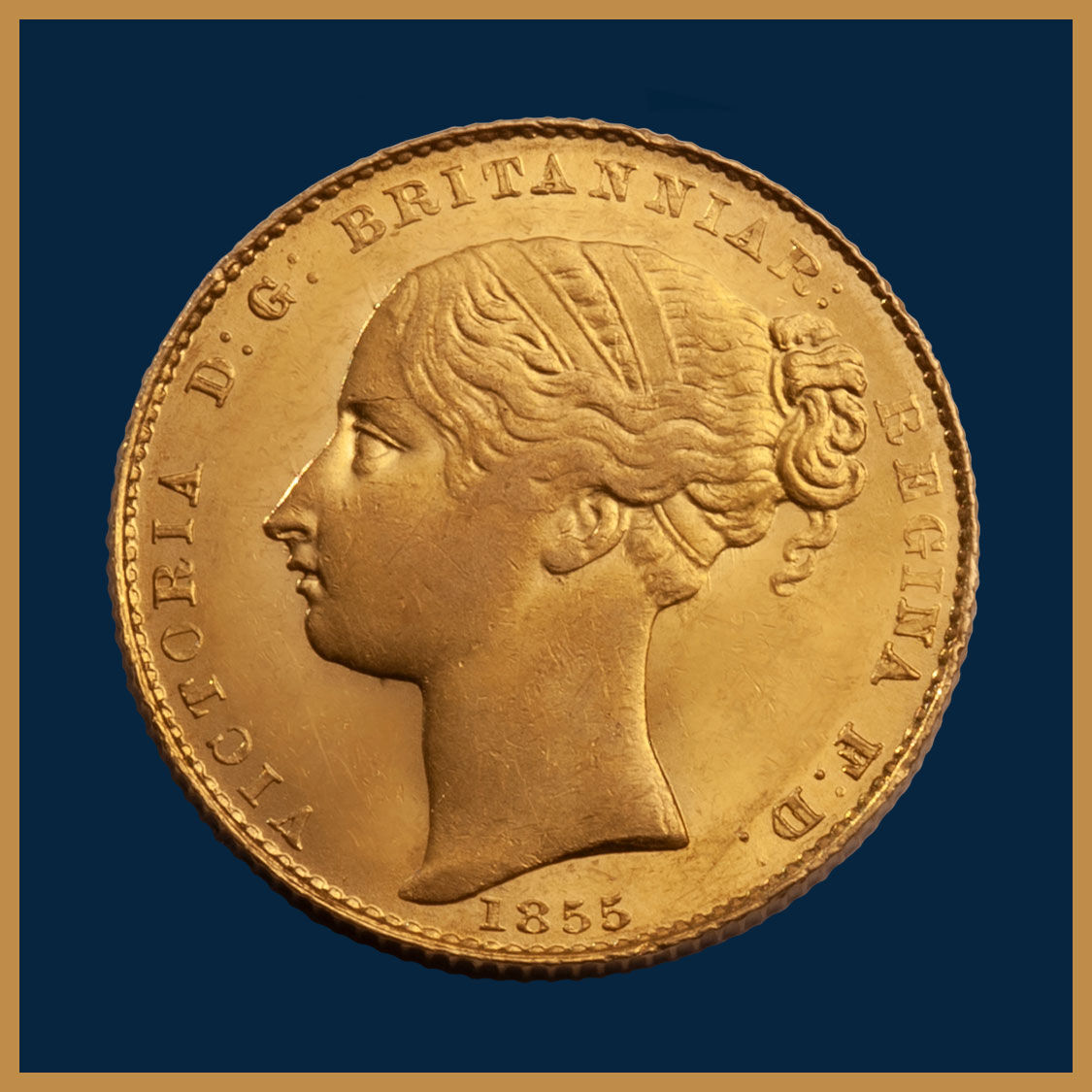
1855 Sydney Mint Sovereign
Nearly Uncirculated Obverse
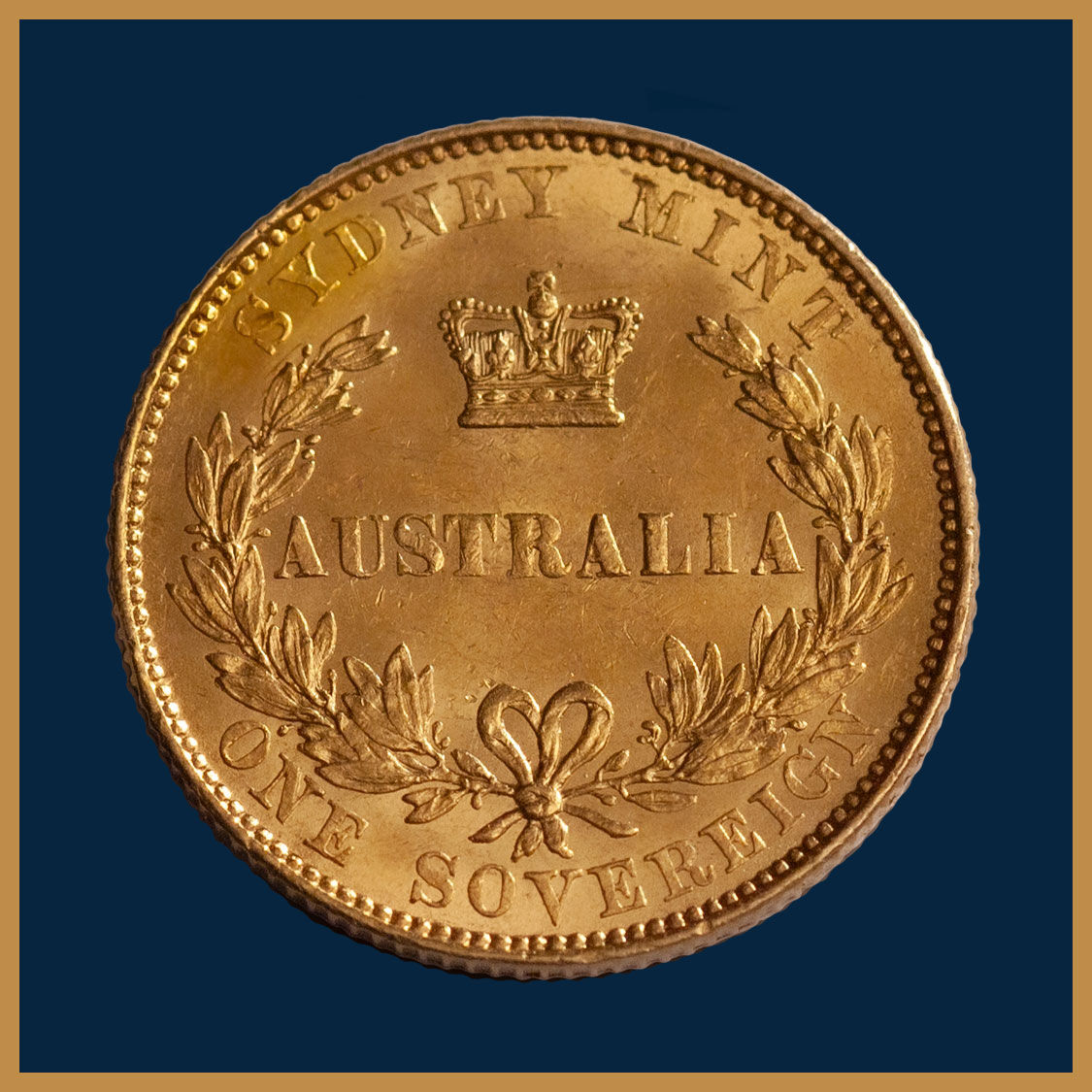
1855 Sydney Mint Sovereign
Uncirculated Reverse
Every circulating coin has a grading level at which serious rarity kicks in.
That is the point at which the balance between acquiring a coin as a collectible - and as an investment - shifts more towards the latter.
The pie chart shown here clearly shows that well circulated examples of the 1855 Sydney Mint Sovereign (in a quality range of Poor to Good Very Fine) are reasonably readily available.
While About Extremely Fine to Extremely Fine 1855 Sovereigns have reduced availability, the chart clearly shows that it is the coins graded between Good Extremely Fine and Choice Uncirculated that are exceptionally scarce.
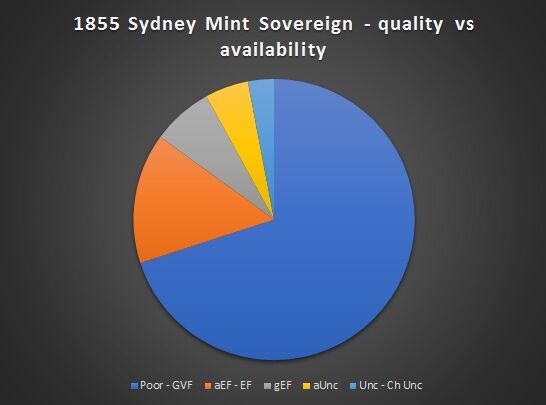
1855 Sydney Mint Sovereign Nearly Uncirculated / Uncirculated
Price: $40,000
Australia celebrates the 1813 Holey Dollar and 1813 Dump. And the 1852 Adelaide Pound. Each coin was the first of its kind. A definite one-off, struck in one year only as an interim measure to address a currency crisis. And the coins fulfilled their purpose and are lauded for their history and the ingenuity of their creation.
The sovereign also was the first of its kind: the nation’s first official coinage issued by the nation’s first official mint. But it was not a one-off and became the mainstay of commerce. Regulated by currency laws the sovereign was introduced for the long term and became a unit of exchange up until 1931 when Australia struck its last gold sovereign.
Australia issued sovereigns between 1855 and 1931 and while the appeal of the sovereign is enhanced by different versions featuring the effigies of various monarchs, no coin is as popular as the first Australian sovereign, the 1855 Sydney Mint Sovereign.
In 1851, the Sydney Morning Herald published an editorial championing the establishment of a branch of the Royal Mint in Sydney to buy gold at full price and strike it into sovereigns.
The plan for a branch of the Royal Mint received great support from the diggers. Solid opposition came from the banks and a prominent group of private individuals both of whom had become major buyers of gold on the fields at prices discounted well below the full London price. Profits were at stake! Both factions had earlier joined forces to quash a proposal for a Sydney Assay Office that would have also impacted negatively on their commercial interests.
While it is true that New South Wales had in 1851 formally petitioned the home office in London for a branch of the Royal Mint, the decision had already been made in the British Parliament to give the colonies greater autonomy and establish a branch mint to allow them to strike coins of the realm, the sovereign.
The Sydney Mint would strike sovereigns and half sovereigns to exactly the weight and fineness levels at the Royal Mint but they would have their own design. This was to protect the international reputation of the imperial gold coins in the event that Sydney was unable to meet the exacting standards demanded of the coin.
On the 19 August 1853 Queen Victoria gave formal approval to establish Australia’s very first mint at or near Sydney in New South Wales. In the same year, the Royal Mint London prepared designs of Australia’s first gold coinage and manufactured the dies.
The sovereign and half sovereign obverse design was a filleted bust of Victoria, only slightly different to that used on British sovereigns. The obverse quickly fell out of favour and James Wyon was ordered to engrave a new obverse that would be uniquely Australian to easily distinguish the colonial sovereigns from their British counterparts. To this end, a new portrait was introduced in 1857 that featured Queen Victoria with a banksia wreath in her hair instead of the band.
The reverse design was based loosely around contemporary reverse designs of the British sixpence and shilling. Its strong point of difference to the British sovereigns was the inclusion of the words 'Australia' and 'Sydney Mint'.
The use of the word Australia, a fascination with historians. At the time the nation was operating as separate colonies. Australia did not operate under a single Government until Federation in 1901.
The first Deputy Master of the Sydney Mint was Captain Edward Wolstenholme Ward, a trained member of the Royal Engineers. (Photo shown at top.)
Ward arrived in the colony in October 1854 on the ship Calcutta, along with other members of the Royal Engineers, a sergeant, three corporals and twelve privates. The group was deposited on Circular Quay with the bales and boxes of Sydney's new mint, along with the dies.
The Sydney Mint was established in a wing of the 'Rum Hospital' in Macquarie Street, Sydney. The mint began receiving gold on 14 May 1855 and issued its first gold sovereign soon after on June 23.
In their infancy the Sydney Mint sovereigns and half sovereigns were legal tender only in the colony of New South Wales.
In January 1856, the British tested the quality of the colonial gold coins and the results showed that they had a higher intrinsic value than their British counterparts, primarily due to their 8.33% silver content. Once these facts became known, profiteers began melting them down.
The colonial gold coins also became legal tender in Tasmania and Western Australia in 1856. South Australia and Victoria were reticent to enshrine the Sydney Mint as Australia's official mint as each colony had independently requested their own and were miffed at missing out.
By 1857, the legal tender scope was widened to include all Australian colonies and Mauritius, Ceylon and Hong Kong. In 1868 the Sydney Mint Sovereigns and Half Sovereigns became legal tender throughout the British Empire.
The design of the Sydney Mint Sovereign lasted until 1870 and was the only time the word Australia appeared on our gold sovereigns. From 1871, Australia's sovereigns took on a traditional British design.
Highlights of our Inventory
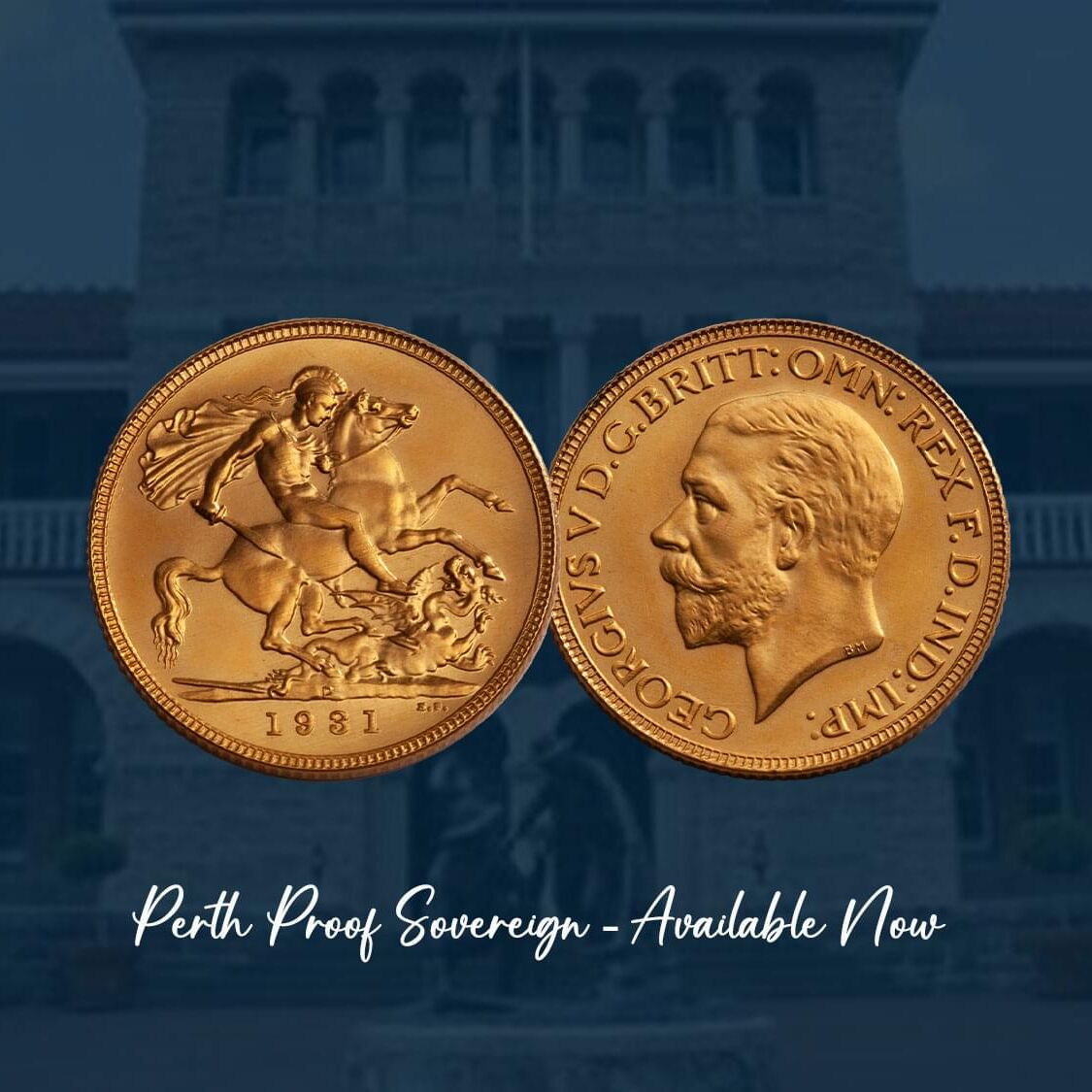
This 1931 Proof Sovereign was struck as a Coin of Record at the Perth Mint, a proof striking of the Mint’s (and Australia's) very last sovereign. It is a numismatic giant. Collectors at the Bentley Collection sale conducted by Baldwins in London 2012 certainly thought so too, the coin selling for £52,800, 32 per cent higher than its pre-sale upper estimate of £40,000. By comparison, a 1929 Melbourne Mint Proof Sovereign, a proof coin out of the same era, was offered with an upper pre-sale estimate of £40,000 and sold for £40,800. There are two fundamental reasons why the Coins of Record of the Perth Mint command more dollars than those of the Melbourne Mint. The Perth Mint Coins of Record have a higher profile, because the mint is still operating. And they are far rarer.
Click here for more details on this Product
A Coin of Record is an artistic interpretation of coinage, a strikingly beautiful coin beyond ordinary currency, individually crafted to standards far exceeding that required of a circulating coin.
Using technical terms, Coins of Record were struck using special minting techniques to either a proof or specimen finish involving highly polished blanks to create mirror fields and carefully prepared dies to ensure a wealth of design definition.
A Coin of Record is a showpiece. The crown jewels of coinage, adding glamour and exceptionality to any collection.
Whereas production of circulating coinage was dictated by Government, Coins of Record were struck at the discretion of the mint master. Placed in the mint’s archives for posterity. Perhaps, an example forwarded to the monarch. Coins of Record were occasionally produced for the Royal Mint London, a selected museum or to display at an international exhibition. Or gifted to a dignitary. All circumstances that necessitated the very best in minting standards.
The coins were not produced every year and, as they were individually crafted, the process was time consuming and the mintages tiny, therefore. For gold proofs, generally less than four pieces.
In its entire sovereign and half sovereign history (1899 to 1931), the Perth Mint struck Coins of Record in only three years, 1899, 1901 and 1931.
As a sector of the Australian rare coin market, the Perth Mint Gold Coins of Record is the most exclusive for collectors to buy into.
The whereabouts of the privately owned 1899 Proof Sovereign is unknown, the 1899 Proof Half Sovereign is unique. The 1901 Proof Sovereign is one of two known, the 1901 Proof Half Sovereign unique. (A sovereign and the only known half sovereign sold recently as a pair.) The 1931 Proof Sovereign is one of two known.
Simple arithmetic confirms that the buying pool for collectors of the Perth Mint Coins of Record is seven coins. When an example comes to market, Zurich, London, Sydney, the news spreads fast and the collector market reacts, the world over.
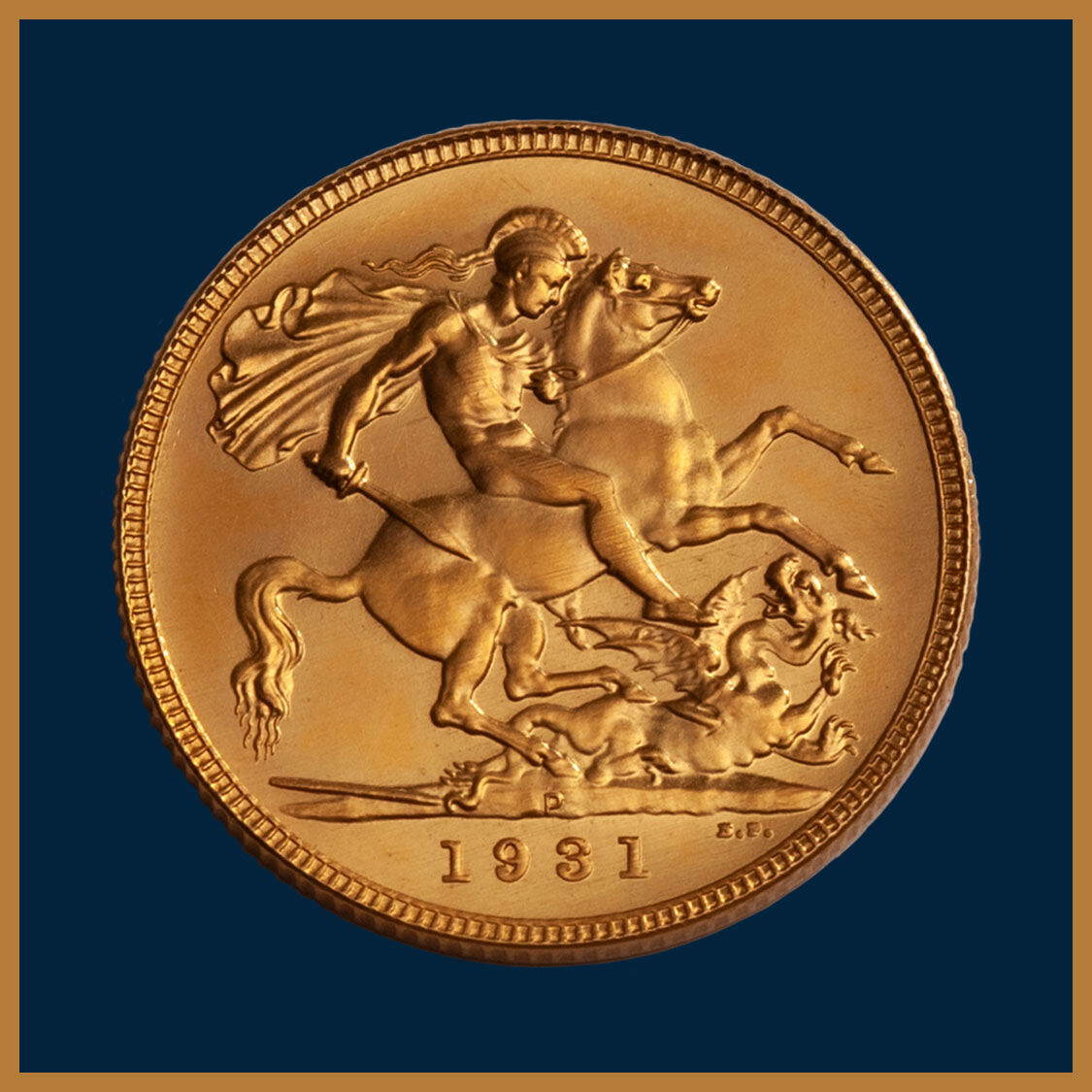
1931 Proof Sovereign
Perth Mint Coin of Record
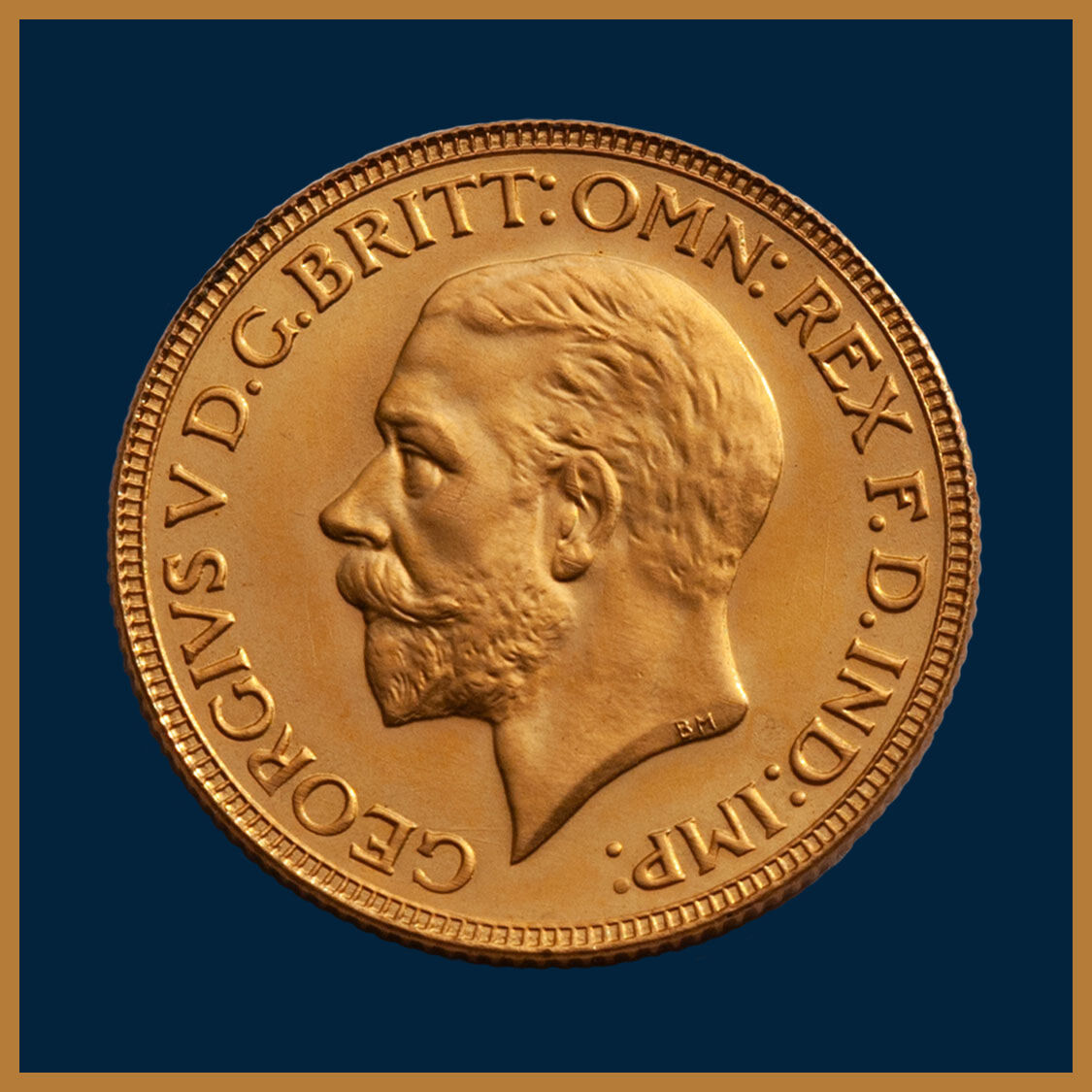
1931 Proof Sovereign
Perth Mint Coin of Record
Australia’s Coins of Record are admired and respected worldwide. As with fine art and fine jewellery, they have prestige value.
Three branches of the Royal Mint London operated in Australia. The Sydney Mint opening in 1855, the Melbourne Mint in 1872 and the Perth Mint in 1899, each mint sporadically producing Coins of Record of its sovereigns and half sovereigns.
There are two fundamental differences between the Coins of Record of the Perth Mint and those of Melbourne and Sydney. The Perth Mint Coins of Record have a higher profile, because the mint is still operating. And they are far rarer.
The Sydney Mint closed in 1926, the Melbourne Mint in 1964, their greatest historical pieces are, in many respects, confined to history.
For the Perth Mint, its story is on-going. Its collecting audience is expanding.
The Perth Mint’s commercial profile creates an environment whereby its earlier gold sovereign and half sovereign issues can be enabled and brought to life.
As the name 'Macquarie' lives on through the Macquarie Bank, so too history lives on for the Perth Mint through its current coining operations.
Every time the Perth Mint opens its doors to welcome visitors, releases a new proof coin or celebrates an anniversary of its minting operations (as it did on 2024), we are reminded of a heritage that began in 1899. And we are further reminded of a tradition of continual coining excellence that began with its Coins of Record.
1931 Perth Mint Proof Sovereign, a proof striking of the last sovereign struck at the Perth Mint.
Price: $195,000
John Agnew Collection circa 1931 • Agnew Family Collection sold to Spink & Son privately circa 1994 • Bentley Collection sold by Baldwins 27 September 2012 (lot 878)
That a coin of such power and influence in the Australian gold coin market was originally owned by John Agnew somehow seems just right for he too was powerful and influential.
A man of vision and remarkable knowledge of gold mining, Agnew was credited with making a major contribution to revitalise the Western Australian gold mining sector in the 1920s and 1930s and was Director of Consolidated Goldfields when he was gifted this coin.
A superb mint state and of the highest rarity, ex Bentley Collection 2012 (lot 878), this coin is unique for quality, the finest of two available to collectors, the other example impaired through mishandling.
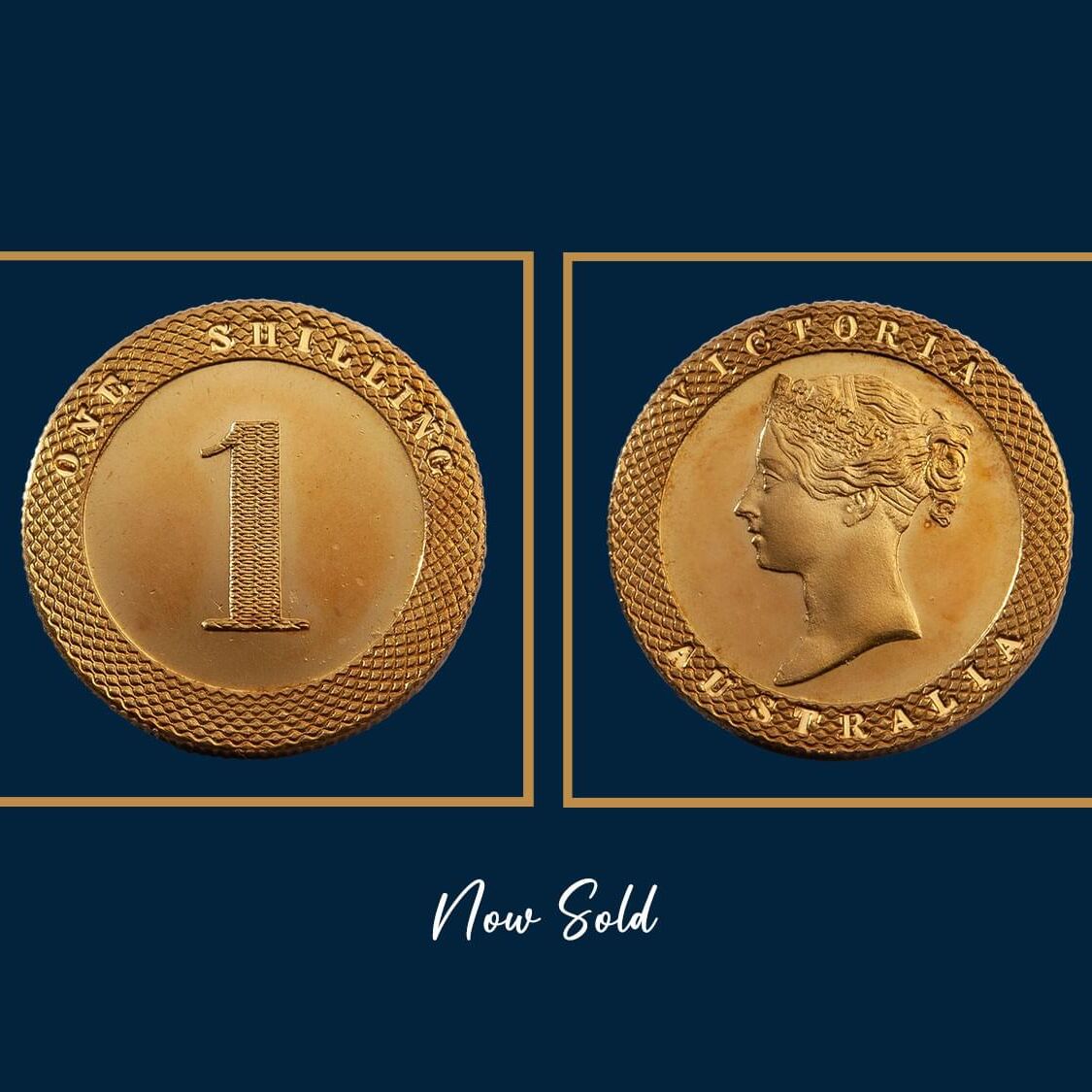
This Kangaroo Office Gold Shilling was first sighted in London in 1904, as part of the esteemed John G. Murdoch Collection. No other examples are known. Leafing through the bound editions of the early catalogues of 1904 (John G. Murdoch), 1922 (Baron Philip Ferrari La Renotiere) and 1954 (King Farouk), you are in no doubt of the enormous historical and numismatic significance that this piece carries. It embodies history. The Gold Kangaroo Patterns are at the top of their class and this gold shilling is the best in its category, struck with a grained edge indicating that it was minted circa 1855. Exceptional design. Unique style. Rich in history. A piece that has global standing. This Kangaroo Office Gold Shilling is a 'trophy' piece.
Click here for more details on this Product
In the early days of the Australian Gold Rush, gold was not a standard of value as it was elsewhere in the world. Despite the international gold standard, its purchase value was not fixed but was subject to supply and demand.
The potential of buying gold at a low price was exploited by the banks, buying gold on the fields at rates far below that offered in the towns.
British entrepreneur William Taylor planned to establish a private mint in Melbourne, named the Kangaroo Office. And to challenge the bank's monopoly on the fields. Taylor's plan was that gold, bought at low prices, would be converted into pieces of a fixed weight, a quarter ounce, half ounce, one ounce and two ounce and released into circulation at £1, £2, £4 and £8.
Taylor's first gold issue was dated 1853, the use of a weight value rather than a legal tender value a clever ploy so as not to draw the ire of the colonial Government by striking what was perceived to be 'currency'. Taylor became more venturesome and later, circa 1855, he produced dies for a shilling and sixpence striking them in gold, silver and various other metals.
The sale of the Quartermaster Collection in 2009 was the largest ever offering of Kangaroo Office Patterns, the world over. By lots. And by dollars. Seventeen pieces in total, five produced from gold, six struck in copper and six from silver.
Up until the Quartermaster Auction, the maximum number of gold pieces offered at any one time at an Australian auction had been two.
The Quartermaster Collection held two quarter ounce gold pieces. One gold shilling piece with a grained edge, a gold shilling with a plain edge. And one plain edge sixpence piece. (The milled edge are believed to have been struck circa 1855, the plain edge circa 1860.)
The standout lot of the five gold pieces on offer at the Quartermaster Auction was this Gold Shilling, selling for $305,000, well above its estimate of $250,000. (The plain edge shilling and sixpence also sold well). The quarter ounce pieces, which were expected to shine, sold. But at subdued levels, slightly below their pre-sale estimate, the market showing their overwhelming preference for the 'currency' pieces, the shillings and the sixpence.
The Gold Kangaroo Patterns are at the top of their class and this gold shilling is the best in its category. Struck with a milled edge indicating that it was minted circa 1855. Exceptional design. Unique style. Rich in history. A piece that has global standing.
This Kangaroo Office Gold Shilling is a 'trophy' piece.
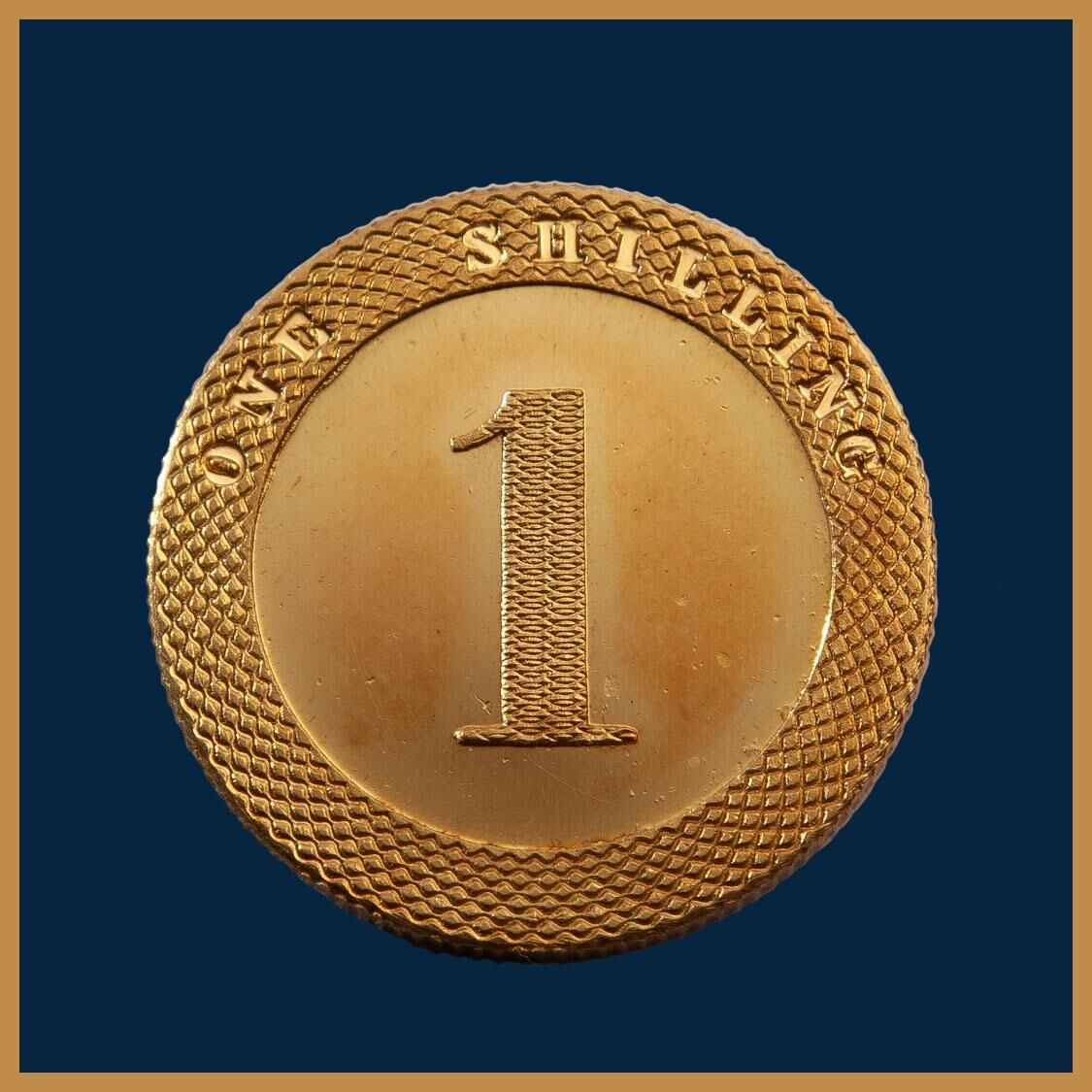
Kangaroo Office Gold Shilling,
milled edge
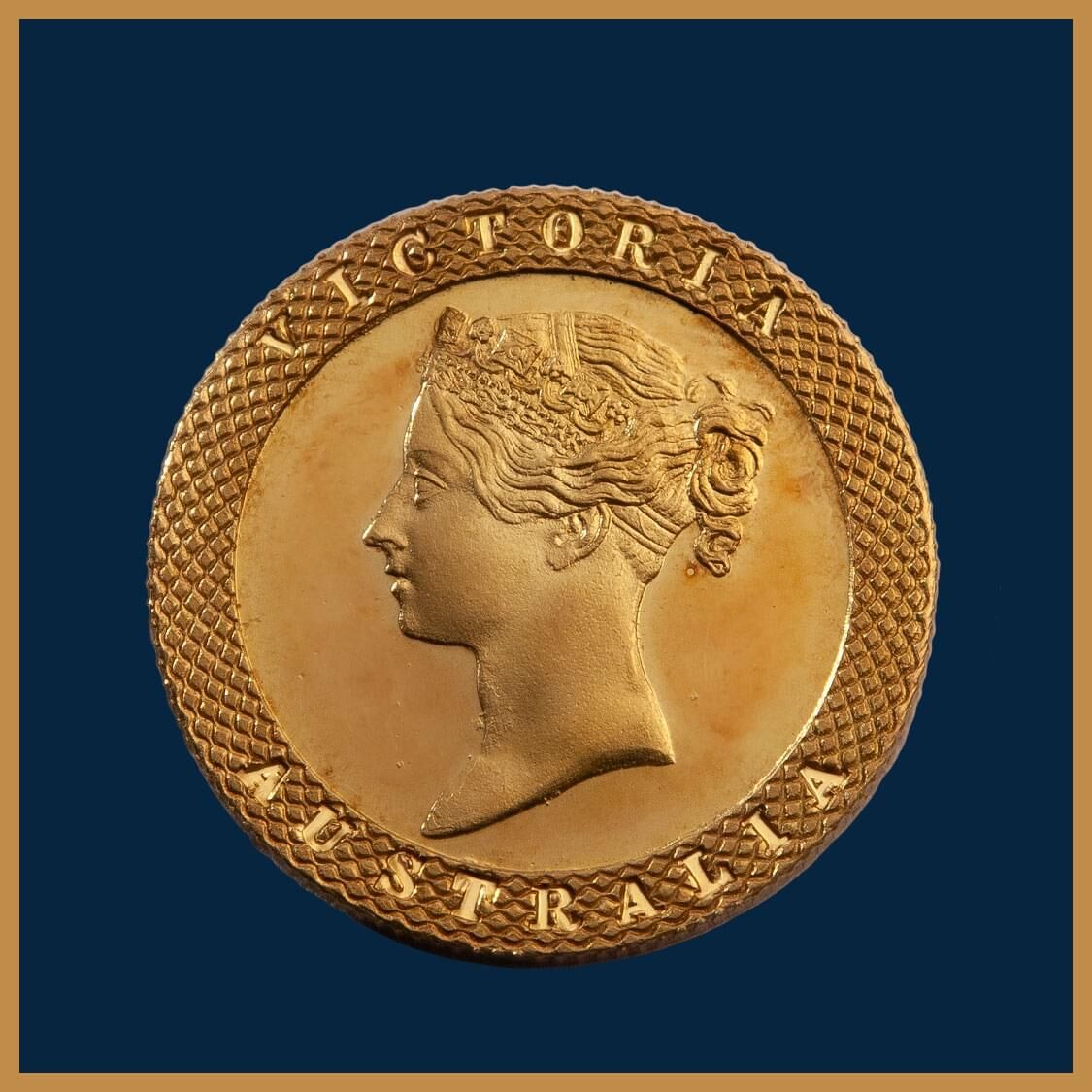
Kangaroo Office Gold Shilling,
milled edge
Technical details Kangaroo Office Gold Shilling
Obverse: A broad raised engine-turned rim encircles a superb portrait of Queen Victoria wearing a jewelled crown, thought to be executed by William Taylor in 1855, and the words VICTORIA and AUSTRALIA incused in the rim.
Reverse: A broad engine-turned rim encircles a large figure ‘1’ in the centre decoratively engraved and the words ONE SHILLING incused in the rim.
Diameter: 22mm
Weight: 8.19 grams
(An engine-turned rim refers to a decorative pattern created by a machine-operated process whereby fine, closely spaced, criss-crossing lines are engraved into a surface. The result is a visually appealing, textured surface that adds a touch of elegance and sophistication.)

Circa 1855 Kangaroo Office Gold Shilling

Circa 1855 Kangaroo Office Gold Shilling
Circa 1855, Port Phillip, Kangaroo Office, Pattern Gold Shilling struck with a grained edge, believed unique.
Soon after the opening of the Adelaide Assay Office in 1852, and the striking of the Adelaide Pound - the nation's first gold coin - there was an attempt to establish a private mint in Melbourne. The mint was called the Kangaroo Office. Its prime goal was to buy gold at cheap prices direct from the fields and convert the precious metal into 'coins' of a fixed weight that would be released at their full value in London.
The plan was devised by English entrepreneur, William Joseph Taylor. By trade Taylor was an engraver and die sinker, active in the numismatic industry producing both coins and medals. He formed a syndicate to finance the operations with two colleagues, Hodgkin and Tyndall. The total investment was £13,000.
Taylor's mint was only one component of a broader-reaching enterprise that was based in London. The overall plan was to profit from all aspects of the Gold Rush and included a clipper ship - called the Kangaroo - that would bring migrants and goods from England to Melbourne and return with gold in its specially outfitted strongroom.
The Kangaroo sailed from London on 26 June 1853. On board, the pre-fabricated structure to house the mint and the shop. And the coining press, dies and two employees, Reginald Scaife, the Manager, and William Morgan Brown, his assistant. The ship arrived at Hobsons Bay, Melbourne on 26 October 1853.
The Kangaroo Office got off to a bad start as there were no facilities at the wharf for off-loading heavy equipment, such as the coining press. With no other option available, the press was dismantled, moved and reassembled, a process that took six months. The Kangaroo Office eventually commenced operations in May 1854, striking gold coins. To thwart currency laws, the designs were made to look more like weights than coins. Taylor himself cut the dies for a 2oz, 1oz, 1/2oz and ¼oz gold piece, each dated 1853.
The coins were exhibited at the Melbourne Exhibition of 1854 (17 October - 12 December) and were written up in the Argus Newspaper as "several tokens of pure Australian gold were exhibited by Mr. Khull, bullion broker. They were manufactured by Mr. Scaiffe and are to be exhibited at our Palace of Industry."(Sadly a price was never quoted.)
Apart from the logistical difficulties of setting up business, the financial viability of the Kangaroo Office came under an immediate cloud. By mid-1854 when the mint became operational the price of gold had moved up to £4/4/- an ounce, vastly different to the £2/15/- per ounce when the plan was hatched. And there was a glut of English sovereigns in circulation.
By the middle of 1854, Reginald Scaiffe, the Kangaroo Office Manager, had an overwhelming sense of failure for the shop had taken less than £1 in trading, he had a ten-year lease, could not find cheap labour. Nor cheap gold. And basically had no customers.
Despite the financial challenges of the operation Taylor was unconvinced that his days as a coin designer and manufacturer were at an end. In 1855 he produced dies for the striking of a sixpence and shilling in gold, silver and copper. This was his first attempt at producing a piece depicting a value rather than a weight. The coins were struck with a milled and plain edge, the former believed minted circa 1855, the latter circa 1860.
The sixpence and shilling featured the same broad engine-turned rim as the earlier minted gold coins. The obverse however featured a superb portrait of Queen Victoria with VICTORIA and AUSTRALIA embedded in the rim. The reverse featured the denomination in figures at the centre and in letters embedded in the rim above.
Taylor operated his Kangaroo Office for three years during which time he sustained substantial losses. With all hope of a profit gone, the dispirited promoters in London issued instructions for the Kangaroo Office to be closed. Now while it is true that Taylor never achieved his ambitions, the Kangaroo Office coins are revered by collectors right across the globe.
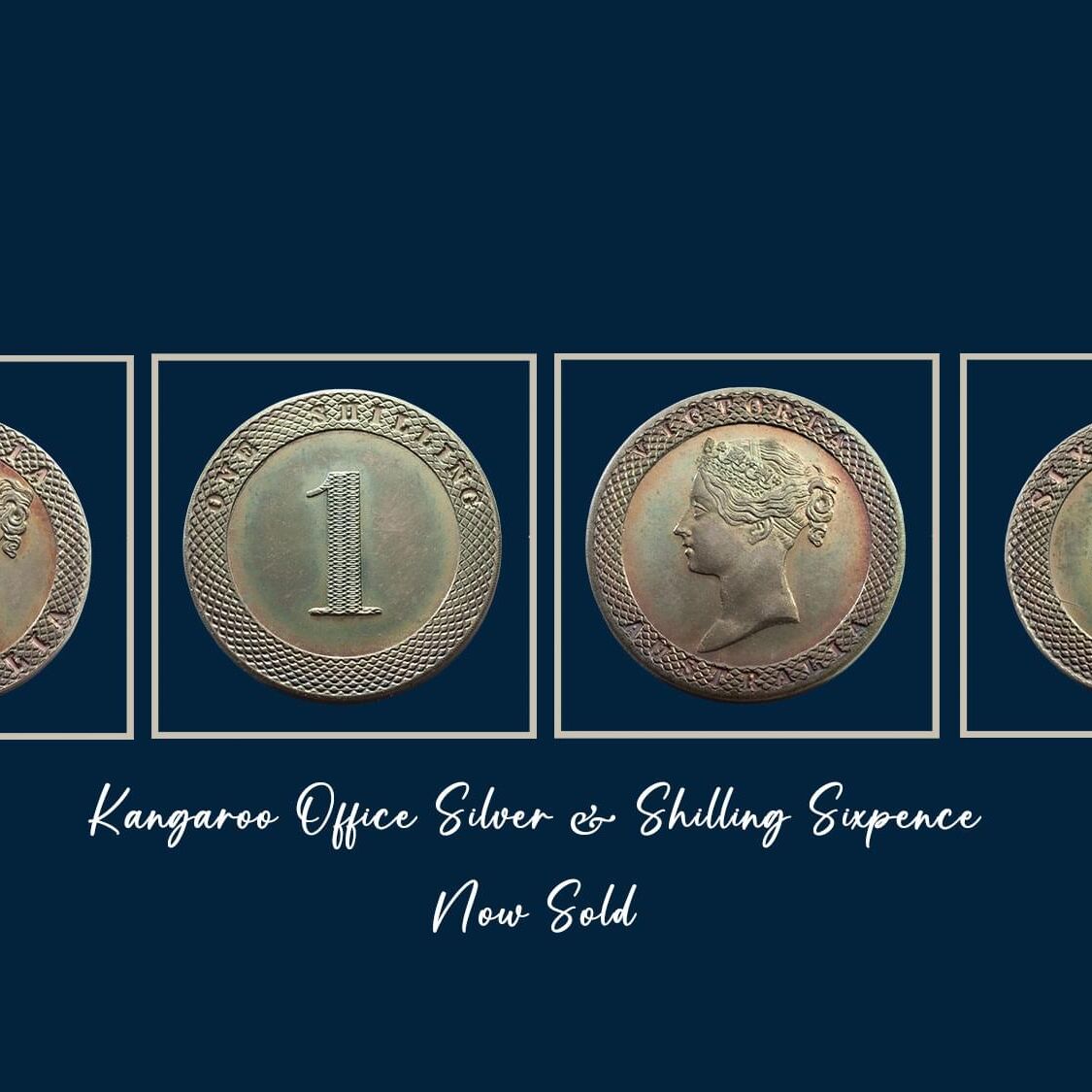
History has judged British entrepreneur William Taylor a 'big noter'. He aspired to own and operate a private mint in Melbourne and create a new gold coinage for the colonies. The mint was called the Kangaroo Office and opened in May 1854. Taylor ultimately embraced other metals and struck coins in silver and copper, aluminium and even pewter. They are extremely rare and have been owned by some of history's most lauded collectors, Britain's Hyman Montague and John G Murdoch, Egypt's King Farouk and America's J. J. Pitman. And Australian collectors Philip Spalding and Tom Hadley of Quartermaster fame. This perfectly matched pair was acquired by Coinworks in 2002 from Barrie Winsor, who had acquired them from renowned US dealer Wayte Raymond. They are magnificent! We can certainly attest to their rarity this being the second only pair we have sold over the last twenty-five years.
Click here for more details on this Product
This pair of Kangaroo Office Shilling and Sixpence was last sold in 2002. And it is true, that over the last two decades we have made several attempts, to lure these coins back onto the market, with no success. The owner simply wouldn't part with them, well aware that the quality made them irreplaceable.
A change of circumstances now sees them offered for sale. They are quality-wise incomparable. The Kangaroo Patterns are exceedingly scarce and become available on the market perhaps once every five years. But a matched pair, comprised of coins of this calibre, is a once-in-a-lifetime opportunity.
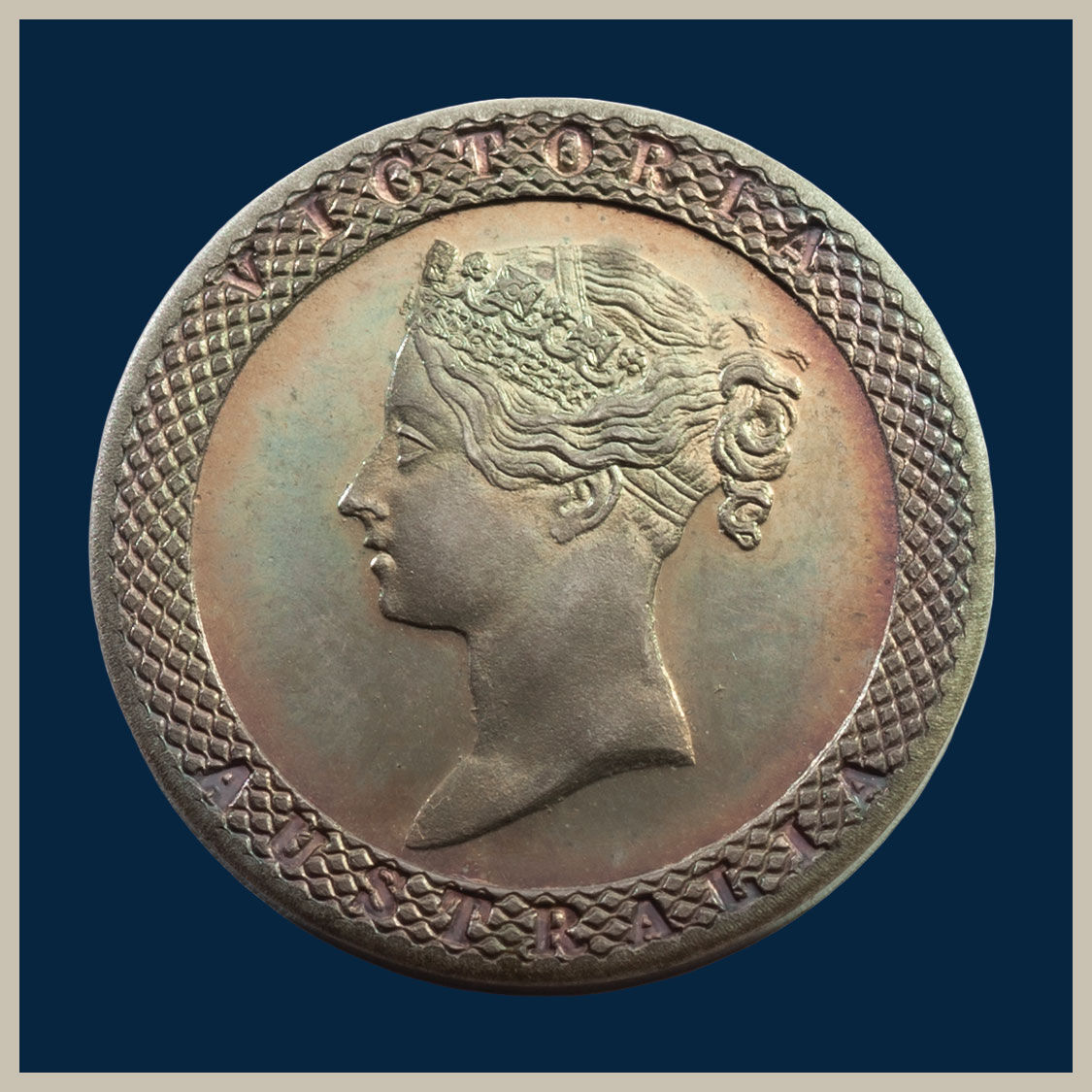
Kangaroo Shilling Obverse
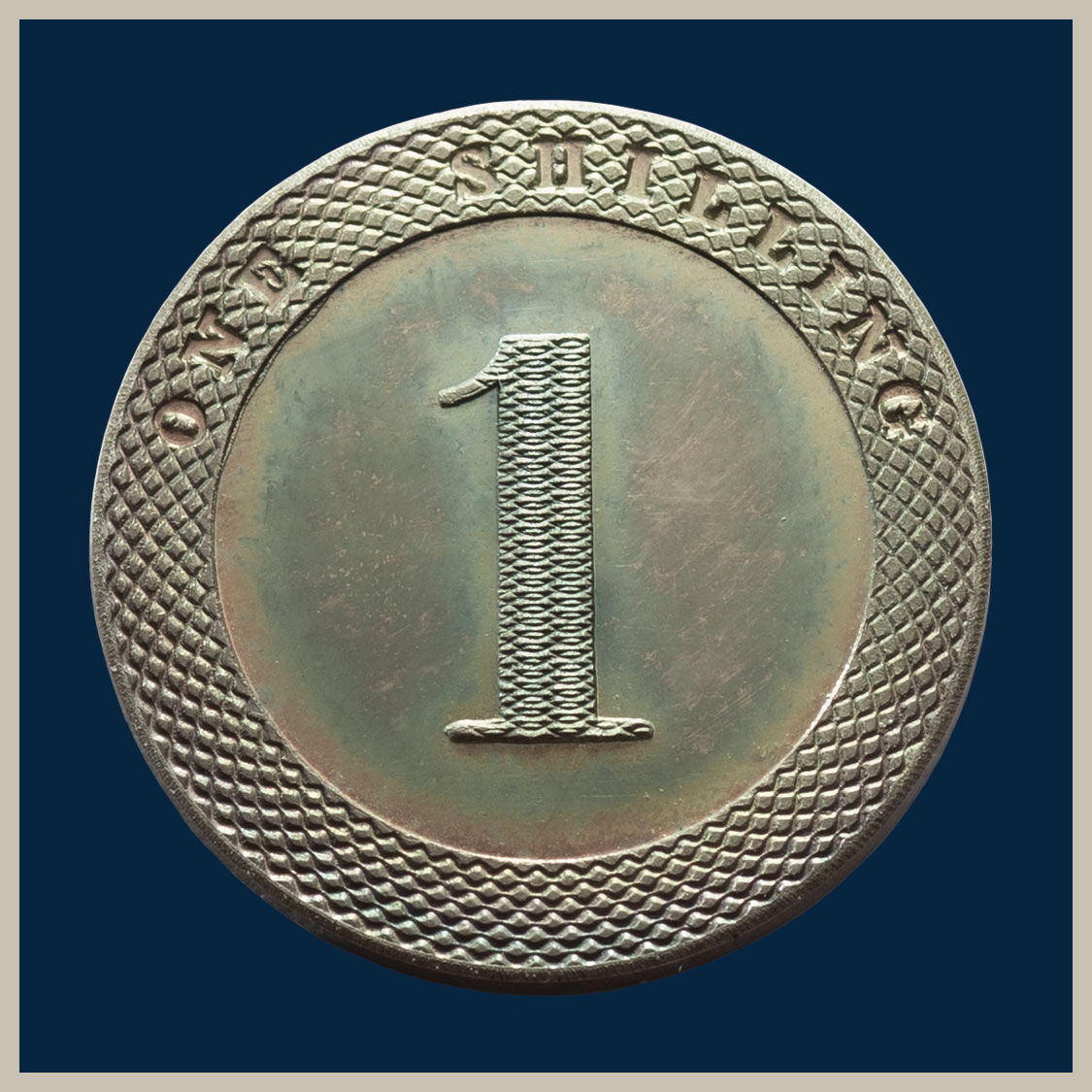
Kangaroo Shilling Reverse
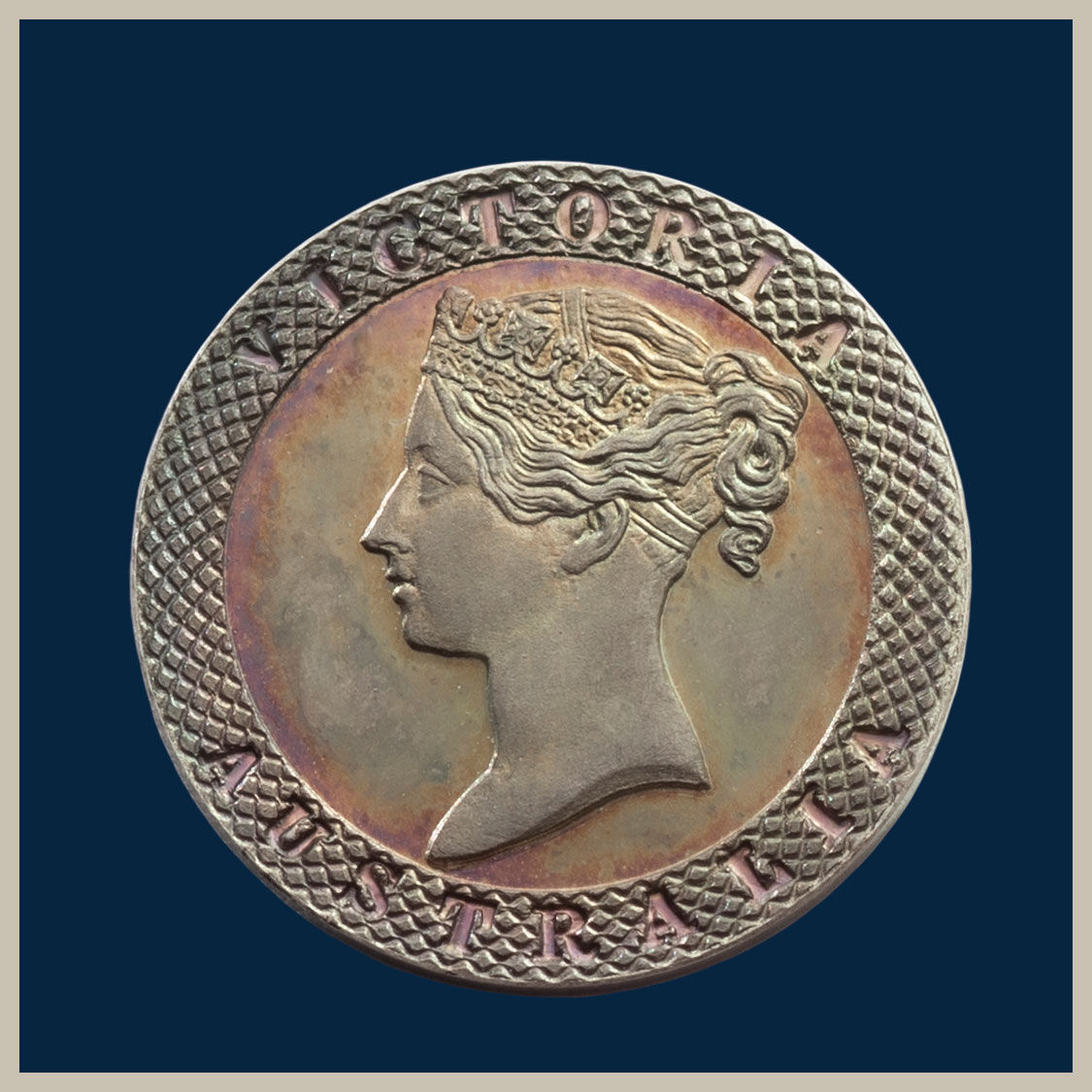
Kangaroo Sixpence Obverse
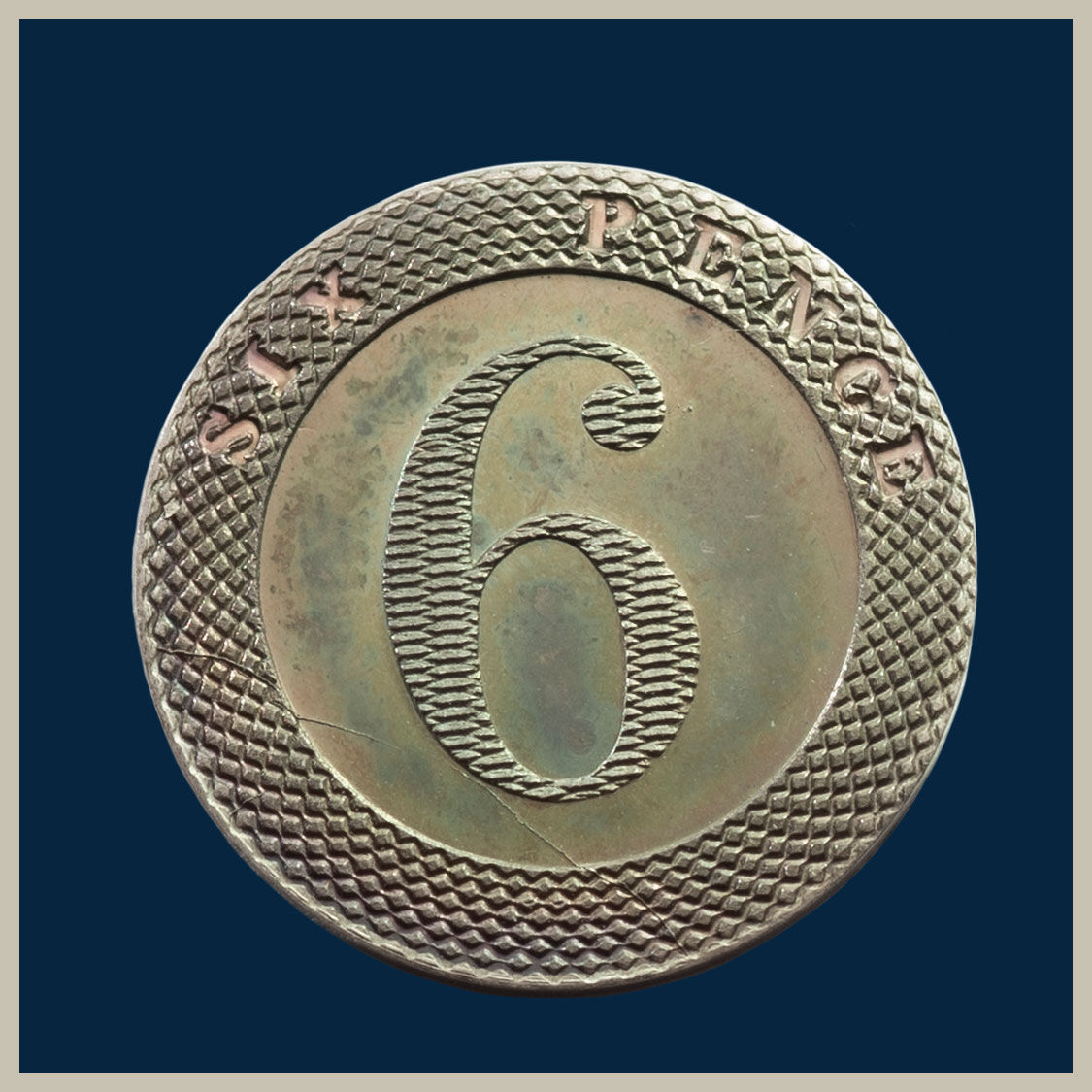
Kangaroo Sixpence Reverse
Technical details of the Kangaroo Office Shilling
Obverse:
Displays a broad raised engine-turned rim encircling a superb portrait of Queen Victoria wearing a jewelled crown, thought to be executed by William Taylor in 1855, and the words VICTORIA and AUSTRALIA incused in the rim.
Reverse:
Displays a broad engine-turned rim encircling a large figure ‘1’ in the centre decoratively engraved and the words ONE SHILLING incused in the rim.
An engine-turned rim refers to a decorative pattern created by a machine-operated process whereby fine, closely spaced, criss-crossing lines are engraved into a surface. The result is a visually appealing, textured surface that adds a touch of elegance and sophistication.
Technical details of the Kangaroo Office Sixpence
Obverse:
Displays a broad raised engine-turned rim encircling a superb portrait of Queen Victoria wearing a jewelled crown, thought to be executed by William Taylor in 1855, and the words VICTORIA and AUSTRALIA embedded in the rim.
Reverse:
Displays a broad engine-turned rim encircling a large figure ‘6’ in the centre decoratively engraved and the words SIX PENCE incused in the rim.
Soon after the opening of the Adelaide Assay Office in 1852, and the striking of the Adelaide Pound - the nation's first gold coin - there was an attempt to establish a private mint in Melbourne.
The mint was called the Kangaroo Office. Its prime goal was to buy gold at cheap prices direct from the fields and convert the precious metal into 'coins' of a fixed weight that would be released at their full value in London.
The plan was devised by English entrepreneur, William Joseph Taylor. By trade Taylor was an engraver and die sinker, active in the numismatic industry producing both coins and medals. He formed a syndicate to finance the operations with two colleagues, Hodgkin and Tyndall. The total investment was £13,000.
Taylor's mint was only one component of a broader-reaching enterprise that was based in London. The overall plan was to profit from all aspects of the Gold Rush and included a clipper ship - called the Kangaroo - that would bring migrants and goods from England to Melbourne and return with gold in its specially outfitted strongroom.
The Kangaroo sailed from London on 26 June 1853. On board, the pre-fabricated structure to house the mint and the shop. And the coining press, dies and two employees, Reginald Scaife, the Manager, and William Morgan Brown, his assistant. The ship arrived at Hobsons Bay, Melbourne on 26 October 1853.
The Kangaroo Office got off to a bad start as there were no facilities at the wharf for off-loading heavy equipment, such as the coining press. With no other option available, the press was dismantled, moved and reassembled, a process that took six months.
The Kangaroo Office eventually commenced operations in May 1854, striking gold coins. To thwart currency laws, the designs were made to look more like weights than coins. Taylor himself cut the dies for a 2oz, 1oz, 1/2oz and ¼oz gold piece, each dated 1853.
The coins were exhibited at the Melbourne Exhibition of 1854 (17 October - 12 December) and were written up in the Argus Newspaper as "several tokens of pure Australian gold were exhibited by Mr. Khull, bullion broker. They were manufactured by Mr. Scaiffe and are to be exhibited at our Palace of Industry."(Sadly a price was never quoted.)
Apart from the logistical difficulties of setting up business, the financial viability of the Kangaroo Office came under an immediate cloud. By mid-1854 when the mint became operational the price of gold had moved up to £4/4/- an ounce, vastly different to the £2/15/- per ounce when the plan was hatched. And there was a glut of English sovereigns in circulation.
By the middle of 1854, Reginald Scaiffe, the Kangaroo Office Manager, had an overwhelming sense of failure for the shop had taken less than £1 in trading, he had a ten-year lease, could not find cheap labour. Nor cheap gold. And basically had no customers.
Despite the financial challenges of the operation Taylor was unconvinced that his days as a coin designer and manufacturer were at an end. In 1855 he produced dies for the striking of a sixpence and shilling in gold, silver and copper. This was his first attempt at producing a piece depicting a value rather than a weight.
The coins were struck with a milled and plain edge, the former believed minted circa 1855, the latter circa 1860.
The sixpence and shilling featured the same broad engine-turned rim as the earlier minted gold coins. The obverse however featured a superb portrait of Queen Victoria with VICTORIA and AUSTRALIA embedded in the rim. The reverse featured the denomination in figures at the centre and in letters embedded in the rim above.
Taylor operated his Kangaroo Office for three years during which time he sustained substantial losses. With all hope of a profit gone, the dispirited promoters in London issued instructions for the Kangaroo Office to be closed.
Now while it is true that Taylor never achieved his ambitions, the Kangaroo Office coins are revered by collectors right across the globe.
Soon after the opening of the Adelaide Assay Office in 1852, and the striking of the Adelaide Pound - the nation's first gold coin - there was an attempt to establish a private mint in Melbourne.
The mint was called the Kangaroo Office. Its prime goal was to buy gold at cheap prices direct from the fields and convert the precious metal into 'coins' of a fixed weight that would be released at their full value in London.
The plan was devised by English entrepreneur, William Joseph Taylor. By trade Taylor was an engraver and die sinker, active in the numismatic industry producing both coins and medals. He formed a syndicate to finance the operations with two colleagues, Hodgkin and Tyndall. The total investment was £13,000.
Taylor's mint was only one component of a broader-reaching enterprise that was based in London. The overall plan was to profit from all aspects of the Gold Rush and included a clipper ship - called the Kangaroo - that would bring migrants and goods from England to Melbourne and return with gold in its specially outfitted strongroom.
The Kangaroo sailed from London on 26 June 1853. On board, the pre-fabricated structure to house the mint and the shop. And the coining press, dies and two employees, Reginald Scaife, the Manager, and William Morgan Brown, his assistant. The ship arrived at Hobsons Bay, Melbourne on 26 October 1853.
The Kangaroo Office got off to a bad start as there were no facilities at the wharf for off-loading heavy equipment, such as the coining press. With no other option available, the press was dismantled, moved and reassembled, a process that took six months.
The Kangaroo Office eventually commenced operations in May 1854, striking gold coins. To thwart currency laws, the designs were made to look more like weights than coins. Taylor himself cut the dies for a 2oz, 1oz, 1/2oz and ¼oz gold piece, each dated 1853.
The coins were exhibited at the Melbourne Exhibition of 1854 (17 October - 12 December) and were written up in the Argus Newspaper as "several tokens of pure Australian gold were exhibited by Mr. Khull, bullion broker. They were manufactured by Mr. Scaiffe and are to be exhibited at our Palace of Industry."(Sadly a price was never quoted.)
Apart from the logistical difficulties of setting up business, the financial viability of the Kangaroo Office came under an immediate cloud. By mid-1854 when the mint became operational the price of gold had moved up to £4/4/- an ounce, vastly different to the £2/15/- per ounce when the plan was hatched. And there was a glut of English sovereigns in circulation.
By the middle of 1854, Reginald Scaiffe, the Kangaroo Office Manager, had an overwhelming sense of failure for the shop had taken less than £1 in trading, he had a ten-year lease, could not find cheap labour. Nor cheap gold. And basically had no customers.
Despite the financial challenges of the operation Taylor was unconvinced that his days as a coin designer and manufacturer were at an end. In 1855 he produced dies for the striking of a sixpence and shilling in gold, silver and copper. This was his first attempt at producing a piece depicting a value rather than a weight.
The coins were struck with a milled and plain edge, the former believed minted circa 1855, the latter circa 1860.
The sixpence and shilling featured the same broad engine-turned rim as the earlier minted gold coins. The obverse however featured a superb portrait of Queen Victoria with VICTORIA and AUSTRALIA embedded in the rim. The reverse featured the denomination in figures at the centre and in letters embedded in the rim above.
Taylor operated his Kangaroo Office for three years during which time he sustained substantial losses. With all hope of a profit gone, the dispirited promoters in London issued instructions for the Kangaroo Office to be closed.
Now while it is true that Taylor never achieved his ambitions, the Kangaroo Office coins are revered by collectors right across the globe.
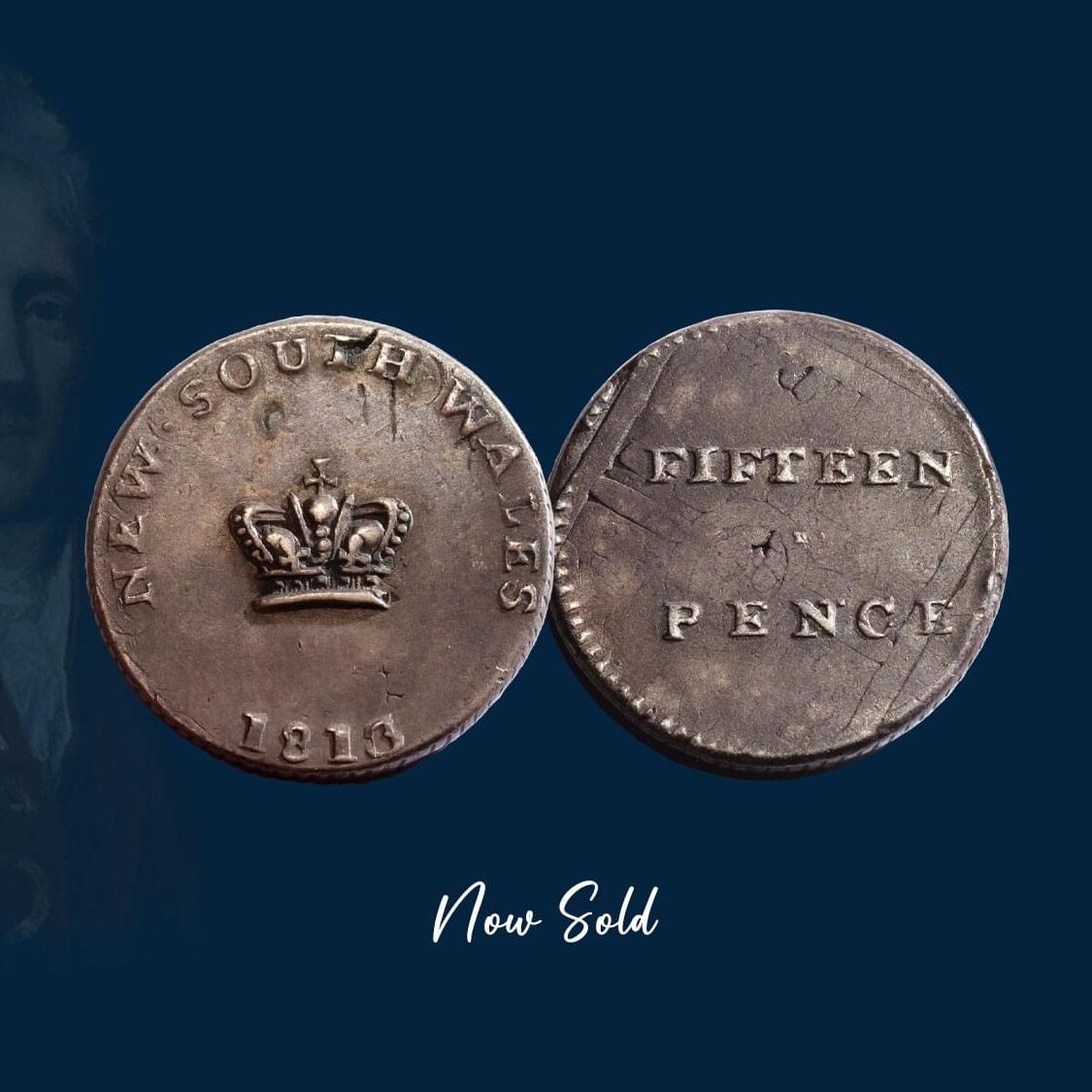
Lachlan Macquarie's initiative in creating our first currency reflected his Scottish culture, of being practical and resourceful. He created two coins, the Holey Dollar and the Dump, out of one coin. A single Spanish Silver Dollar. And while the Holey Dollar clearly shows that it was carved out from a Spanish dollar, sadly most Dumps don't reflect their origins and look as though they could have been minted from an ordinary blank silver disc. Not so with this 1813 Dump. The coin is a dynamic example of Australia’s first fifteen pence with extensive undertype on the reverse that confirms it was struck from a bust style Spanish Silver Dollar. Other quite extraordinary elements of this coin include the 'H' for Henshall (not normally present in D/2 Dumps) and the fullness of the legend and date (normally shallow in D/2 Dumps). Beautifully toned, highly reflective surfaces, pristine design detail ... this 1813 Dump was last sold in 2001 and is available now.
Click here for more details on this Product
The industry acknowledges that there are about one thousand surviving examples of the 1813 Dump, with eight hundred available to collectors, the balance held in museums and public institutions.
Within that collector pool, the Dump appears in four distinctly different die combinations or styles. The four combinations have been classified by respected collector and author Bill Mira as the type A/1, D/2, E/3 and C/4, the letter referring to the obverse die, the numeral representing the reverse die.
On the obverse, the different styles are reflected in the shape of the cross on the crown, the position of this cross in relation to the letters in the legend above it. And in the shapes and positioning of the row of five jewels in the band of the crown.
On the reverse, differences are found in the distances between the words 'FIFTEEN' and 'PENCE' and in the position of the 'T' in 'FIFTEEN' in relation to the 'N' in 'PENCE'.
Historians believe that the C/4 and E/3 dies were used to produce test pieces, presented to Governor Macquarie for approval before production began. While they are incredibly rare, the coins are crude and quite esoteric.
The A/1 and D/2 Dumps are viewed by collectors as 'mainstream' with the A/1 Dump the most frequently sighted (75% of examples). And the D/2, the rarer of the two (20% of examples).
Historians argue that the D/2 design types were most likely the first coins produced, since the majority of specimens reflect one major design fault. The legend and the date tend to be partially struck because the dies were too big for the blank. And the denticles (introduced as a security measure) are almost always absent.
This coin is an exceptional piece for it has design detail and shows a finesse in the striking that is not normally seen in the D/2 type. The legend and the date are contained in the coin.
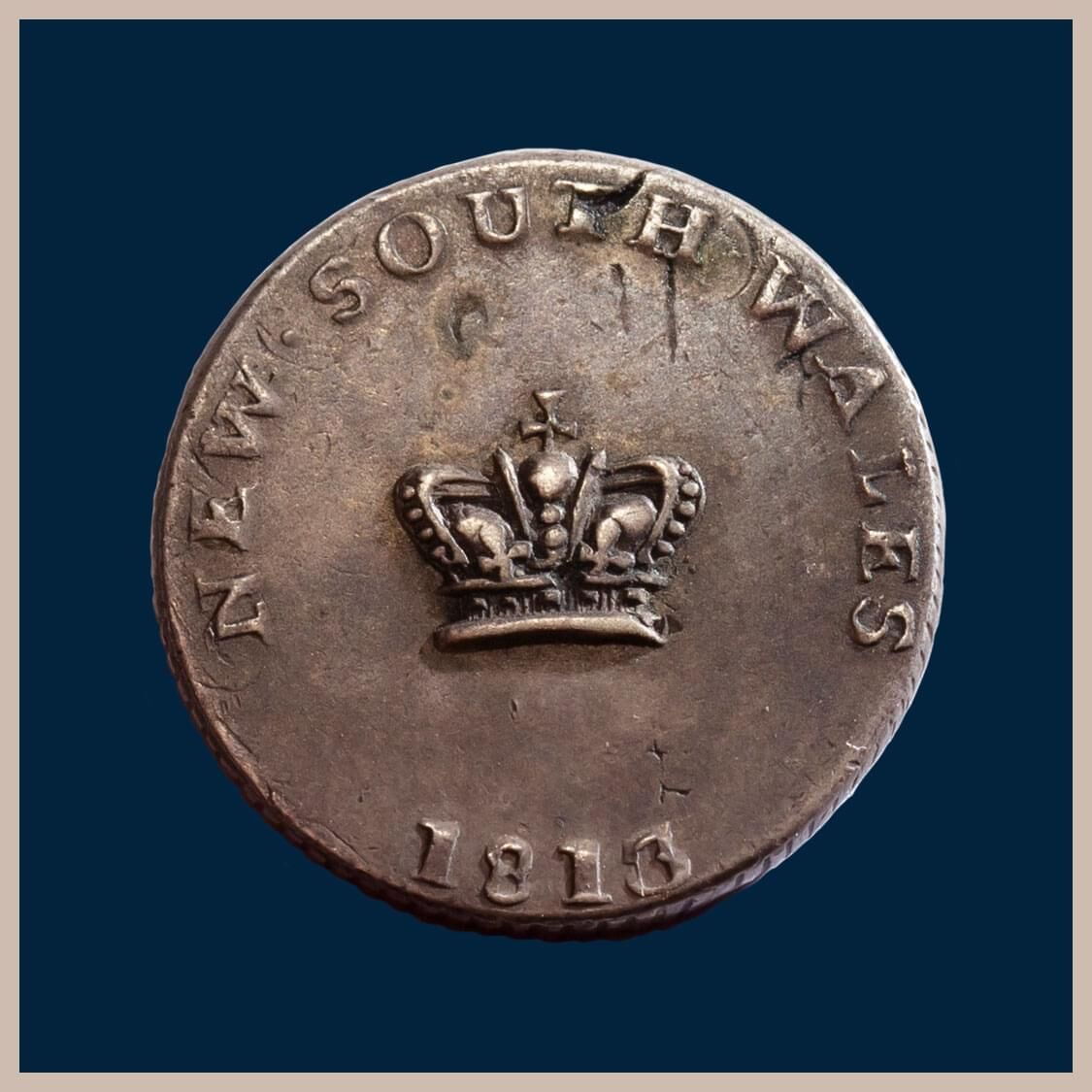
1813 Dump
struck using the D/2 dies
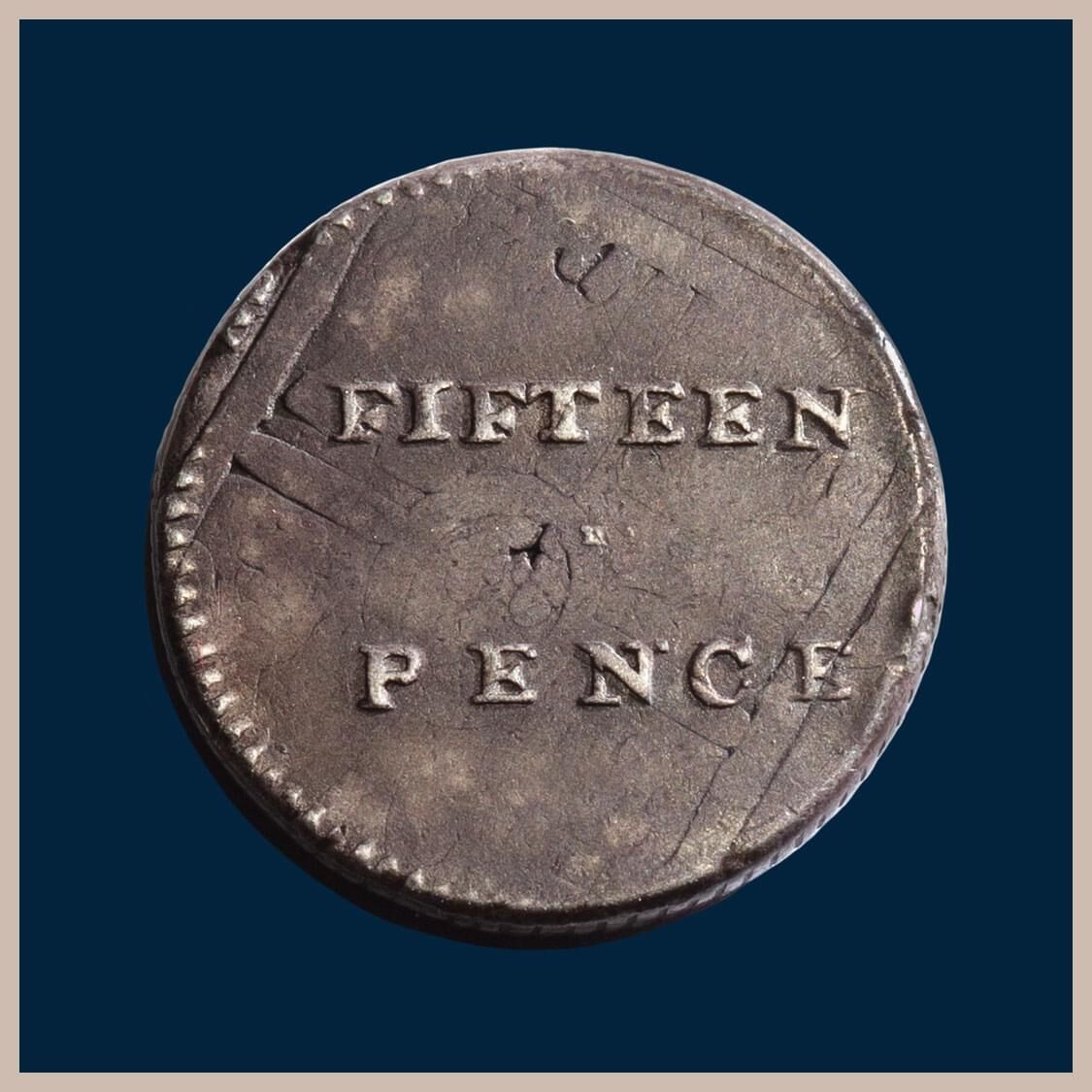
1813 Dump
struck using the D/2 dies
Lachlan Macquarie had high hopes for the Holey Dollar and Dump, and in particular the Dump. He stated that the Dump would fill the role of small change and would remove much of the need for promissory notes of low denominations.
As a coin intended as small change, the Dump circulated widely in the colony, the extreme wear on most examples evidence of their considerable use.
This 1813 Dump with a quality level of Extremely Fine, is amongst the top ten D/2s and one of the finest known of all design types. In the hand the coin is impressive, the fields are highly reflective with grey toning.
There is no doubt that heat was involved in the creation of the Dump. When the disc fell out of the centre of the Spanish Dollar, it still bore the original dollar design of a four quadrant shield, depicting a lion and castle in each quadrant. High temperatures obliterated the original Spanish Dollar design from most Dumps.
This Dump has extensive evidence of the original Spanish Dollar design on the reverse, that evidence includes the cross-bars of the shield and the lion's tail and the castle. Amazing!
Convicted forger and emancipist, William Henshall, was hired to create the nation's first currency, effectively our first Mint Master. He declared his involvement in the creation of the Dump by inserting his initial, an 'H' for Henshall, on some - but not all - of the reverse dies of the Dump.
The 'H' for Henshall is rarely ever seen on D/2 Dumps. And on the reverse of this coin it is plump and three-dimensional.
There is more in store for the buyer when when you take this coin under an eye glass. Two other outstanding attributes are noted.
The extreme left and right edge of the horizontal cross on the orb at the top of the crown is evident. Most collectors would not even be aware that, as with the 1852 Adelaide Pound, the Dump design includes a cross on the orb at the top of the crown.
And there is a 'stop' in the legend 'NEW SOUTH WALES' after 'NEW' and after 'SOUTH'. The dies would have had shallow depressions to create the stops and must have quickly filled with debris for they can be difficult - or impossible - to discern on even the best of D/2 examples.
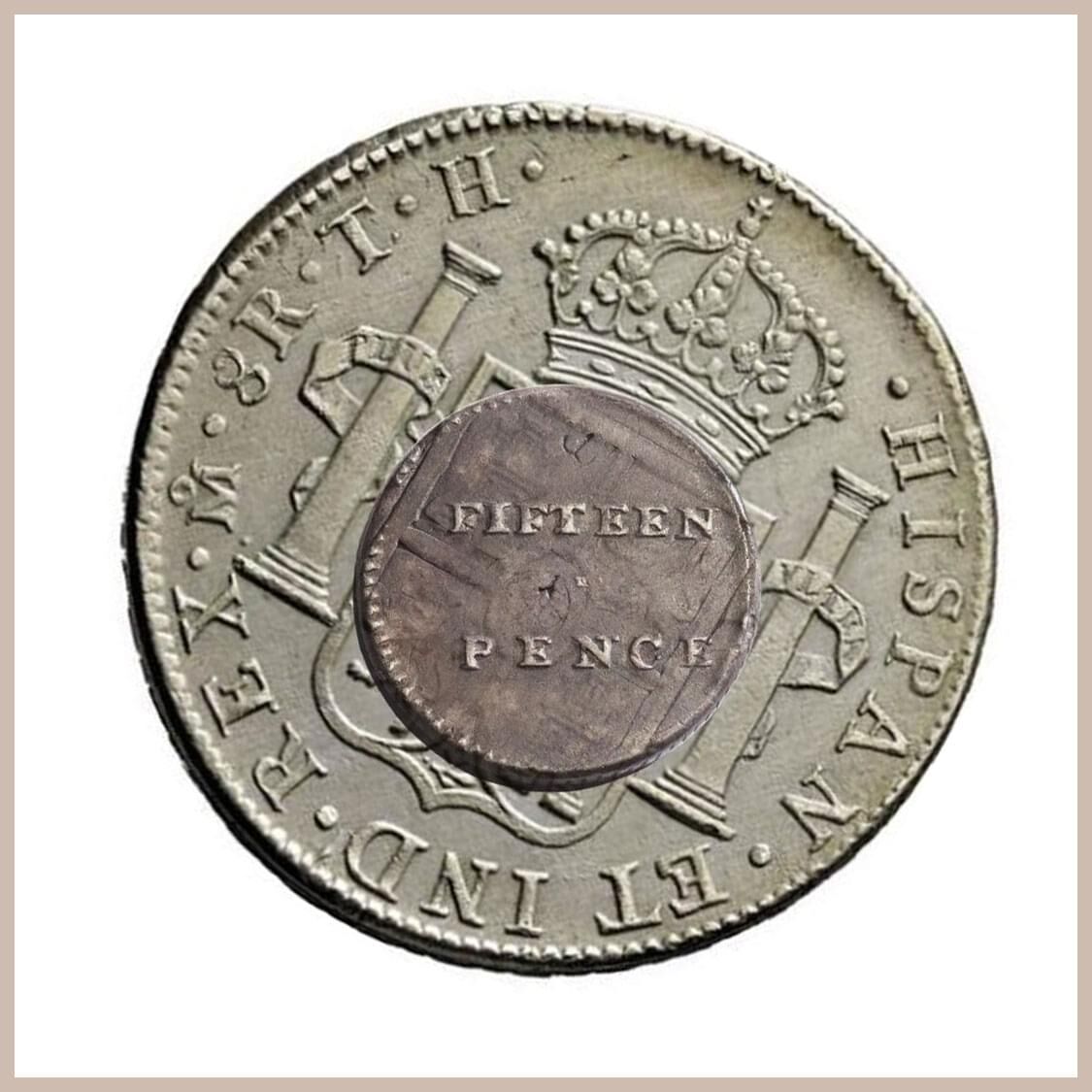
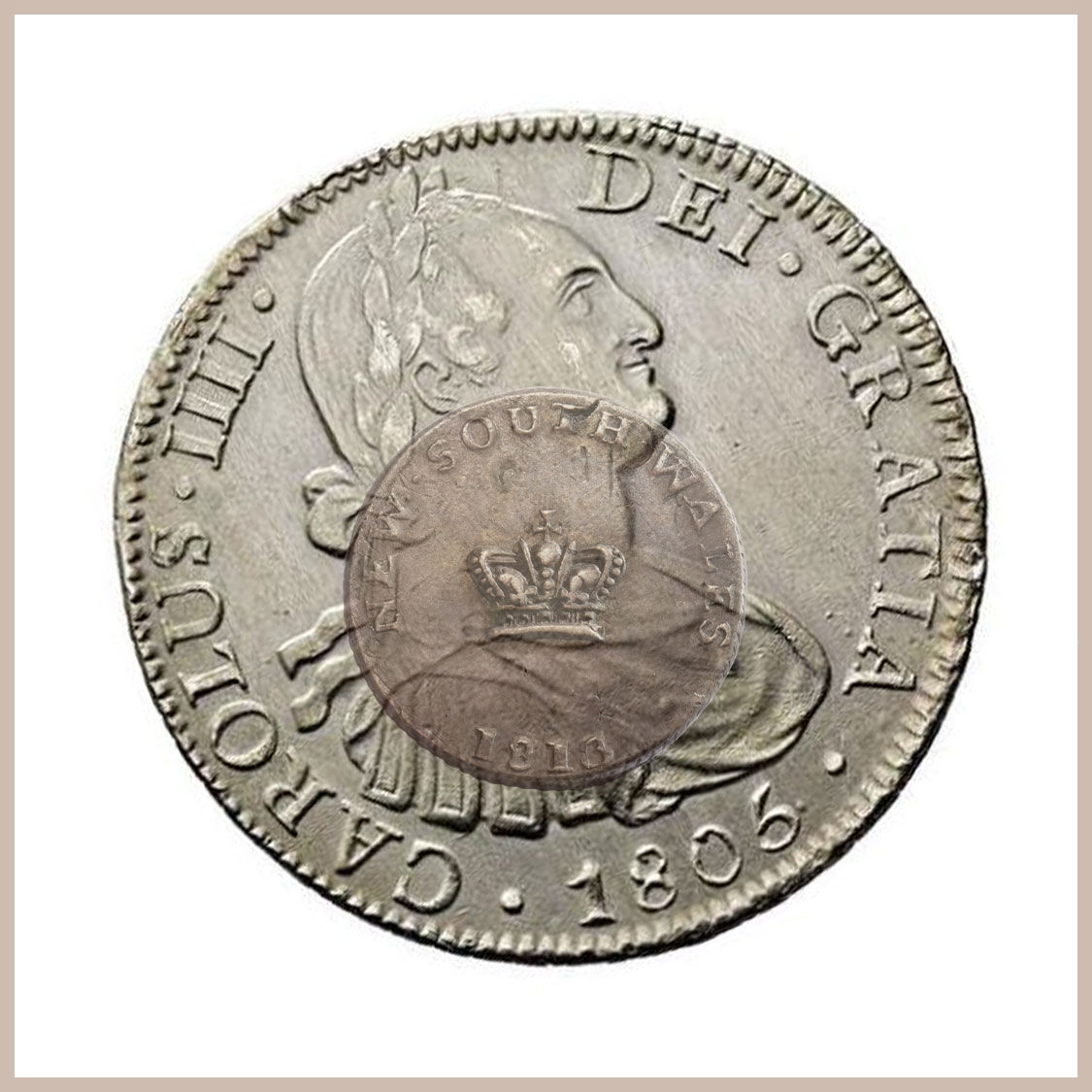
1813 Dump struck from the rare D/2 dies
$75,000
Lachlan Macquarie's initiative in creating our first currency reflected his Scottish culture, of being practical and resourceful. He created two coins, the Holey Dollar and the Dump, out of one coin. A single Spanish Silver Dollar.
And while the Holey Dollar clearly shows that it was carved out from a Spanish dollar, sadly most Dumps don't and look as though they could have been struck from an ordinary blank silver disc.
Not so with this 1813 Dump.
The coin is a dynamic example of Australia’s first fifteen pence and clearly reflects its origins with strong undertype on the reverse that confirms it was struck from a bust style Spanish Silver Dollar.
Other quite extraordinary elements of this coin include the 'H' for Henshall (not normally present in D/2 Dumps) and the fullness of the legend and date (normally shallow in D/2 Dumps).
Beautifully toned, highly reflective surfaces, pristine design detail.
Highlights of our Inventory
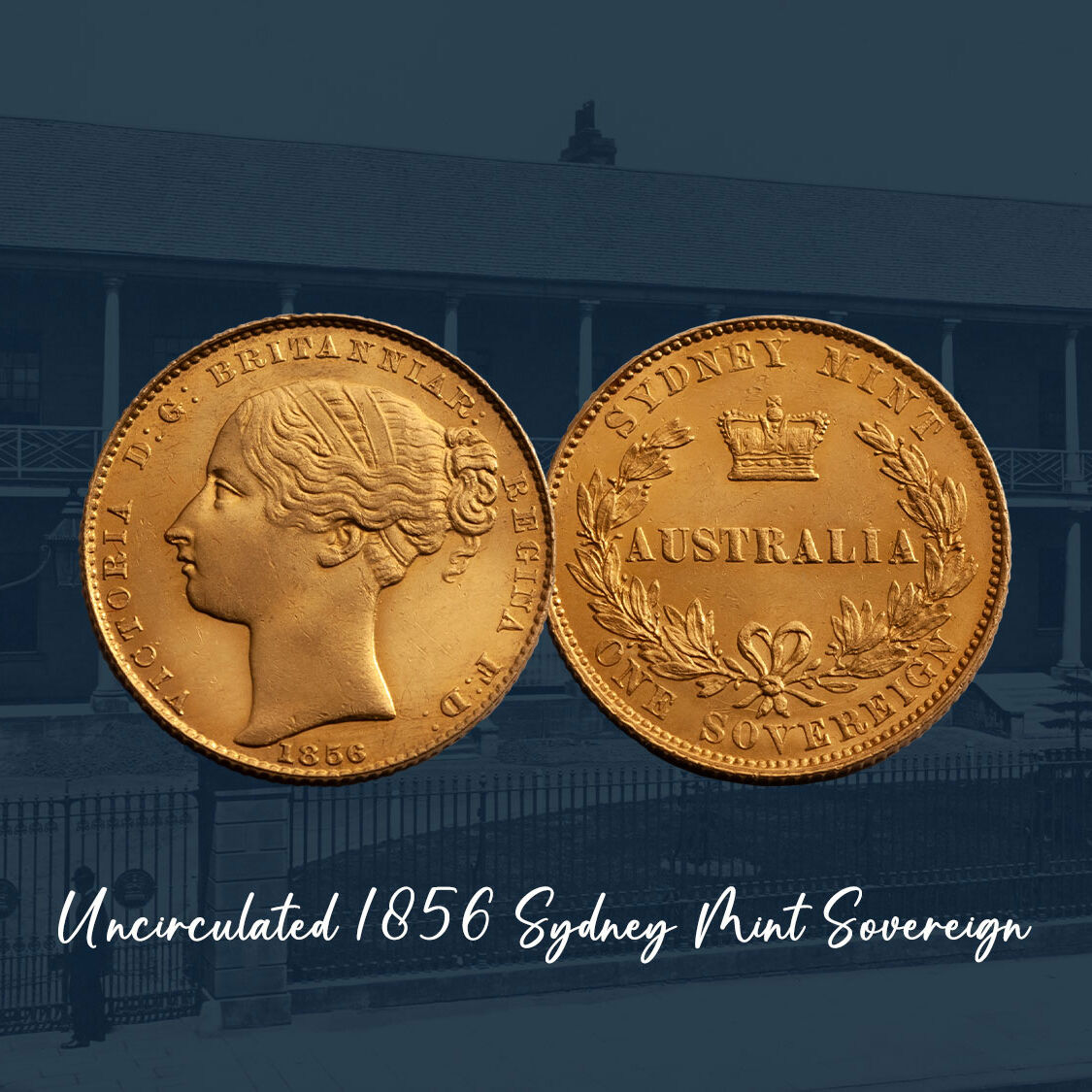
In its second year of production, 1856, the Sydney Mint almost doubled its output of sovereigns. The recorded mintage in 1855 is 502,000 sovereigns, that of 1856 is 981,000. Based on these figures one might expect that the 1856 Sovereign would be easier to procure than the 1855. But it is not. We comment that while we have sold several top quality 1855s, this is the only Uncirculated 1856 Sydney Mint Sovereign we have sold. And we checked back at some of the most famous gold coin auctions held over the past fifty years comparing the quality of the 1855 and 1856 Sovereign. Auctions such as Spink Auctions Sharps Pixley Collection in 1989, Monetarium’s Quartermaster Collection in 2009, Baldwins London Bentley Collection in 2012 and St James London George Collection in 2014. Whereas the 1855 Sydney Mint Sovereign was offered as high as Choice Uncirculated, the top grading level of the 1856 Sydney Mint Sovereign was Uncirculated, equivalent to the coin offered here. It's quite Illuminating when you consider the almost unlimited resources involved in putting together these four collections, both physically and financially.
Click here for more details on this Product
When it comes to collecting vintage gold coins, collectors have two distinct options.
Collectors can acquire coins that were struck for circulation. Circulating coins were mass produced, hurled down a shute and into a barrel to be delivered to the banks, the mintages determined by Government and generally in the hundreds of thousands, if not millions.
Collectors can also collect coins that were struck as Coins of Record. Using standards and techniques far beyond that required for circulating currency, Coins of Record were minted to a proof or specimen finish and because the process was time-intensive, mintages were generally less than ten.
Each option, circulating currency or Coins of Record, presents the buyer with a vastly different sized pool of examples from which to choose. And very different challenges for procurement.
Average circulating gold sovereigns struck in years that have no special importance are generally readily available.
Once a buyer sets parameters on the quality and the dates being sought, the pool of specimens narrows and it is true that acquiring a key date gold coin that was struck for circulation, particularly one in premium quality, can be a journey in time that involves years.
This 1856 Sovereign is a key-date coin, the second year of operation of the nation's first mint. And the quality, Uncirculated.
History shows us that it could be five to ten years before a comparable example surfaces.
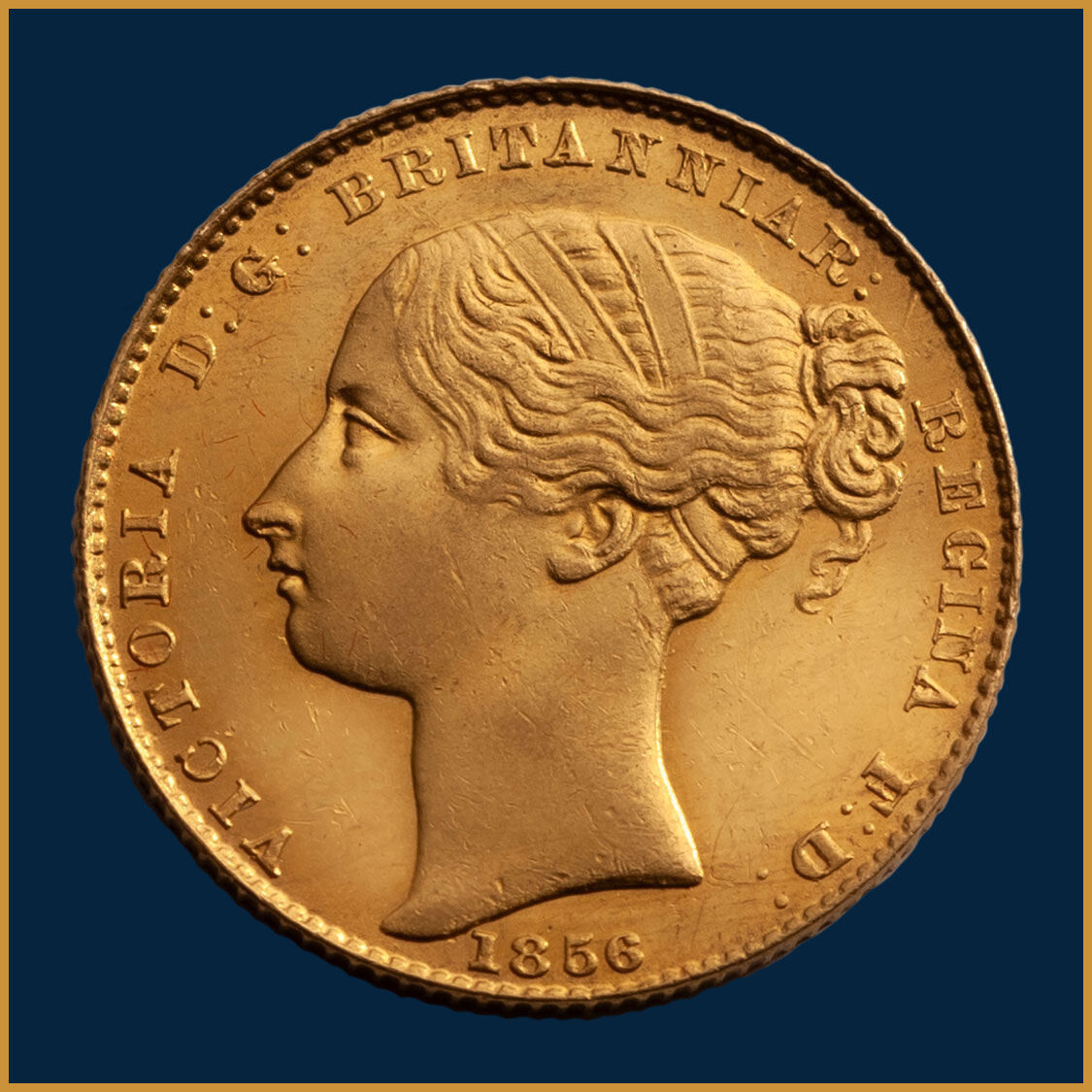
1856 Sydney Mint Sovereign
Uncirculated
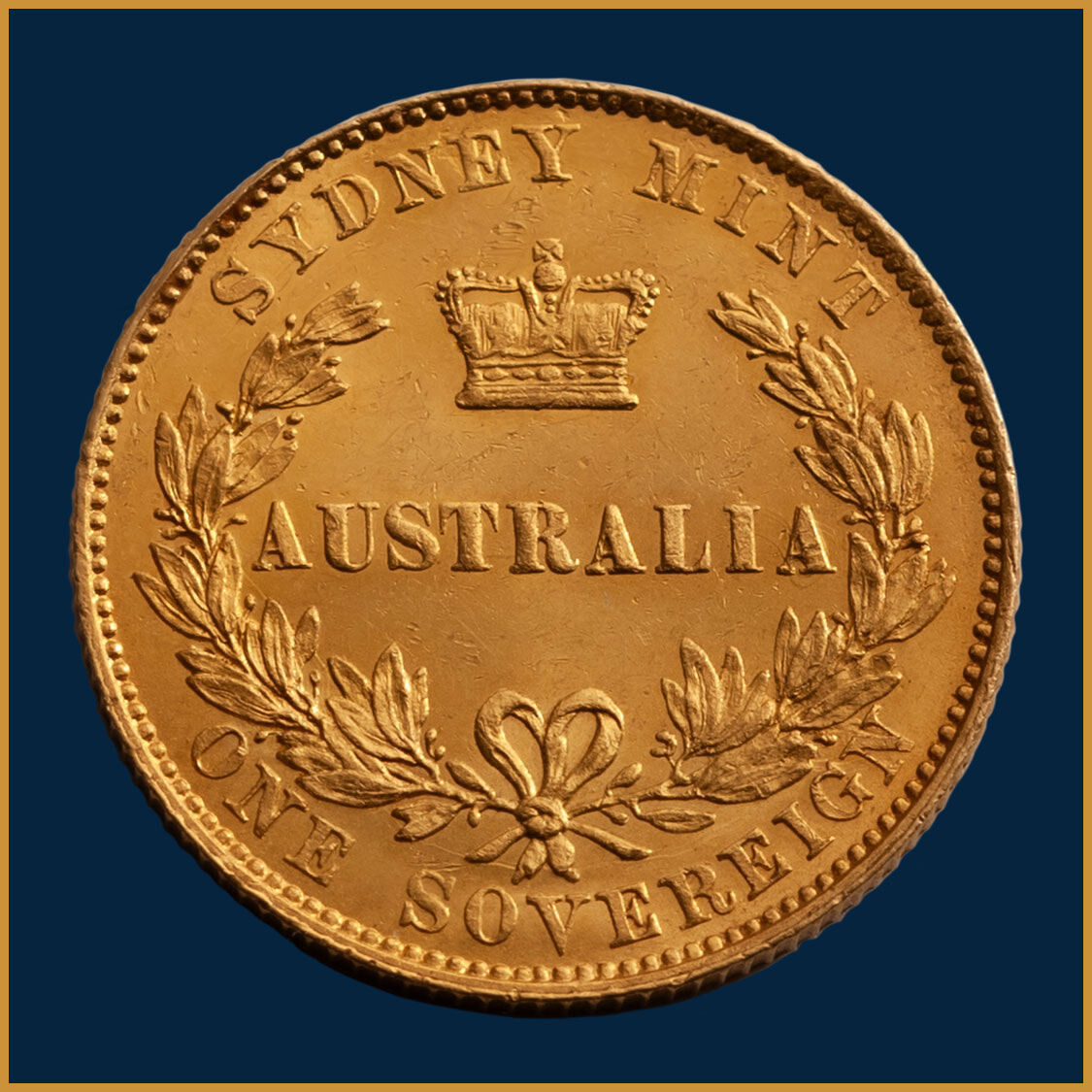
1856 Sydney Mint Sovereign
Uncirculated
The Sydney Mint was established in a wing of the 'Rum Hospital' in Macquarie Street, Sydney.
The mint began receiving gold on 14 May 1855 and issued its first gold sovereign soon after on June 23. A total of 502,000 sovereigns were issued in 1855 and 981,000 the following year.
Both coins share the same reverse design. And the same obverse design of a young Queen Victoria with a braid in her hair, referred to as the Type I portrait design.
The Type I design only lasted for two years, and was replaced in 1857, making the 1855 and 1856 Sydney Mint Sovereigns keenly sought.
Based on the mintages of 502,000 and 981,000, the 1855 Sydney Mint Sovereign should be twice as difficult to find. But that is simply not the case.
Both the 1855 and the 1856 Sovereign are equally difficult to find in any quality, and particularly challenging to find an 1856 sovereign in top quality.
We looked at some of the famous gold coin auctions and compared their offering of the 1855 Sydney Mint Sovereign and the 1856 counterpart. With an acknowledgement of the almost unlimited resources involved in putting together these collections, both physically and financially.
The 1856 Sovereign posed the greatest challenge.
• The Quartermaster auction in 2009 offered a Choice Uncirculated 1855 and an Uncirculated 1856. We further note that the Quartermaster 1855 and 1856 sovereigns had been formerly owned by Robert Jaggard and Paul Terry, both collectors having advanced gold coin collections and unlimited resources to acquire the very best.
• The famous Sharps Pixley Auction conducted by Spink Auctions in Sydney 1989 offered a Choice Uncirculated 1855 Sovereign with full mint bloom, yet only a circulated 1856 Sovereign, graded Extremely Fine.
• The Bentley Collection in London 2012, offered an 1855 sovereign similar in quality to the Quartermaster example, and a circulated 1856, Extremely Fine.
• The sale of the George Collection conducted by St James Auction in London in 2014, offered the Sharps Pixley Choice Uncirculated 1855 Sovereign and again an Extremely Fine 1856 Sovereign.
Conclusion? This Uncirculated 1856 Sydney Mint Sovereign is a profound opportunity for the Sovereign collector.
Uncirculated 1856 Sydney Mint Sovereign
$85,000
The only 1856 Sovereign we have handled at this quality level.
We checked back at some of the most famous gold coin auctions held over the past fifty years comparing the quality of the 1855 and 1856 Sovereign.
Auctions such as Spink Auctions Sharpes Pixley Collection in 1989, Monetarium’s Quartermaster Collection in 2009, Baldwins London Bentley Collection in 2012 and St James Auction London George Collection in 2014.
Whereas the 1855 Sydney Mint Sovereign was offered as high as Choice Uncirculated, the top grading level of the 1856 Sydney Mint Sovereign was Uncirculated, equivalent to the coin offered here.
Its quite Illuminating when you consider the almost unlimited resources involved in putting together these four collections, both physically and financially. And the names associated with these collections, that had access to the very best, Bob Jaggard, Paul Terry, Barrie Winsor.
In 1851, the Sydney Morning Herald published an editorial championing the establishment of a branch of the Royal Mint in Sydney to buy gold at full price and strike it into sovereigns.
The plan for a branch of the Royal Mint received great support from the diggers. Solid opposition came from the banks and a prominent group of private individuals both of whom had become major buyers of gold on the fields at prices discounted well below the full London price. Profits were at stake! Both factions had earlier joined forces to quash a proposal for a Sydney Assay Office that would have also impacted negatively on their commercial interests.
While it is true that New South Wales had in 1851 formally petitioned the home office in London for a branch of the Royal Mint, the decision had already been made in the British Parliament to give the colonies greater autonomy and establish a branch mint to allow them to strike coins of the realm, the sovereign.
The Sydney Mint would strike sovereigns and half sovereigns to exactly the weight and fineness levels at the Royal Mint but they would have their own design. This was to protect the international reputation of the imperial gold coins in the event that Sydney was unable to meet the exacting standards demanded of the coin.
On the 19 August 1853 Queen Victoria gave formal approval to establish Australia’s very first mint at or near Sydney in New South Wales. In the same year, the Royal Mint London prepared designs of Australia’s first gold coinage and manufactured the dies.
The sovereign and half sovereign obverse design was a filleted bust of Victoria, only slightly different to that used on British sovereigns. The obverse quickly fell out of favour and James Wyon was ordered to engrave a new obverse that would be uniquely Australian to easily distinguish the colonial sovereigns from their British counterparts. To this end, a new portrait was introduced in 1857 that featured Queen Victoria with a banksia wreath in her hair instead of the band.
The reverse design was based loosely around contemporary reverse designs of the British sixpence and shilling. Its strong point of difference to the British sovereigns was the inclusion of the words 'Australia' and 'Sydney Mint'.
The use of the word Australia, a fascination with historians. At the time the nation was operating as separate colonies. Australia did not operate under a single Government until Federation in 1901.
The first Deputy Master of the Sydney Mint was Captain Edward Wolstenholme Ward, a trained member of the Royal Engineers. (Photo shown at top.)
Ward arrived in the colony in October 1854 on the ship Calcutta, along with other members of the Royal Engineers, a sergeant, three corporals and twelve privates. The group was deposited on Circular Quay with the bales and boxes of Sydney's new mint, along with the dies.
The Sydney Mint was established in a wing of the 'Rum Hospital' in Macquarie Street, Sydney. The mint began receiving gold on 14 May 1855 and issued its first gold sovereign soon after on June 23.
In their infancy the Sydney Mint sovereigns and half sovereigns were legal tender only in the colony of New South Wales.
In January 1856, the British tested the quality of the colonial gold coins and the results showed that they had a higher intrinsic value than their British counterparts, primarily due to their 8.33% silver content. Once these facts became known, profiteers began melting them down.
The colonial gold coins also became legal tender in Tasmania and Western Australia in 1856. South Australia and Victoria were reticent to enshrine the Sydney Mint as Australia's official mint as each colony had independently requested their own and were miffed at missing out.
By 1857, the legal tender scope was widened to include all Australian colonies and Mauritius, Ceylon and Hong Kong. In 1868 the Sydney Mint Sovereigns and Half Sovereigns became legal tender throughout the British Empire.
The design of the Sydney Mint Sovereign lasted until 1870 and was the only time the word Australia appeared on our gold sovereigns. From 1871, Australia's sovereigns took on a traditional British design.
Highlights of our Inventory
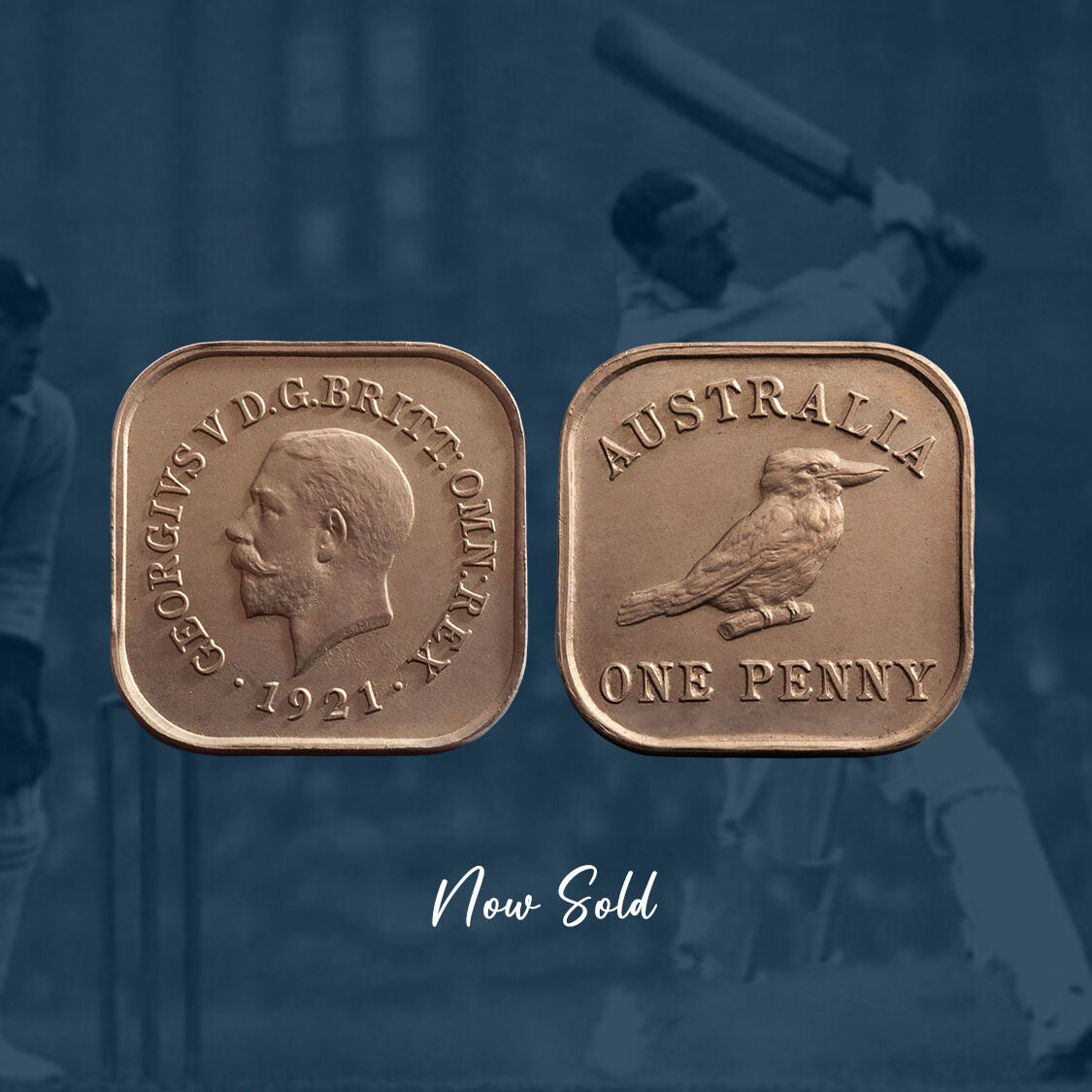
This Kookaburra Square Penny was struck in 1921 and is designated as a design Type 12. The obverse portrait was created by Australian sculptor and medallist, Bertram Mackennal. The reverse design features a plump kookaburra resting on a branch. The coin shares the same obverse and reverse design as the Kookaburra Square Halfpenny, also struck in 1921 and designated, the design type 2. The provenance is impeccable, ex Earl of Stradbroke Collection, sold by Barrie Winsor to Coinworks in 1996. The quality, also impeccable (particularly for the design type 12), is Choice Uncirculated.
Click here for more details on this Product
We have had the privilege of putting together a complete collection of Kookaburra Square Pennies and Square Halfpennies for a client, type 1 through to type 12. The addition of the Sterling Silver Kookaburra Square Penny, took the collection to thirteen coins.
The collection is unique. And took nearly a decade to complete, the journey finishing in 1999.
While it is true that several years elapsed before some of the rarer pieces came onto the market. It is also true that coins such as the Type 12 presented challenges, simply on the basis of quality.
When you view the collection en masse, it is obvious that the Melbourne Mint was not only experimenting with different designs, but different finishes.
Some of the types are quite proof-like. Others such as the type 12 are subdued and satiny and for whatever reason, prone to harsh toning.
In our experience, a Kookaburra Square Penny, design type 12, is an extremely difficult coin to acquire once you impose high quality standards.
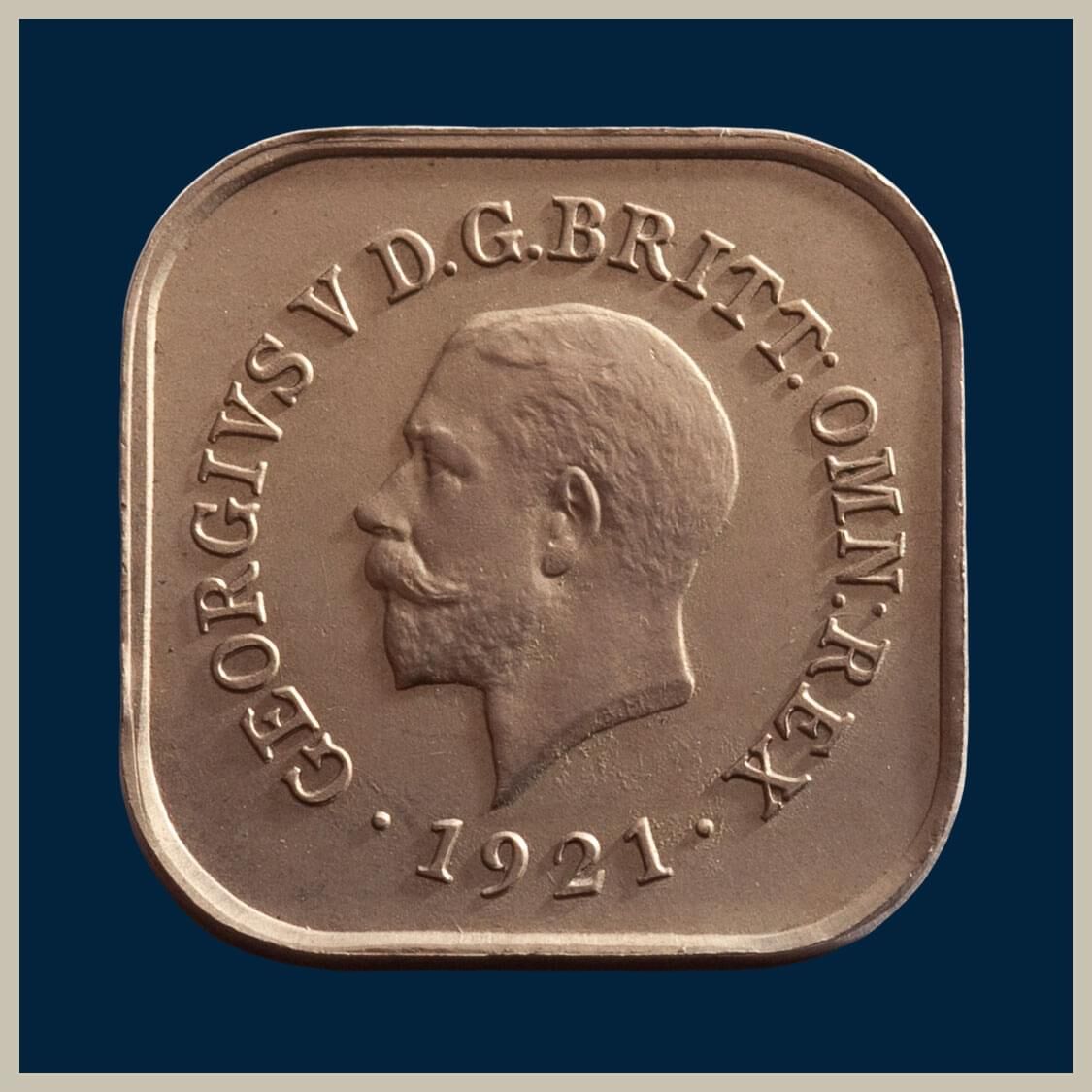
1921 Kookaburra Square Penny
design type 12
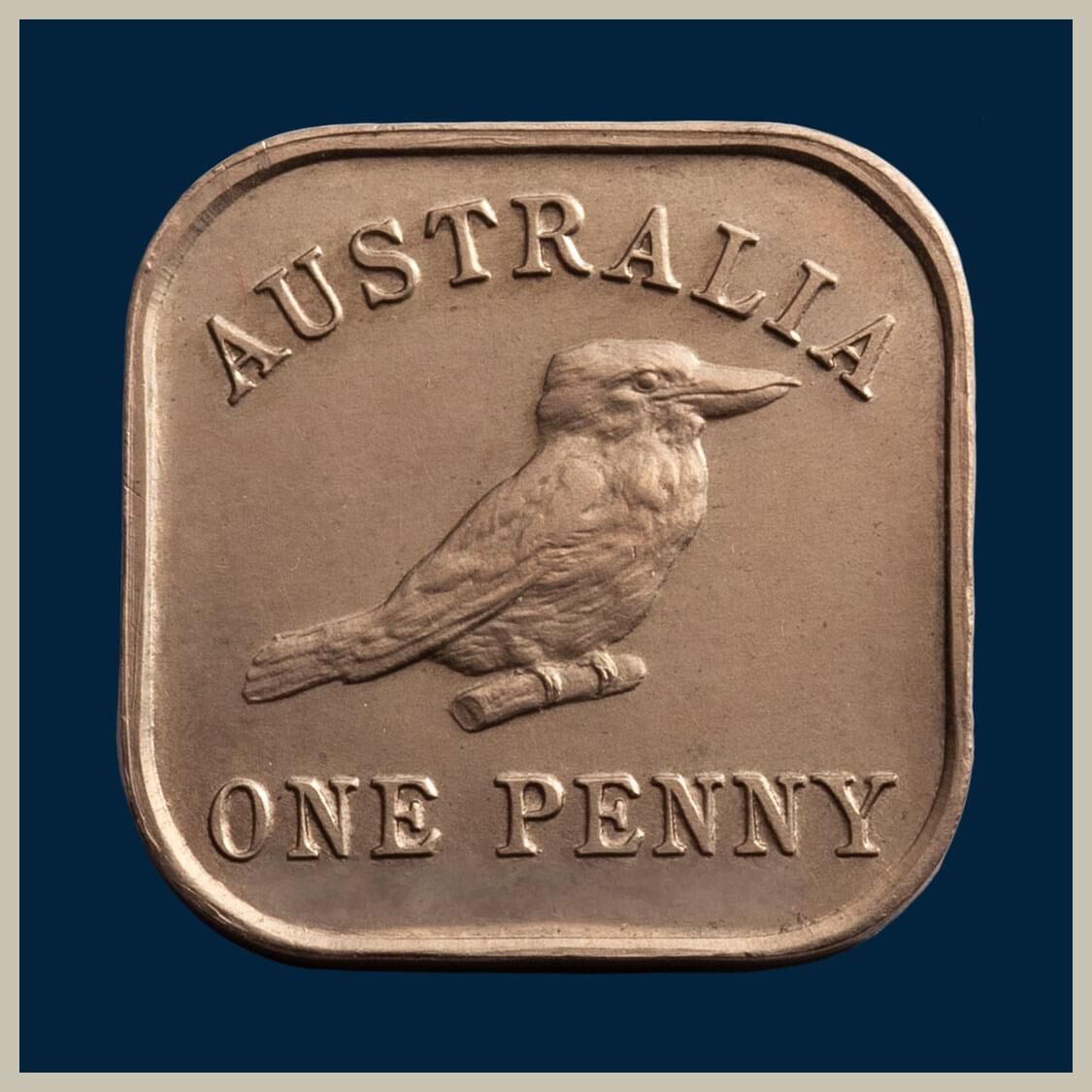
1921 Kookaburra Square Penny
design type 12
This coin has a pale grey hue from minor toning, the surfaces enhanced by underlying brilliance on both obverse and reverse, as commented in the description above.
You will also note we comment on the edges, that they are well executed.
The Square Pennies were test pieces and were not struck to the exacting standards of proof coining and this is particularly noticeable in the edges which very often are not uniformly struck all the way around.
Given to dignitaries to assess their reaction, there was no packaging and we know that not every dignitary was a collector and would have handled them with care.
Some of the coins must have been tucked into a fob pocket for they have circulated. Others could have rattled around a top desk drawer. Or passed around to colleagues … introducing multi possibilities of mishandling.
A Square Penny with minimal, attractive toning and beautiful surfaces is a joy to behold. And a prized classic Australian coin rarity.
1921 Kookaburra Square Penny, design type 12
Choice Uncirculated
Price: $30,000
This Kookaburra Square Penny was struck in 1921 and is designated as a design Type 12. The obverse portrait was designed by Australian sculptor and medallist, Bertram Mackennal.
The reverse design features a plump kookaburra resting on a branch. The coin shares the same obverse and reverse design as the Kookaburra Square Halfpenny, also struck in 1921 and designated as a design type 2.
The provenance is impeccable, ex Earl of Stradbroke Collection, sold by Barrie Winsor to Coinworks in 1996.
The quality, also impeccable (particularly for this design type), is Choice Uncirculated.
Australia entered a modern age post World War I and for many Australians, it was a time for breaking out, of questioning and changing old values and behaviour and enjoying the good life.
It was a time of great change. People forgot the old and embraced the new in an attempt to leave the hardship and struggles of the war behind them.
New technology was being created, like toasters and cars, things that today we take for granted. The fashion world was exploding, Australians embracing great change in their styles of dress.
Australians were identifying with their own culture, keen to lessen the emotional and cultural ties with Great Britain.
Creating a new, totally Australian coinage was a part of the deal which is why the Government floated the idea of the Kookaburra Penny and Kookaburra Halfpenny envisaging a coin that would be unique to Australia.
The Government's plan was to discard the British-styled penny and halfpenny and to create a coin with a typically Australian design featuring the nation's native bird, the kookaburra. To maximise impact, a new shape was planned with the move from circular to square. And bronze was to be discarded and a new metal taken up, that of cupro-nickel.
Tests began at the Melbourne Mint in 1919 and continued for three years. Sadly, in 1921 the scheme fell apart. The response to Australia’s square coinage was poor with widespread public resistance to change and people generally rejecting the small size of the coins.
However, the final decision not to proceed seems to have been based mainly on another consideration – the large number of vending machines then in operation requiring a circular coin.
The Kookaburra Pennies and Halfpennies that remain today are relics of our past, and the sentiment that they stir up in the current market is collector sentiment, driven by their novel shape. And with only 200 pennies and about 12 halfpennies believed to exist, collector thirst is driven by their extreme rarity.
And the best thing for collectors is that the 200-plus kookaburra coins do not bear the same design.
Overall, the Melbourne Mint tested thirteen different styles introducing enormous interest, personal choice and procurement challenges into the series, for some designs are far rarer than others.
Highlights of our Inventory
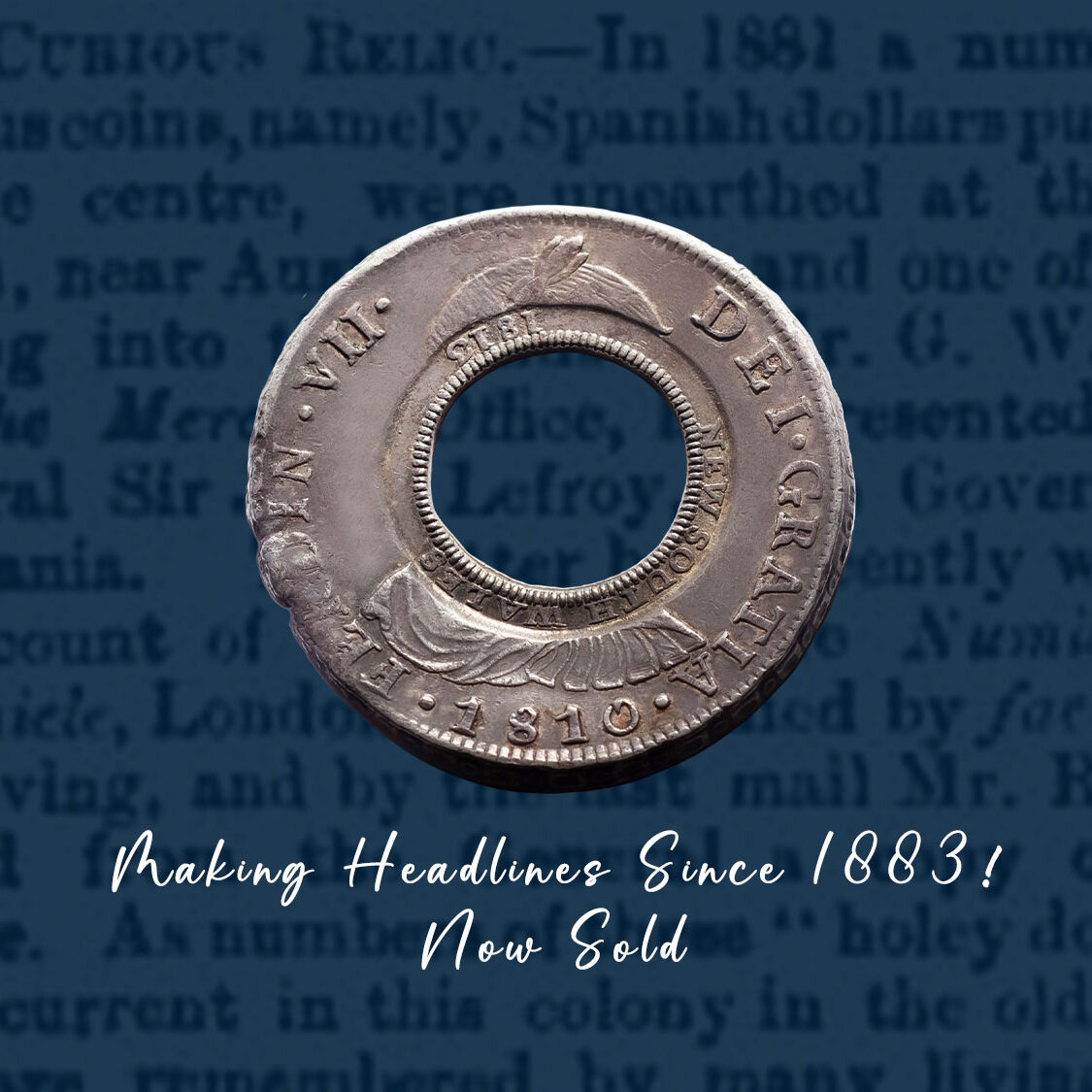
The Hannibal Head Holey Dollar is the coin for the buyer aspiring to the best. A buyer that respects quality and recognises the importance of a documented provenance, today and into the future. A buyer that will enjoy the history of a coin that has been making media headlines, both in Australia and in Britain since 1883, nearly a century-and-a half ago! No other Holey Dollar can match this coin for its fame. And its level of public recognition.
Every coin tells a story and this Holey Dollar, the famous 'Hannibal Head' Holey Dollar, surpasses all others for its story-telling. It was struck from a Spanish Silver Dollar that was especially designed and minted to protest the ascension to the throne of Joseph Bonaparte and is one of two known, this being the finest. The coin was discovered in 1881, near Hobart, and presented to Sir John Henry Lefroy, Governor of Van Diemen’s Land. Of the three hundred surviving Holey Dollars, the Hannibal Head Holey Dollar has the highest public profile. And a much publicised, documented pedigree. Its discovery was written up in Hobart's Mercury Newspaper in 1883 and the Sydney Morning Herald in 1884. But its greatest claim to fame is that a pencil drawing, published in the London Numismatic Chronicle of 1883, is the earliest known drawing of Australia's first coinage. This is an historic offering of an important Holey Dollar, a coin that plays a pivotal role in Australia's Holey Dollar story. A coin that has also been the highlight of two exhibitions, at the Macquarie Bank in 2013 and the Royal Australian Mint Canberra in 2019.
Click here for more details on this Product
Forty thousand Spanish Silver Dollars were imported by Governor Lachlan Macquarie in 1812 from the East India Company, the coin to be converted into forty thousand Holey Dollars, the nation's first circulating currency.
The order for the dollars was not date specific, any date would suffice. Ferdinand VI reigned from 1746 to 1759. Charles III, 1759 to 1788. Charles IV was the reigning monarch from 1788 to 1808 and Ferdinand VII endured a disrupted reign, 1808 and again between 1814 and 1833.
And as each king ascended the throne, the design of the dollar was re-created with a re-styled legend and a re-styled portrait to record the new, reigning monarch.
Holey Dollars are classified into types based on the legend and portrait of the monarch depicted on the original Spanish Silver Dollar.
There are eight distinct types of Holey Dollars, the most readily available type (Type 5) offering collectors a pool of one hundred and twenty-nine Holey Dollars, each coin depicting the legend and portrait of King Charles IV of Spain.
The Hannibal Head Holey Dollar is one of the rarest types (Type 8), and features the legend of the exiled Ferdinand VII and an imaginary portrait of the monarch, referred to as the Hannibal Head.
Only two examples are available to collectors, this being the finest by far.
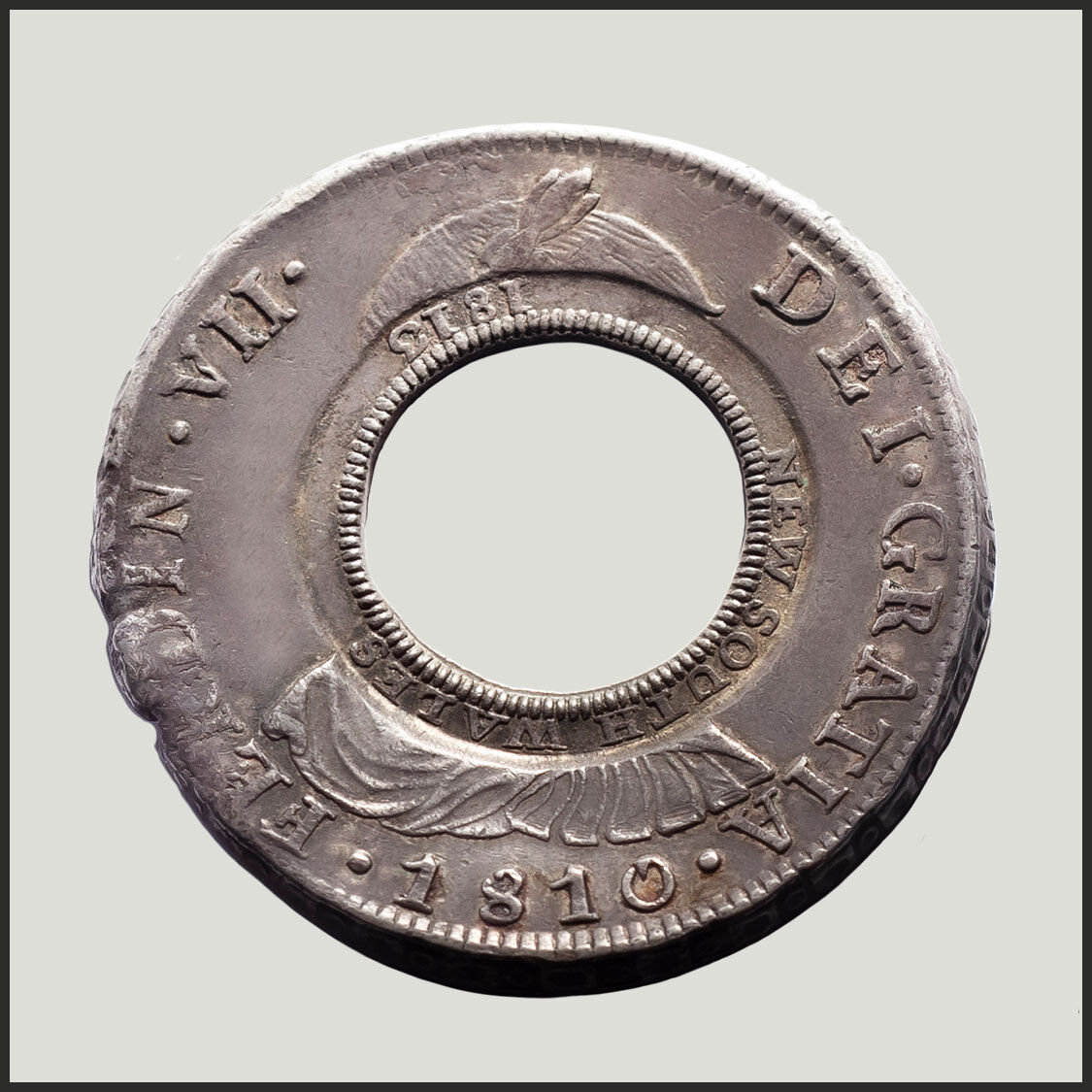
The Hannibal Head
Holey Dollar
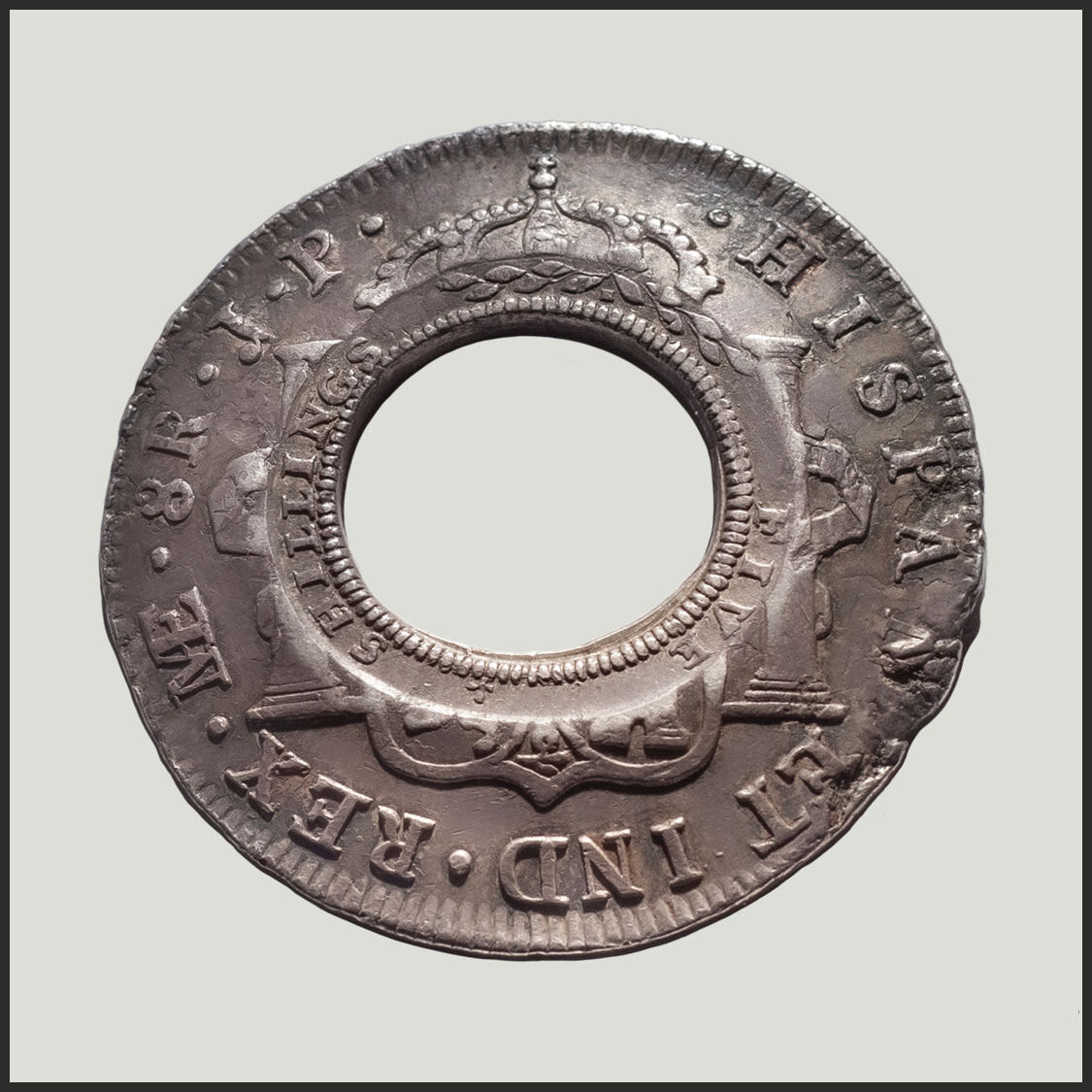
The Hannibal Head
Holey Dollar
The ceding of the Spanish throne to Napoleon Bonaparte's brother, Joseph Bonaparte, became the catalyst for issuing a new silver coinage at the Lima Mint, an event that underpins the numismatic superstar status of the Hannibal Head Holey Dollar.
Napoleon Bonaparte emerged as the strongman of Europe in 1799 leading his armies across Europe deposing monarchs and dominating the entire continent.
At the time Spain was ruled by King Charles IV, an ally of France.
In 1807, Bonaparte’s armies marched through Spain and invaded Portugal. The Spanish monarchy co-operating because it had hoped to secure Southern Portugal for itself.
The alliance between France under Bonaparte and Spain under Charles IV disintegrated the following year when on February 16, 1808, under the pretext of sending reinforcements to the French army occupying Portugal, the French invaded northern Spain.
In March 1808, Napoleon Bonaparte pressured King Charles IV to abdicate the Spanish throne to his son Ferdinand VII. Ferdinand's reign was short and lasted less than two months. Napoleon Bonaparte duped both Charles IV and Ferdinand VII into ceding the Spanish throne to Bonaparte’s older brother Joseph who assumed rule of the Spanish kingdom on 6 June 1808.
And while the upper echelons of the Spanish Government accepted Ferdinand's abdication and Napoleon's choice of Joseph as King of Spain, the Spanish people did not and uprisings broke out throughout the country.
The Spanish colonial mint of Lima refused to acknowledge Bonaparte as the Spanish King and embarked upon a numismatic protest by continuing to strike their silver dollars with the legend of the imprisoned Ferdinand VII.
Taking their protest one step further, the mint refused to depict Bonaparte's portrait on their coinage, instead using an ‘imaginary’ effigy said to be extremely unflattering! The portrait is universally referred to as the ‘Hannibal Head’ portrait.
The Hannibal Head Holey Dollar (Type 8)
The Hannibal Head Holey Dollar was struck from a Spanish silver dollar minted in 1810 at the Lima Mint, Peru. And features the legend of Ferdinand VII and an imaginary portrait of the reigning monarch.
The Holey Dollar tells a story, and in the context of its story, the Hannibal Head Holey Dollar surpasses all others. The Spanish Silver Dollar from which it was created was especially designed and minted to protest the ascension to the throne of Joseph Bonaparte. The coin is one of two known, this being the finest.
Price $550,000
The Hannibal Head Holey Dollar is the coin for the buyer aspiring to the best.
A buyer that respects quality and recognises the importance of a documented provenance, today and into the future.
A buyer that will enjoy the history of a coin that has been making media headlines, both in Australia and in London since 1883, nearly a century-and-a half ago! No other Holey Dollar can match this coin for its fame. And its level of public recognition.
This is an historic offering of an important Holey Dollar, a coin that plays a pivotal role in Australia's Holey Dollar story. A coin that has also been the highlight of two exhibitions, at the Macquarie Bank in 2013 and the Royal Australian Mint Canberra in 2019.
Mercury Newspaper Hobart Tasmania
Saturday 17 November, 1883
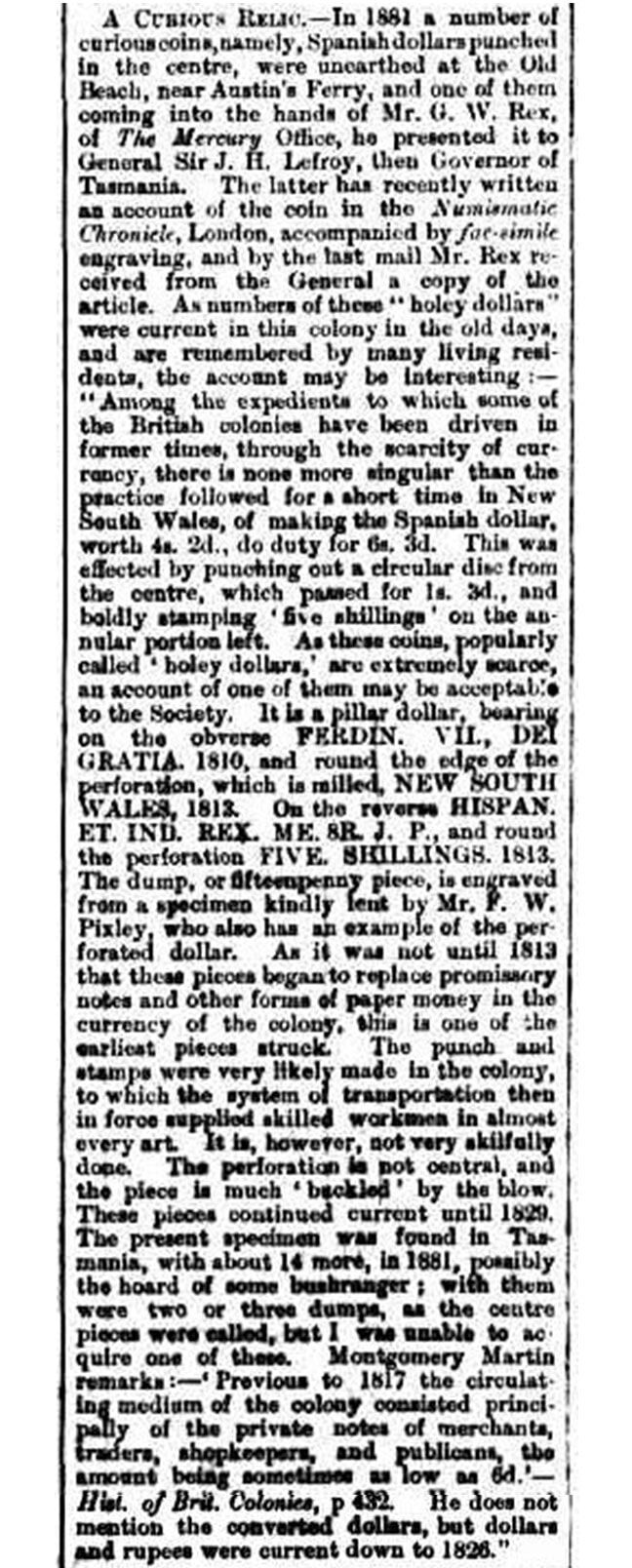
The Sydney Morning Herald
Monday 7 January, 1884
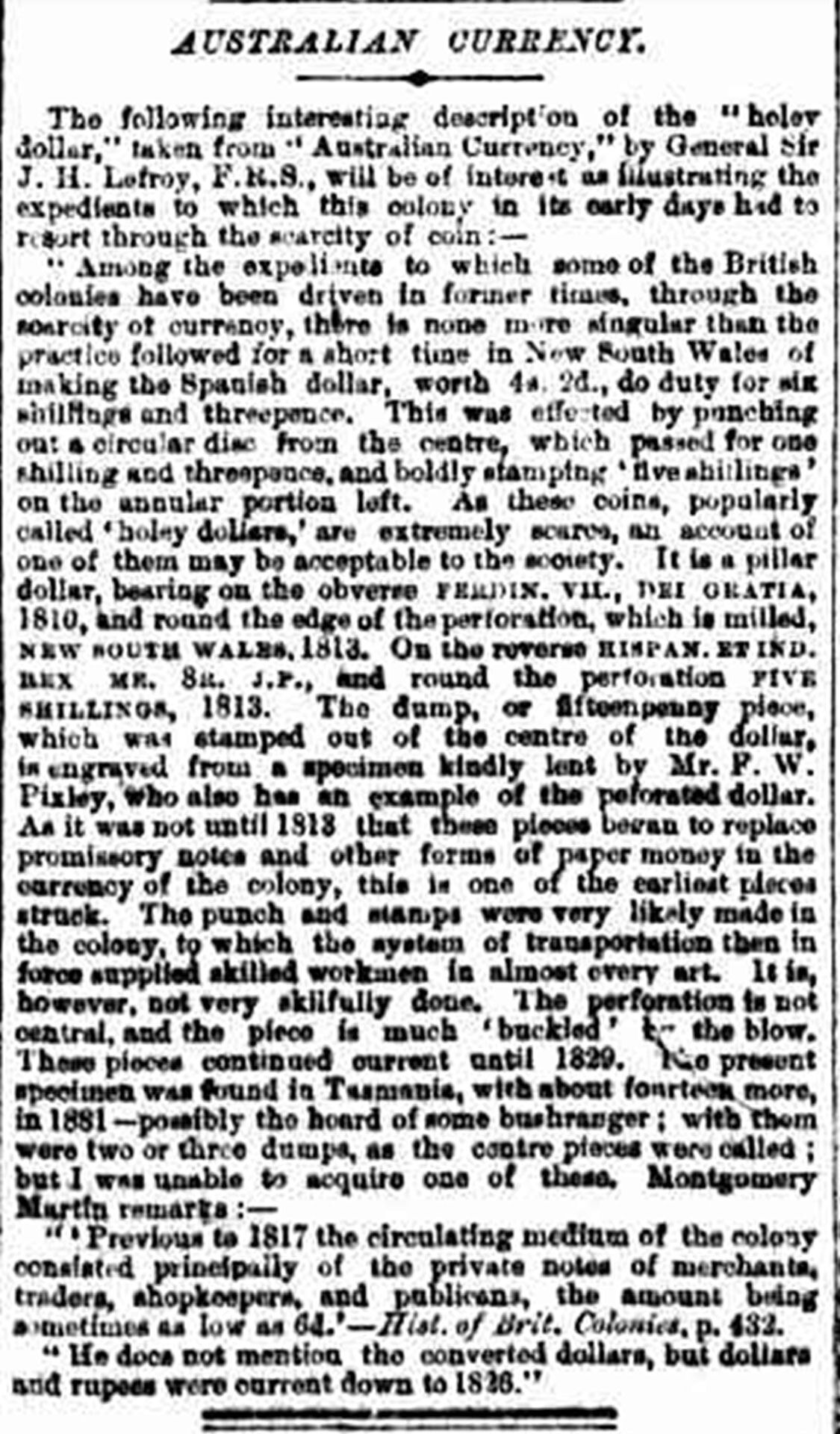
The Numismatic Chronicle and Journal of the Numismatic Society, Third Series, Vol. 3 (1883), pp. 119-120, published by the Royal Numismatic Society
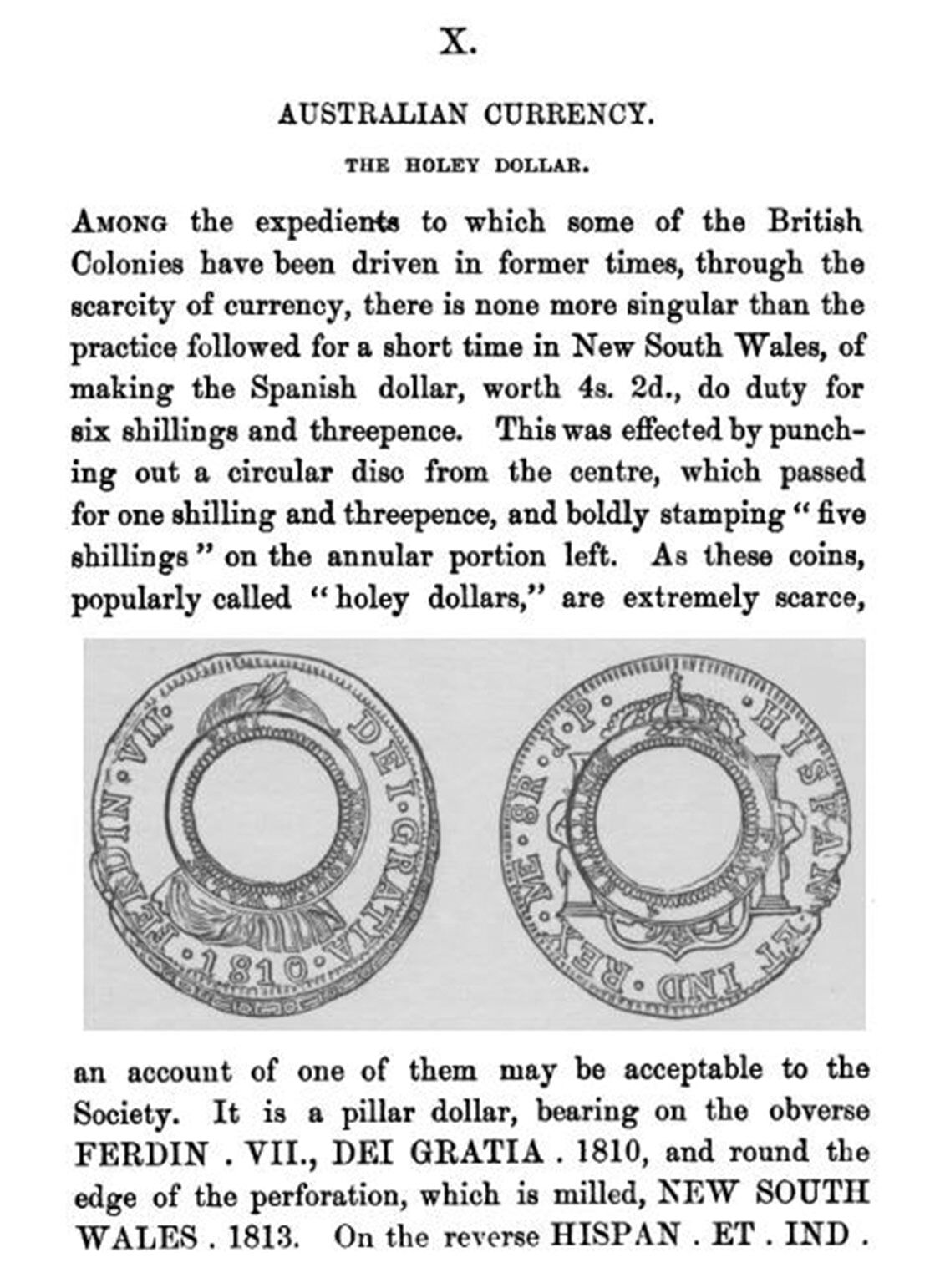
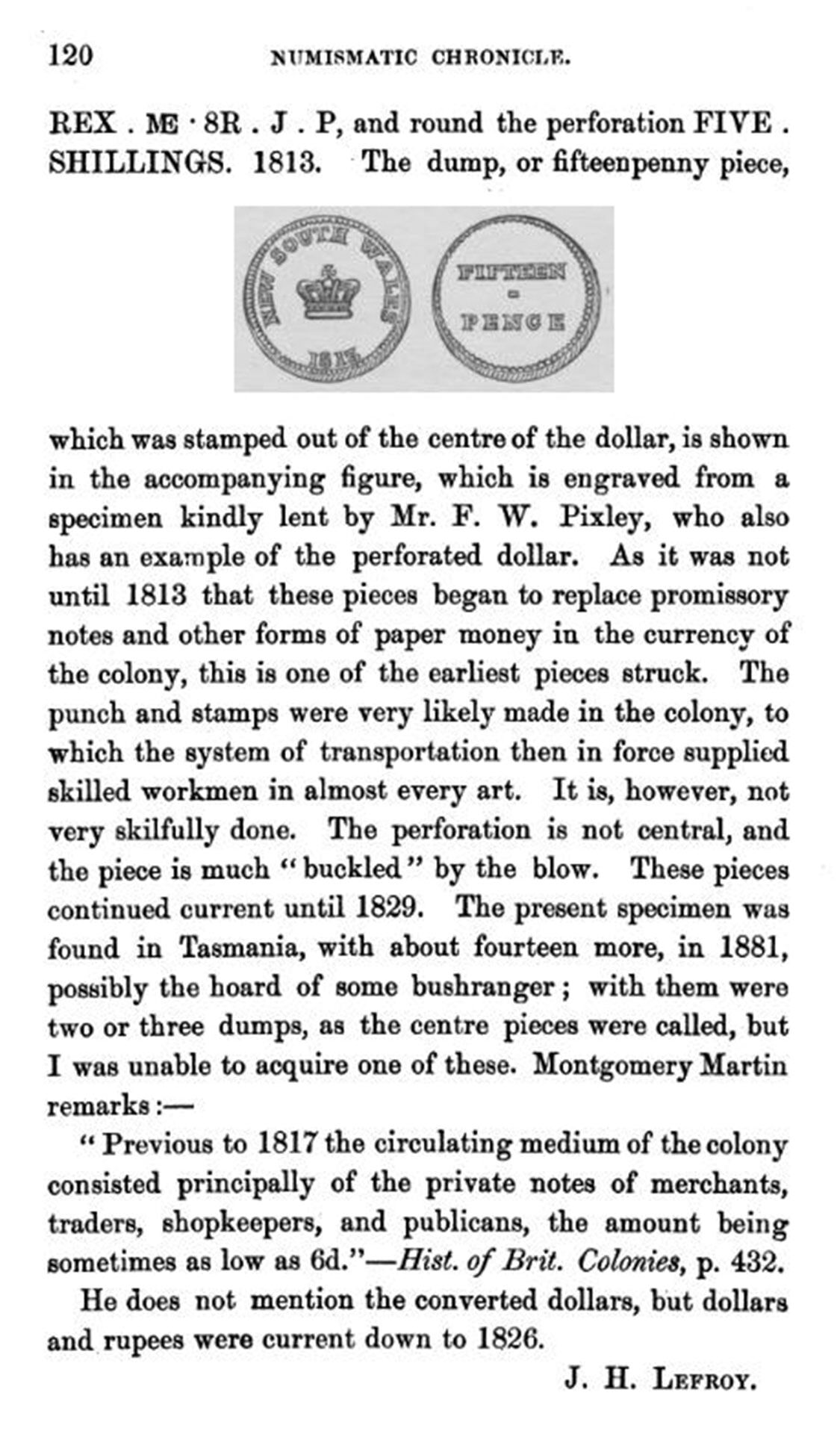
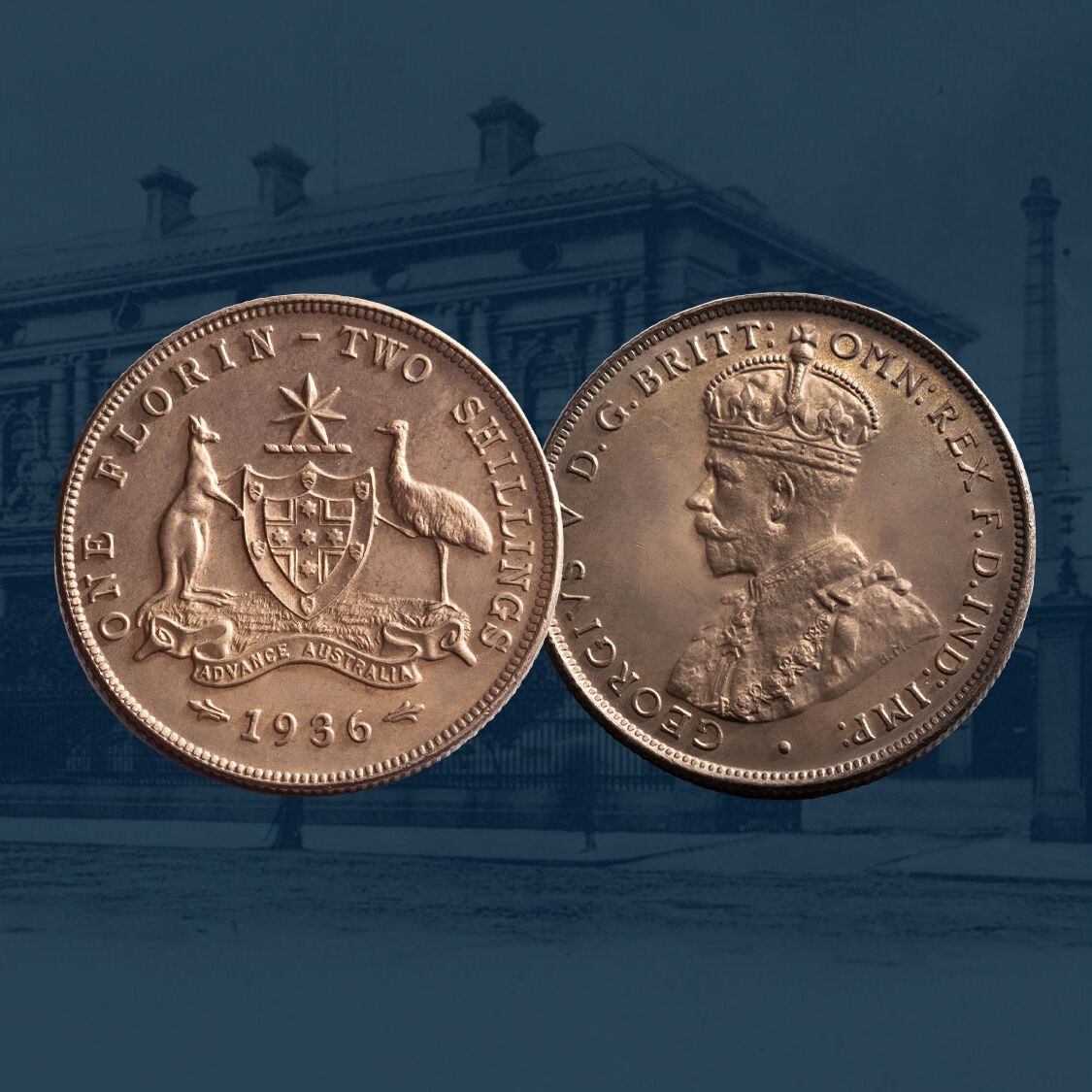
This 1936 Proof Florin was especially struck at the Melbourne Mint as a Coin of Record. A piece of great historical significance, it was struck to mark the final year of George V’s reign (1910 – 1936). Australia’s Coins of Record are admired and respected worldwide. As with fine art and fine jewellery, they have prestige value. The crown jewels of coinage, Coins of Record add glamour and exceptionality to any collection.
Click here for more details on this Product
This 1936 Proof Florin was not struck for collectors as part of any mass-marketing sales campaign. It was struck for the mint's archives and the privileged few. Because it was a specially arranged striking, only a handful of coins were struck.
Australian pre-decimal coins that were struck as proofs - but not destined for collectors - are technically referred to as Coins of Record. The term, COIN OF RECORD, is to a large extent self-explanatory. It is a coin that has been minted to put on record a date. Or to record a design.
What is not self-explanatory is that Coins of Record were struck to a proof or specimen finish as presentation pieces. And were struck in the most minute numbers satisfying the requirements of the mint rather than the wants of collectors. Forget the notion of striking ten thousand proofs as collectors are accustomed to today. Let's talk about striking a total of ten coins ... or in the case of this coin a lot less!
For today’s collectors the Coins of Record offer a wonderful link to the past and are extremely rare, two reasons that make them so popular.
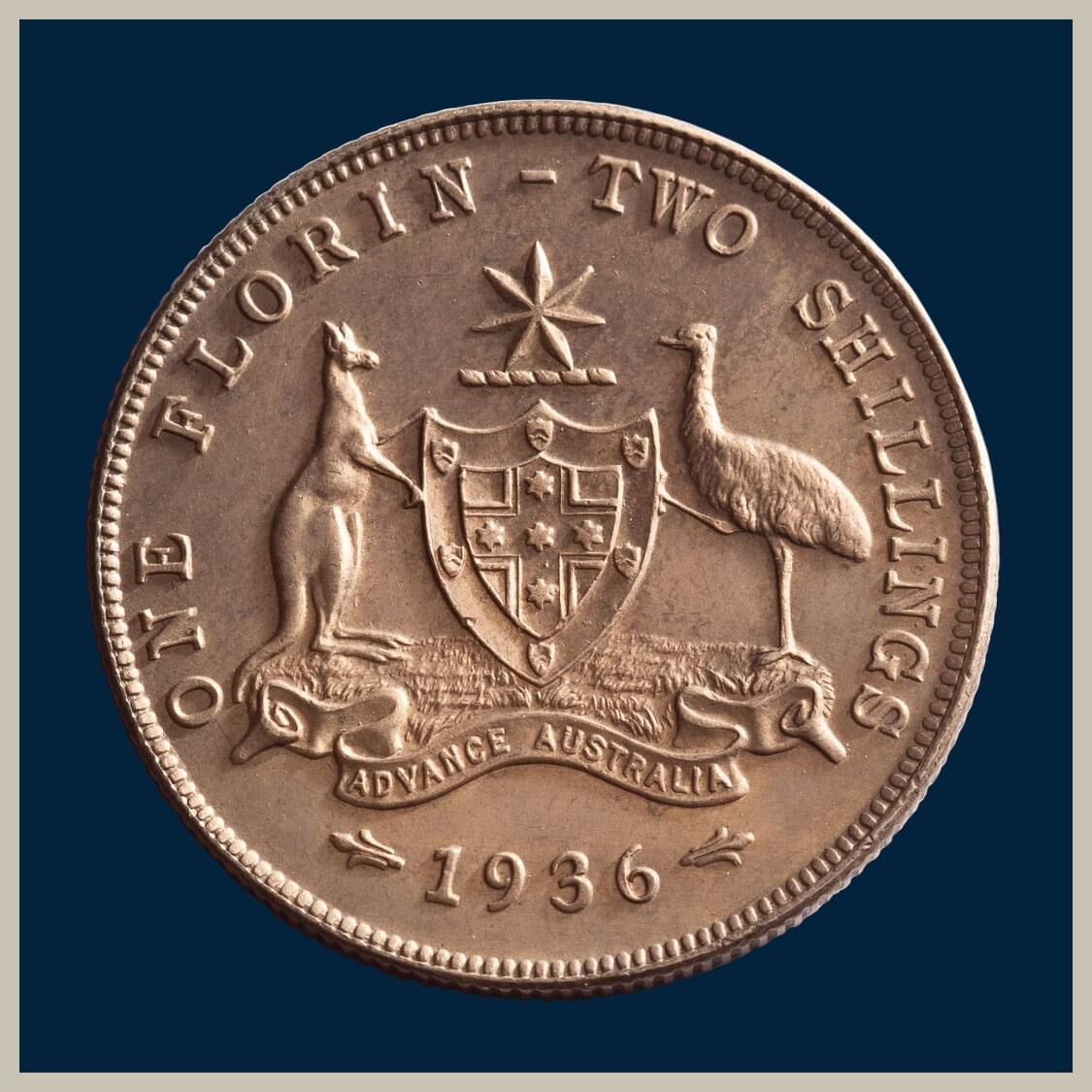
1936 Proof Florin
Melbourne Mint Coin of Record
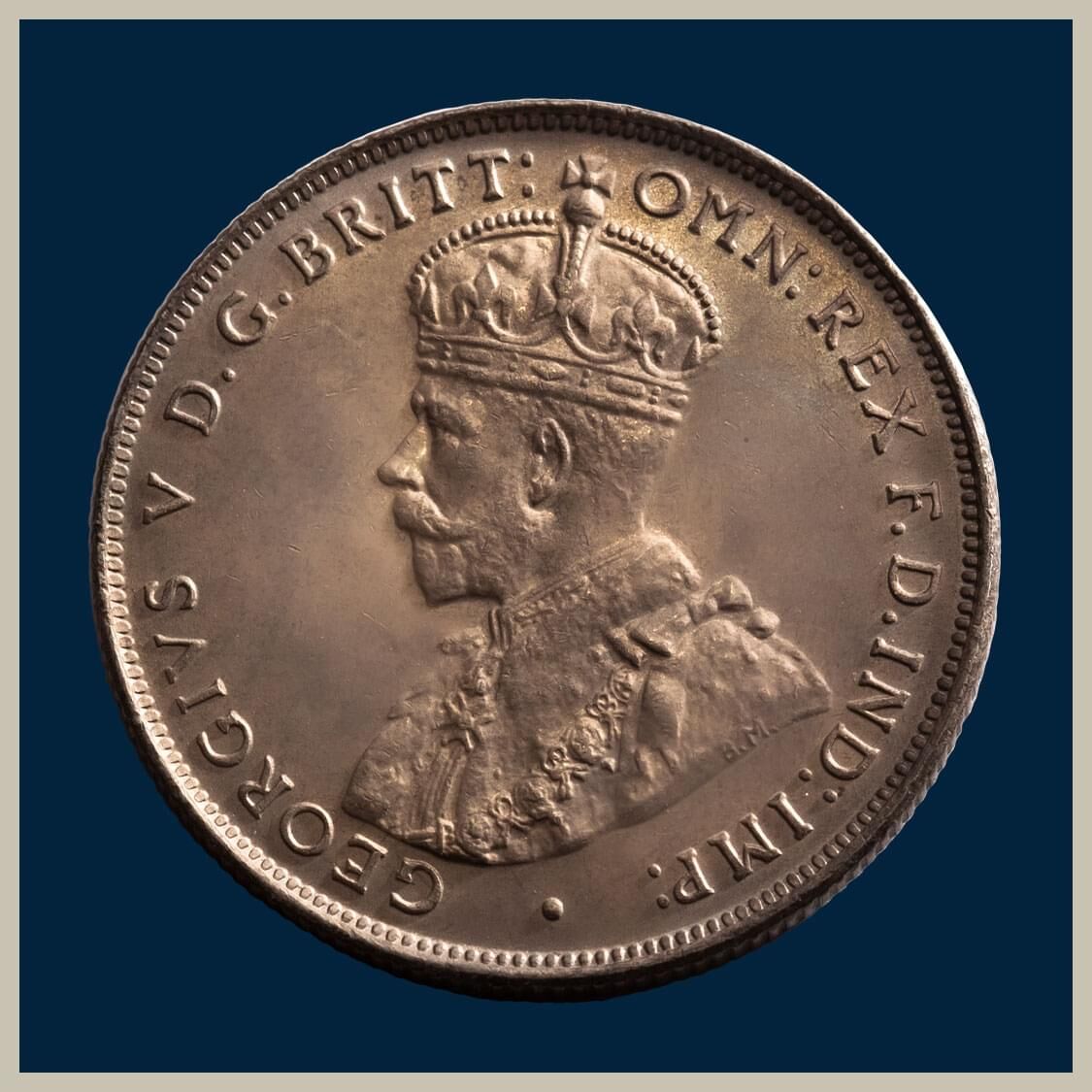
1936 Proof Florin
Melbourne Mint Coin of Record
There was no commercial angle in the production of Coins of Record. The mints were not out to make money from the exercise. Quite the reverse, striking a proof coin in our pre-decimal era was a very labour intensive (and hence costly) exercise that would have dented the mints annual budget quite considerably. The prime reason why so few coins were struck.
In the striking of a proof coin, the mint’s intention was to create a single masterpiece, coining perfection. Perfection in the dies. Wire brushed so that they are razor sharp. Perfection in the design, highly detailed, expertly crafted. Perfection in the fields, achieved by hand selecting unblemished blanks, polished to create a mirror shine. Perfection in the edges to encase the design … exactly what a ‘picture frame does to a canvass’.
The coins were individually crafted, the process time-consuming and the mintages tiny, therefore.
• The dies were struck twice onto the blanks to create a well-defined, three-dimensional design.
• The rims encircling the coins were high, creating a picture frame effect, encasing the coin.
• The pristine nature of the striking is particularly evident in the denticles. They are crisp and uniformly spaced around the circumference of the coin.
This is a unique opportunity to acquire an important piece of Australia’s minting history.
1936 Proof Florin struck as a Coin of Record at the Melbourne Mint and one of four known
Nobles Auction July 2001, Lot 1460
$25,000
FDC, with much brilliance under handsome smoky toning. Heavy striations on both obverse and reverse confirm careful die preparation.
This 1936 Proof Florin was especially struck at the Melbourne Mint as a Coin of Record.
A piece of great historical significance, it was struck to mark the final year of George V’s reign (1910 – 1936).
Australia’s Coins of Record are admired and respected worldwide. As with fine art and fine jewellery, they have prestige value.
The crown jewels of coinage, Coins of Record add glamour and exceptionality to any collection.
Highlights of our Inventory
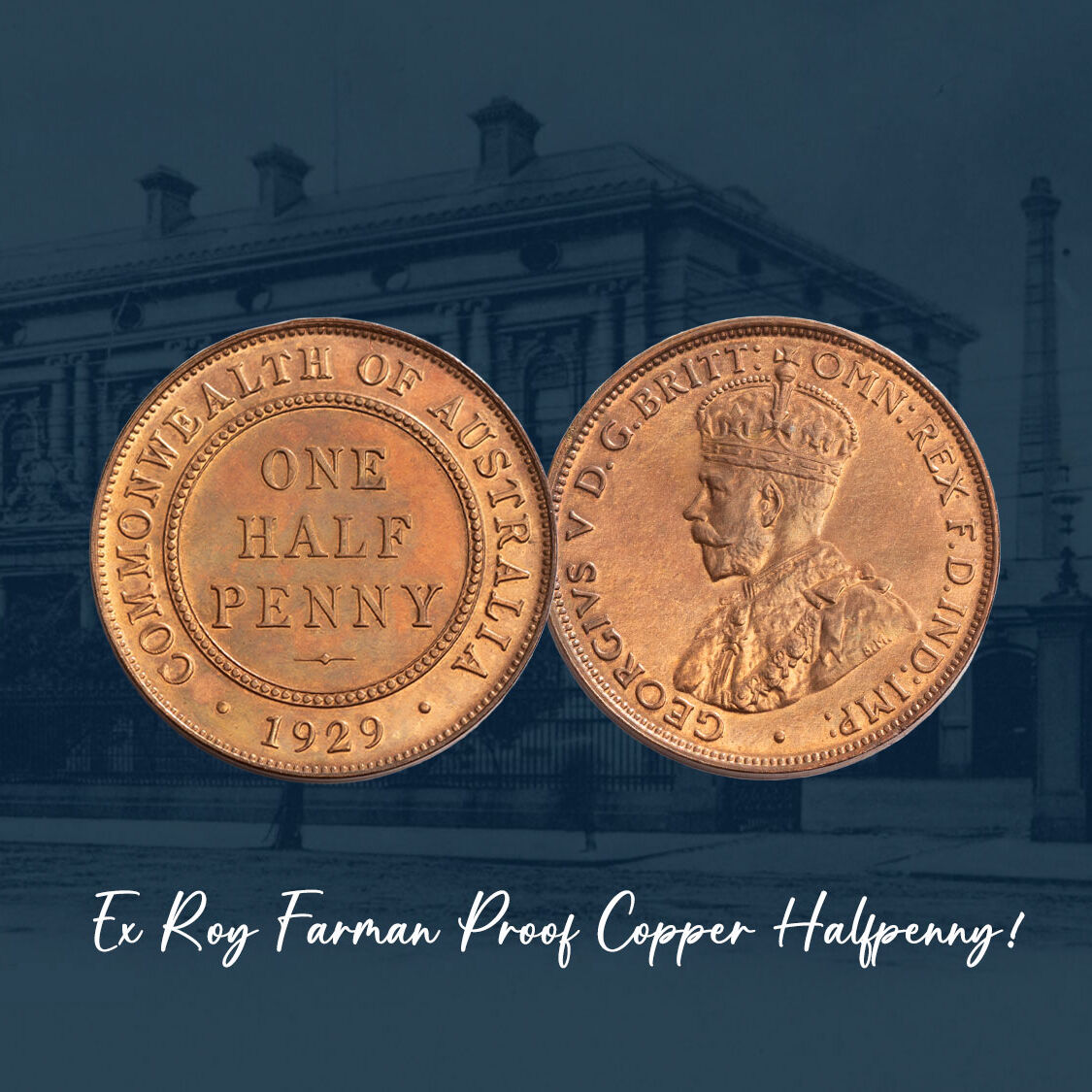
This Proof 1929 Halfpenny was offered as lot 1422 in Australian Coin Auctions sale in March 2001. One coin in a collection of proofs that took the market by storm. Each coin sold for prices that far exceeded their pre-sale estimate, charting new price territories for copper proofs. As a case in point this coin sold for nearly $13,000, almost double its pre-sale estimate. Quality-wise, the coins were definite one-offs. Quite exceptional. The strike of this 1929 Proof Halfpenny is magnificent. The denticles and inner-circle beading on the reverse are pristine. And the fields, full brilliance on both obverse and reverse. This is proof coining at its best! Great coins tend to have a history; a narrative that involves a person that is numismatically influential, a VIP or a Government dignitary. A story that helps us understand why the quality is so extraordinary. And in the case of this Proof 1929 Halfpenny the person is Roy Farman. It was acquired in the 1950s from Farman, the exceptional quality of the coin said to have been a consequence of his close relationship with Albert Le Souef, a former Deputy Master of the Melbourne Mint.
Click here for more details on this Product
This 1929 Proof Halfpenny was but one coin in a small collection of George V copper proofs that was originally owned by Roy Farman.
The collection changed hands in the 1950s and was eventually offered at a public auction in Melbourne by Downies Australian Coin Auctions, in 2001 and 2002.
The collection was comprised of Melbourne Mint Coins of Record of the following dates: Proof Pennies struck in 1920, 1926, 1931, 1932 and 1936. And Proof Penny and Proof Halfpenny pairs struck in 1928 and 1929.
All were extraordinary. The auction bidding frenetic.
The industry contends that the exceptional quality of these proofs had to have been a consequence of Farman’s close relationship with Albert Le Souef, who maintained a strong relationship with the mint even after his retirement.
In the Farman/Le Souef era, Coins of Record were (theoretically) out of reach of collectors. You had to have a strong connection into minting circles to gain access to them. And if you did have that connection you would almost certainly be guaranteed the best quality.
And it is important to note that, in this era, proofs had no commercial value over and above their face-value. They were simply collector's items! (PS Today, they are still collector's items, but with a definite commercial twist.)
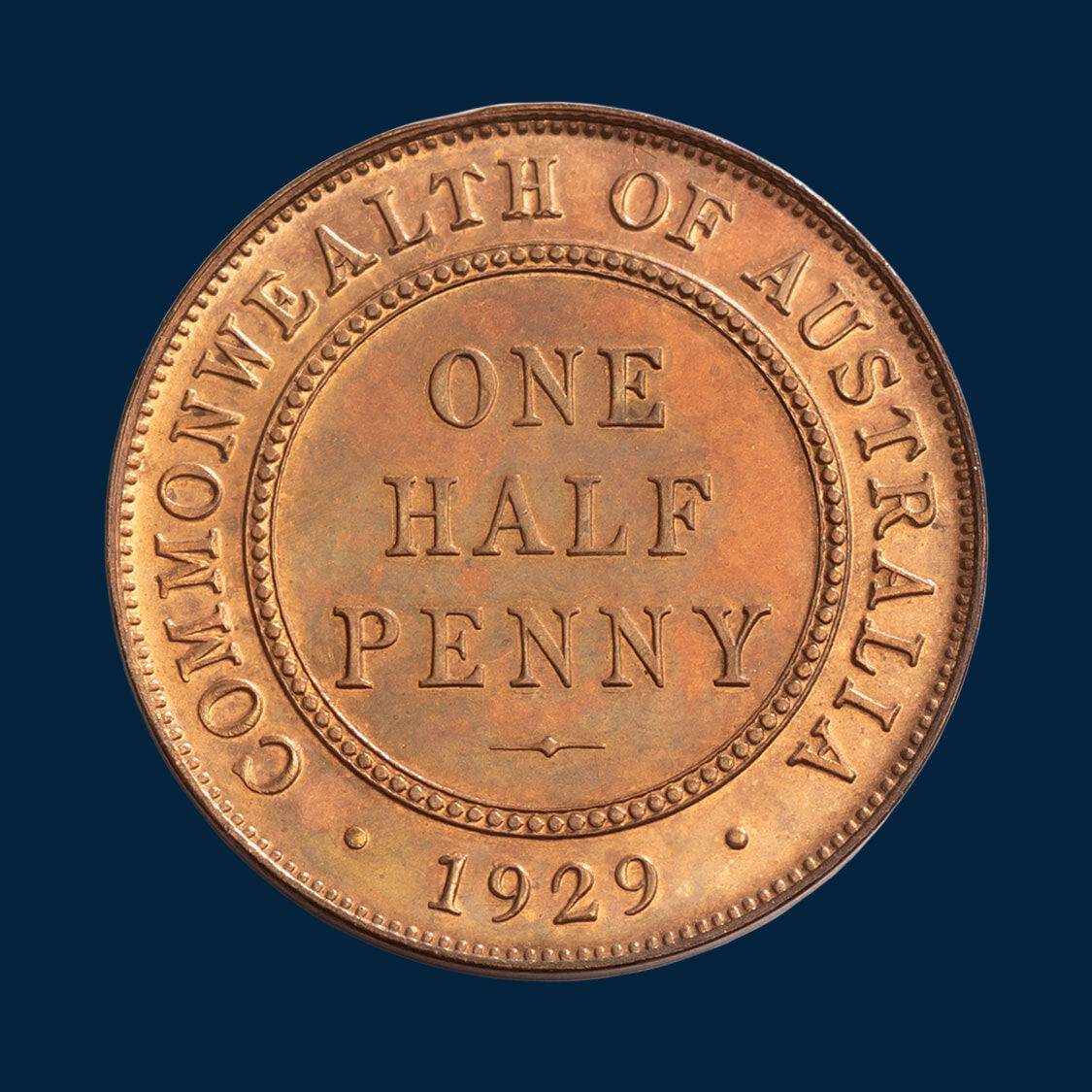
1929 Proof Halfpenny
Melbourne Mint Coin of Record
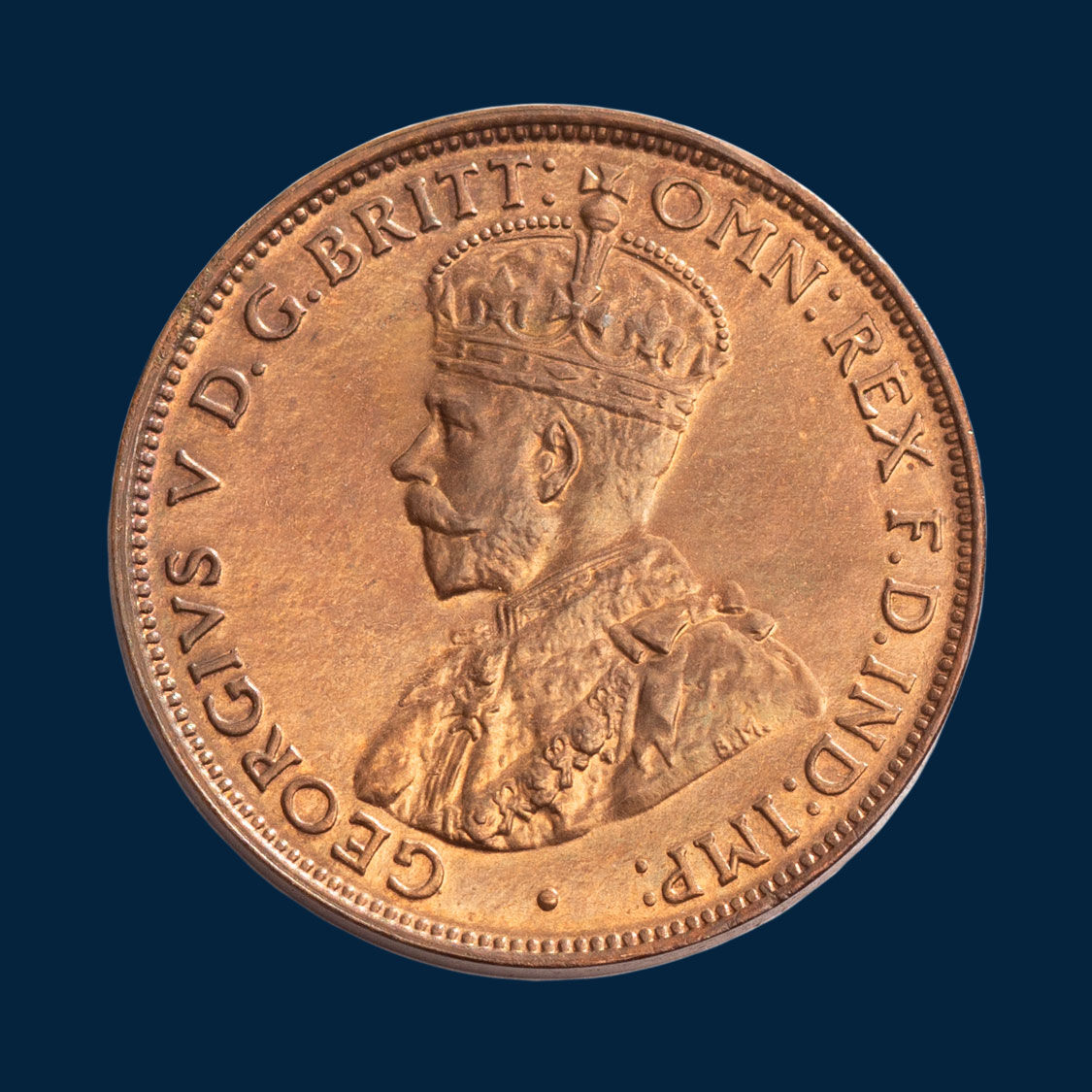
1929 Proof Halfpenny
Melbourne Mint Coin of Record
Australia’s Coins of Record are admired and respected worldwide. As with fine art and fine jewellery, they have prestige value.
A Coin of Record is an artistic interpretation of coinage, a strikingly beautiful coin beyond ordinary currency, individually crafted to standards far exceeding that required of a circulating coin.
Using technical terms, Coins of Record were struck using special minting techniques to either a proof or specimen finish involving highly polished blanks to create mirror fields and carefully prepared dies to ensure a wealth of design definition.
A Coin of Record is a showpiece. The crown jewels of coinage, adding glamour and exceptionality to any collection.
Whereas production of circulating coinage was dictated by Government, Coins of Record were struck at the discretion of the mint master. Placed in the mint’s archives for posterity. Perhaps, an example forwarded to the monarch. Coins of Record were occasionally produced for the Royal Mint London, a selected museum or to display at an international exhibition. Or gifted to a dignitary.
All circumstances that necessitated the very best in minting standards.
The coins were not produced every year and, as they were individually crafted, the process was time consuming and the mintages tiny, therefore.
For Melbourne Mint copper proofs, generally less than six pieces.
1929 Proof Halfpenny struck as a Coin of Record at the Melbourne Mint, ex Roy Farman, and the finest of four known examples.
Australian Coin Auctions 15 March 2001 (Lot 1422)
Price: $22,500
Great coins tend to have a history; a narrative that involves a person that is numismatically influential, a VIP or a Government dignitary.
A story that helps us understand why the quality is so extraordinary. And in the case of this Proof 1929 Halfpenny the person is Roy Farman.
It was acquired in the 1950s from Farman, the exceptional quality of the coin said to have been a consequence of his close relationship with Albert Le Souef, a former Deputy Master of the Melbourne Mint.
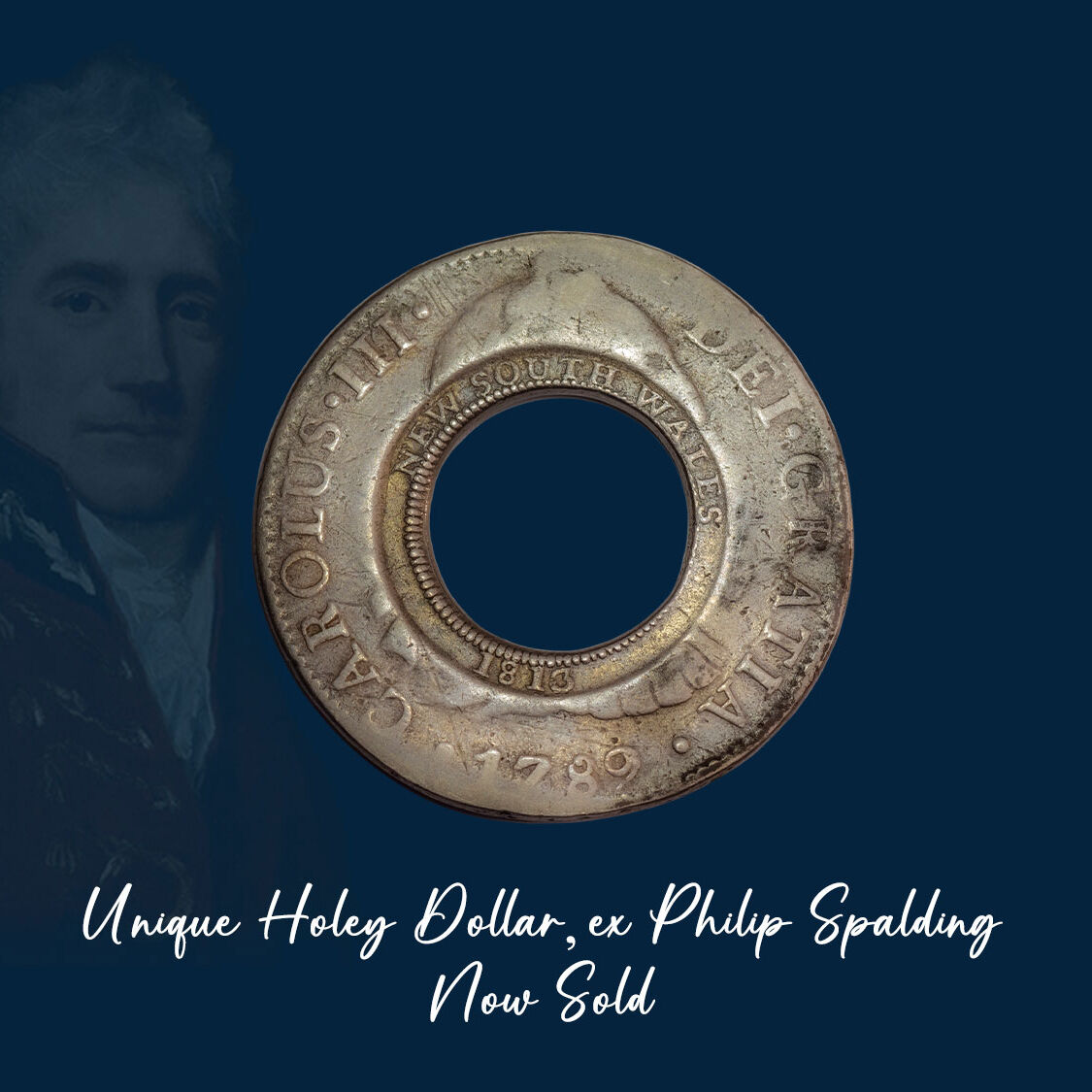
This Holey Dollar is a coin with authority. It is unique and so important to the Holey Dollar narrative that it was featured in Philip Spalding’s book the World of the Holey Dollar in his chapter on the ‘Top Dollars’. That the coin has circulated does not detract from its importance. It simply takes the coin to a price level that engages a wider audience. Its importance pertains to the date of the silver dollar, ‘1789’. It was issued during the reign of Charles IV, yet the dollar features the portrait and legend of his father, Charles III, who died in 1788. Fewer than three hundred Holey Dollars survive today and of those, only two have this extraordinary design detail. Each is unique. The first is this example, the dollar originating from the Mexico Mint in Mexico. The second, a Holey Dollar with ties to the Lima Mint in Peru. This is an historic offering of an important Holey Dollar, a coin that plays a pivotal role in Australia's Holey Dollar story. (A copy of Spalding's book will be gifted with this Holey Dollar.)
Click here for more details on this Product
In the realm of rare coins, Holey Dollars exist on a different plane. They transcend mere collectibles and have become coveted objects that represent the pinnacle of Australia's numismatic industry, our very first coin.
Philip Spalding was a passionate Holey Dollar collector and author. He narrated the ‘Holey Dollar story’ better than anyone else, using coins from his collection to illustrate the point.
His book, ‘The World of the Holey Dollar’, published in 1973 is a literary masterpiece. Incomparable for the depth of information it provides, the book is to this day, a major reference on the nation's first coins and is used worldwide.
Spalding was particularly interested in the rarer types of Holey Dollars, his personal collecting preferences directed towards those dollars that marked the changing of a monarch, such as this coin.
He devoted chapter eighteen to the 'Top Dollars' as they were perceived in 1973. Seventeen Holey Dollars formed his 'top' dollar list and this coin was one of them, featured on page 209.
Unique in 1973, when owned by Philip Spalding, and unique today, this Holey Dollar is a prize. (A copy of Philip Spalding's 'The World of the Holey Dollar' will be gifted with this coin.)
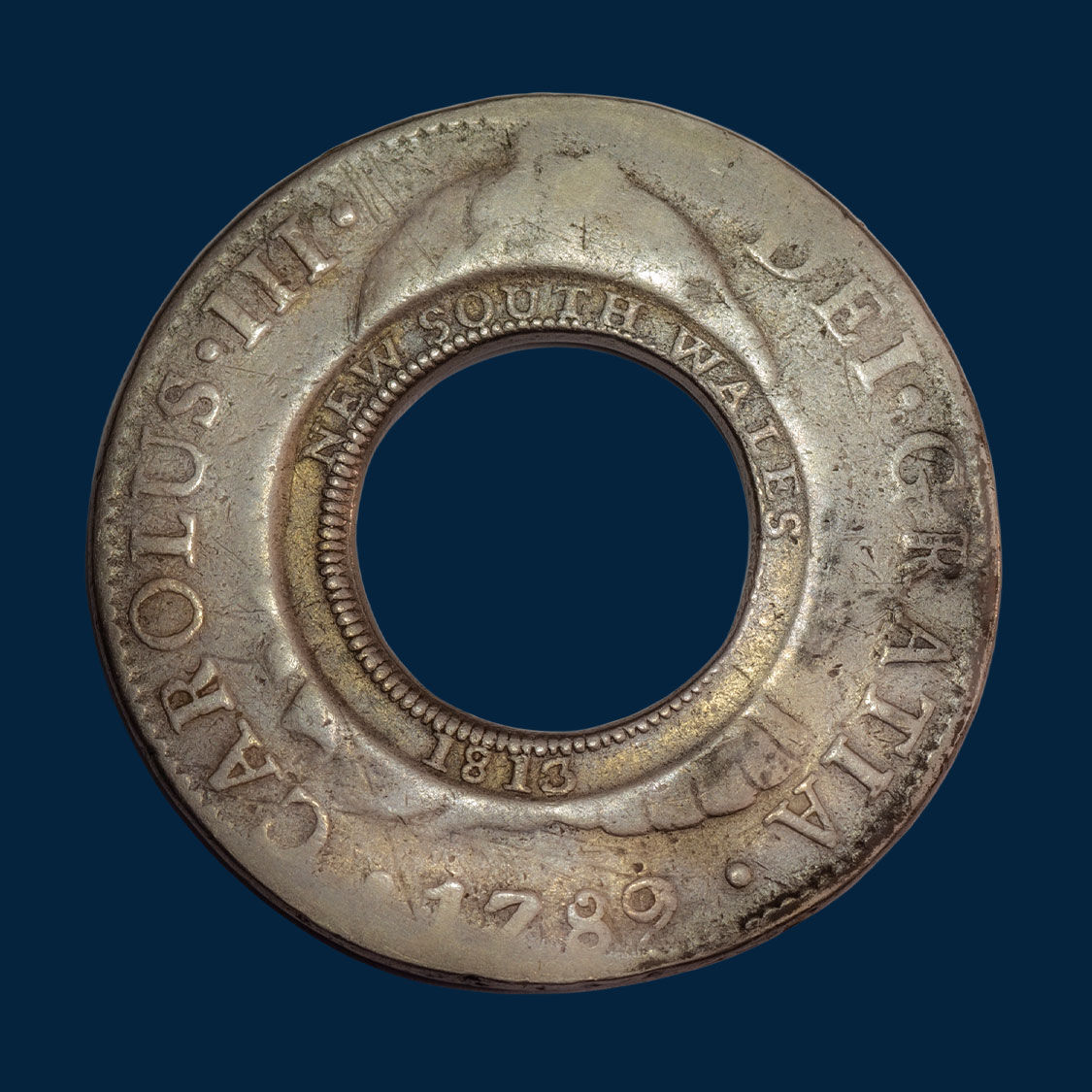
Unique Mexico Mint
Type 3 Holey Dollar
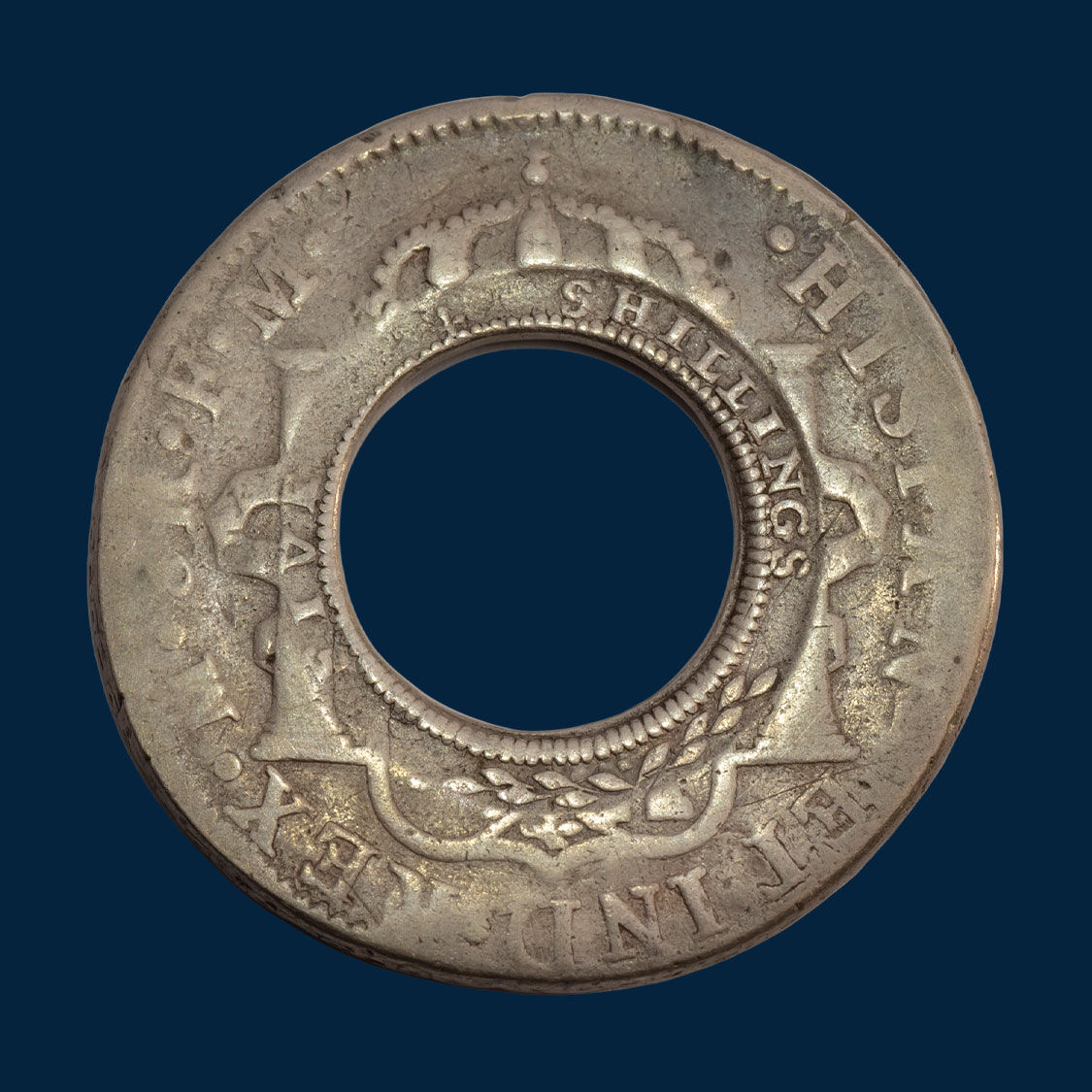
Unique Mexico Mint
Type 3 Holey Dollar
Holey Dollars are classified into types based on the legend and portrait of the monarch depicted on the original Spanish Silver Dollar. There are eight distinct types of Holey Dollars and the piece offered here is a Type 3 Holey Dollar, and one of the rarer types with just two known examples.
The protocols for defining each type are detailed below, and the number of Holey Dollars available to collectors.
Type 1 - Ferdinand VI Holey Dollar
Design: features the legend and portrait of Ferdinand VI (1746 - 1759).
Availability: 2
Type 2 - Charles III Holey Dollar
Design: features the legend and portrait of Charles III (1759 - 1788).
Availability: 22
Type 3 - Charles III, deceased Holey Dollar
Design: features the legend and portrait of the deceased King Charles III, depicted on silver dollars issued during the reign of Charles IV. (1788 - 1808)
Availability: 2, one Mexico Mint and one Lima Mint, each therefore unique
Type 4 - Charles III on Charles IV Holey Dollar
Design: features the legend of the reigning monarch Charles IV and the portrait of the deceased King Charles III.
Availability: 8
Type 5 - Charles IV Holey Dollar
Design: features the legend and portrait of Charles IV (1788 - 1808)
Availability: 129
Type 6 - Charles IV Continental Holey Dollar
Design: struck from a Continental Silver Dollar, featuring the legend and portrait of Charles IV.
Availability: 1
Type 7 - Ferdinand VII Holey Dollar
Design: features the legend and portrait of Ferdinand VII. Ferdinand VII was exiled in 1808, Napoleon Bonaparte proclaiming his brother Joseph as king of Spain from 1808 to 1813.
Availability: 13
Type 8 - Hannibal Head Holey Dollar
Design: features the legend of Ferdinand VII and an imaginary portrait of the monarch referred to as the 'Hannibal Head'. Ferdinand VII was exiled in 1808, Napoleon Bonaparte proclaiming his brother Joseph as king of Spain from 1808 to 1813.
Availability: 2
Coin: Created from a Spanish Silver Dollar of the 'bust' type dated 1789 and depicting the portrait and legend of the deceased King Charles III (Charles III died in December 1788).
Price: $145,000
The production of Spanish Silver Dollars in the silver-rich colonies of South America was critical to maintaining Spain’s ascendancy as a world power. Rather than halt production of the silver dollars until a new effigy of Charles IV was received, the mints maintained their coin production using the effigy of the deceased king Charles III.
Three hundred Holey Dollars survive today and of those, only two have this extraordinary design detail whereby the dollar was struck during the reign of Charles IV but featured the legend and portrait of Charles III.
The aesthetic appeal and the rarity of this Holey Dollar are enhanced by the alignment of the obverse counter-stamps 'New South Wales'' and '1813' which are in the same vertical vista as the date of the silver dollar, '1789'. Only a handful of Holey Dollars exhibit such alignment.
A study of the surviving Holey Dollars reveals that Henshall's application of the counter-stamps was wildly random, that the holed dollar was not placed in a particular position between the dies. And it obviously didn't matter which side of the holed dollar was facing up. Precision was simply not required which is why the counter-stamps of most Holey Dollars are 'all over the shop'.
Design type: 3
Date of the silver dollar: 1789
Reigning monarch: Charles IV (1788 - 1808)
Design of the silver dollar: colonial bust type
Portrait: Charles III
Legend: Carolus (Charles) III
Quality of the silver dollar : Good Fine
Quality counter stamps: Nearly Very Fine
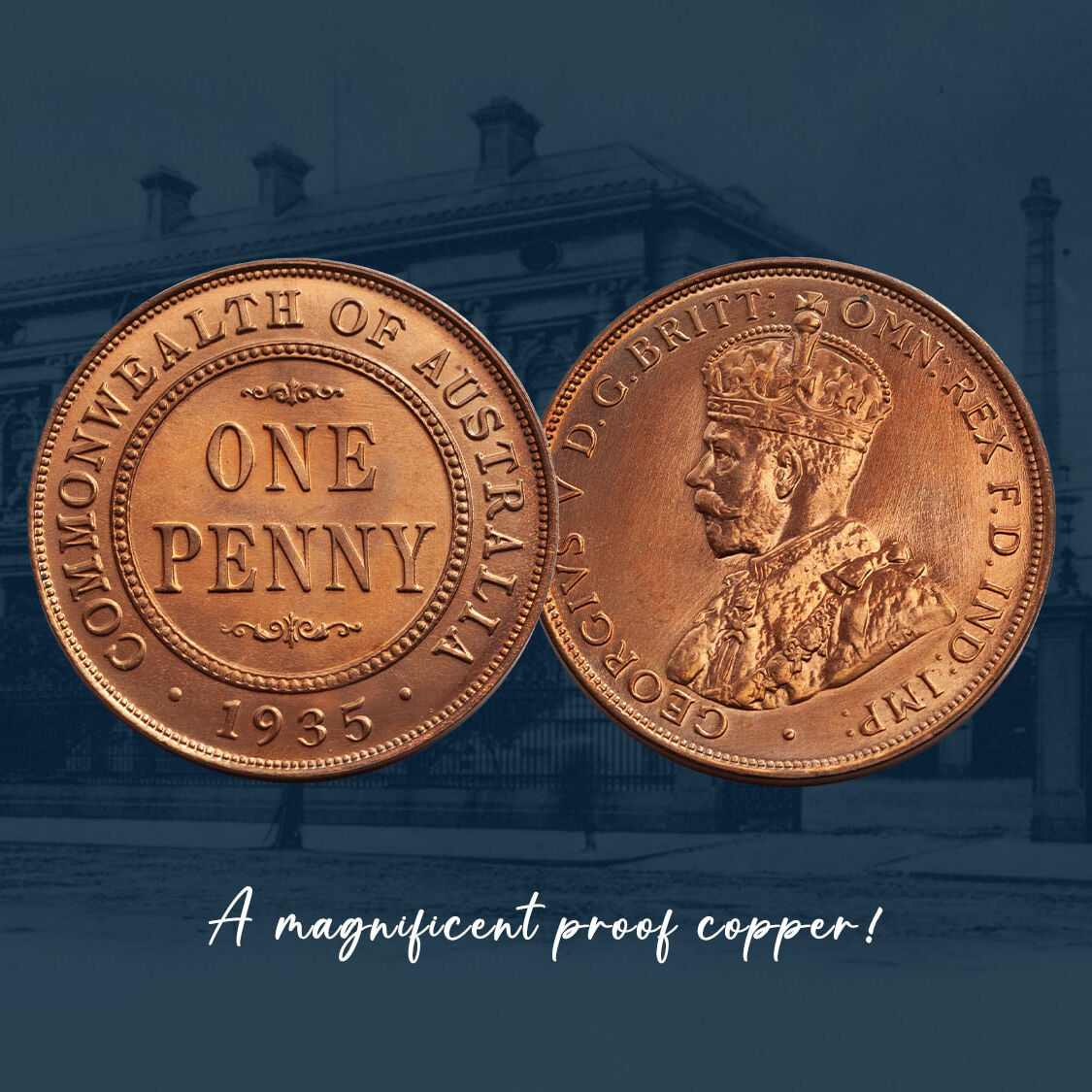
A Trans-Tasman connection was alive and kicking when New Zealander, Henry George Williams, financed the striking of a small number of Proof Pennies and Proof Halfpennies in 1935 at the Melbourne Mint. In so doing, Williams unwittingly created an Australian 'numismatic star'. The term 'numismatic star' falls well short in describing this 1935 Proof Penny. Quality-wise it is a 'numismatic superstar', a full brilliant mint red, gem copper proof. The coin first appeared on the market at auction in 2005, its quality unprecedented. Dealers and collectors alike had never seen anything like it before, and the auction sale price smashed all records. The technical shots re-affirm that this coin is, as we have described. Magnificent!
Click here for more details on this Product
The pride and satisfaction associated with owning a special coin is markedly enhanced with knowledge of both the people associated with its production and previous owners through whose hands it has passed.
New Zealand numismatist, Henry George Williams played a key role in persuading the Melbourne Mint to issue proof coins on a commercial basis in 1935. Williams was captivated by the golden-eye appeal achieved by the Melbourne Mint with their proof coppers and ordered 126 pairs. The majority of pairs were sold into the advanced collector markets in the U.K. and the U.S, the very reason why the coins are so scarce in the Australian market.
That Williams did not request the minting of any proof silver coins in 1935 reflected his personal preference and his insight into the market, that demand for the bronze coins far outweighed that for the silver.
As the photos reveal, the strike detail and the finish of this coin is unsurpassed by any other proofs out of the George V era.
Historical letters confirm that the proofs of 1935 were struck from especially hardened blanks, and were struck twice with fresh dies in the presses. The lack of bag marks is consistent with the coins being made effectively by hand.
Natural attrition has taken its toll on the original mintage and we would expect to see 1935 Proof Penny or a 1935 Proof Halfpenny on the open market, perhaps once every year.
But a "fully brilliant mint red" proof penny? At this quality level, the opportunity might come around once in a collector's lifetime.

1935 Proof Penny,
a full brilliant mint red
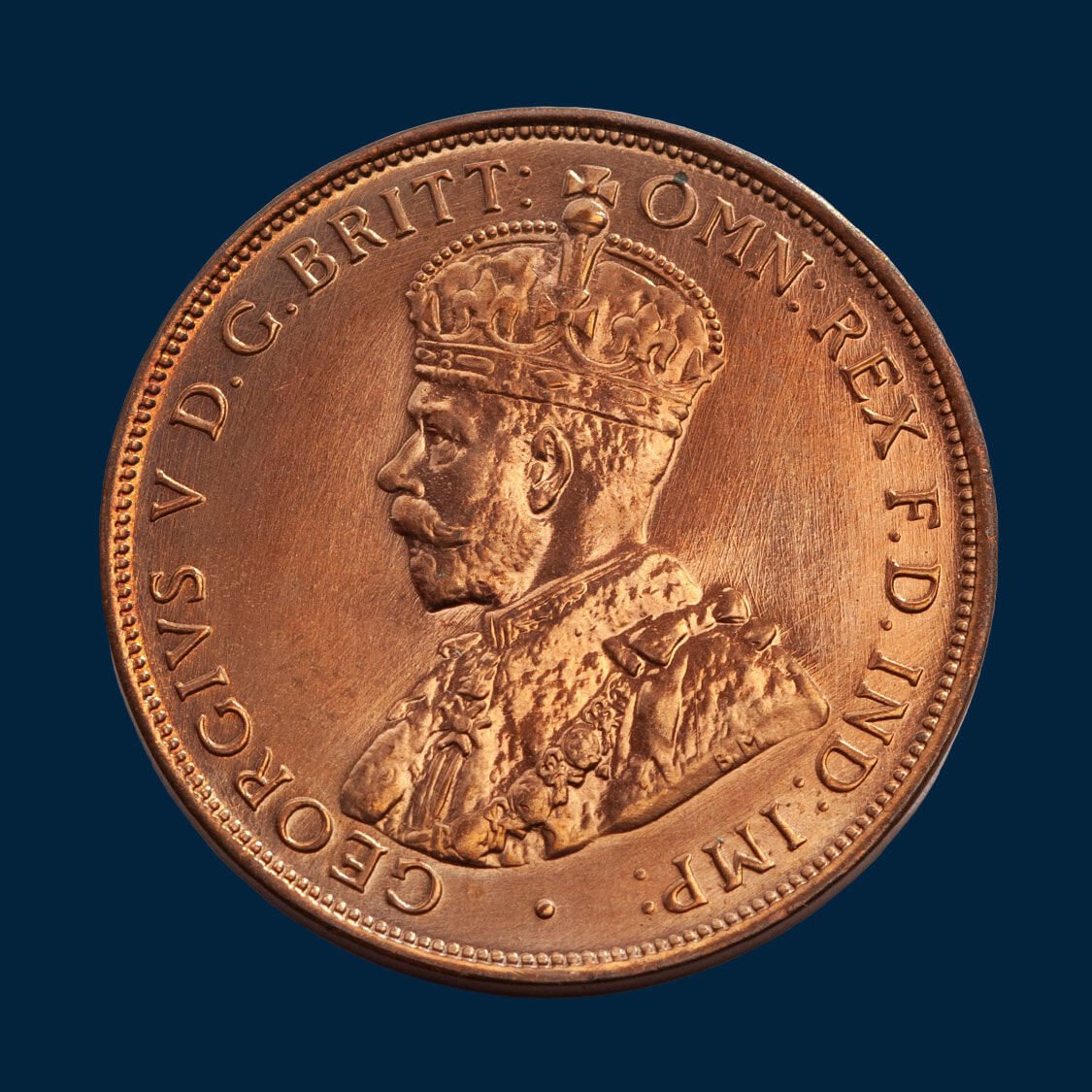
1935 Proof Penny,
a full brilliant mint red
With on-line ordering and toll-free phone numbers, buying your favourite collector coin from the Royal Australian Mint has never been easier.
Collectors in the nineteenth and twentieth century however were not afforded the same consideration from the operating mints.
The Sydney Mint opened in 1855 as a branch of the Royal Mint London and closed in 1926. Throughout its entire history, the mint did not strike proofs for collectors on a commercial basis. The Melbourne Mint, Australia’s second coining facility, opened in 1872. During its first forty-four years of operation, the mint did not strike coins for collectors on a commercial basis.
The Melbourne Mint’s first commercial foray for collectors occurred in 1916 when the mint especially created a presentation set to commemorate its inaugural striking of the Commonwealth’s silver coins.
Sadly, for collectors, the 1916 Presentation Set did not set a precedent for further coin issues. Government policy dictated that minting resources be applied to the striking of circulating coins for Treasury, rather than pandering to the whims of collectors through the regular issuing of proofs.
Over the next thirty-eight years, from 1916 to 1953, the Melbourne Mint played ‘cat and mouse’ with collectors by releasing only another seven proof and/or specimen issues. The issues were ad hoc. The mintages inconsistent. The years in which the collector issues occurred were 1916, 1927, 1934, 1935, 1937, 1938, 1939 and 1953. We refer to these eight issues as 'The Collector Coins of the Melbourne Mint, 1916 to 1953’.
They were pivotal in changing Australia's coin collecting landscape in the twentieth century, the pre-cursor to the series taken up by the Royal Australian Mint in 1966.
Proof 1935 Penny struck at the Melbourne Mint
Price $30,000
A gem proof, full brilliant mint red with heavy striations, on both obverse and reverse, reflecting careful preparation of the dies, FDC and extremely rare.
I.A.G. Auction January 2005, lot 346
Proof 1935 Penny struck at the Melbourne Mint
Price $30,000
A gem proof, full brilliant mint red, FDC and extremely rare.
I.A.G. Auction January 2005
Heavy striations, on both obverse and reverse, reflect careful preparation of the dies.
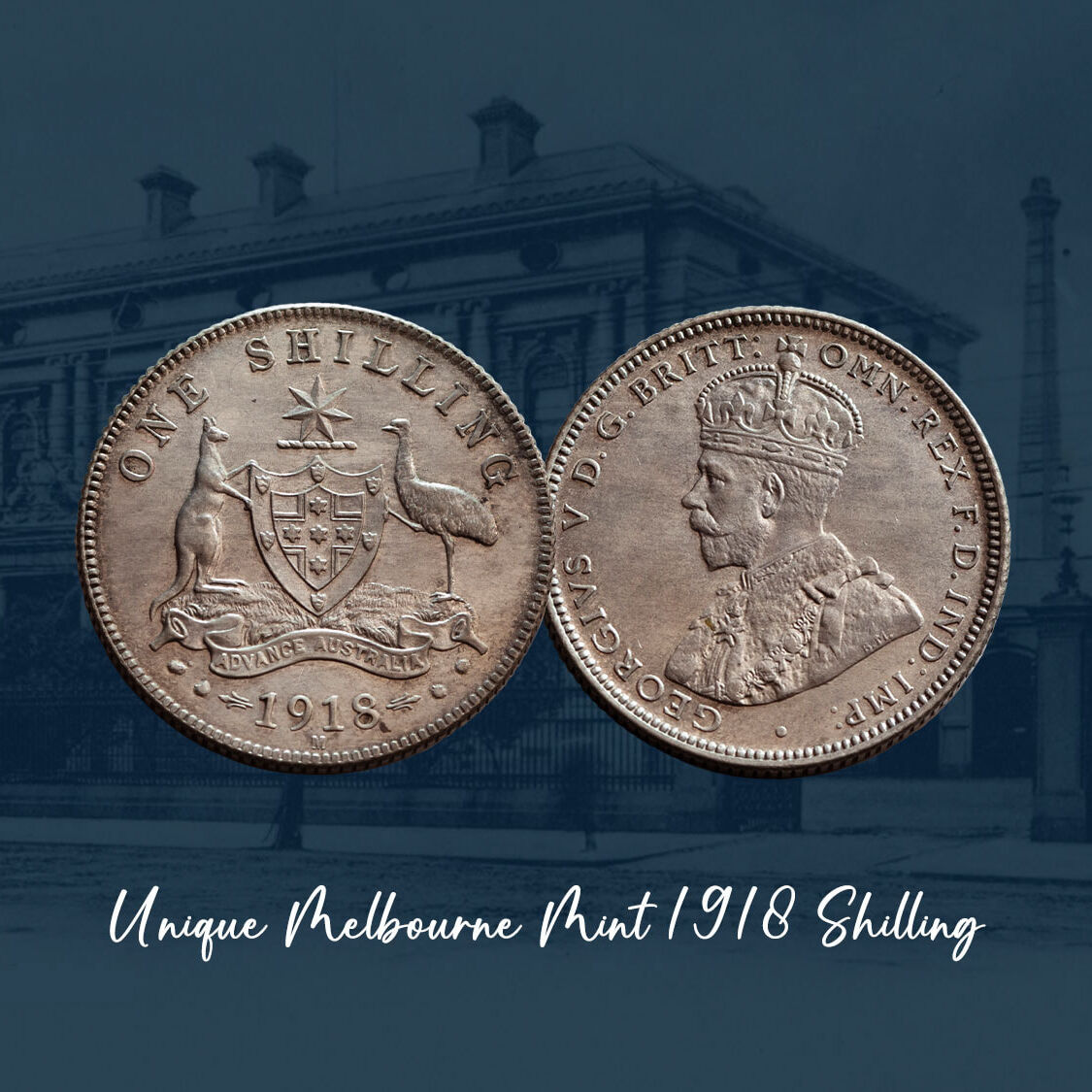
This 1918 Shilling is the only known example held by a private collector. The coin comes with a distinguished pedigree, its first recorded owner, Mr A M Le Souef, a former Deputy Master of the Melbourne branch of the Royal Mint London. It was especially struck at the Melbourne Mint as a test piece, in a reduced metal content of .500 fine silver. And to differentiate it from the circulation issue, the reverse die was punched in the field with two irregular stops on either side of the date. The coin was considered so important that when a second example came to light in 1991, and was offered at Spink Auctions Australia, it was acquired by the Museum of Victoria for their collection, where it is still held.
Click here for more details on this Product
When a coin becomes one of the nation’s storytellers it assumes a higher significance in the industry. And this 1918 Trial Shilling is one such storyteller.
The 1918 Trial Shilling is a product of a period of serious financial and economic turbulence that saw nations around the world abandon sterling silver as their currency standard.
The fluctuations particularly affected governments like Australia that were still producing their currency in sterling silver.
The Government's strategies for coping are well documented in historical records. It is also documented by way of Australia’s coinage.
The Government planned to adopt a new silver coinage alloy and in 1918 began a testing period of striking coins with a reduced silver content. Consideration was given to a .625 alloy and one struck in .500 fine as taken up by the British during the precious metal crisis.
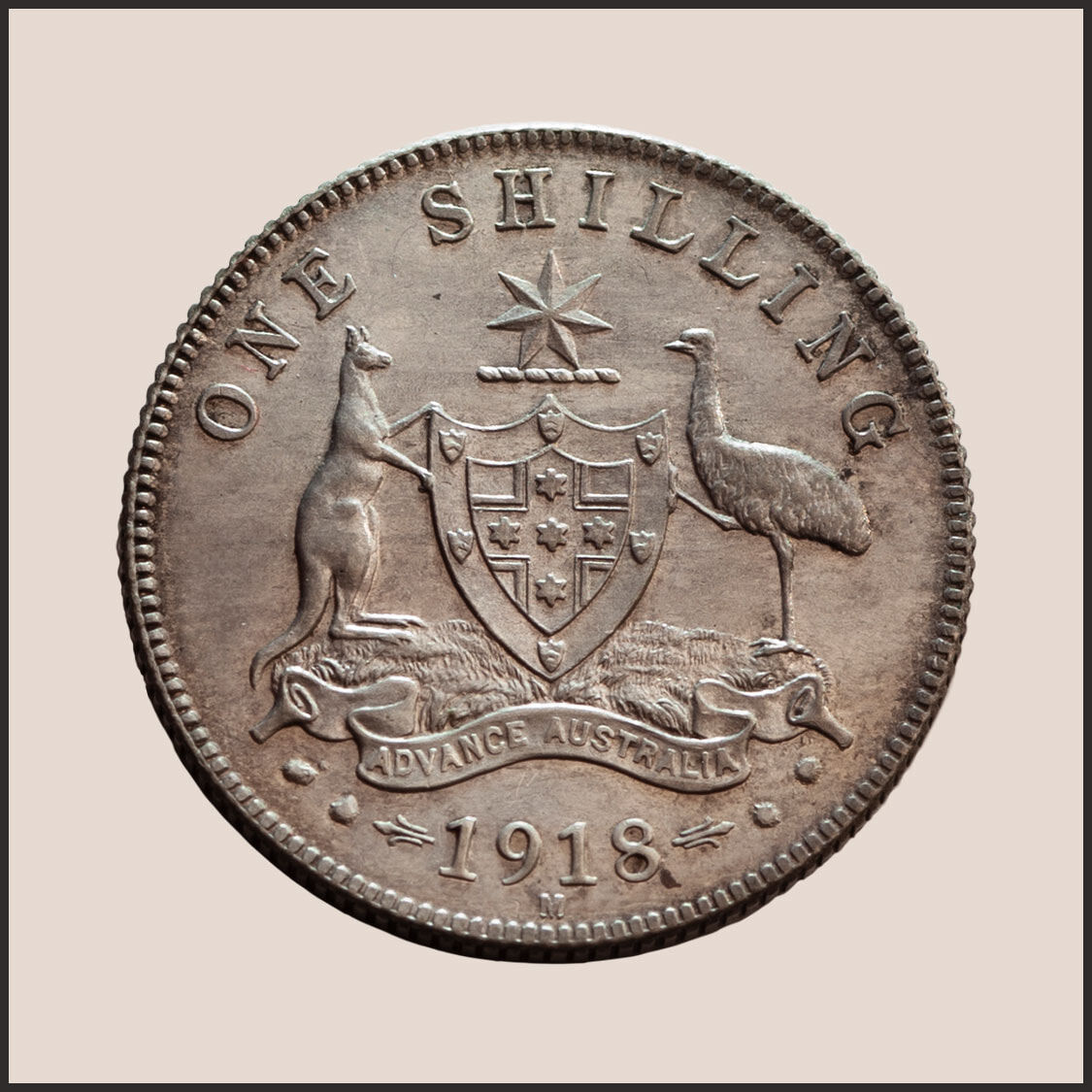
Unique 1918 Shilling
A test piece struck in .500 fine silver.
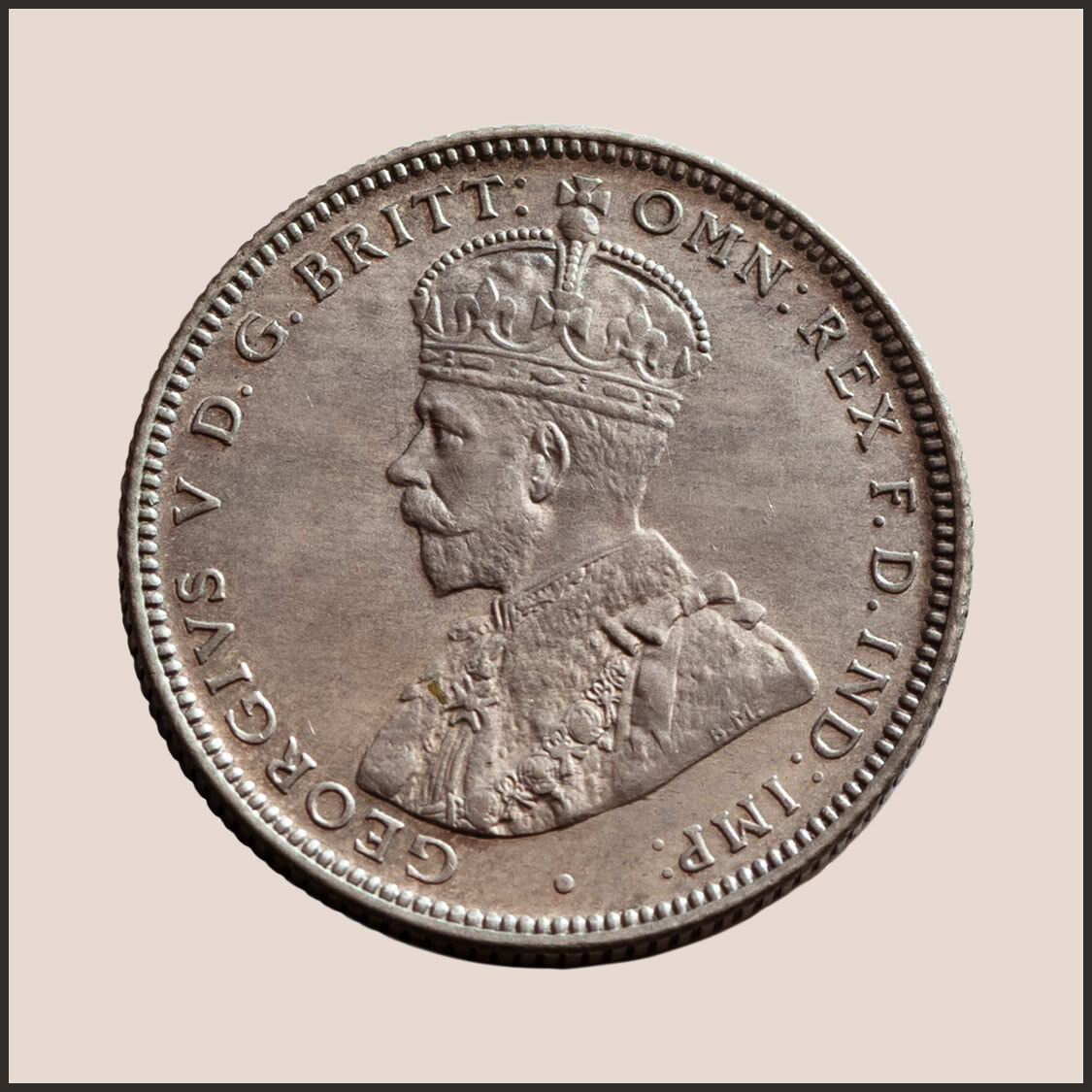
Unique 1918 Shilling
A test piece struck in .500 fine silver.
The Government planned to adopt a coinage with a reduced silver content and between 1918 and 1920 the Melbourne Mint undertook a testing program in which the following coins were produced.
The 1918 Shilling
• The testing of a reduced silver alloy commenced in 1918 with the striking of this 1918 Shilling. Struck in .500 fine from the currency dies, the reverse die was punched in the field with two irregular stops on either side of the date.
The 1919 Shilling
• Australia’s rarest Commonwealth coin was created during this testing process, the 1919 Pattern Shilling. The coin was struck in a .625 fine and counter-stamped with two ‘S’s on both sides of the obverse and reverse fields so that it would be easily distinguished and to prevent it from accidentally going into circulation.
The 1920 Star Florin & 1920 Star Shilling
• The Australian Government pursued the testing of alternative alloys into 1920. Dies were ordered, the design to include a star above the date, to reflect a coin with a reduced silver content. To test the dies, seven trial 1920 florins were minted each bearing the distinctive star (Three are held in private hands). The testing continued with the striking of seven star shillings, three of which are privately held.
While the Government dithered about the impending debasement of its coinage, the years passed and precious metal prices settled.
There is no doubt that Australia weathered the storm concerning the silver crisis of 1920. The nation, however, was not so fortunate in 1945 and 1946 when the price of silver was again booming. The year 1946 heralded in a new order for Australia. The nation's florins, shillings, sixpence and threepences were issued in a reduced silver quarternary alloy.
1918 Trial Shilling struck in .500 silver.
Price: $55,000
The only known example held by a private collector. Another example is held in the Museum of Victoria.
A. M. Le Souef Collection • Spink Auctions November 1981, lot 942 • Spink Auctions March 1988, lot 1152
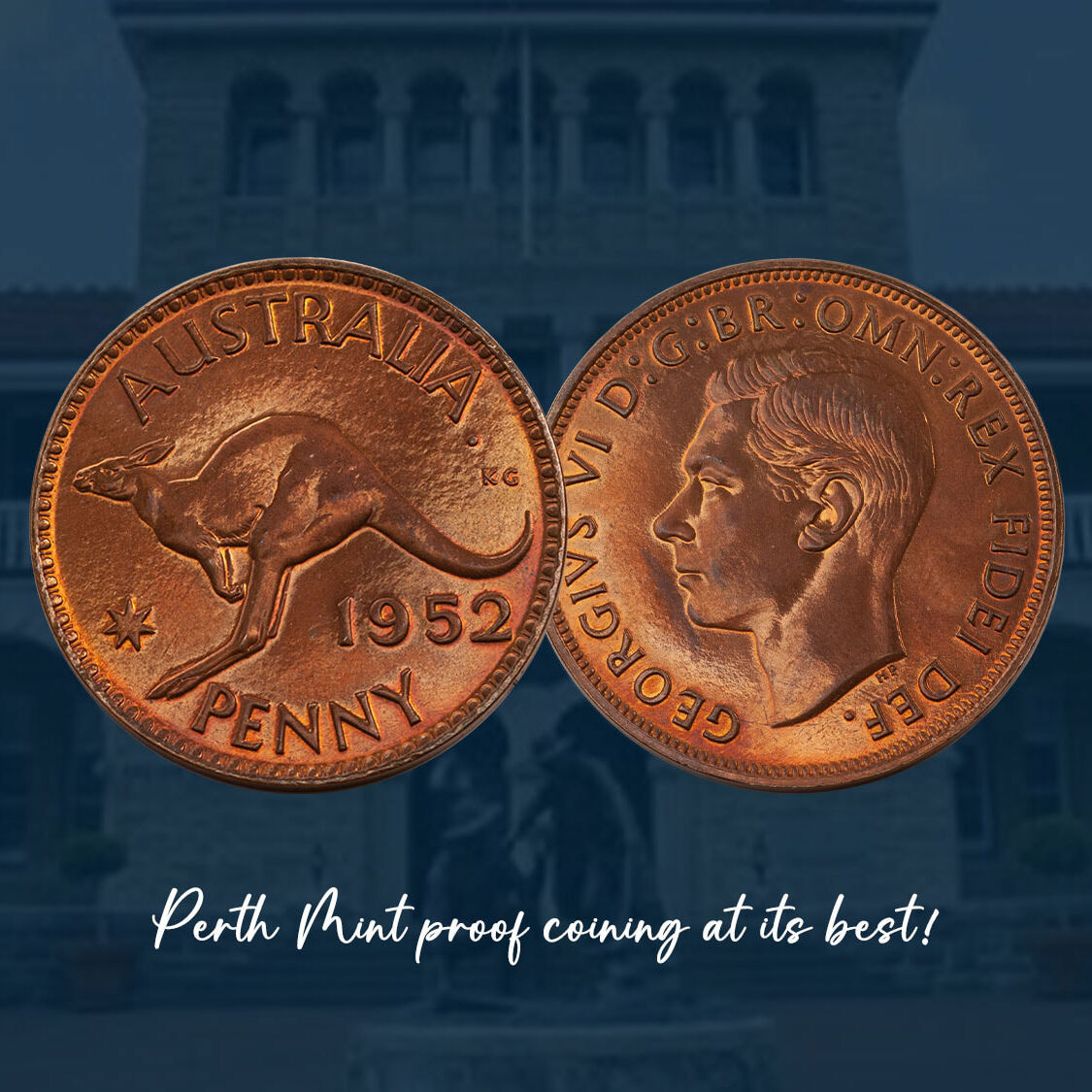
This is an extraordinary quality Perth Mint Proof 1952 Penny. In our view it is the absolute finest of the known examples. The fields are like molten copper, super-reflective. The edges are polished, the denticles pristine. The coin simply dazzles. This is Perth Mint proof coining at its best. Furthermore, the coin is rare as are all Perth Mint proofs out of this era. The original mintage was fifteen with the majority sent to museums leaving few for collectors. The coin certainly impressed the crowd when it first appeared at auction in 2013. Solid bidding took the price from its pre-sale estimate of $20,000 to a final knockdown of $34,000, seventy per cent over the anticipated sale price. While we might sight a Proof 1952 Penny on the market every three to four years this coin, as the finest of its year, is a once in a lifetime buying opportunity.
Click here for more details on this Product
In an article published in the Journal of the Numismatic Association of Australia 2005, renowned numismatist Paul Holland contends that the Perth Mint proofs seemed to have been created for unaided vision. The point here is that a collector would not need an eye-glass to take in their beauty.
He also contends that the Royal Mint's 1951 proofs from the Royal Mint London came to be viewed as the best possible model for what the Perth Mint bronze proofs should look like. (Royal Mint's 1951 copper proofs, as a general rule, are stunning. Visually impactful.) When you look at this Proof 1952 Penny you can't help but feel that Holland was spot-on with his assessment.
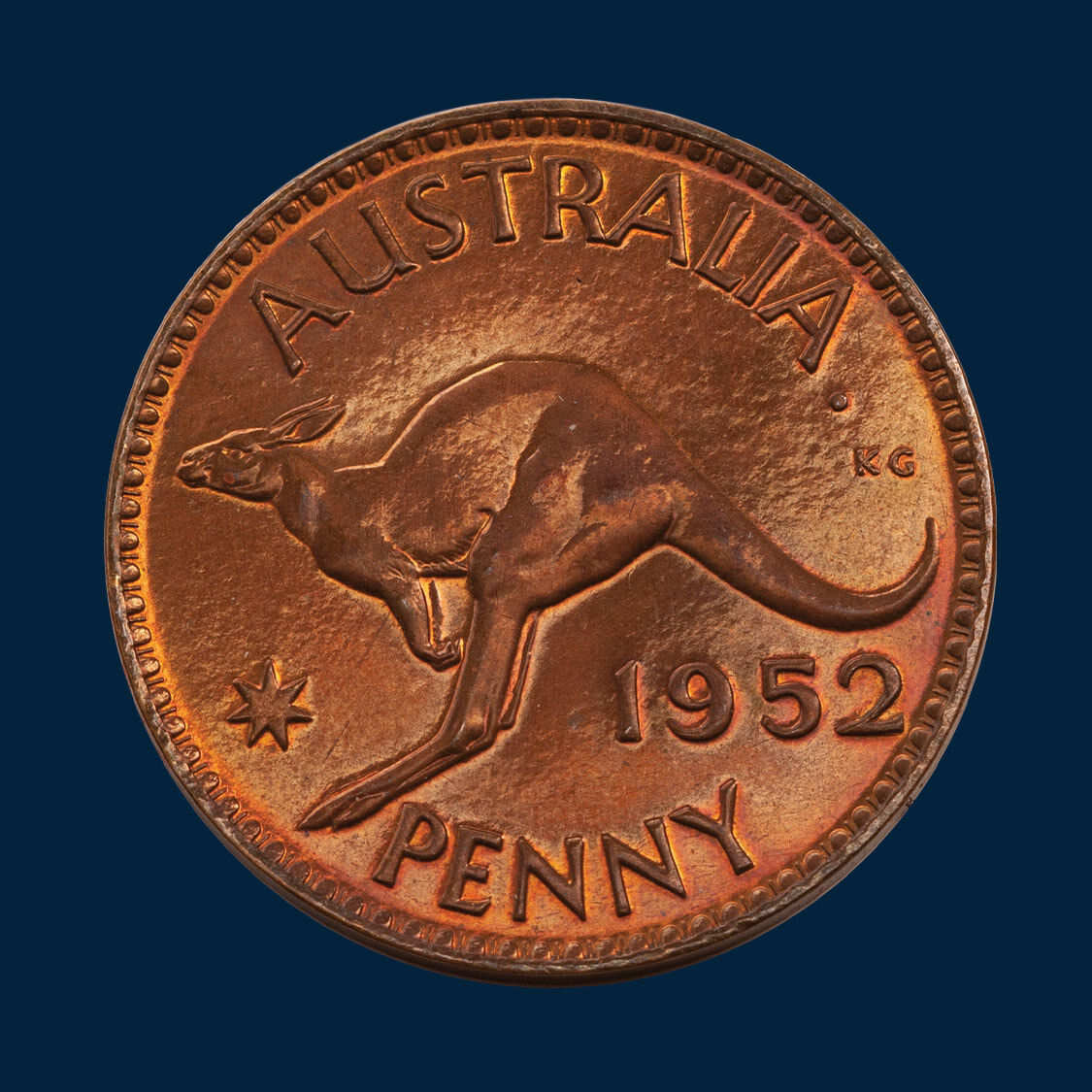
1952 Proof Penny
Perth Mint Coin of Record
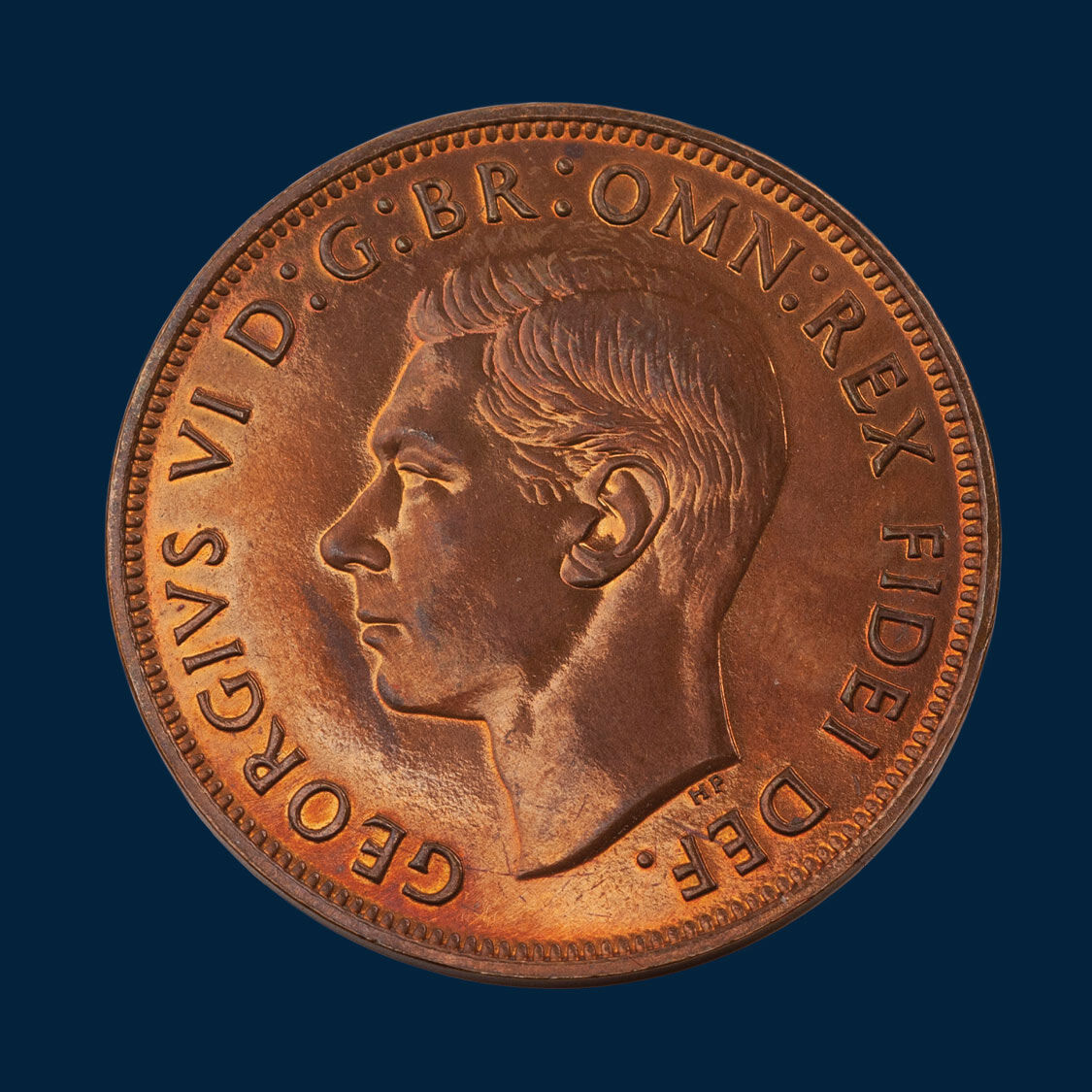
1952 Proof Penny
Perth Mint Coin of Record
The rarity of the Proof 1952 Penny was confirmed in 1995 in an article published in the NAA journal (Volume 8) by John Sharples, the then Curator of Australia’s Numismatic Archives.
He examined the distribution of proof coins recorded in Perth Mint communications and records over the period 1940 – 1954. He found evidence that fifteen proof pennies were struck at the Perth Mint in 1952.
The majority of the mintage was sent to Public Collections and Numismatic Societies. The official list authorised to receive Perth proofs were the Australian War Memorial, Royal Mint London, British Museum, Royal Mint Melbourne, Japan Mint, National Gallery SA, Art Gallery WA, National Gallery Victoria, Victorian Numismatic Society, South Australian Numismatic Society and the Australian Numismatic Society.
He noted that two private collectors (most likely Syd Hagley and Ray Jewell) received examples of the pre-1955 proof coins, such was the influence of these collectors.
The balance of the mintage, was destined for the mint's own archives. That
the bulk of the mintage was gifted to institutions is the very reason why they are so rare in today's collector market.
We might sight a Proof 1952 Penny on the market every three to four years. One as spectacular as this is a once-in-a-lifetime buying opportunity.
Proof 1952 Penny struck as a Coin of Record at the Perth Mint, FDC and a brilliant, full original mint red
Nobles Auction April 2013, lot 1472
$40,000
This is an extraordinary quality Perth Mint Proof 1952 Penny and, in our view, the absolute finest of the known examples. The fields are like molten copper, super-reflective. The edges are polished, the denticles pristine.
The coin simply dazzles. This is Perth Mint proof coining at its best. Furthermore, the coin is rare as are all Perth Mint proofs out of this era. The original mintage was fifteen with the majority sent to museums leaving few for collectors. The coin certainly impressed the crowd when it first appeared at auction in 2013.
Solid bidding took the price from its pre-sale estimate of $20,000 to a final knockdown of $34,000, seventy per cent over the anticipated sale price. While we might sight a Proof 1952 Penny on the market every three to four years this coin, as the finest of its year, is a once in a lifetime buying opportunity.
Proof 1952 Penny struck as a Coin of Record at the Perth Mint, FDC and a brilliant, full original mint red
Nobles Auction April 2013, lot 1472
$40,000
This is an extraordinary quality Perth Mint Proof 1952 Penny and, in our view, the absolute finest of the known examples. The fields are like molten copper, super-reflective. The edges are polished, the denticles pristine.
The coin simply dazzles. This is Perth Mint proof coining at its best. Furthermore, the coin is rare as are all Perth Mint proofs out of this era. The original mintage was fifteen with the majority sent to museums leaving few for collectors. The coin certainly impressed the crowd when it first appeared at auction in 2013.
Solid bidding took the price from its pre-sale estimate of $20,000 to a final knockdown of $34,000, seventy per cent over the anticipated sale price. While we might sight a Proof 1952 Penny on the market every three to four years this coin, as the finest of its year, is a once in a lifetime buying opportunity.
Apart from its extreme rarity, we offer four sound reasons why this Proof 1952 Penny is a must-have for today's collector.
1. Brilliantly preserved proof coins of the Perth Mint are unrivalled for quality.
The coins not only display superb levels of detail in their design, but qualities and colours that are unmatched by those of the Melbourne Mint. Each coin is a work of art, as individual, and as beautiful, as an opal. This Proof 1952 Penny looks like molten copper. It is magnificent.
2. Proof coins have a wonderful connection to the past.
They are the story tellers, defining an era, or a year, like no other coin. Proofs can also define an occasion. And a monarch. And they tend to have a connection to a prominent person, either a dignitary, a Mint Master or an influential collector. The Proof 1952 Penny is the last proof penny struck with the portrait of George VI.
3. Collectors are all but guaranteed that the market will never be flooded with examples.
The Perth Mint Proof Record Pieces is a sector of the rare coin market that offers financial stability and has been the hunting ground of investors for decades. The sector also has strength because it has widespread support amongst the Australian dealer market.
4. The Perth Mint is still operating.
That the Perth Mint is a leading coin producer makes their pre-decimal proofs historical. But also vibrantly current. So the ‘Perth Mint’ message always remains strong, underpinning future interest.
History of the Perth Mint
The discovery of vast gold fields in Coolgardie in 1892 and Kalgoorlie in 1893 triggered a Gold Rush in Western Australia and convinced the British Government to authorise the opening of a mint in Perth.
It was the third branch of the Royal Mint London opened in Australia following the establishment of the Sydney Mint in 1855 and the Melbourne Mint in 1872.
The Perth Mint was established in 1899 and remained a gold producing mint from the year of its opening until 1931 when Australia struck its last sovereign.
For nine years, the coining presses at the Perth Mint ground to a halt. Then early in November 1940, the Australian Government requested Perth to undertake the coining of Australia’s bronze pennies and halfpennies.
The Melbourne Mint had been called upon to do munitions work during World War II and assistance was sought from the Perth Mint to meet Australia’s currency requirements.
The Perth Mint continued to strike copper coins until 1964, when two years later Australia converted to decimal currency.
Established as a branch of the Royal Mint London, the Perth Mint adopted the practices of its master and struck proofs of those coins being struck for circulation.
In accordance with minting traditions the Perth Mint struck proof record pieces of those coins being struck for circulation. There was no hint of commercialism in the production of these pieces.
Posterity, the preservation of Australia’s coining heritage … that and a passion for numismatics were the driving forces behind their striking. The collector market per se was denied access to the coins.
When the Perth Mint struck a proof penny, its intention was to create a single, copper masterpiece. Coining perfection. Perfection in the dies. Wire brushed so that they were razor sharp. Perfection in the design, highly detailed, expertly crafted. Perfection in the fields, achieved by hand selecting unblemished blanks, polished to create a mirror shine.
Perfection in the edges to encase the design … exactly what a picture frame does to a canvas. A proof coin was never intended to be used in every-day use, tucked away in a purse. Or popped into a pocket.
Proof coins were struck to be preserved in the mint's archives as a record of Australia’s coining history, time-capsuled for future generations. Proof coins were also used to showcase a mint’s coining skills, to display at major worldwide Exhibitions or sent to other mint’s and public institutions.
The rarity of the Perth Mint proofs was confirmed in 1995 in an article published in the NAA journal (Volume 8) by John Sharples, the then Curator of Australia’s Numismatic Archives. He examined the distribution of proof coins recorded in Perth Mint communications and records over the period 1940 – 1954. He noted that two private collectors (most likely Syd Hagley and Ray Jewell) received examples of the pre-1955 proof coins, such was the influence of these collectors.
The balance of the mintage, however, was destined for the mint's own archives with the majority sent to Public Collections and Numismatic Societies. The official list authorised to receive Perth proofs were the Australian War Memorial, Royal Mint London, British Museum, Royal Mint Melbourne, Japan Mint, National Gallery SA, Art Gallery WA, National Gallery Victoria, Victorian Numismatic Society, South Australian Numismatic Society and the Australian Numismatic Society.
That the bulk of the mintage was gifted to institutions is the very reason why they are so rare in today's collector market.
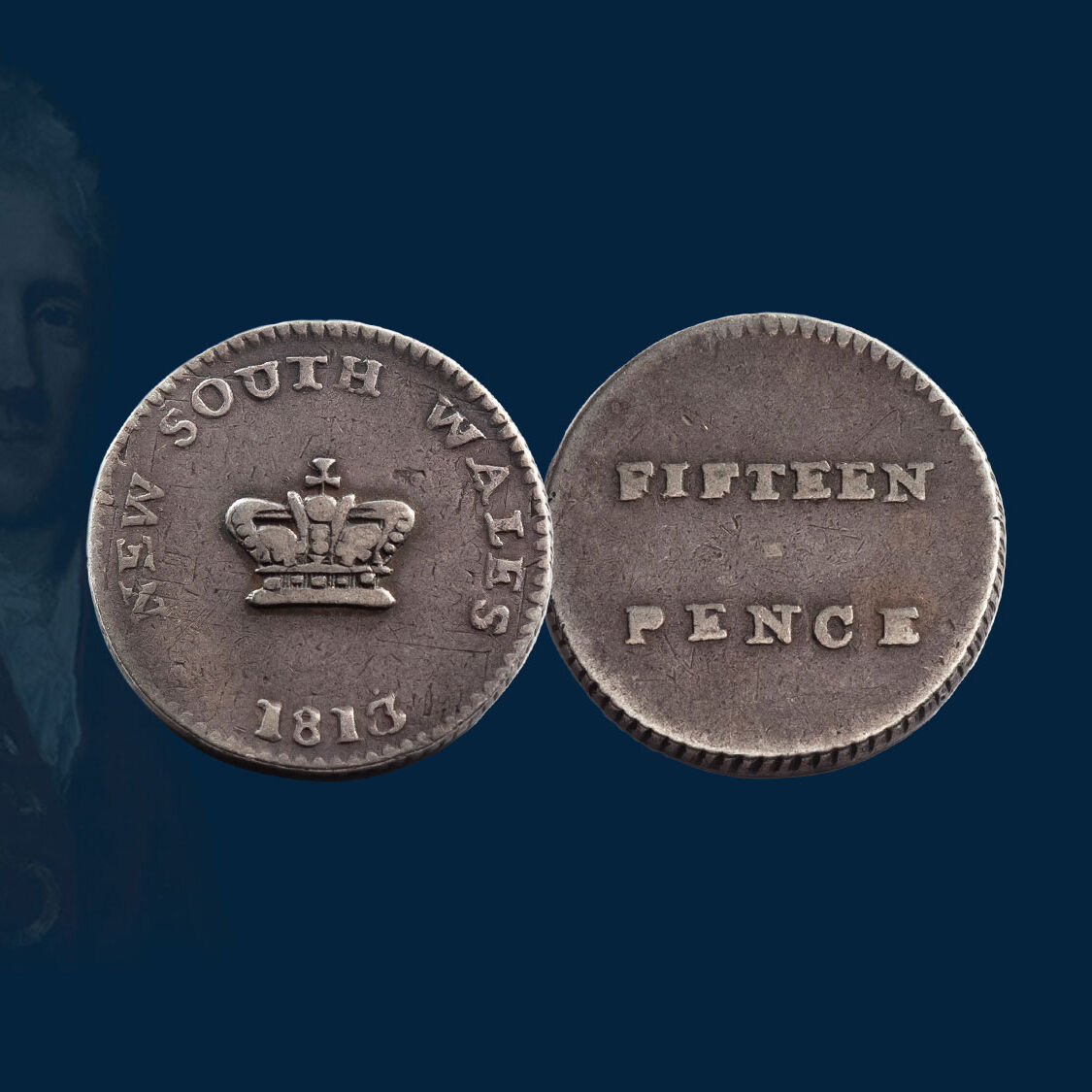
Click here for more details on this Product
When you look at this Dump in your hand, the design details are crisp and clearly visible to the naked eye. The fields are smooth and reflective and have toned to a beautiful charcoal grey.
This is a quality example of the nation’s first coin, graded Very Fine, and in the top fifteen per cent. The average quality Dump is graded at Fine, with this coin three grades higher at Very Fine.
Over and above its quality ranking this coin has attributes that are highly prized and the reason why we refer to it as a 'textbook' Dump. It has traits that you simply don't see in every Dump.
1. A coin to enjoy and show around
Struck with the A/1 dies, the crown is classically well-centred. The design details are chunky, strongly three-dimensional ... and by this we are referring to the crown with its fleur-de-lis and pearls, the legend New South Wales, the date 1813 and on the reverse, the value Fifteen Pence.
2. Evidence of the original Spanish Dollar design, an aspect that really counts
The design detail of the original Spanish Dollar from which this Dump was created is evident on the crown side of the Dump. We refer to it as the under-type and it is not always present. Its existence re-affirms the origins of the Dump and is highly prized.
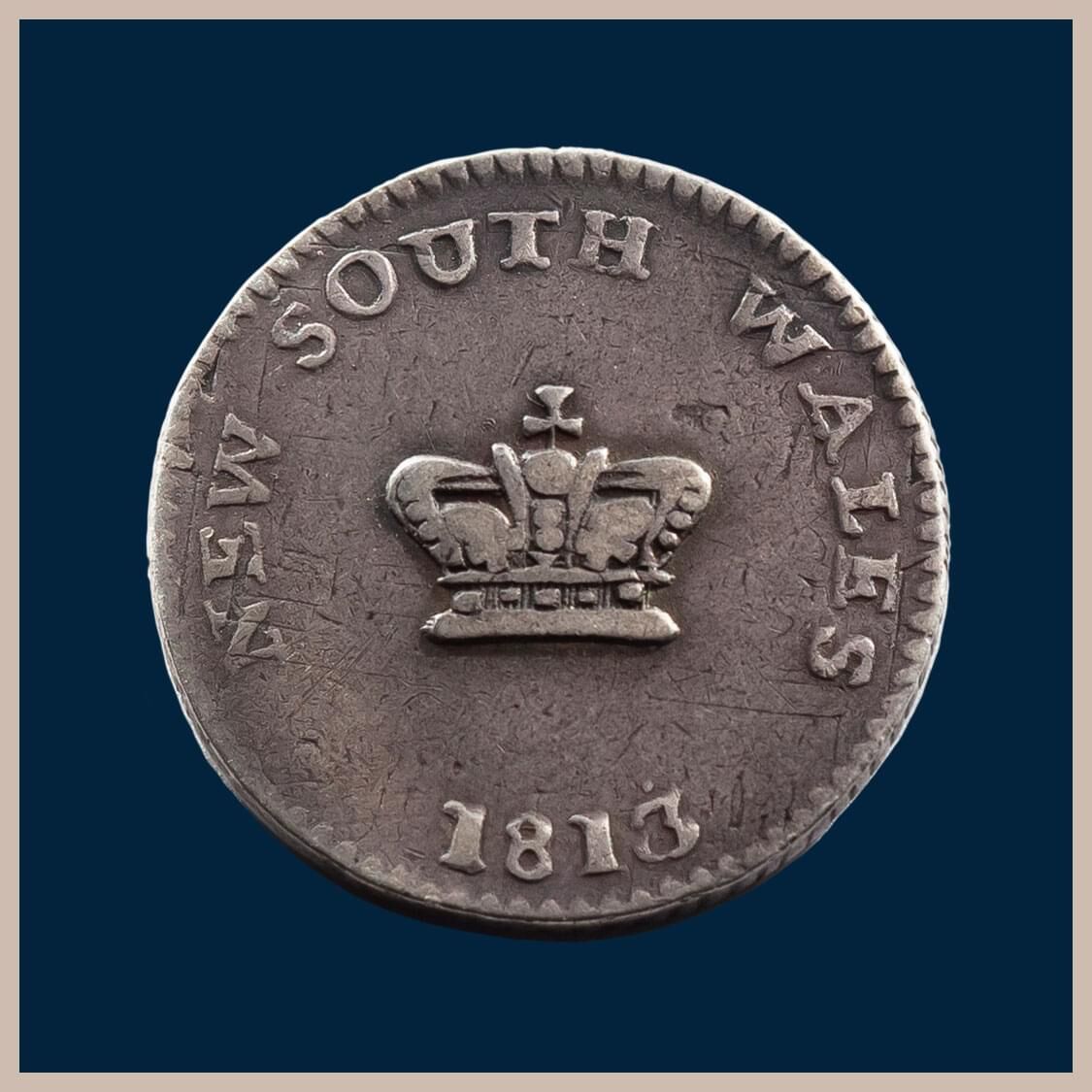
1813 Dump Type A/1
Over stamped with a crown, the date and the issuing authority of New South Wales
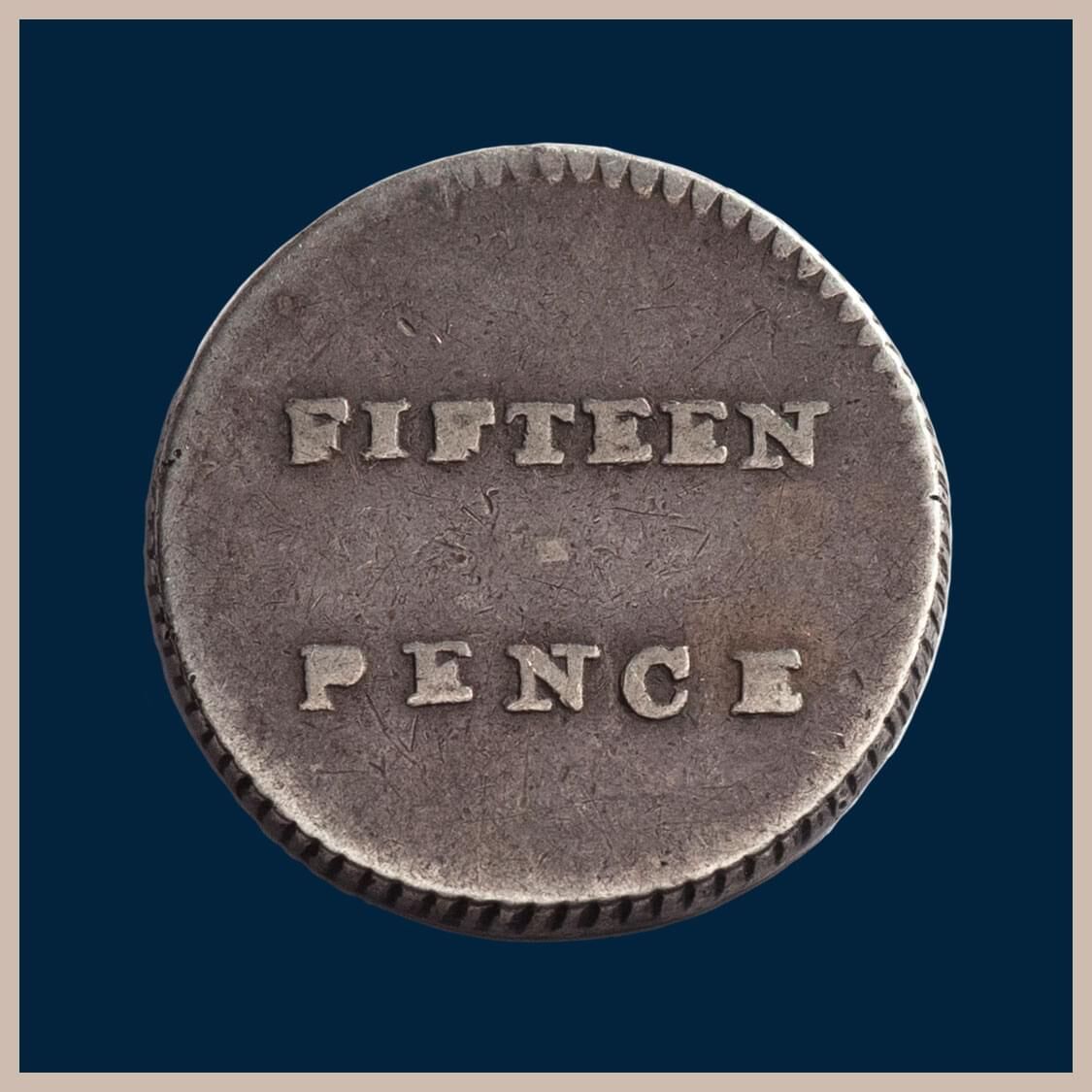
1813 Dump Type A/1
Over stamped with the monetary value of Fifteen Pence
3. The 'dot' above the '3' in 1813
This Dump shows a 'dot' above the '3' in the date '1813'. This is almost certainly due to a pit in the die and only occurs in those coins struck with the type A/1 dies. And even then it is identified in very few type A/1 examples.
4. Henshall's claim to fame, the elusive 'H' on the reverse
William Henshall declared his involvement in the creation of the Dump by inserting an 'H' into some (but not all) of the dies used during its striking. Its presence is highly prized whenever it is appears. This Dump shows the ‘H’ for Henshall between the 'FIFTEEN' and the 'PENCE' on the reverse.
5. Strong denticles that are rarely seen
The denticles around the edge of the coin are almost complete, a feature that is seldom seen in even the very best examples. A piece of art without a picture frame is a blank canvas ... and the denticles act like a picture frame to the coin and give it substance.
6. Oblique milling
Notice the oblique milling around the edge. It is evident. As our comment, the edge milling was used as deterrent against clipping whereby the unscrupulous shaved off slivers of silver, reducing the silver content of the Dump. And making a small profit on the side.
1813 Dump, struck with the Type A/1 dies
Price $25,000
Very Fine
Governor Lachlan Macquarie imported 40,000 Spanish Silver Dollars to create Australia’s first coinage, enlisting the services of convicted forger, William Henshall, to complete the task.
Henshall cut a large hole in the centre of each dollar, thereby creating two coins out of one, the first a holed dollar which was over stamped to become the Holey Dollar. And the second, a circular disc, which was also over stamped to become the Dump.
It is very clear when you look at a Holey Dollar that it originated from a Spanish Silver Dollar. But that is not often the case with a Dump which is why we like this coin.
There is very clear evidence of the original Spanish Dollar design on its obverse.



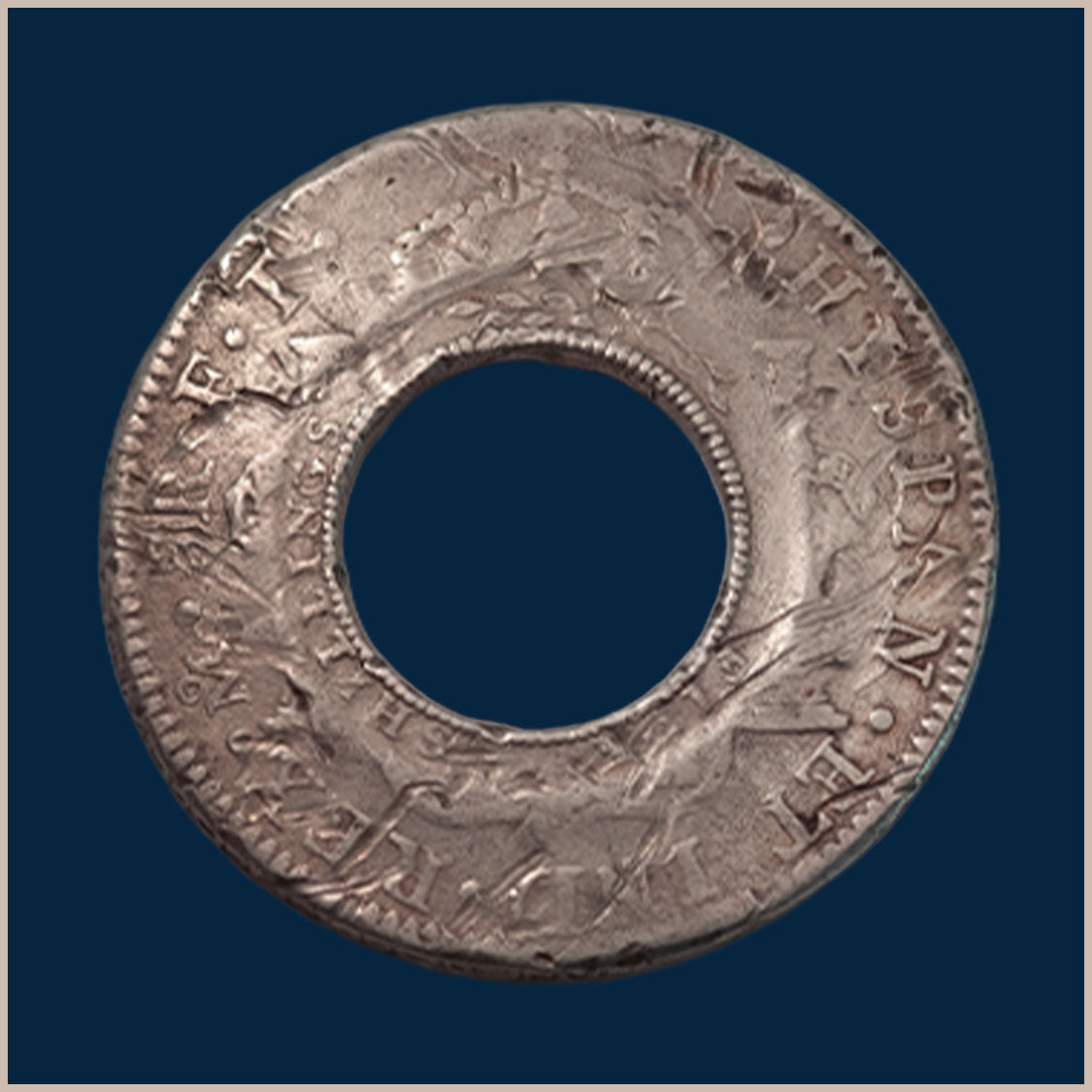
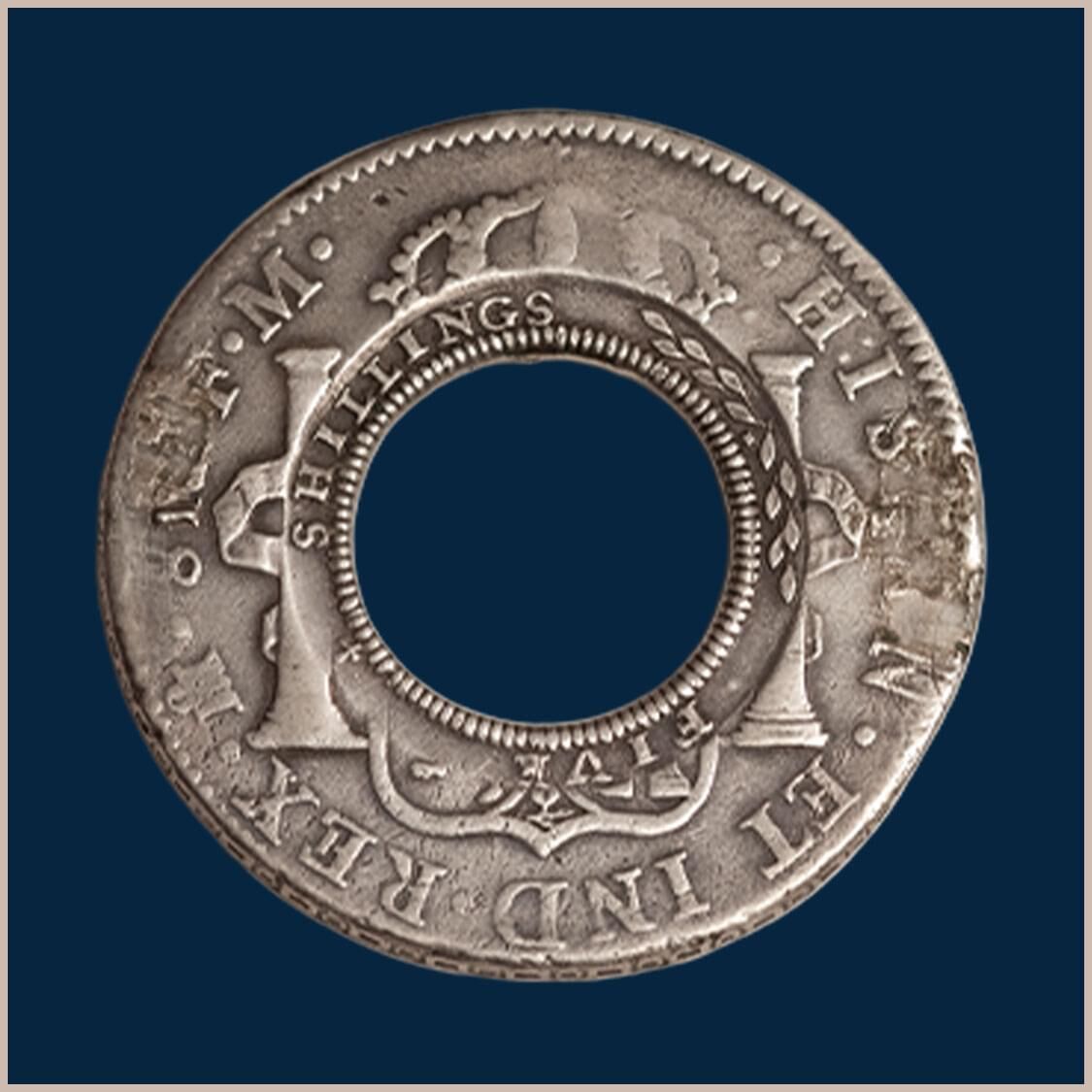
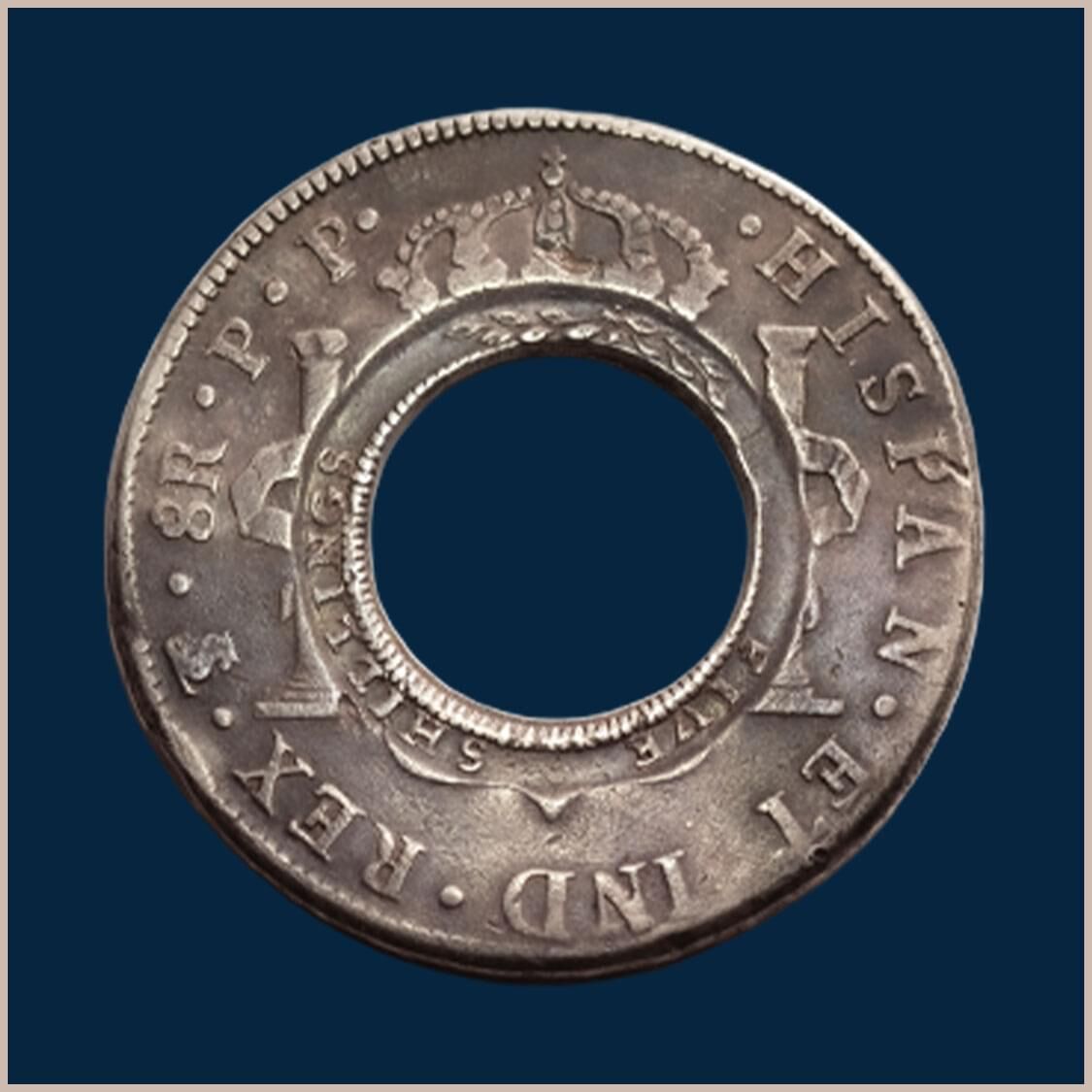
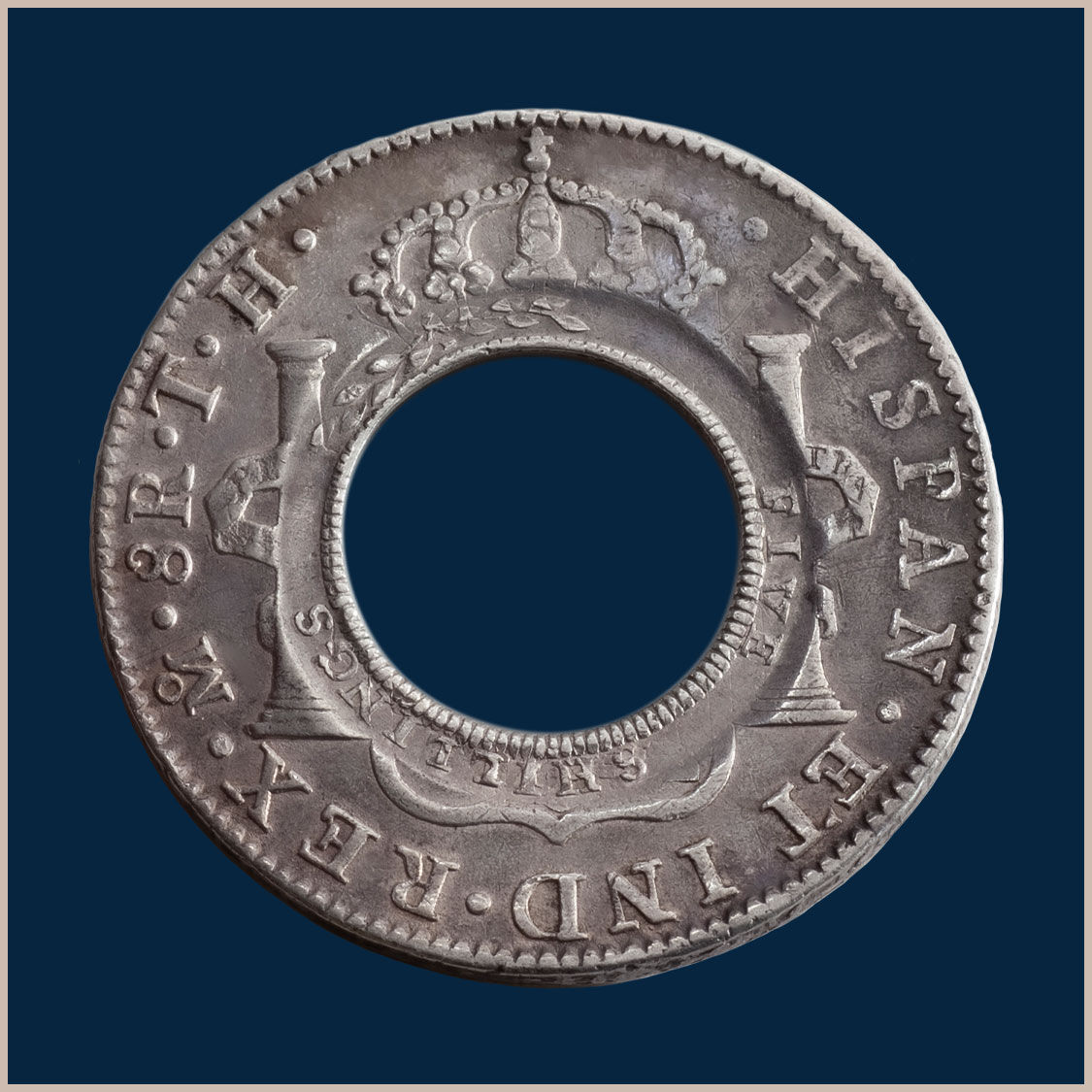
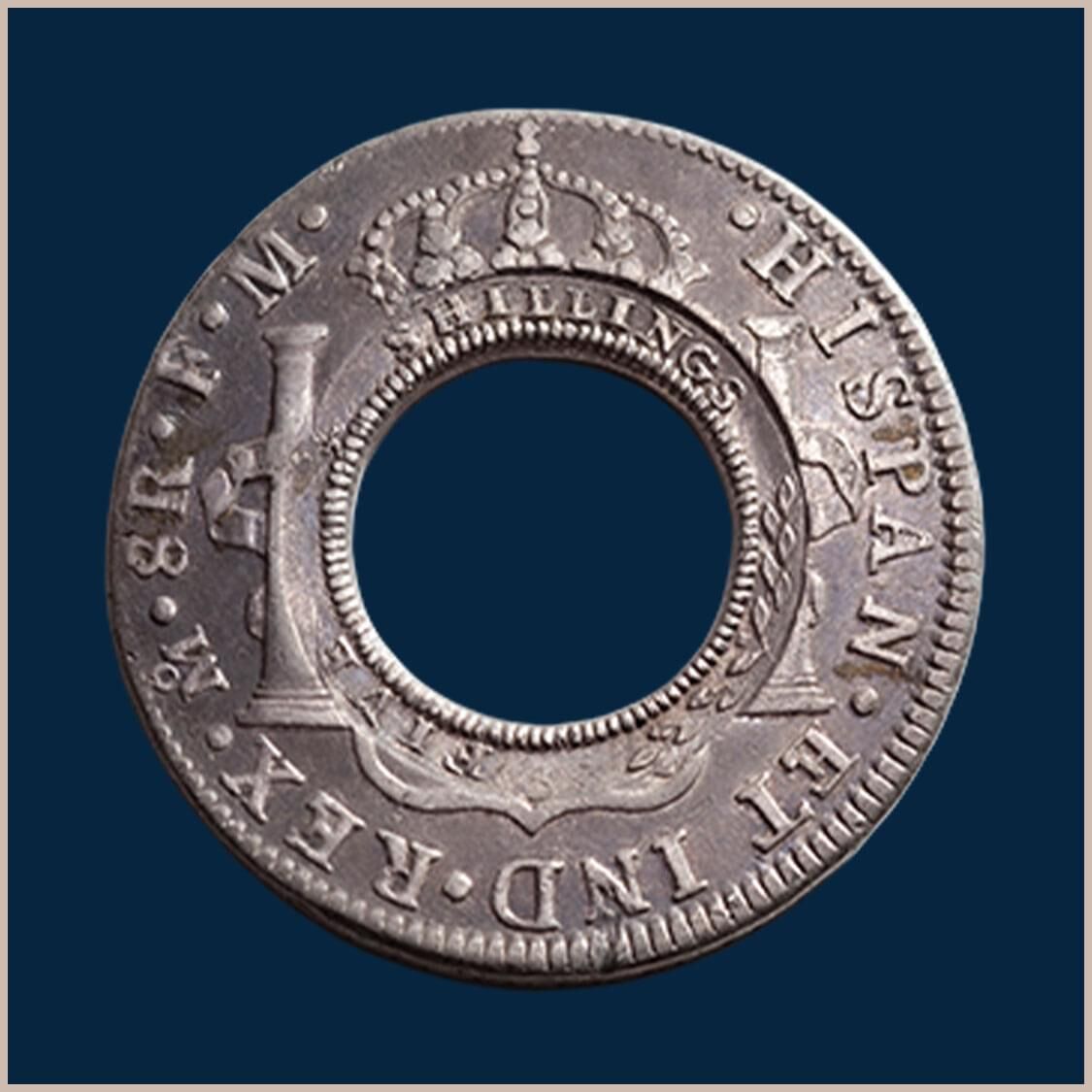


















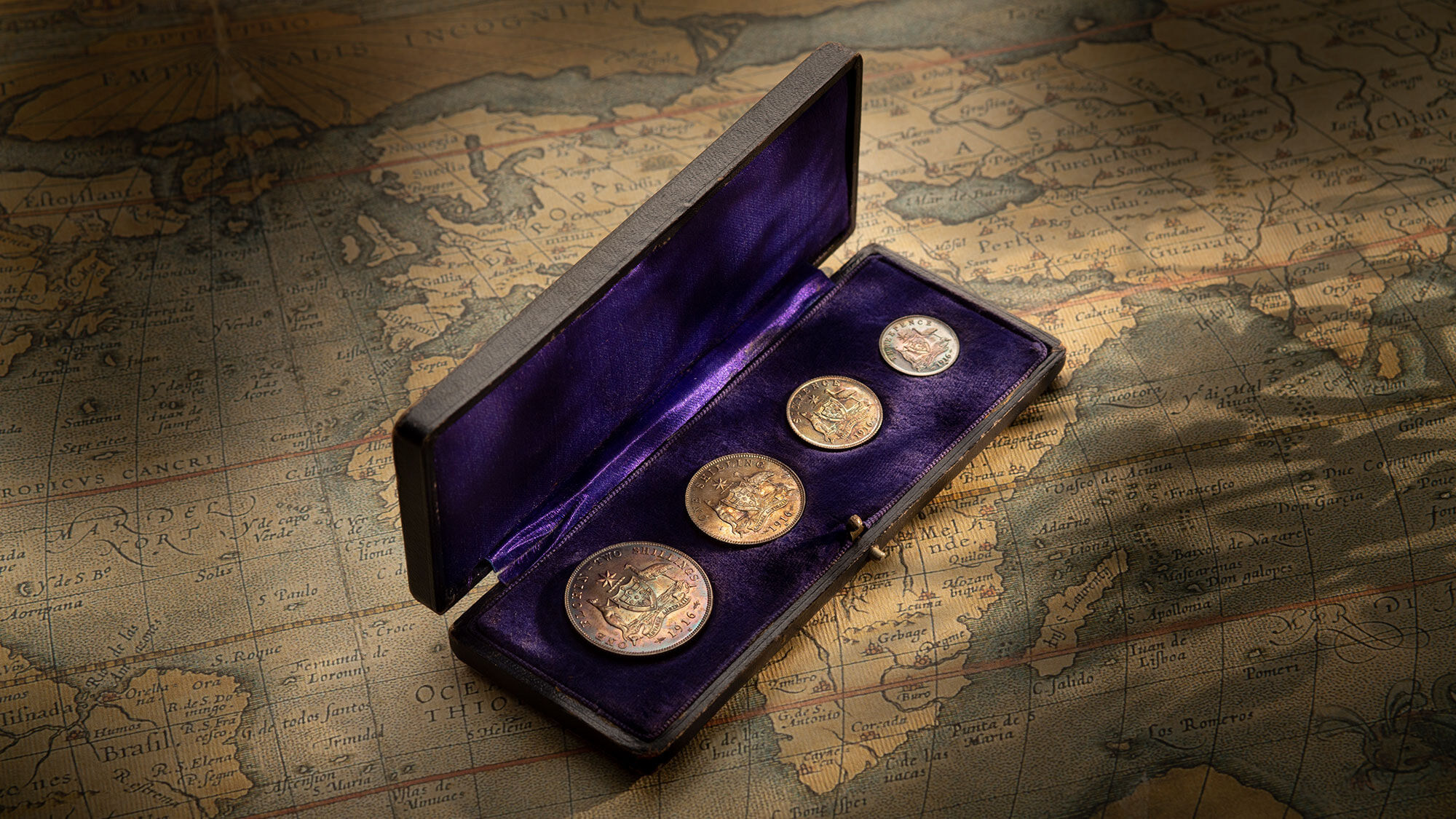

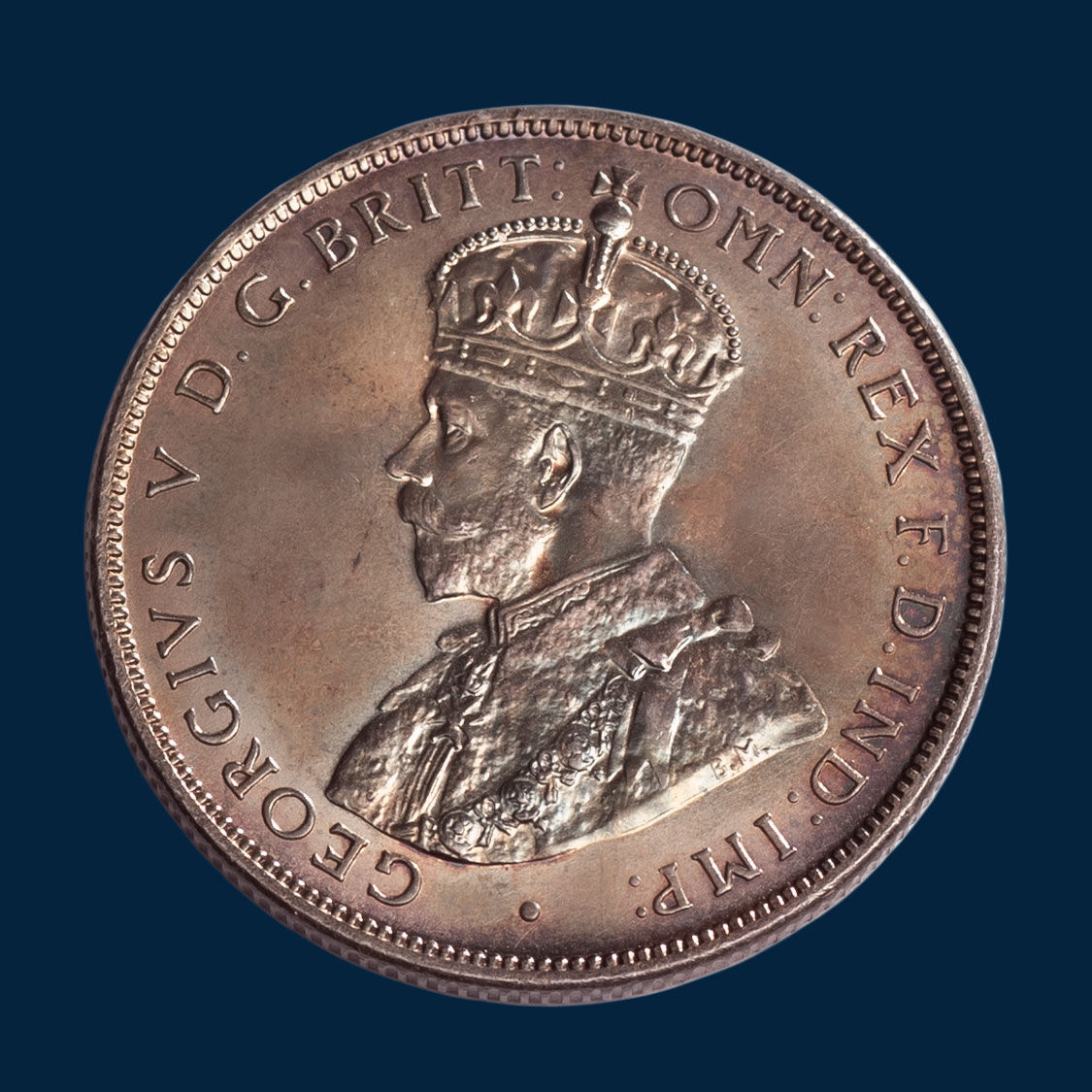
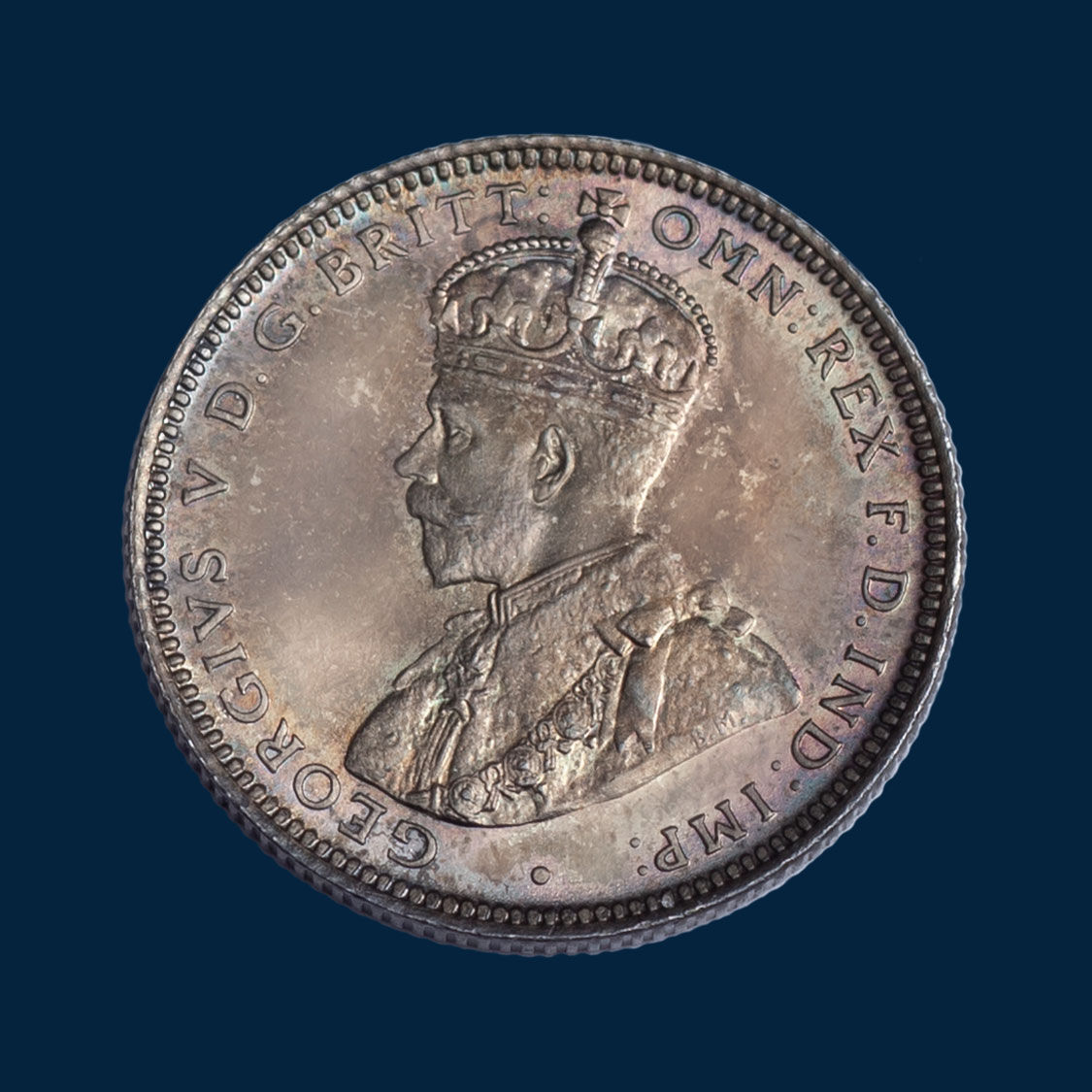
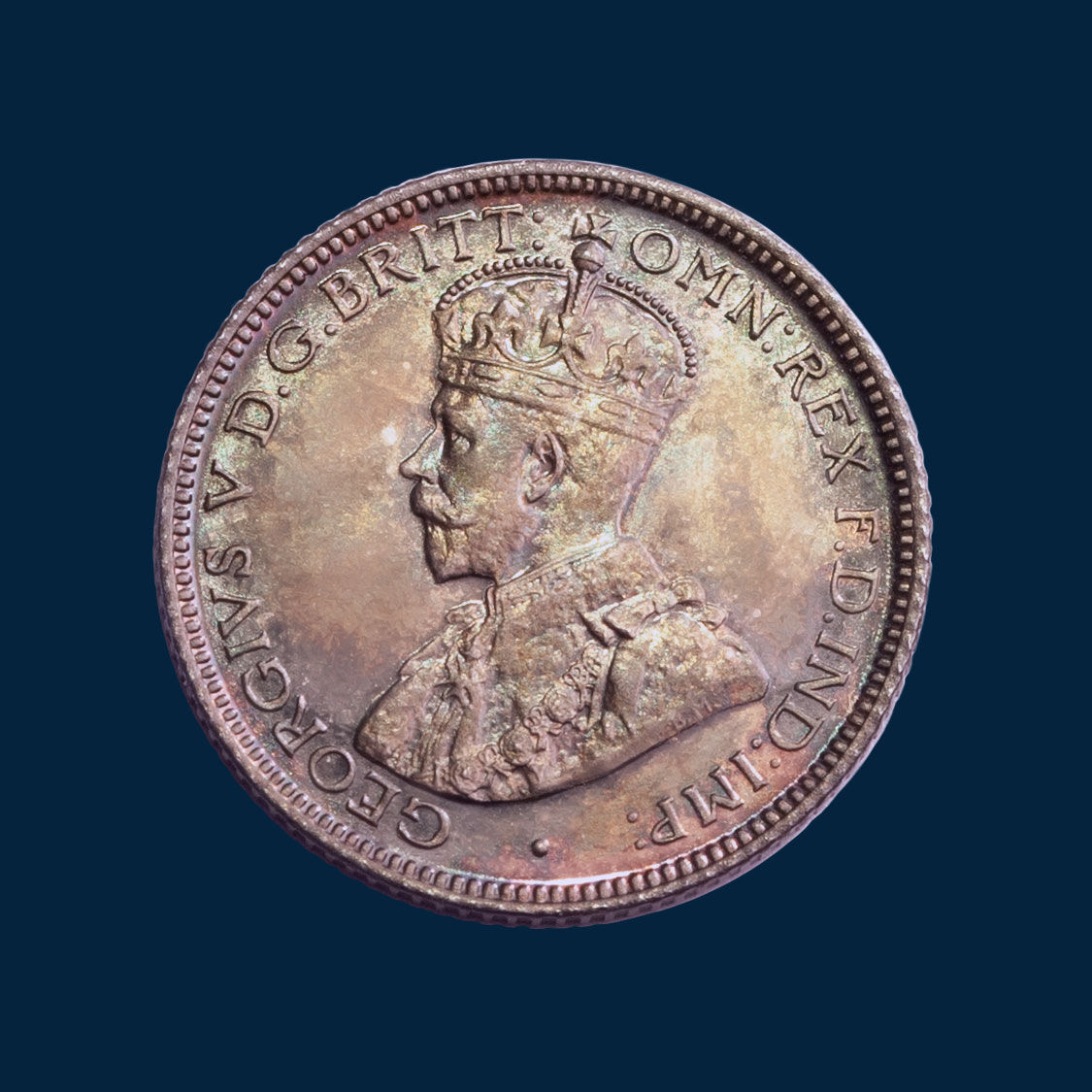
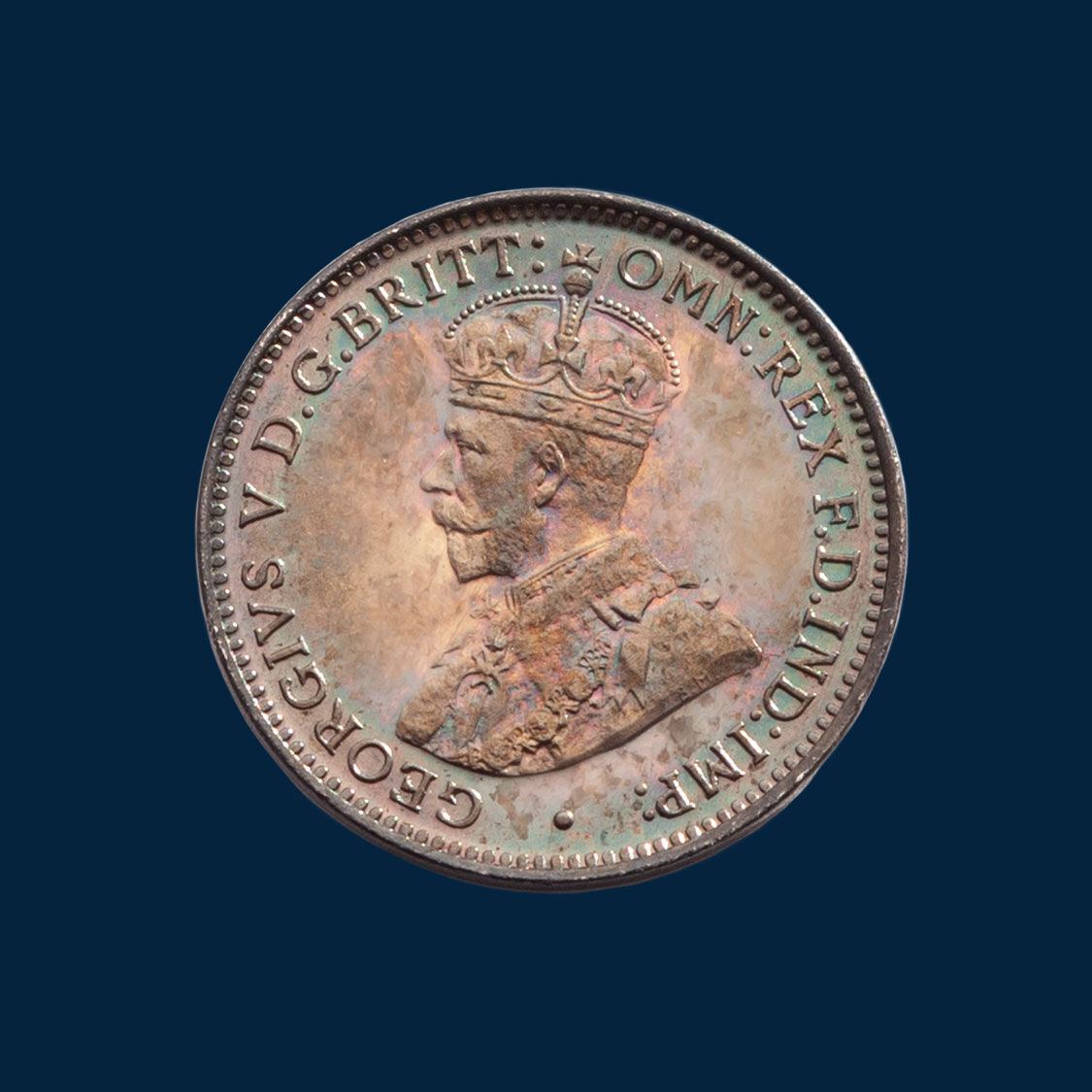















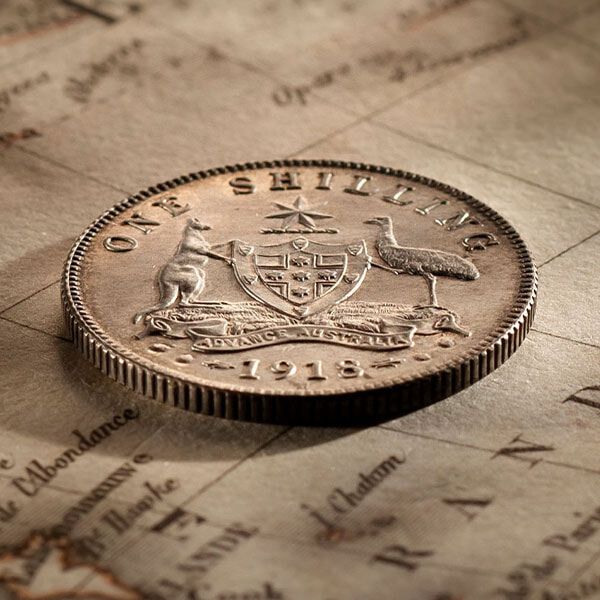
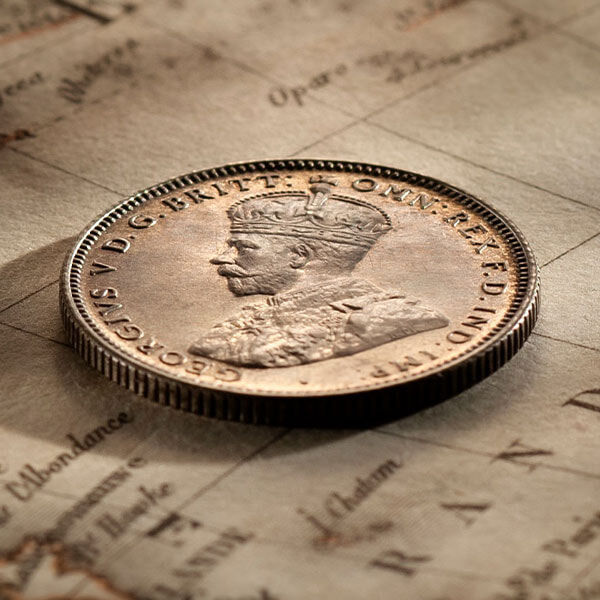


This 1813 Holey Dollar was created from a silver dollar that was minted at the Potosi Mint in Bolivia. 'Potosi' makes it a big deal! This is a mint that is very rarely seen.
Of the two hundred Holey Dollars available to collectors, only fifteen were converted from silver dollars struck at the Potosi Mint in Bolivia. And if you look closely at the fifteen, only five are known in the upper quality levels, of which this coin is one. (By comparison almost one hundred and fifty were created from silver dollars produced at the Mexico Mint, located in the silver-rich colony of Mexico.)
This Holey Dollar is high quality. And this Holey Dollar is extremely rare. Offered in Amsterdam in 1910, it is yet another top Holey Dollar that has returned to its country of origin from Europe over the last century.